ASCE1359 Intro to China
- Introduction
- Neolithic Age (ca. 8000-2000 B.C.E)
- Xia Dynasty (ca. 2100 - 1600 B.C.E)
- Shang Dynasty (ca. 1766/1600 - 1045 B.C.E)
- Western Zhou (c.a. 1046 - 771 B.C.E)
- Eastern Zhou (770 - 256 B.C.E)
- Qin Dynasty (221 - 207 B.C.E.)
- Han Dynasty (202BC - 220AD)
- Six Dynasties (220 - 589)
- Sui and Tang (581–907)
- Song (960-1276)
- Midterm
- Yuan Dynasty (1271 - 1368)
- Ming Dynasty (1368 - 1644)
- Qing Imperialism
- From Empire to Republic
- Mao’s China (1920s - 1976)
- Final Exam
- Notes on The Open Empire Book
Intro to East Asia: China
My timeline: https://time.graphics/line/691984
Introduction
Order of Major Dynasty you should now:
- 商,周,秦,汉;隋,唐,宋;元,明,清,Republic of China
And that China has evidences of many pre-history humans living:
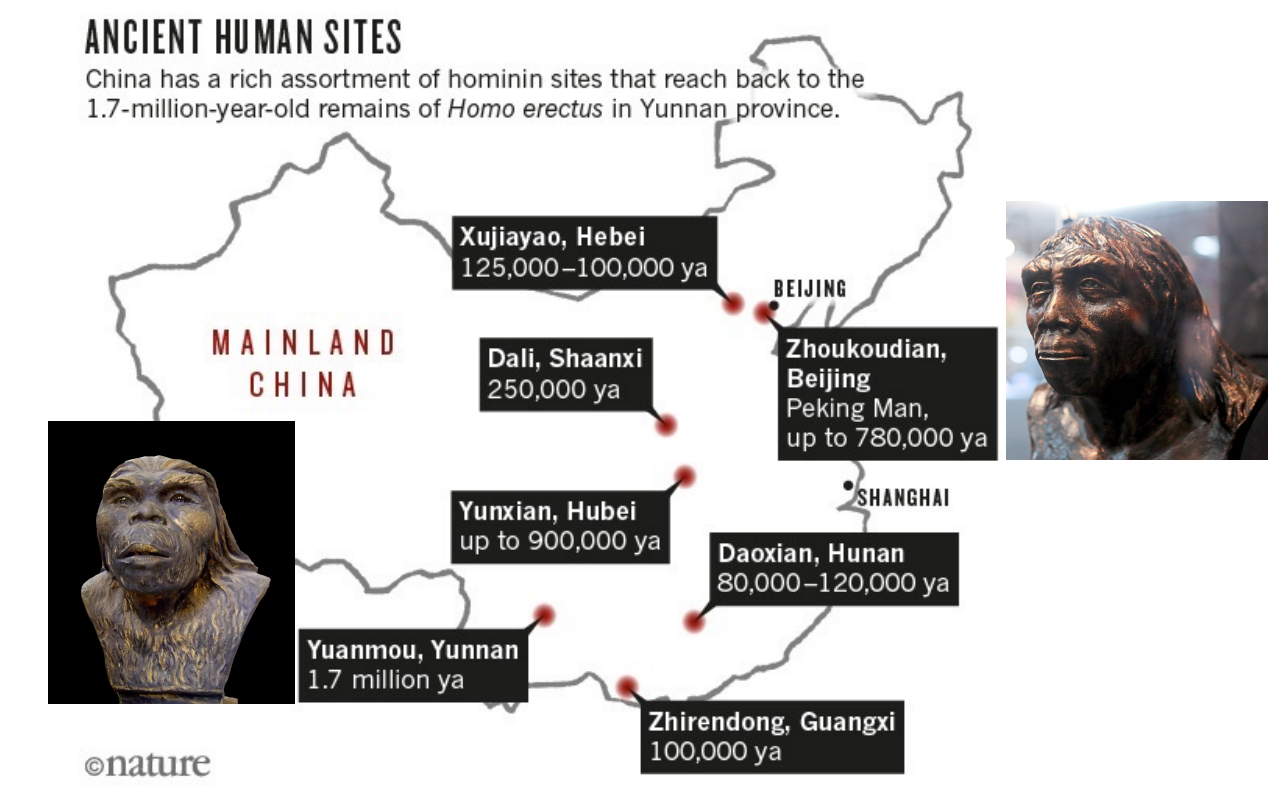
Neolithic Age (ca. 8000-2000 B.C.E)
Neolithic Age, 新石器时代, is discovered mostly because of the distinct style of jar unearthed (Neolithic Period (3300 - 2050BC):
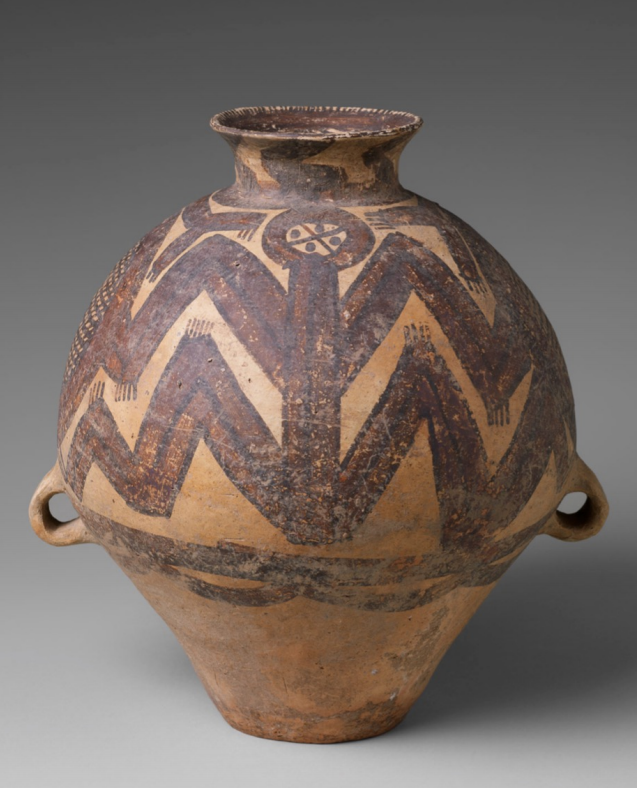
Additionally, features of Neolithic age except for jars include its
-
Agriculture: the most important factor for what to plant is weather + water
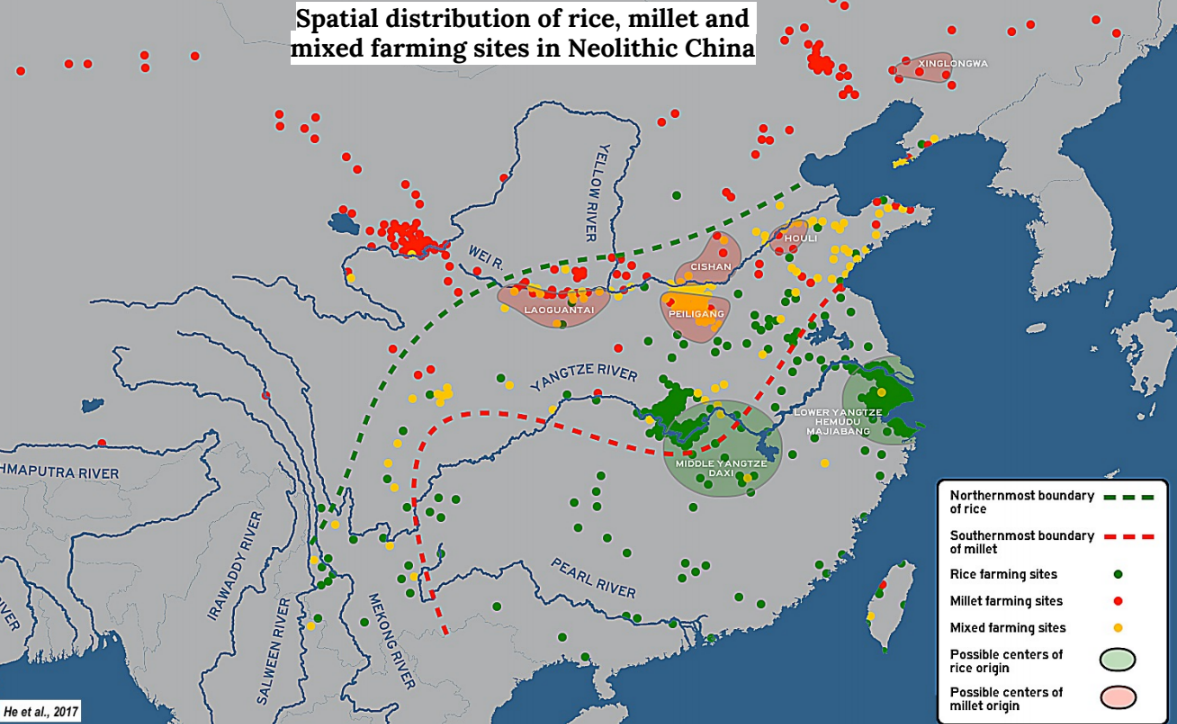
note that already in the Neolithic age:
- rice (水稻) grows in sunny + area with lots of irrigation. Hence near river
- wheat/millet (to make noodles) grows in area that prefers a moderate level of irrigation. Hence more near the north
- note that in the past (i.e. Neolithic age), the north of China has not been arid like now: its reasonably wet
-
Domestication of Animals (e.g. dogs)
-
Fixed Human Settlements (see next section)
Major Neolithic Cultures
Around 5000 B.C.E, we have a brief map of major cultures:
| 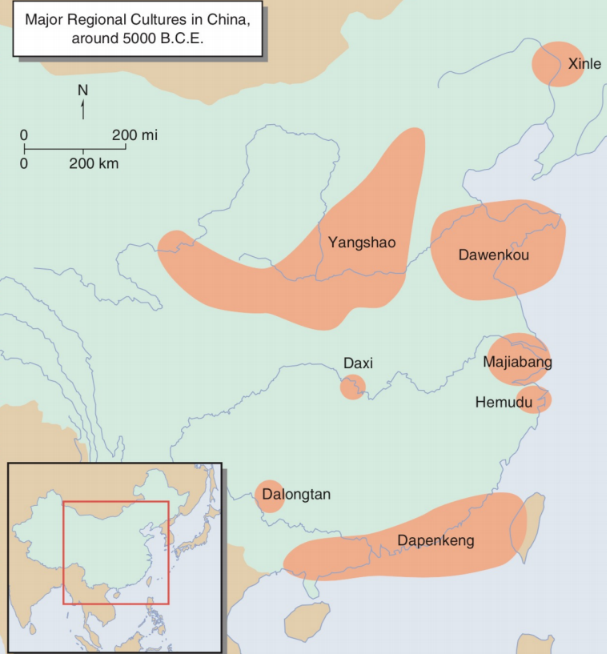 |
| 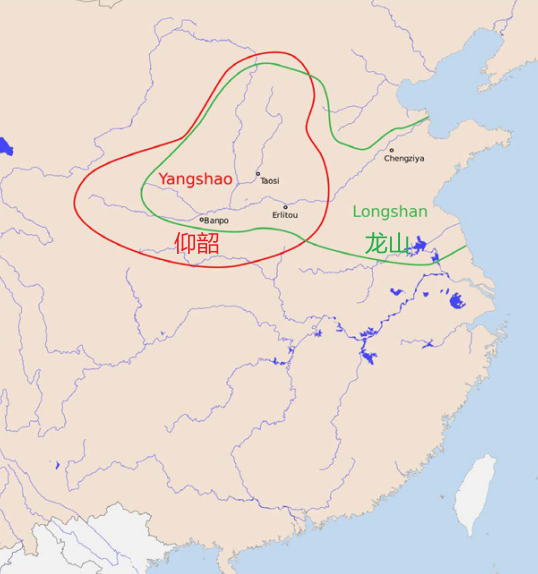 |
| :———————————————————-: | :———————————————————-: |
|
| :———————————————————-: | :———————————————————-: |
where our focus would be the 仰韶 and 龙山 culture, how they are related and different.
Yangshao Culture (5000-3000 BCE), who lives many on agriculture with meat supplies from hunting
-
colorful, painted pots
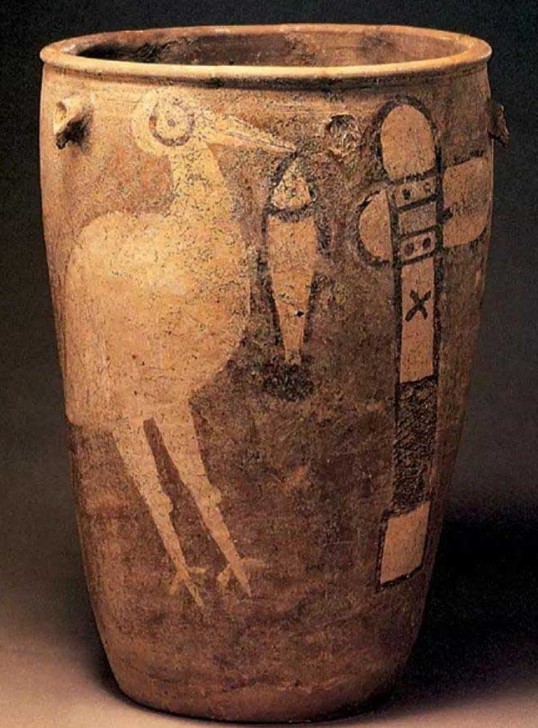
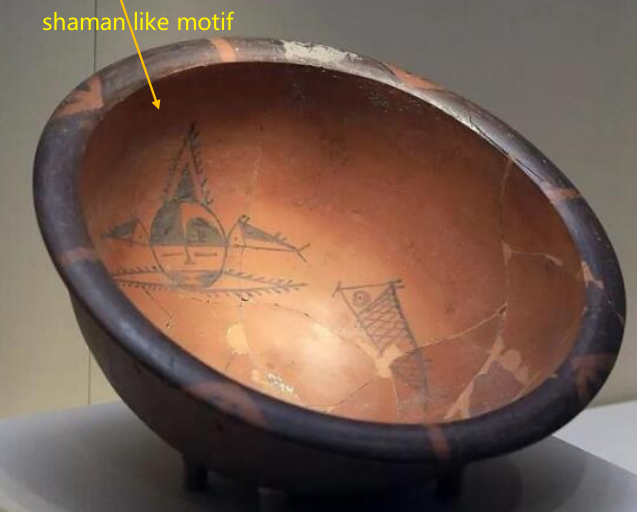

3500-3000 B.C.E with many emphasis on fish/animals and interesting shapes such as spirals.
-
human settlement: Banpo
Banpo Model (c.a. 4000 B.C.E) Second Bury 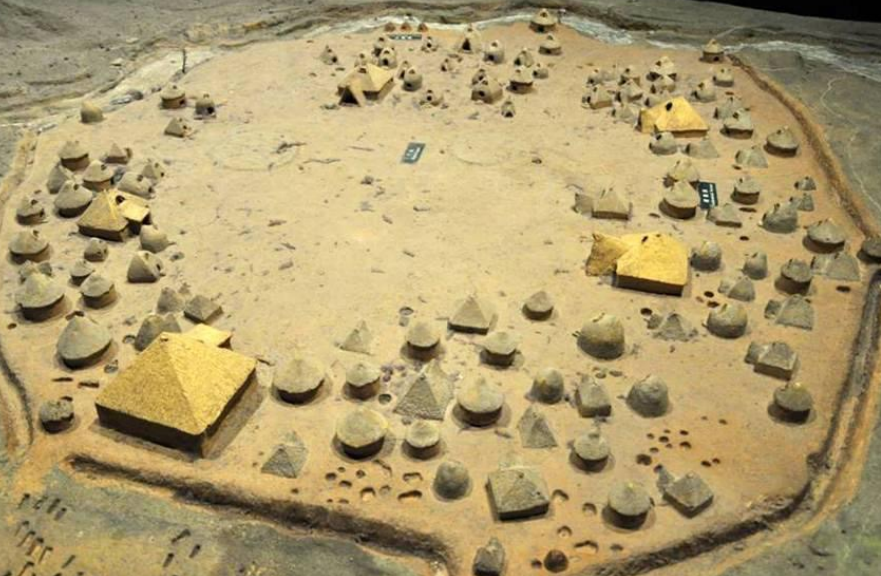
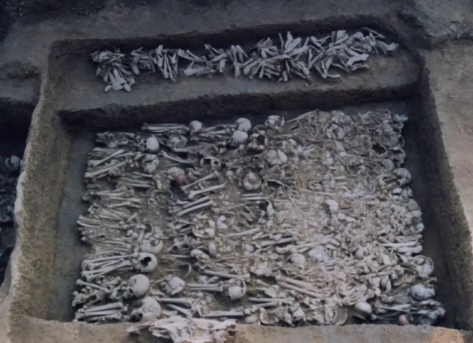
where we notice that:
- its various size and placement indicates a lineage/kinship relationship
- there are no walls for the Banpo model. This could be indicative of them being non-violent and friendly people, no protection is needed from outsiders
- already practices of burial: bury once to wait until decomposition, and bury again with others
Longshan Culture (3000 - 2000 B.C.E)
-
black potteries, distinct from Yangshuo (hence indication of a separate culture)
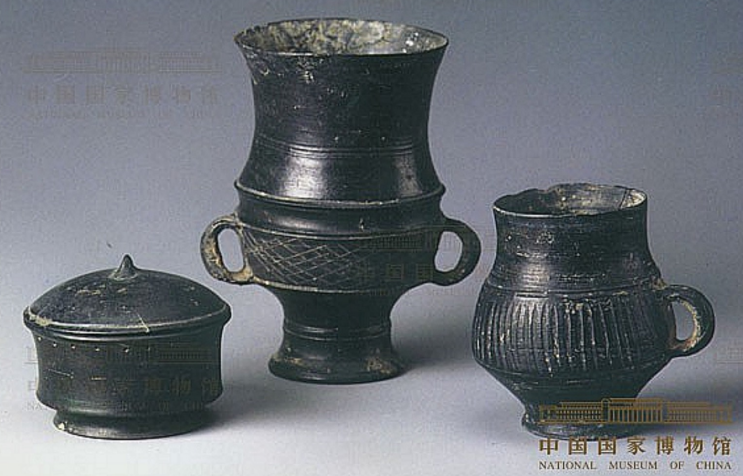
created from rustic material, but has very sophisticated patterns while being extremely thin (0.2mm).
- production of which surely requires high effort, hence indication of social stratification/concentration of wealth
- but it could also be a practice of certain religion, yet the previous would be more supported by other evidences
-
Shimao site, Longshan Settlement:
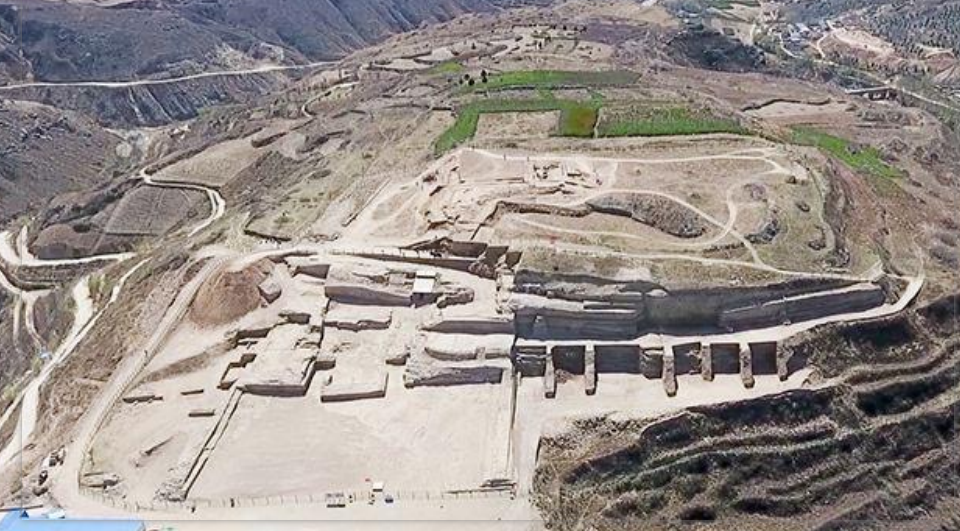
note that we begin to see
-
a structure of inner city and outer/taller city
- presence of walls
- has a lot of spear heads and other weapons
indicating social stratification (as compared to Yangshuo) and foreshadowing the bronze age
-
Finally, note that it appears Longshan culture immediately proceeds Yangshuo culture, cultural interactions is always a non-linear process:
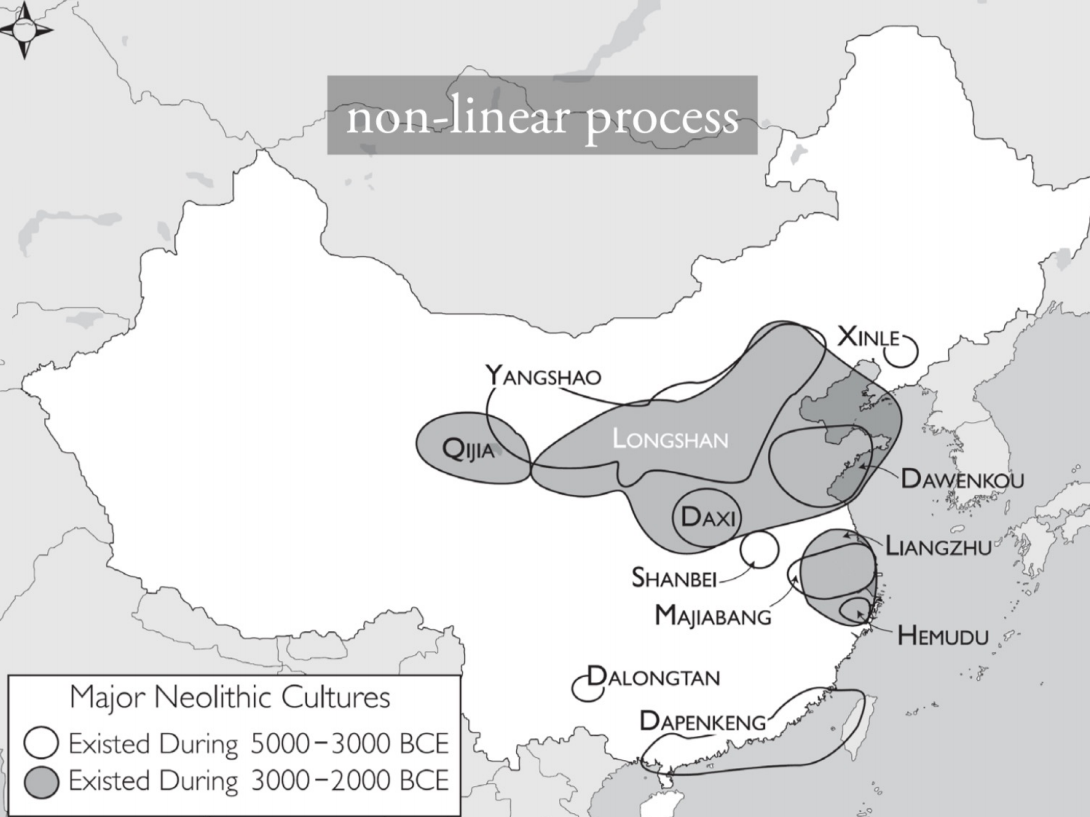
where there are many other cultures being present, and theories explaining those in relation to the two major culture include:
- nuclear area theory: all starts from Yangshuo, and other cultural development radiated outwards
- interactive sphere theory: each culture has its own sphere, but they trade and interact, and eventually, converge.
- etc.
Without decisive evidences, it is hard to say what IS really the origin of all.
Xia Dynasty (ca. 2100 - 1600 B.C.E)
The Xia dynasty was the first of many ancient Chinese ruling houses, thought to exist from around 2070 B.C.E. until 1600 B.C.E. Yet the actual existence of this dynasty and culture has been debated.
- in China, a lot of government funding has been provided to prove the existence of Xia dynasty.
- however, one should be careful as those evidences could be biased as well.
One major culture that are hypothesized to be related to Xia Dynasty and anyway preceeds to the Shang Dynasty is the Erlitou Culture (c.a. 1750-1520 BCE), located in 河南洛阳, 二里头遗址
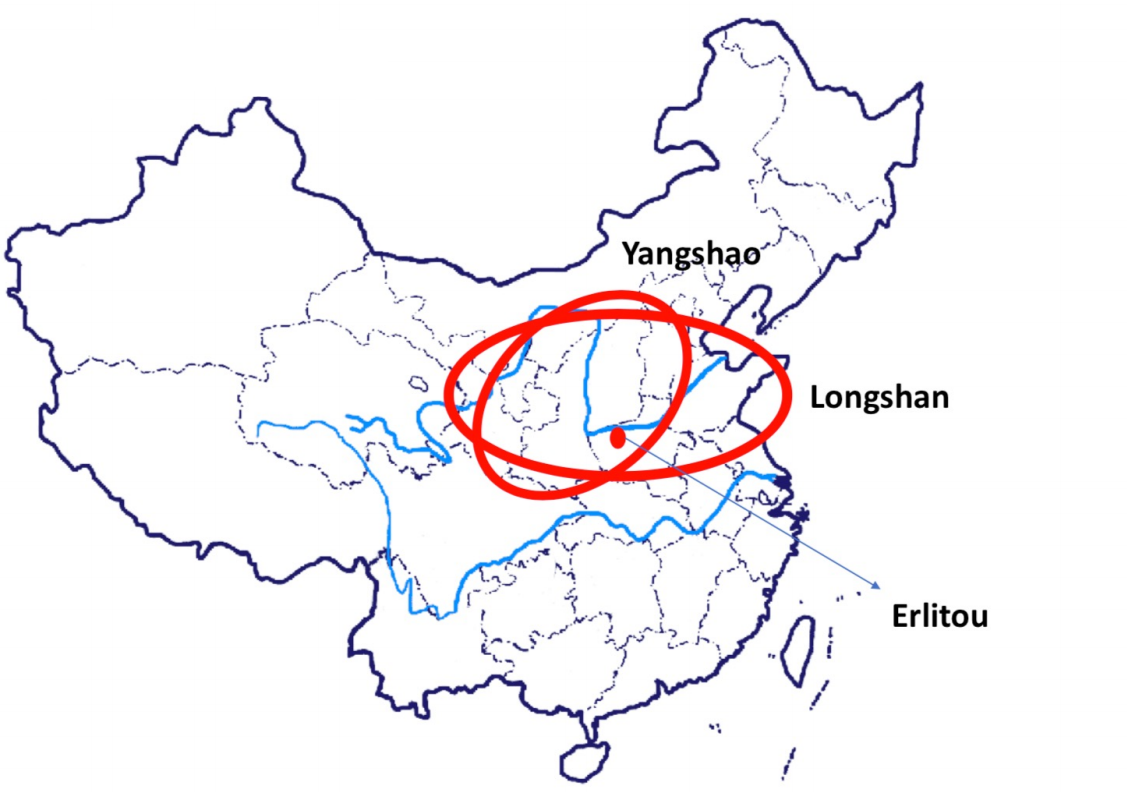
Some interesting aspect of the Erlitou Culture include:
-
Erlitou’s settlement layout:
Erlitou Layout Central Palace Reconstruction 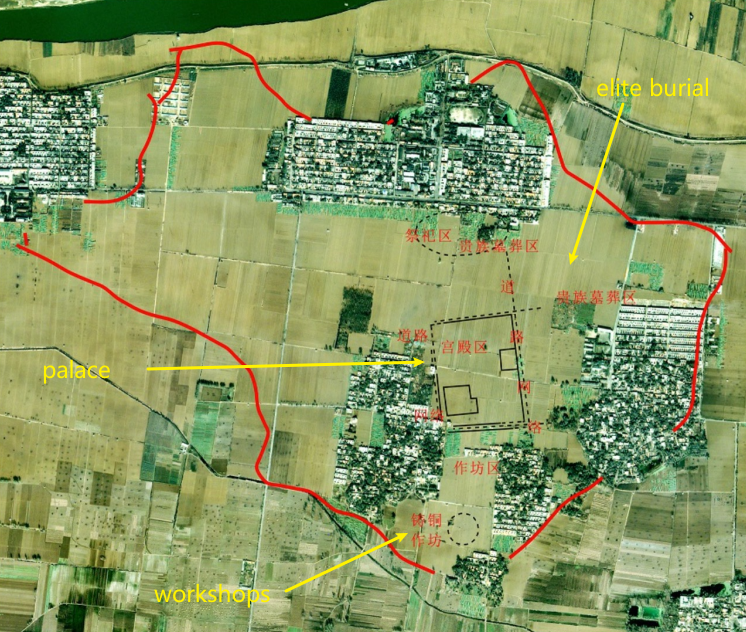

where many scholars hypothesize that the central palace could be the capital of Xia
-
Start of Bronze vessels (proceeds Bronze Age) and some made of Jade
Turquoise-inlaid Bronze Plaques (板) Turquoise Dragon and Bronze Bell Clay Vessels Bronze ding Vessel Yue Jade 
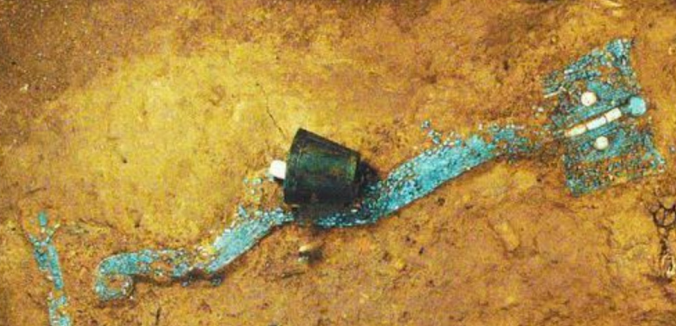
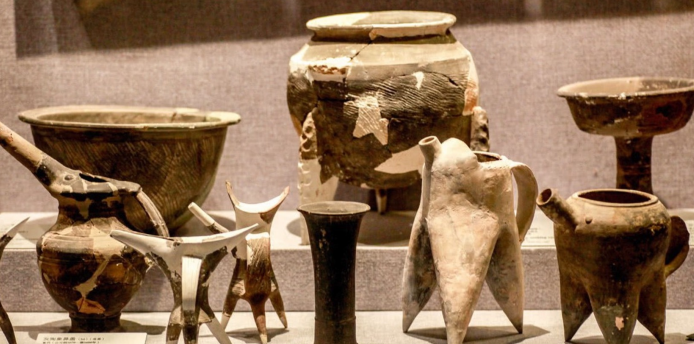
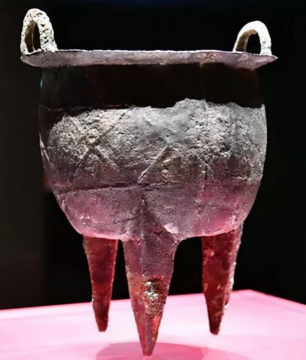
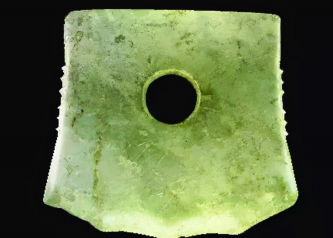
all of which are highly likely to be produced by the workshop near the palace, found in large quantity in Erlitou. This could indicate that:
- Erlingtou must be a central and powerful place, perhaps like that of a government
- however, without much written records those are still speculations
-
Lack of written records
the possibility of Xia dynasty comes from 史记 (司马迁), where he mentioned annals of Xia:
Shiji (91BC) Symbols Excavated from Near Erlitou 
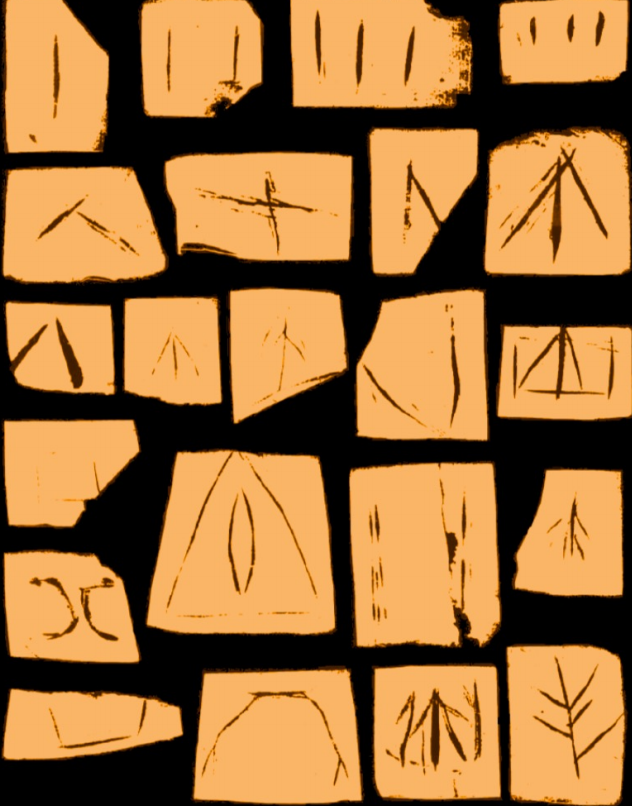
where we see some lack of written records for Xia, only left with some symbols on potteries, hence no way of confirming whether if Xia really existed.
According to tradition, the Xia dynasty was established by the legendary Yu the Great (禹), after Shun (舜), the last of the Five Emperors (三皇五帝), gave the throne to him. In traditional historiography, the Xia was later succeeded by the Shang dynasty.
- 三皇五帝is regarded as the demi-gods/emperors who significantly improved peoples lives by teaching them how to use fire and etc.
Shang Dynasty (ca. 1766/1600 - 1045 B.C.E)
Between Shang and Xia (if it existed), there is a piece of text from the Shiji 史记 that is worth to know. Basically:
- Xie (偰) of Yin (殷) was the son of Jiandi (简狄), who (Jiandi) is a women of the Song nomad tribe
- Xie was born because Jiandi became the second consort of the Emperor Ku. This happened because “Once, when Jiandi was bathing with two other women, a dark bird (玄鸟) flew past and dropped an egg down to them. Jiandi retrieved it and swallowed it whole. Accordingly, she became pregnant”
- When Xie grew up, he assisted Yu (considered the founding father of Xia) in taming the great flood. Thereupon, Emperor Shun charged Xie with the following orders: “The hundred clans do not cleave to one another and the five ranks are not in accord. Assume the office of Governor of Conduct and attentively spread the five teachings, whose essential lesson is broad tolerance. Then Shun bestowed upon Xie a patrician estate in Shang and the surname Zi.
Note that 殷 is often refered to as 安阳, which is the captial of the last period of Shang. Hence, 殷 can often be referred to as Shang as well.
Note: Most of the content below show be viewed together with summaries of the book chapter Ch.1 Beginnigns of the Written Record.
Even though Shang is universally considered as actually existed today, it was not in the past, until recent excavations at Anyang and Sanxingdui.
- basically Shang’s existence was establiashed by the large quantity of text found on oracle bones.
- a lot of doubts were there for Shang because it is portrayed during the Zhou that times before were “barbaric” and “uncultured”
Discovery of Oracle Bones:
| Location of Yin | Oracle Bone Pit, Anyang | Shang Ox Scapula | Shang Plastron |
|---|---|---|---|
 |
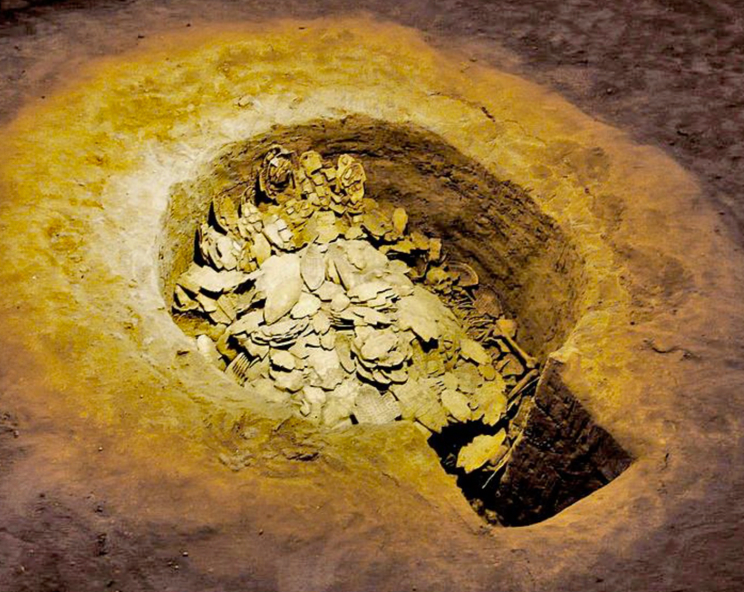 |
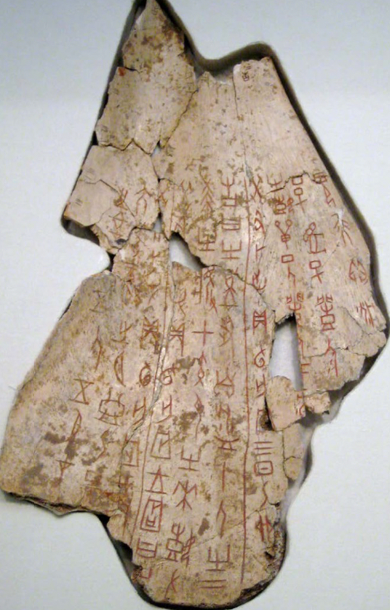 |
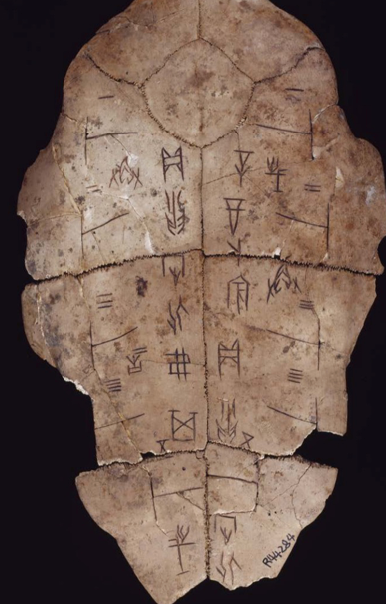 |
where the scripts on the oracle bones are largely reflective of the elite life at Shang, since using them requires the Emperor
-
the word 卜 comes from this, because its sound “Puk!” mimics that of the cracking of oracle bones. Hence 卜 has the meaning of divination now.
-
an example of text from the oracle bone:

however, we are not to conclude that women are having less more than men, as there are cases where giving birth to daughters are considered auspicious according to records.
Warefare and Polity: consider from the extracted text:
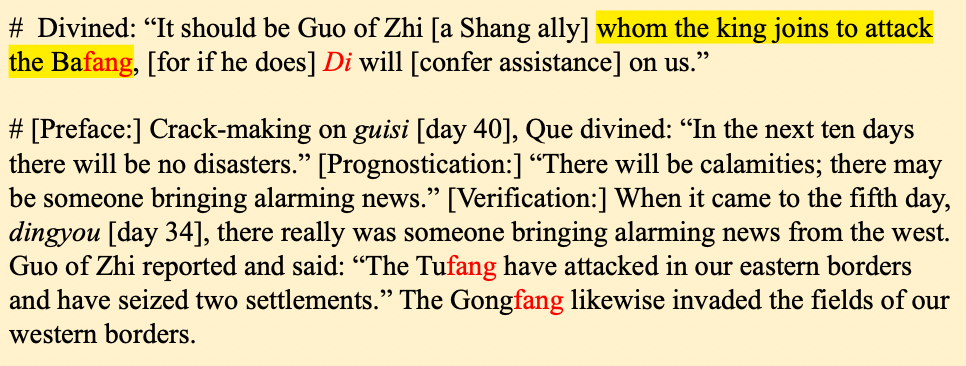
where Di refers to 帝, a Shang deity; suffix of “fang” means enemies. From here we also see the role of oracle bones to warfare. But what about polity?
- Qiang people were being slaves and used for sacrifise. In many Shang’s work large labor is needed. Qiang people might be the man power.
- Concentration of power and wealth was greatly at the elite. And even artisan (e.g. making potteries) are much better off than peasants.
The role of Women: the case of Lady Hao:
- it is unclear what normal women’s life are like at Shang due to lack of records (all oracle bones with scripts are used by/for the Emperor)
- but what is known is that elite women (e.g. Lady Hao) and elite dead ancestors (e.g. Emperor’s Grandmother) had influence and power
- e.g. Lady Hao’s tomb had great amount of lavish goods
- Lady Hao during her time was “hard as the bronze, soft as the jade” as she was great both at war/fighting to extend Shang’s border, but also raising the kids. She was also being well respected by the people.
Shang’s Piece-mold Technique: for more details check out the book chapter Ch.1 Beginnigns of the Written Record.
- very pottery based, hence explains why artisans could have a better life
- bronze casting required much material and technique. Hence it is mostly restricted to elites’ use. Most people use stone vessels as alternatives.
Shang’s Bronze: Ritual Purposes
-
the bronze used at Shang typically had intricate patterns featuring animals such as fish, snakes, dragons, etc. This is because they believed animals to be related to Shaman, and hence are an intermediary for connecting human and the spirits
-
among the animal motifs, one dominates: tao-tie 饕餮 (a beast with insatiable greed)
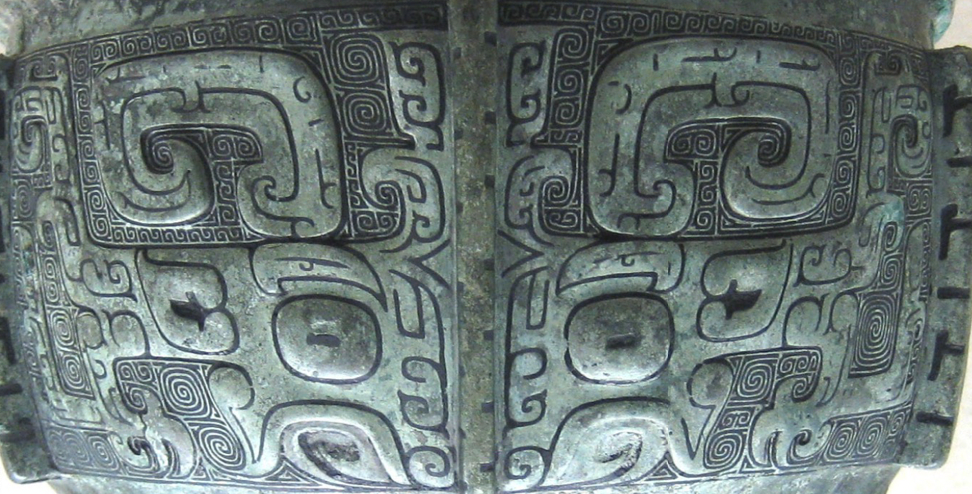
until today we are not entirely sure why this is preferred/appear so often on the bronze vessels. Religious purposes? Artistic purpose?
Masks of Sanxingdui: made of bronze but appears completely different from that of Shang. It seems to require less technical intricacy, but also very different in look.
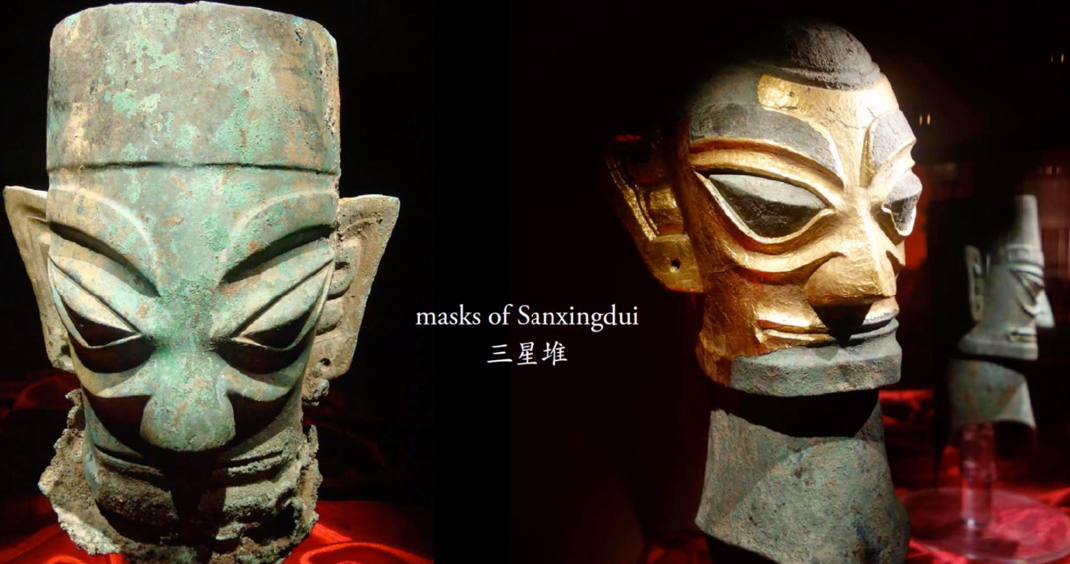
- what could this be used for? We don’t know either.
- it is found to the south west of China (四川), where people at the center (中原) sees as uncultured.
- after examination, it appears to be techniques mixed from many different regions.
Chinese Texts: its feature of being pictographic and having a 1) radical and 2) phonetic component is discussed in the book chapter summary Ch.1 Beginnigns of the Written Record.
-
but it is interesting to see the evolution from past texts to today
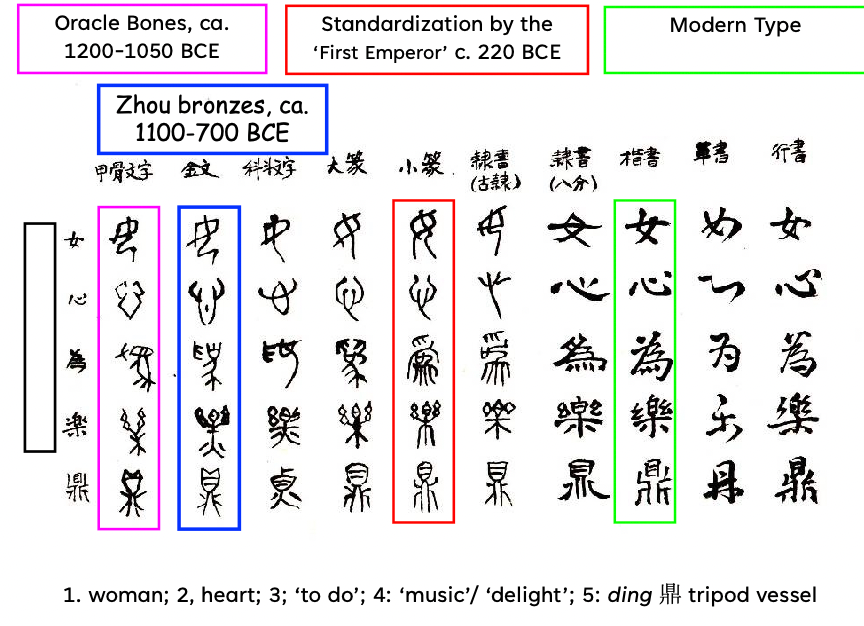
Summary:
- Oracle bones: disc. by accident, tortoise plastrons and ox scapula used in ritual divination, contain archaic form of Chinese writing and corroborate later written historical accounts, tells the Shang political and religious system
- Ritual bronzes: primarily for ritual purposes, funerary/ancestral sacrifice, taotie
- Lady Hao’s tomb
- Sanxingdui: another Bronze civilization in China
- Bronze age: development of city-states that control territory; Erlitou and Yin are dense urban centers and centers of a regional economy, ruled by ‘royal houses’ (connecting Xia and Shang)
Western Zhou (c.a. 1046 - 771 B.C.E)
On a broader picture, this is the rough timeline of how Shang relates to Western Zhou.
- Zhou Kingdom, once tributary state to the Shang, deposes the Shang in 1045 BCE
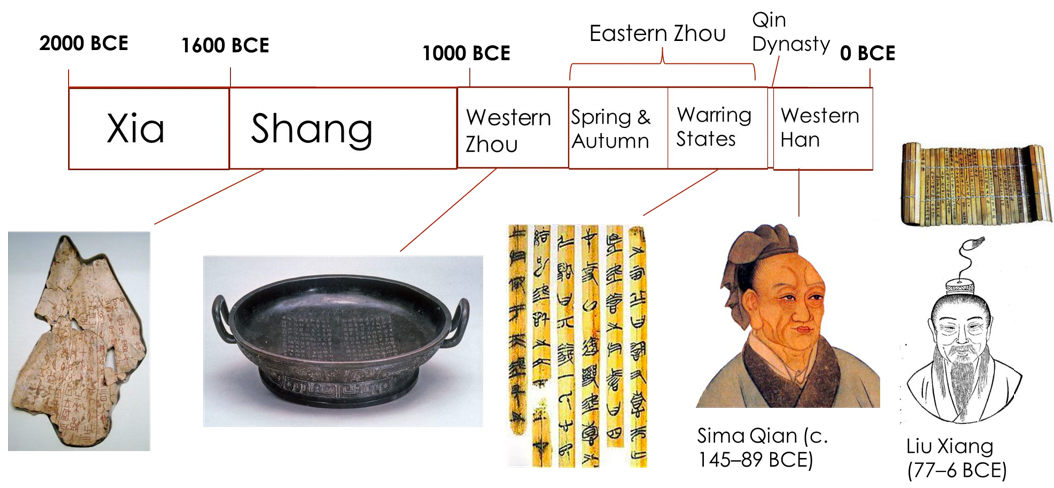
But before diving into evidences and stories of Zhou, we need to take a note of the difference between how Western Historians see Chinese histories and how Chinese scholars investigates it:
- Western: “wie es eigentlich gewesen ist (“how it really was”). They are interested in knowing what exactly has happened
- Chinese: moralistical interpretation of the past, want to use history as a moralistic lesson to descendants (in fact many histories ARE written that way)
Records related to Zhou: in general there are texts that are recorded by the Zhou people/people alive near the Zhou period, and the ones written much later
- Confucian Classics
- Shangshu 尚書 – contains alleged speeches of the early W. Zhou kings
- Shijing 詩經 – Liturgical hymns (W. Zhou) and folk songs (Spring & Autumn)
- Zhouyi 周易 – Divination manual
- Later Histories
- Shiji 史記 by Sima Qian 司馬遷 (145 – c. 86 BCE) – synthetic Chinese history of first century BCE
- Bamboo Annals (zhushu jinian 竹書紀年) – annalistic history of bamboo slips composed in 298 BCE and rediscovered in 279 C
Bronze Vessel = Power: though often used for ritual purposes (still), making exquisite vessels still takes time and money
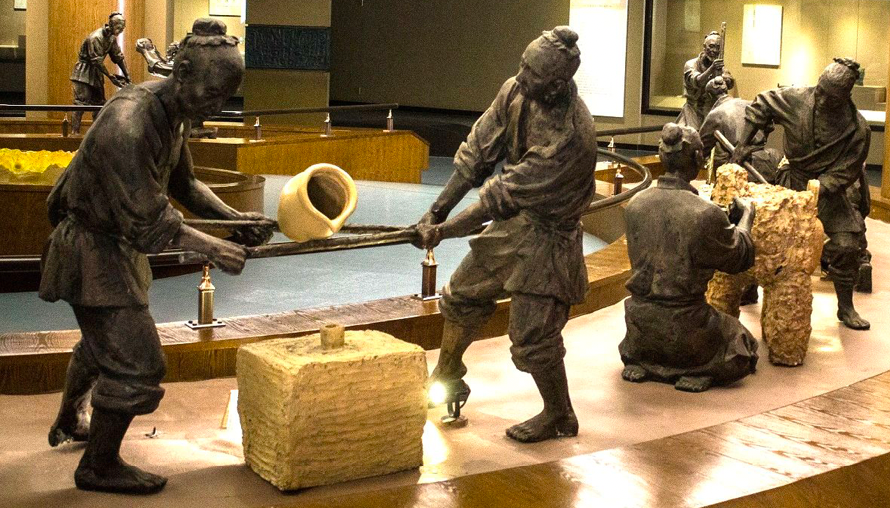
- therefore, bronze vessels is still an embodiment of power, making them suitable for gifts when Kings awarded to lords
- mostly concentrated and controlled by the elites. This can also be inferred from the high uniformity of style across vessels = is regulated/controlled
- many inscribed text on the bronze vessels, which can be used to study Zhou’s culture (but whether if this is a faithful representation of the history is debatable, as those vessels are used for ritual purposes)
From Shang to Zhou:
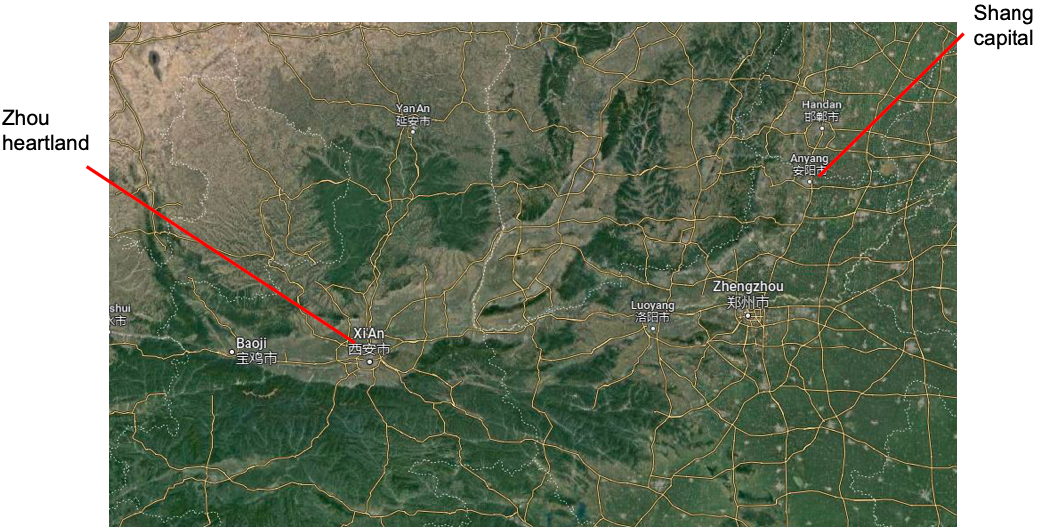
- Battle of Muye was a battle fought between the rebel Zhou state (King Wu of Zhou 周) and the defending army King Zhou (纣) of Shang, captured their capital Yin and ended the Shang dynasty.
- Zhou then settled their captical in Xi’an, near wastern side of the Wei river.
Settlements of Western Zhou:
| Settlements | Overall “Border” |
|---|---|
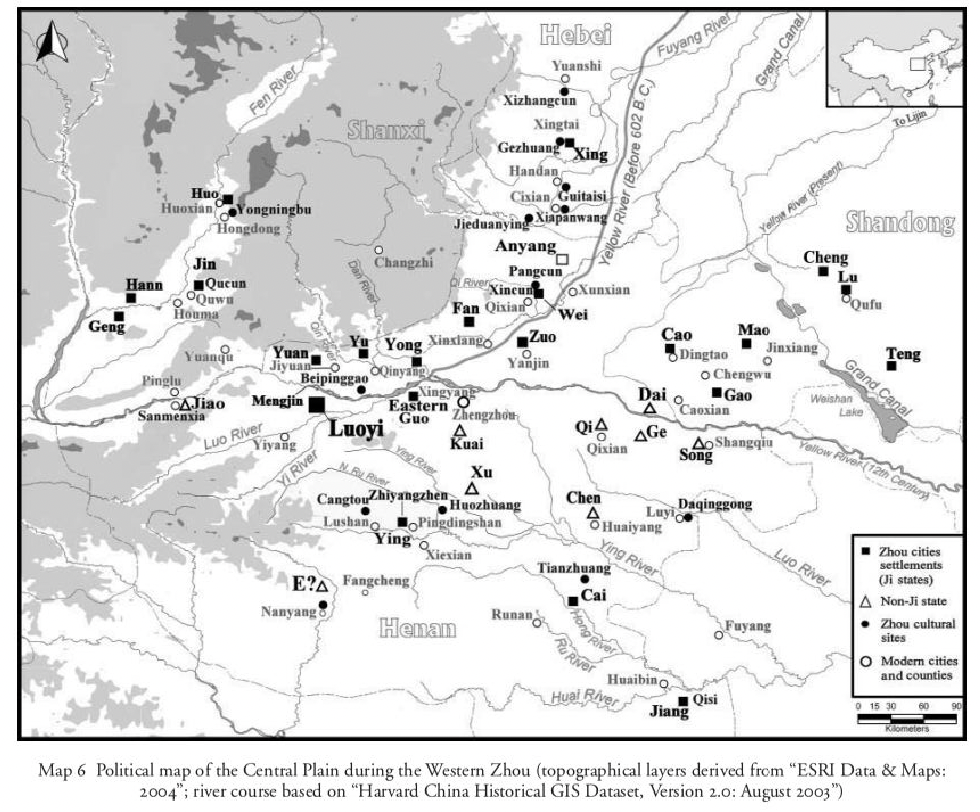 |
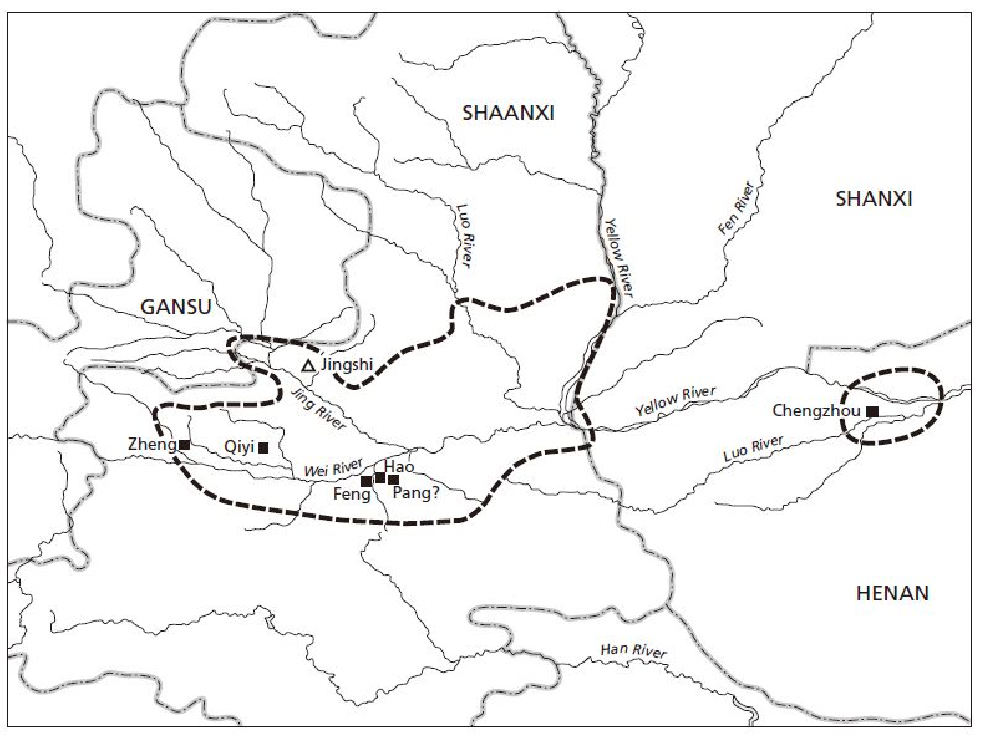 |
- as you can see, most settlements are to the west/north of the Wei river.
- Chengzhou (modern-day Luoyang) constructed soon after the Zhou conquest and served as the administrative center of the Western Zhou state on the eastern plain
- later when Western Zhou got defeated and had to move to the east, they went to Chengzhou, captial of Eastern Zhou
Western Zhou Kings and Shiqiang pan 史墙盘
| Western Zhou Kings | Shiqiang Pan |
|---|---|
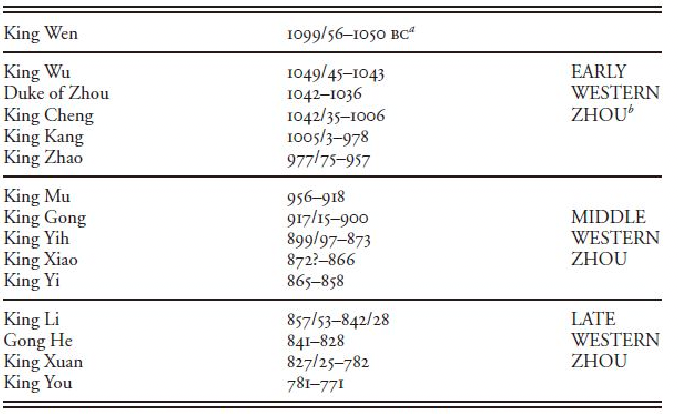 |
 |
-
Shiqiang Pan contains two pages of texts, seemed as the “first concious attempt in China to write history”
-
on the Shiqiang pan, it contained, in order: a) extol of former kings b) extols of former ancestors c) dedication of the vessel
- but there are attemps found that recorded texts are too “good”
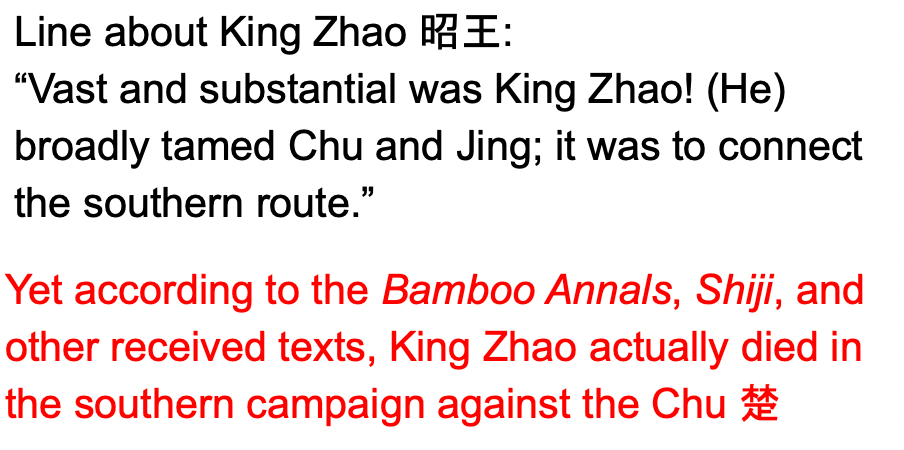
Reducing Power in Late Westerm Zhou:
- in Lai Pan, the structure became to extol ancestors first, but not the Kings
Invasion of the Rong (non-chinese people)

- along with Zhou, Zhou’s territory including Qin state (秦, which later took over and start Qin Dynasty) relocated towards their other captial Chengzhou (today Luoyang)
Eastern Zhou (770 - 256 B.C.E)
Again, a brief outline of the periods:

even though Zhou dynasty is the longest in history, Zhou Kings has declining power starting/becomes a figure head from 771 B.C.E.
- Qin King called him self Qin Emperor, hence imperial period
Geograohically, the two period looks like:
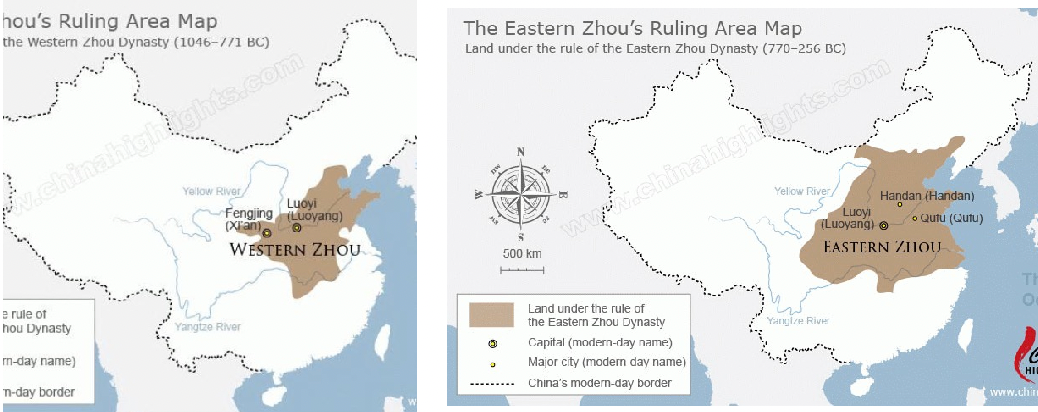
- Western Zhou: capital in area of modern day Xi’an
- Eastern Zhou: capital in west sacked, moved east to Luoyang
And then Easter Zhou is (long hence) divided into two halves: 春秋 and 战国
Spring and Autumn Period (722 - 481 B.C.E)
At the Start of 春秋, the distribution of polities (resulting from declining Zhou King influence):

- decline of Zhou power, rise of vassal states
- early china composed of a large collection of different polities
Among the several vassal states, the major ones include 晋,齐,秦,楚:
| 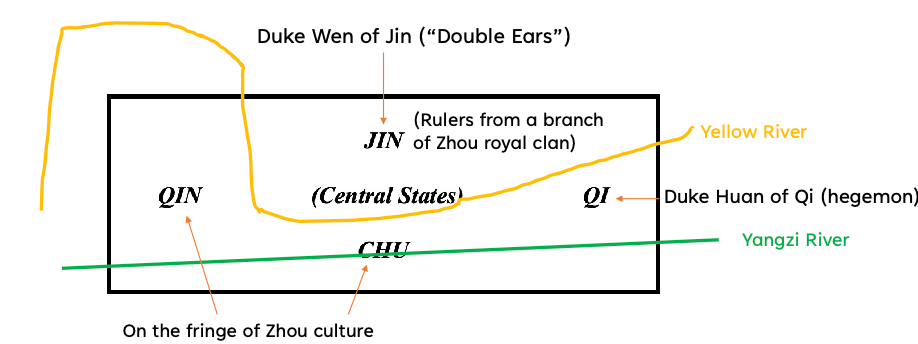 |
| 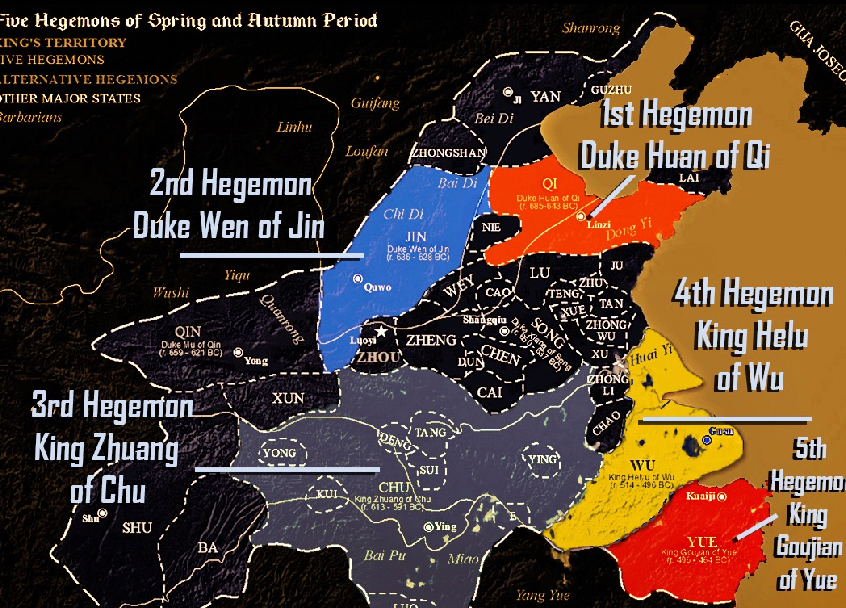 |
| :———————————————————-: | :———————————————————-: |
|
| :———————————————————-: | :———————————————————-: |
- these polities are also the hegemons
- hegemon: something (such as a political state) having dominant influence or authority over others
- this means that those states can interefere with sucecesion, hold meeting inter-states, etc.
- one important hegemon is the 晋文公, who was in “exile” for 19 years in Di, but came back and become the Duke for Jin, and reformed Jin’s military power to become one of the hegemons
- another important hegemon is the Qin, who were initially non-chinese/considered by people at the central plain as less cilivilized. They were adopted as “chinese” by donaintg troops to Zhou King
- the Qin state absorbed cultures from two of the Four Barbarians from the west and north, which made the other warring states see their culture in low esteem
- overall, this period is very violent, due to inceases in tension between states, insecurity, and betrayal. Yet there are some courtesy for battles and benevolence (e.g. not wipe out the entire lineage)
Besides the central states 中国, the four important non-chinese neighbors are important to mention:

where mostly the boundaries are made for geographical terms, meaning their is still culture diversity/similarity between them
- e.g. Duke Wen of Jin born by a woman in Rong, went to Di during exile
- The Master said, “The Yi and Di tribes, even with their rulers, are still inferior to the Chinese states without their rulers.” ––Analects, 3.5
453 BC Jin fell apart, partition of Jin between rival families into the three states of Han, Zhao and Wei
- this event is also the watershed between the Spring and Autumn and Warring States periods, refers to the division of the State of Jin between
|  |
| 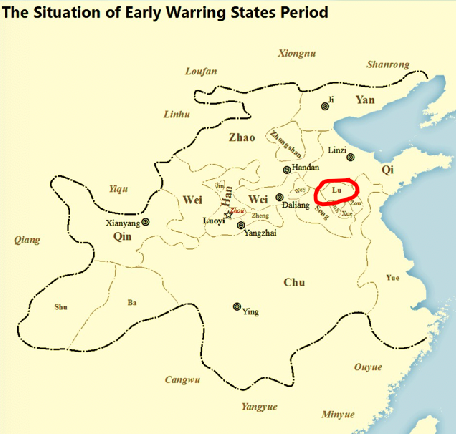 |
|  |
| ———————————————————— | :———————————————————-: | :———————————————————-: |
|
| ———————————————————— | :———————————————————-: | :———————————————————-: |
Under this turmultous condition gives birth of thinkers: Confucious (ca.551–479BCE), Kong zi, Master Kong
-
born in Lu, full of internal division within. Lu later becomes very weak and is absorbed by Qi
- Confucious is perhaps the author of The Spring and Autumn Period and the Odes.
- wanted to be advisor, but never succeeded, hence became a private tutor and earn a living teaching (a lot are aristocrates learning some courtesy)
- want students to be actively learning
- always think about “why did China become like this? How can we restore the order?”
- believe that this is because the Zhou’s ritual and order is not properly practiced by people, hence this mess
- hence also aspires one of the first rulers in Zhou, leading the people with benevolent and virtue
- gives rise to the ru儒 class, being people who are specialized in practicing rituals
Analects 论语: collection of conversations assembled after Confucious death
-
“analects” means fragments—requires reader to connect fragments. The Chinese title, Lun Yu, means “assorted conversations.”
-
it is not an essay that follows an argument structure, but structured around some key terms (e.g. li 礼)
-
some most important concepts involve
-
li (ritual), some aspects of which this key concept is about includes:

- worship: how to make offertings to gods
- rites: how to marry; how to mourn the dead, etc.
- daily decorum: how to interact with one’s lord, parents, partners, etc.
- morally appropriate, proper, right.
-
ren (benevolence, humane, etc)
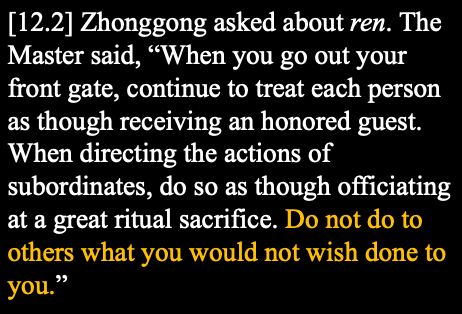
-
junzi: the gentleman/noble person is not a vessel

he believes a gentlemen is not a person of a specific capacity— not limited to one capability. Instead, the gentleman attends to the entirety and integrity of his person—he tends to his de (moral force; magnitude of character)
- redefined that nobility does not come with birth, but through learning
-
social roles:

against social flux, even though his teaching could be a proponent for it.
- not the first time there is “some” contradiction within him
- another one mentioned in the book is his claim of 述而不作
-
morality and legality

-
How did tradition, transmitted by classicists such as Confucius, view the first Zhou kings?

- Duke of Zhou consolidating the foundation Western Zhou, being a very capable leader
- seems him as a very upright person: succeeded power from young cousin (normally father-to-son succession) and promised to gave away when he is older. In the end he made his promise.
- Confucius is inspired by Duke of Zhou (paragon of de (virtue) and human excellence) to define his Dao/way of teaching
- Confucius thinks we should return to the period of order/patrician society. But rulers at this time rejected this idea as it is too dangerous to their own establishments power. Therefore, unfortunately during his period, his teaching remain a minority view
Servicemen (shi 士) class during the Zhou period
- constant warefare in Spring and Autumn experience a decline in aristorcracy, with infantry + crossbows being effective army = transformed the shi class
- shi started as the nobility/aristocrats for warriors in Western Zhou
- early Zhou (feudal order): mounted knights; special retainers. late Zhou (Warring States): need specialists, technicians in all kinds of fields (e.g. defense)
- Therefore, there are many social fluxes, including warriors to advisors, ministers, etc, and enables man of humble origin to climb = **shi class ** becomes a mix of people from non-noble classes specialized at different things (using education)
- after Qin dynasty (imperial era), especially in the Song, shi beame officials; scholars
- the changing definition of Shi shows a decline of nobility (and is later critical for the emergence of 科举), that throughout periods it is talent and knowledge people are seeking.
Warring States (453–221 B.C.E.)
Previously in 春秋
- If Western Zhou was “golden age” portrayed by Confucian (who wants to go back to those glory Zhou period) school, Eastern Zhou is a time of political fragmentation, incessant warfare, and moral decline
- Confucius’ portrays himself as a restorer of tradition, but could be viewed as reformer; his legacy is continually contested, reinterpreted by followers
- yet remember that his school of thought remain a minority view during his period
- key Confucian ideas captured in fragments through the Analects, compiled by disciples (bamboo strips 3rd c./books 2nd c.); emphasizing ideas of ritual (li), benevolence (ren), filial piety (xiao), and the virtues of the gentleman junzi.
Overall situation in Warring States
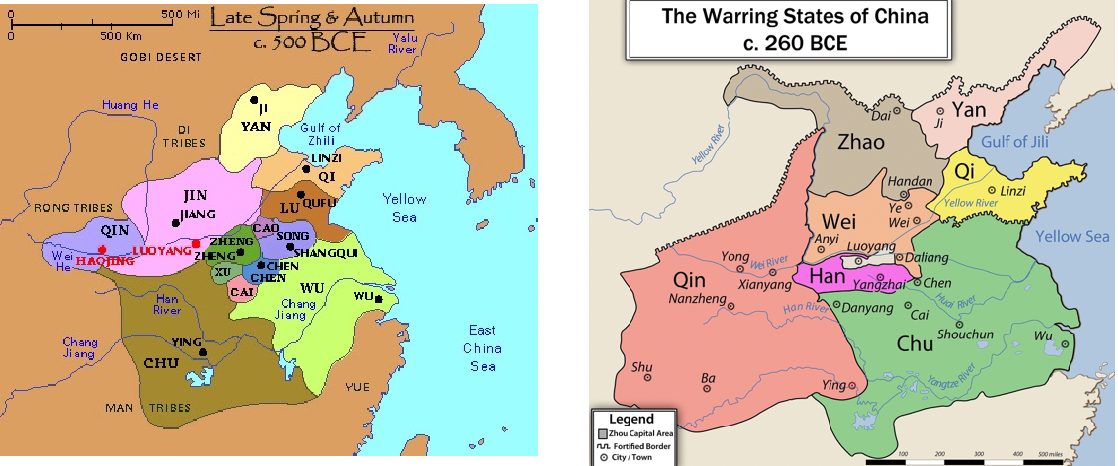
- disintegration of Zhou order and inter-state competition & warfare
- states such as Chu and Qin became very powerful (most smaller, weak states are already conquered)
- “ally your self with distant enemies, and conquer near enemies”
- at the end of the period, we know that Qin conquered all other states
Major changes in the Warring States
-
during 春秋, battles involve using chariots and training few elite warriors; but during 战国, concentrates on training large infantry
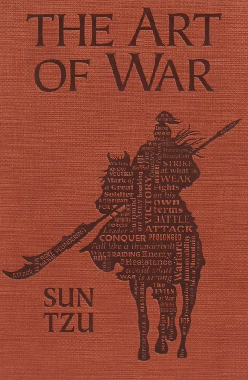
and the importance of strategies (e.g. induce the enemy to destroy themselves). In The Art of War, a lot of idea is about how to “outsmart” your competitor without physically engaging, hence useful in many modern situations as well
-
usage of iron both for agriculture and weapons
-
need money to maintain large army
- increase in the practice of taxation
- argiculture and commercial development: the use of money

note that Qin used the round coin. Later we found different coins scatter everywhere, meaning existance of wide trading.
-
dynamic market for specializations
- lots of trading, city grows in size, population grows
- noble class no longer hold monopoly on intelligence, much change in social hierarchy (e.g. advisor, the shi class)
Features of Shi 士
- these specialists were itinerant, traveling from state to state for employment.
- most attractive were methods of state-strengthening and governance.
- emphasis on governance is a common feature of Chinese thought.
- famous specialists with pupils were referred to with the “zi” suffix after their surname, which means the “Master” of a teaching
Different “schools” (jia 家) of thought
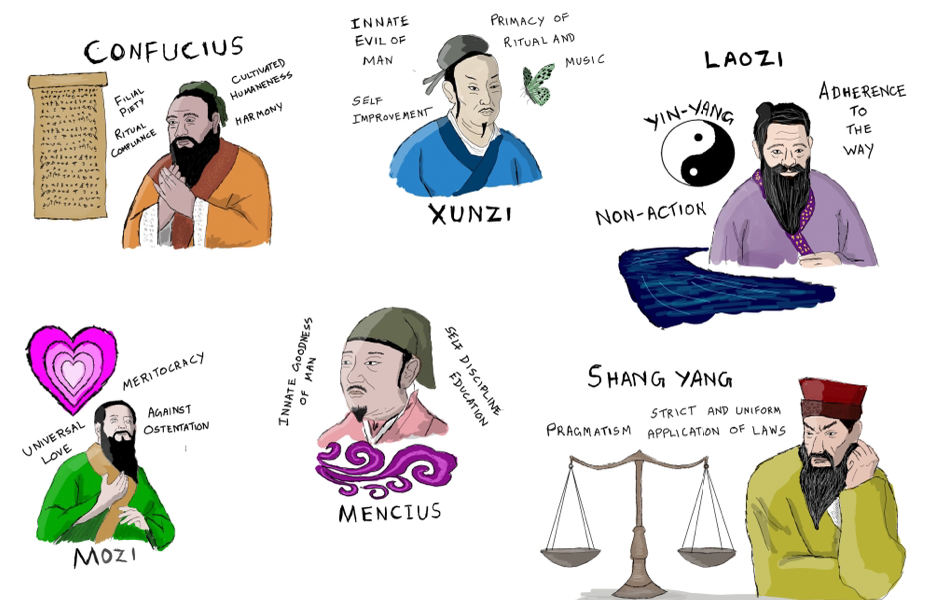
- not necessarily an actual institutional school—instead, think of a school as a taxonomic “family” whose members exhibit family resemblance.
- many ideas are shared across groups:
- filial piety not exclusive to “Classicists” or followers of Confucius.
- “Daoists” teach about the “Way” (dao 道)—the principles of the world and how to live in it—but all masters use this term, but in different ways.
- most concern with how to govern
Mozi: 兼爱
- most followeres are commoners/artisans
- very influential during the period (perhaps because they are specialists in artisan = defense), but died out durint Qin
- 兼爱: love for all, no special regard for parents, etc. Against confucious, who believe that family relationship is the most importatnt.
- hence rejection of offensive wars; military engineering and technology
- additionally, ritual and music is for ruling class, and is fundementally selfish since you are mourning your own lineage. Hence Mozi is against it.
- Developed systematic rules of logic to persuade people
- deep commitment to reason: argue in a rational fashion
- Why obsession of logic: let people of different origin understand and accept their ideas
Mencius: Human Nature is Good
- namd the second sage after Confucious
- regarded himself as a follower of Confucious
- his book Mencius is later used for 科举
- occupied high political power in Qi
- believes that “Human Nature is Good”
- everyone has the potential to become a sage (developed their moral throgh long and hard study and reflection)
- human are born with benevolence, rightenousness, ritual, wisdom. But you need to cultivate them through learning.
- believes in every man’s potential to become a sage
- against Mozi, as Mencius believes it is impossible to show same love to others, because human beings are inclined to love their own families more
Laozi: Dao道 (and Daodejing)
-
Dao today refers to idea from Daodejing, and the book Zhuangzi
-
many messages in Daodejing is debatable and mysterious
-
Dao cannot be described

-
but Dao is the way of nature
-
-
Confucious Dao: the way for human beings to behave ethically and moral. Laozi and Zhuangzi’s Dao: the way how universe/nature works.
- Laozi/Zhuangzi believes that Confucious exaggerated the importance of human being. Others ranging from the useful and the useless in nature should also be considered as well
- “human is a small part of the nature”, and in the end achievement of certain goals cannot be done without nature
-
therefore, emphasis on wuwei 无为

- non-interference, and have no excessive desires
- believes that persuing non-intereference will have positive impacts on the society
for example, for government you should also not interfere with people too much

so the ruler should stop acting when the system is inplace.
-
relativity of value
|
 |
|  |
| :———————————————————-: | :———————————————————-: |
|
| :———————————————————-: | :———————————————————-: |- advantage of the weak, strong and weak can become each other
Zhuangzi: 自然 (another Daoist)
- dreamt himself of butterfly, questions knowledge and beliefs we taken as granted
- the narrative style of Zhuangzi is different from other philosophers. Other philosophers teach in an opaque way, but he does it with playfulness and examples
- Confucious portrayed as a proper learner, but Zhuangzi appears eccentric and unpredictable
- both Laozi and Zhuangzi see Dao as the nature they must accord with, but there are differences
- Laozi discusses about governness, and protecting the weak
- Zhuangzi is not interested in politics (recluse), celebrated ritual freedom. Searching for conception of life
Different thoughts of Masters: “when your parents die, how should they be mourned?”
-
Confucious: three year mourning period
-
Mencius: just do what your heart believes is correct.
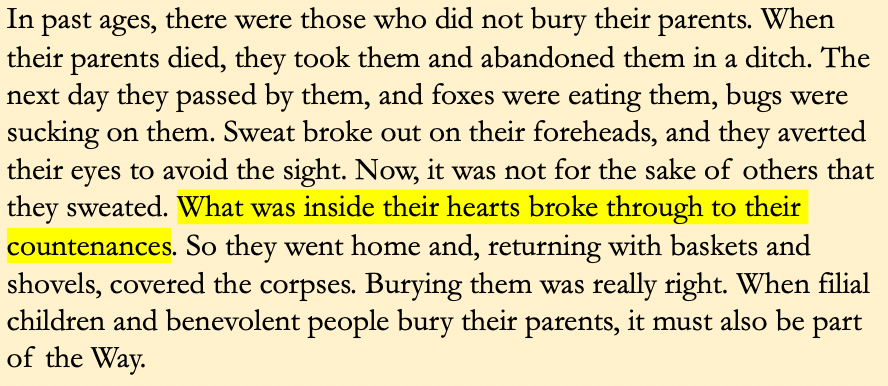
-
Mozi: a limited resource should be used to the right places/frugality
-
Zhuangzi: life and death is part of the natural process, it just part of the natural changes. So it would be foolish to attach yourself to changing things.
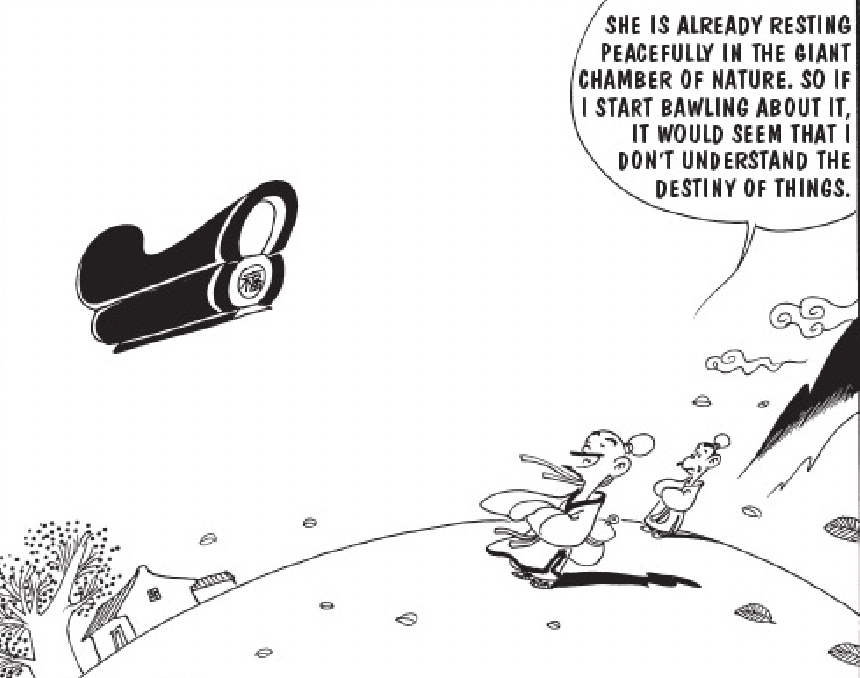
i.e. you should not try too hard to change things.
Legalist: 法 (very pragmatic)
-
Han Feizi as an example of Legalist, a student of Xunzi (Xunzi thinks human nature is evil, and coersion, strict teaching is needed
- has a high noble origin
- the only ruler took his teaching is Qin, which also become the emperor and united China
- but note that “the Legalist teachings 法家 in Qin was so repelled, by Xunzi, but they proposed a radically new way of organizing the state and its subject that allows its adherets to unite the realm for the first time”. So while Xunzi believes in the important of education to make the society behave, later legalist believed in coersion/law/punishmnets.
-
believes that people are naturally anti-social (e.g. killed girls to favor boys at birth)
- evilness of human nature the root of trouble = political unrest
- so ruler must be always on guard even for his advisors, officials, etc
-
disagree that Confucious notion that government should be based on moral and ritual, and emphasized laws and praticality
- must be easy to follow
- must be consistent
- must be backed by substantial reward and heavy punishment
people should be controlled by punishments and rewards
-
different interpretation of wuwei
- The ruler should conceal his motives and desires, for then the true characters of the ministers will be plain; otherwise the ministers will “polish themselves accordingly”
- Let the ministers do the work: the ruler take the credit; ministers take the blame
- in a sense defend the position of power. note that Han Feizi is noble.
essentially for a ruler, law applied to everybody except the ruler
-
but note that the aim is not to punish people, but to improve/correct people via laws/controls
Qin Dynasty (221 - 207 B.C.E.)
Previously on the Warring States
-
political disunity, lots of wars $\to$ disversity of political thought
-
many thinkers (Daoist, Han Feizi, etc.) have different idea as compared to Confucious
- Followers of Confucius: Mencius (Meng Zi) and Xun Zi systematize Confucian framework, elaborate on theories of governance and human nature (good/bad)
- Mozi (the Mohists) known for doctrine of universal compassion
- Laozi and Zhuangzi—contemplative recluse, philosophical relativist—presents counterpoint to classic Confucian ideas
- Han Feizi —the rule of law, all men treated equally except the ruler
- Diversity of philosophical approaches during Warring States is unsurpassed in Ch. hist; some schools–Legalism, Daoism–peak later; others (Mohists) disappear
-
Repeated cycle of union and division, which is a basic paradigm in chinese history
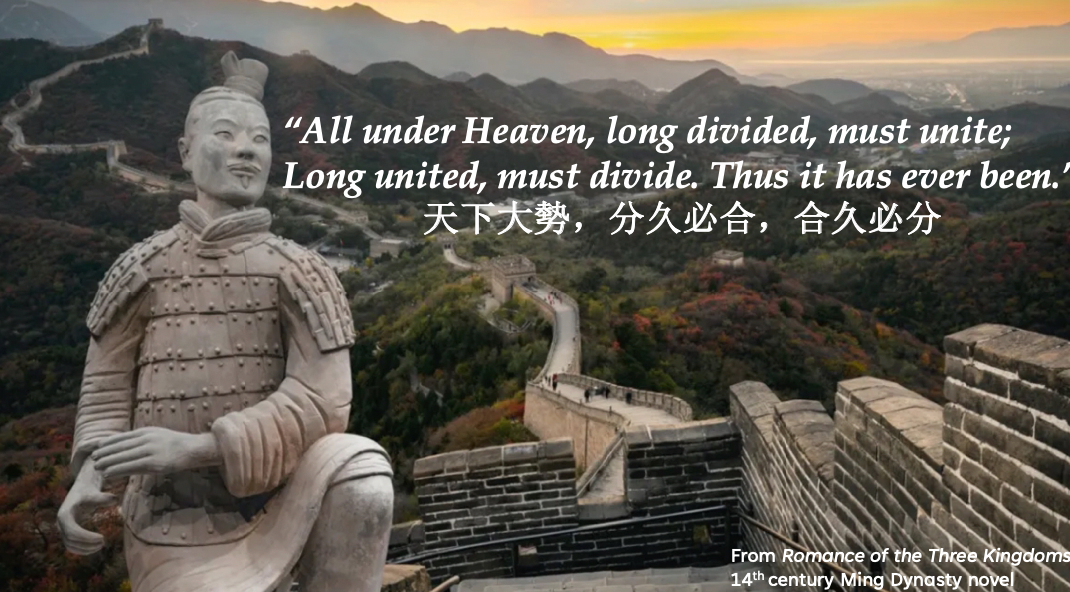
The rise of the Qin state
-
Qin became the main power during the Warring period, but were seen as a barbaric state by other states
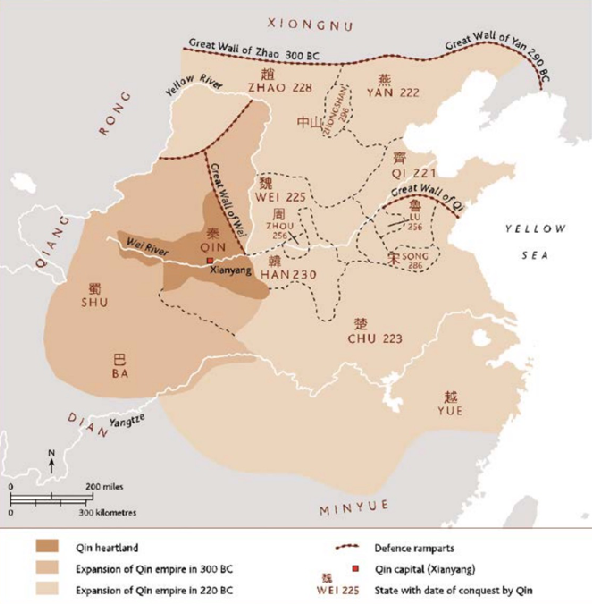
-
however, because this is a place easy to defend as it is on the outskirt, and it is easy to launch attacks
- can weaken power of nobility, later on realized by Lord Shangyang $\to$ perform talent recruitment
- western troops interaction/contact made Qin advanced in military technology and capability
- later on Qin developed a system of non-hereditary ranks, where one can rise in rank purely from achievement during war
- Qin king maintained a centralized control over all people, especially the troops
all of which is only possible because the power of nobility is weak/no hereditary hierarchy, and contributed to the rise of Qin
-
the entire conquest of Qin on other states happened during 230 - 221 BC, which is very quick!
Qin’s foreigner minister: Lord Shang (Shang Yang)
- in 361BC he become the chief minister of Qin, and wanted to make Qin a more powerful state $\to$ Legalist State
- changes he introduced include
- suppressed the hereditary nobility; ranks achieved by military merit; established bureaucracy
- country divided into county + officials, state penetration into the villages
- i.e. local farmers no longer controlled the local nobility, but by the government
- supervision between each other in a family unit
- distribution of land by offering to farmers, but land still belongs to the country = lending ownership temporarily
- direct taxation from people ot the state, instead of given to local nobility
- shrunk the family into atomic family units $\to$ can tax more people; $\to$ prevent large group which could start rebellion
- laws applied equally except for the emperor
- overall employed harsh rules, which effectively made Qin a legalist state and laid a foundation of Qin’s sucess. But had a tragic death due to harsh rules as well.
King Zheng (247-221BC)
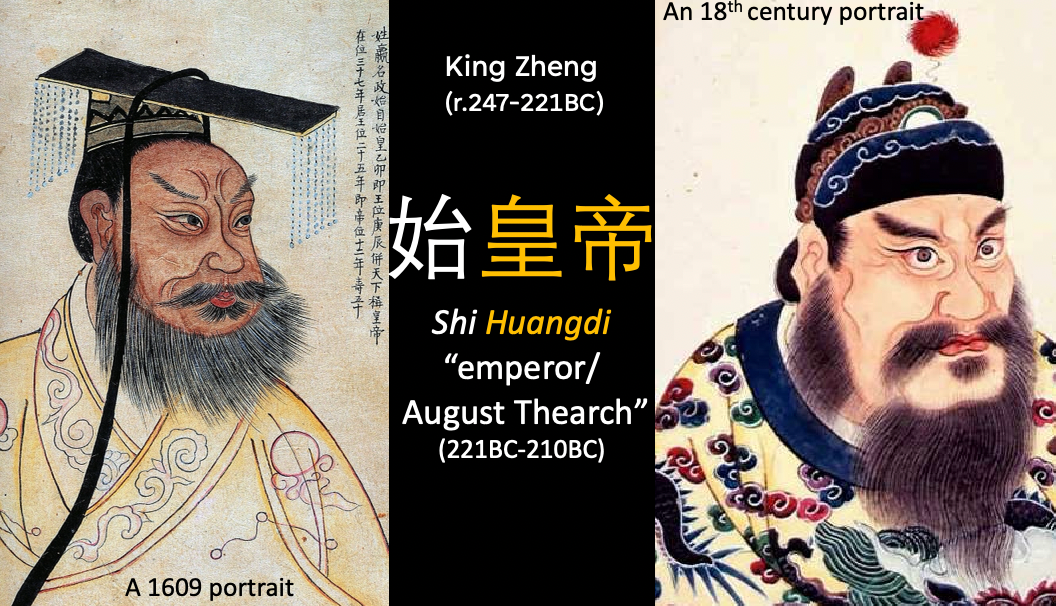
-
First Emperor of Unified China, King Yin Zheng. Named himself Emperor instead of King signifies his power presiding over the entire China
-
some viewed him as a passive beneficiary of smart officials and weak other states, hence sucess of reunification
-
but it could also be that King Yin Zheng is a controlling figure: failure of assassination prior to the unifcation of China
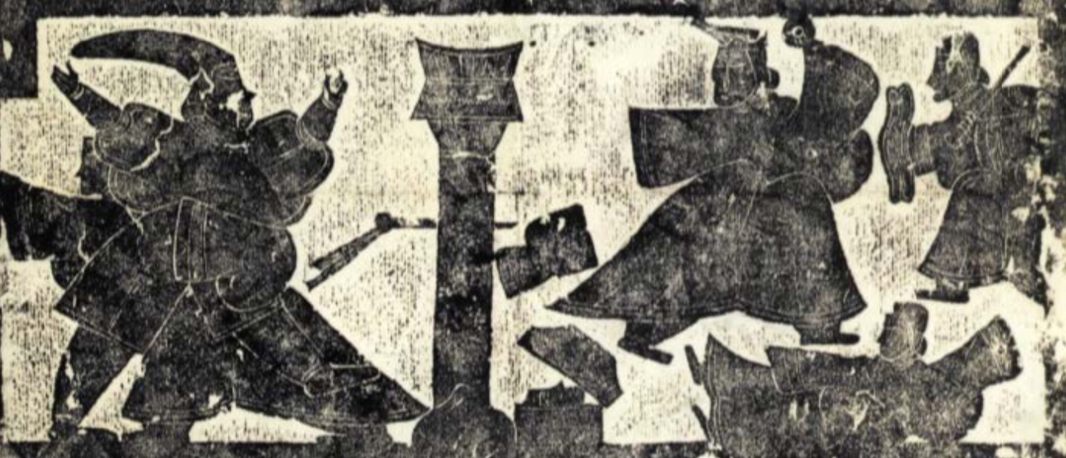
where in the figure, the person on the left that has a dagger is the assassin. The assassin Jin Ke in from the Yan state to fake for a peace treaty hence surrender, but he failed and King Zheng became infuriated and speeded up the conquer later on. This might reflect King Zheng of being a powerful figure/driving force of the country as:
- usually if ministers are the smart/driving forces, then the simples way is to bribe ministers/assassinate ministers
- but assassinating King Zheng means he is the driving force, hence he could be powerful
-
-
rised into power when he is age of 13
Qin Dynasty: lasted for only 14 years but impact is long-lasting
-
established the political and law structure until the end of imperial era in 1911
-
notice the difference betweem Fengjian and Central system
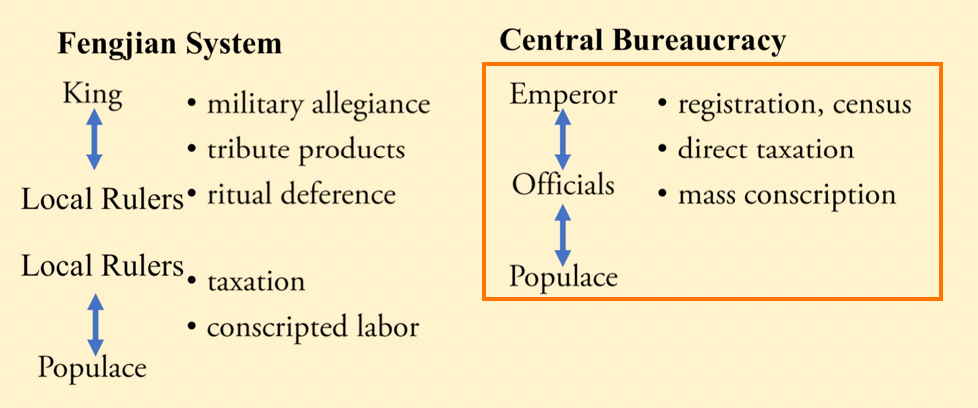
notice that now the Emperor almost had a direct control over the people.
- the Fengjian has the structure of dispersing sons/relatives with lands $\to$ let them control diverse pieces
- While this was designed to maintain Zhou authority as it expanded its rule over a larger amount of territory, many of these became major states when the dynasty weakened.
- Li Si opposed it, and believed the Central Bureaucracy by Shang Yang is better, as it could prevent the dispersion of power/rebels
-
Later Li Si’s plan is favored, and the following organization of the territory is used
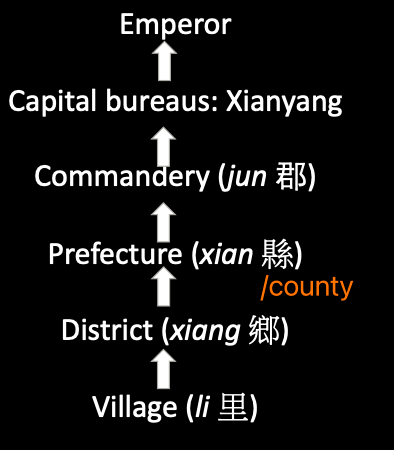
now the emperor has the peak power and everybody in this hierarchy has to listen to him
-
the entire bureucracy is funded by the universal agricultural taxation system
- at the same time, weaken wealthy clans/party, so no one can influence King’s power. e.g. sometimes taken extreme measures such as reallocated all powerful clans/local nobility to captical
- all walls for military defense is abolished, and melt down all weapons (so no more civil war)
-
Economic Standardization in Qin
-
erased diversity by unifying weights and measures
- produce in markets can be compared and priced equivalently
- weights measured by weigh
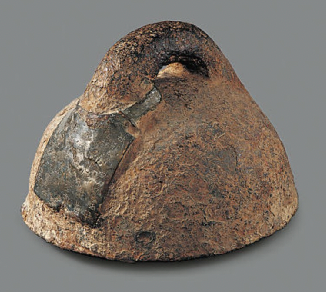
-
another important standardization is currency: faciliates trading
Other Curreny to Qin Qin’s Currency 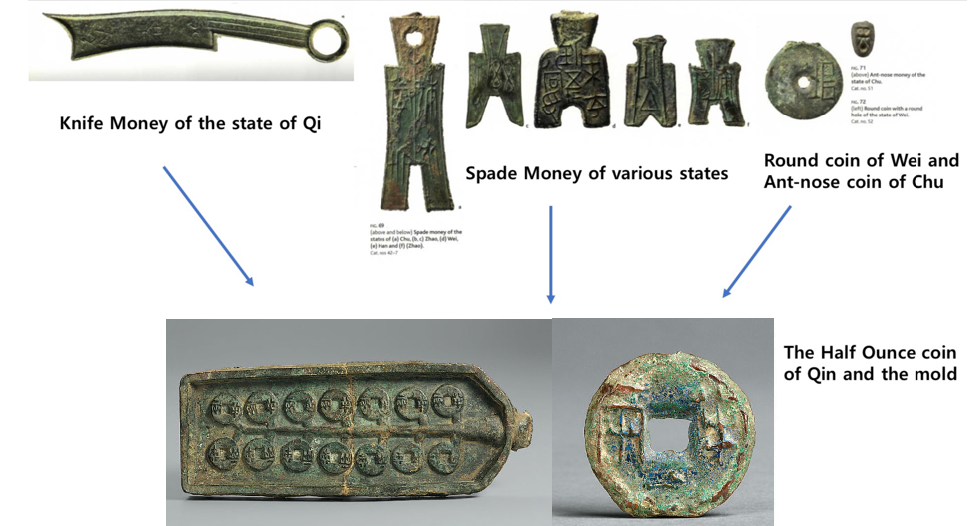
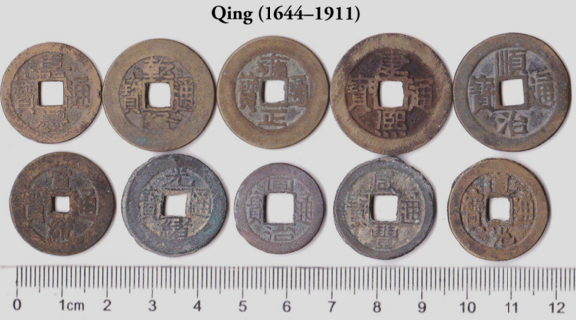
-
unification of script. For instance the word for “horse”

which is advantageous for communications between each other/different states
- done by Li Si, by rationalizing the Zhou script
- symbolizes the cultural unity that Qin intended
-
more than standardization: knowledge control
- burying of scholars alive (uncertain): Confusious preferred Zhou’s structure, but Li Si is the chancelor and is totally against it
- Confucious hated Qin, hence people afterwards, e.g. in Han dynasty, who are followers of Confucious could be biased
- buring of books (confirmed, 213BC): burned all Confucian classics, and whoever buys it will be executed (view this as an enemy of Qin’s progress).
happens because Qin wants people to forget about Zhou/past, and corroberates current policies. But it does not mean to abandon all values from the past as well, e.g. lack of filiaty is still punished
- burying of scholars alive (uncertain): Confusious preferred Zhou’s structure, but Li Si is the chancelor and is totally against it
-
legal standardization: standarized rules for all (except ruler)
-
later Han dynasty described Qin rules being very harsh
-
but the truth is complicated: low ranking offical Xi’s tomb in 睡虎地 found
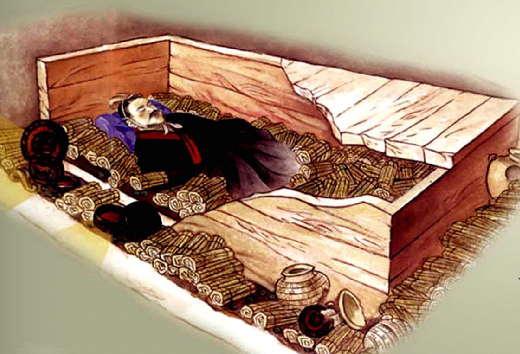
Qin books on laws, which is not that harsh but rather detailed and meticulous
Logics on Punishment Women v.s. Men 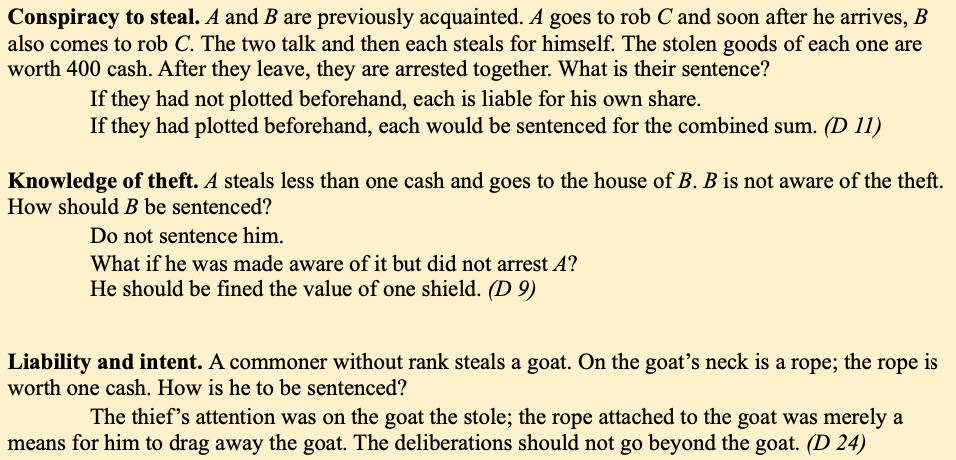
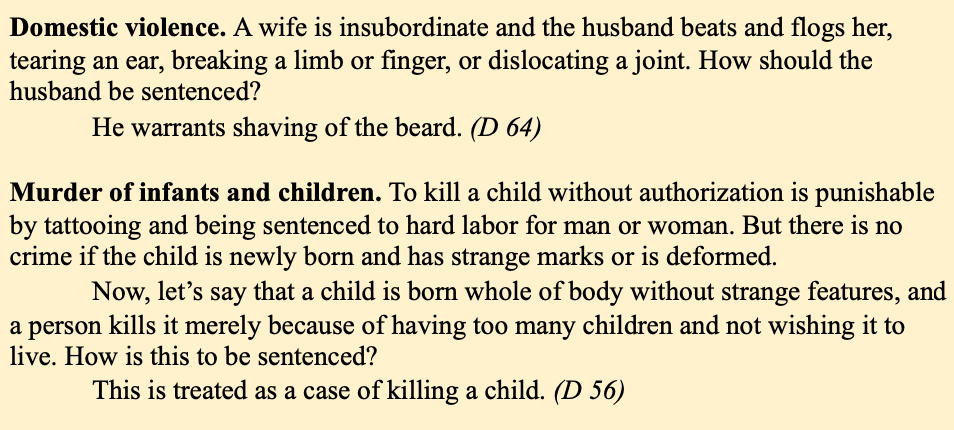
additionally, we also see some much more power of man than wives
-
Qin Transportation System: e.g. road network (4000+ miles)
-
strength economic ties between regions
-
wall built during Ming Dynasty, but some foundation was laid out during Qin
- as expression for shielding off enemies, like in Longshan period
- wanted to wall out non-chinese tribes to north (Xiongnu) and wests
- Qin recognizes its limits of power, by delineating is boundary clearly for the first time
Existing Walls during Qin Great Wall we see today 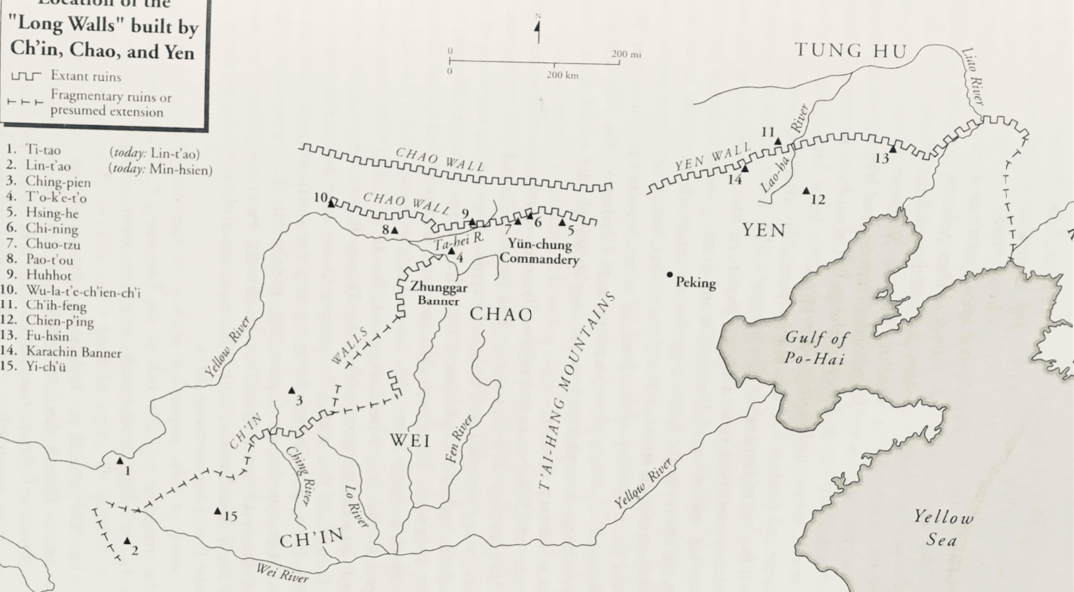
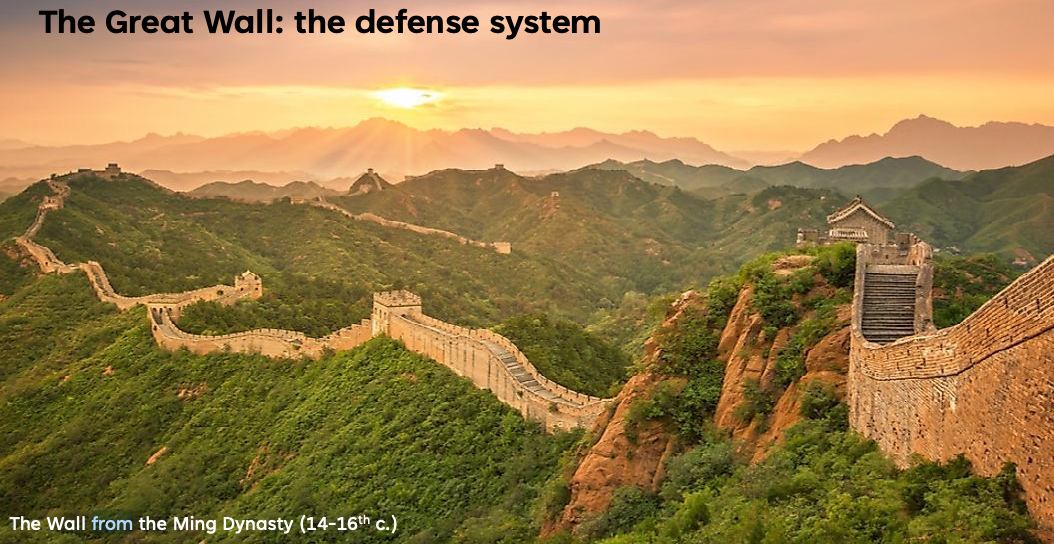
where essentially Qin is linking the existing walls together. Note that during this period, Qin assigned a military official because
- those walls are on the outskirts, hence skirmishes would happen a lot
- need to managed a large group of people, which is a skill more common within military
Qin’s Death: Terra-Cotta Army

-
used for Qin emperor to fight during the underworld (belief in afterlife, that military he defeated will prusue him in afterlife)
-
soldiers were originally colorful
Han Dynasty (202BC - 220AD)
Previous on Qin Dynasty
- 230-221 BCE: Qin conquest ends the Warring States period, results in unification
- 221-210 BCE: King Ying Zheng of Qin proclaims himself ‘emperor’ Huangdi, reigns as first emperor (Qin Shihuang)
- Liu Bang (Emperor Gaozu): the founder of the Han
- Qin state began as a politically and culturally marginal power, which is strengthened by Shang Yang’s reform
- then Han is corroberates by Emperor Wu (Wudi)
- Shang Yang’s reforms majorly included bureaucratic government, merit-based appointment, and administrative and tax reforms—direct relation to ruled
- Li Si, after the conquest, builds upon Shang Yang’s model, extends bureaucratic framework to standardization of weights and measures, currency, script, thought control
- Laws of Qin exresses legalist principles, but seen as were harsh by later people
- portrayed as repressive and tyrannical, but recent scholars are rejecting prejudices and acknowledges its centralizing measures and its legal codes far from arbitrary
The Collapse of the Qin Empire
-
In brief: 221BC Qin unification. 210BC Shi Huangdi died; his unpopular son, Huhai, succeeded the throne. 209BC Rebellions broke out. 207BC Qin ended by Liu Bang and Xiang Yu, both from Chu state (Liu Bang won at the very end).
-
Qin suffered from strong resistance on the conquered people (tax, lots of construction work), because the restructure/unification of China within a short period is bound to invoke dissent
- Especially Chu state had grudges, since Qin once broke alliance with Chu and masaacre a lot of people in Chu
-
Rebellions broke out. Some key rebellion leaders (both from Chu) include:
Xiang Yu’s Military Capabilty Liu Bang’s Social Capability 
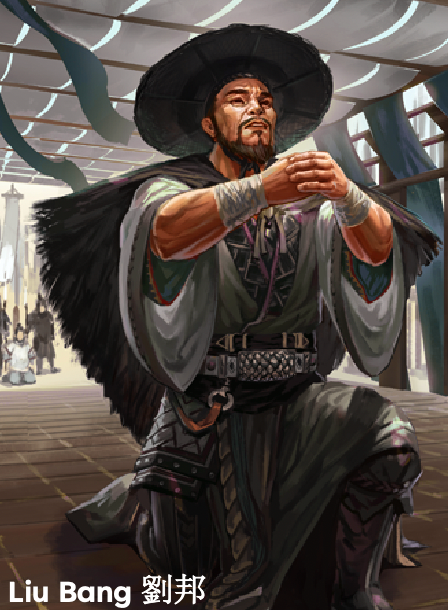
and the interesting is they have exactly different personalities and abilities
-
Liu Bang won at the very end, and started Han dynasty, named himself Han Gaozu汉高祖
-
Han is also divided into two periods, almost identical to the shift for Western Zhou and Easter Zhou
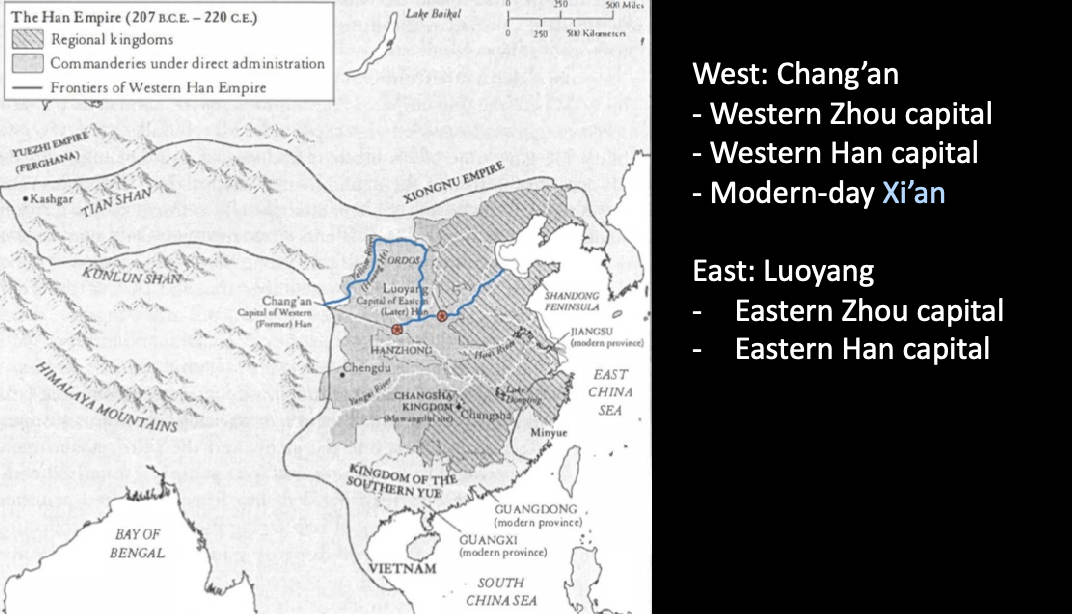
essentially almost identical to Zhou, and we start with Western Han, but later moved captial to Luoyang, hence Eastern Han
Liu Bang’s New Empire
-
Liu Bang’s first decision was whether to keep the bureaucray of Qin or start a new one (most people associated centralization of power with tyrannay at this point, due to Qin dynasty)
-
in the end, he retained most of the structure, central bureucracy, still uses commanderies, counties, appointed officials by talent, but on had a benign implementation (rules are more flexible)
-
decided to share power with his relatives, starting vassal states.
- hence only western portion, about 1/3 of the entire territory is under direct control
- easter ones are controlled by his relatives (so when he died, family still has control)
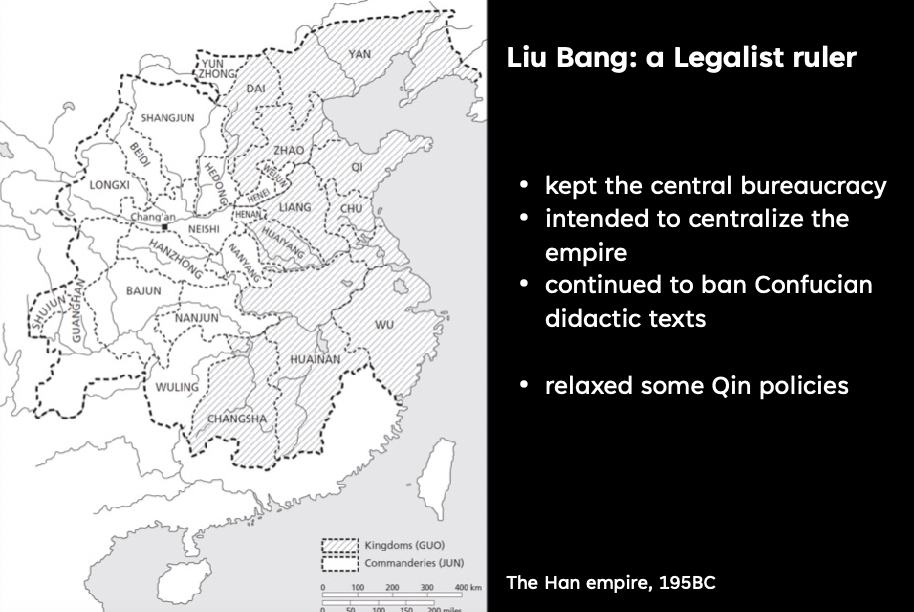
-
also didn’t like Confucious, so prohibitted Confucious didactic books
-
so in general, most policties are aligned with Lord Shang, with few changes:
- relaxed the laws of Qin a bit, by relaxing the implemenation. e.g. you can plead to the judge
- Liu Bang hated Confucious but judges of crime valued filial piety. This is no direct contraversy because the idea of filial piety is in fact common on lots of idealities, including legalism (e.g. violating filial piety will be punished)
- but thinks Confucious scholar is useful
Emperor Wudi (Liu Che刘徹)
- strongest of all Han emperoros: lots of achievements during his reign, especially his expansion of China
- Wudi is a posthumouns title due to his achievements in military, and china’s territoy expansion
- had much control over vassal states
- made Confucianism state ideoligy
Emperor Wudi: reshaping economy and politics
- centralizing the government
- instead of forcibly remove the large estate landowners, decreed lord’s land shared with heirs (so that in the long run Emperor wins)
- hence smaller control, and Wudi have more power
- periodically, rich and influential family relocated to the captial to be under supervision (similar to Qin)
- significant revenues come from state monopolies
- intent was to not overburden farmers
- hence increased taxes on private businesses
- monopolies on salt and iron, and later coinages as well
- later debated if salt and iron monopoly is a good idea as they are critical for the people, but very profitable for the Emperor
- in the long run, such monopoly disrupted the private sector of economy, and a political controversy: debate v.s. Confucianism scholars at that time on what is proper government
Fight Against Xiongnu
-
Wudi puhsed out Xiongnu (problem since Shang, exacerbated by Zhou, e.g. making peace through gifts and “peace marriage”)
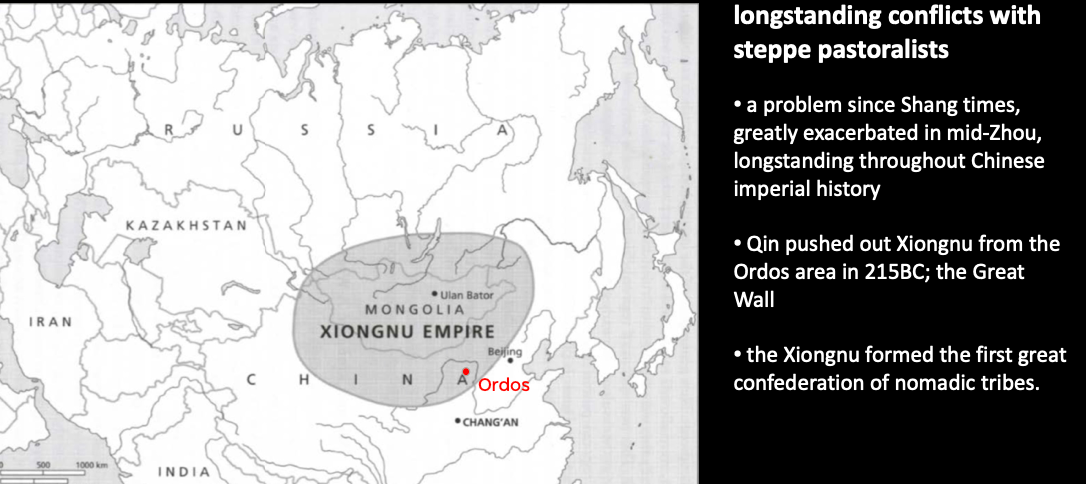
but at the same time, Xiongnu tribes fromed the first confederation
- Xiongnu might have been ancestors of European Turkish
-
also had campaigns and subdugate the various kingdoms, defeated Ferghana, got a lot of horses
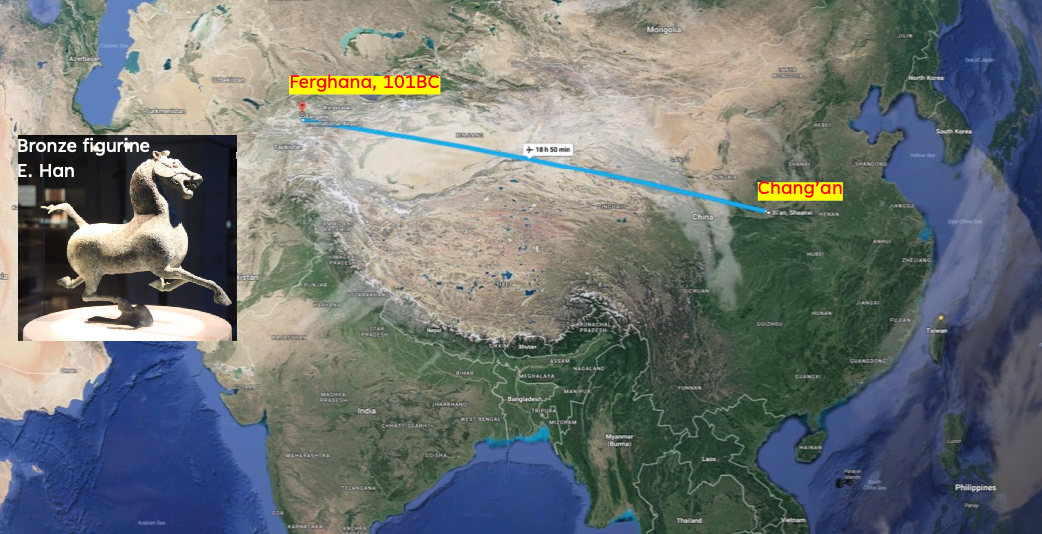
and this campaigm secured trade routes later to central asia
-
other campaigns aimed to make more tribute states hence allies to fight against Xiongnu
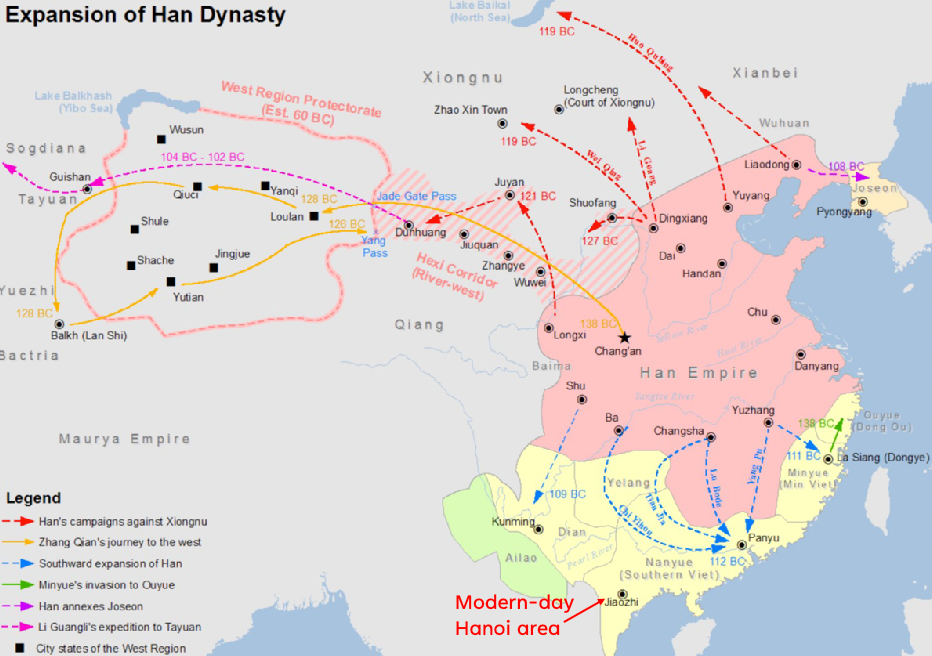
some famours campaign leaders:
- Huo Qubing: defeated 5 Xiongnu tribes in 6 days, killed over 70000 Xiongnu. (but we didn’t find Xiongnu’s records to confirm this)
- Zhang Qian: his route established later silk road, and later where buddism came in
-
Consequences of Wudi’s expansions
- Positive:
- military security
- established contact with the larger world - later on the silk road
- ambassators of many tribute states $\to$ send princesses to China and returns with periodic gift to vassal states
- Problem:
- nearly 10% of state revenue spent on gifts
- Stretched China’s resources; economic well-being weakened
- Positive:
Han Confucianism as State Orthodoxy
-
Dong Zhongshu developed Confucious that matched the mood of the time
- synthesizes different ideas to Confucian metaphysics, e.g. adapted yin-yang and the five forces (fire, water, earth, metal, and wood) into Confucian metaphysics. Note that Confucious origianlly did not address supernatural
- harmonize the contrasting idea of Mencius and Xunzi, so human’s nature is good but man needs to be guided by the ruler (personification of heaven)
- remade emperor-cnetered, hence Wudi liked it
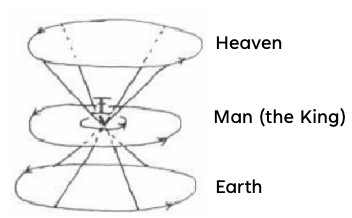
- essentially, Confucianism became more eclectic and emperor-centered
-
he then made the proposal to Wudi, who liked his idea and adopted it
- even though Wudi’s established rule is in a way very similar to Qin’s legalist principle on military and laws,
- ruled by legalist, but decorated/surfaced by Confucianism idea
- so practically, every state claimed that they follow confucianism even though rules by legalist ideality (due to Qin)
-
another important change include that the government officials needed Confucianism classics as required knowledge
- invenstion of paper in Easter Han helped expanded Confucianism
- but the overall Confucianism has diverged some significant ways
Emperor Lv吕后 and Ban 班Family

- first woman ruler (dowager) in imperial china, wife of Liu Bang
- power of empresses family threatened the power of emperor family, hence seen as dangerous
- so historians such as Sima Qian cover her achievments up
- Another first woman historican: Ban Zhao
- completed the history of Western Han
- wrote book on Lessons for Women, which is very popular
- emphasized women obligations to husband, cultivation of virtues appropriate to women.
- women and men have different status, hence can be seen as Confucious idea to stick to their role
- but also advocated for equal education for women
Sima Qian, the “historian”
-
our vision of ancient china is being shaped a lot from his view of it
-
at that time, historian were more known as Archivist, Astrologer, and/or Scribe
- duties may have included recording events, or keeping “minutes.”
- could access palace archives, such as chronologies, confidential documents.
-
Shiji started by his father, finished privately by him (hence less biased v.s. Ban’s version, which is state sponcered)
-
Shiji narrates history from beginning to time to Sima Qian’s time
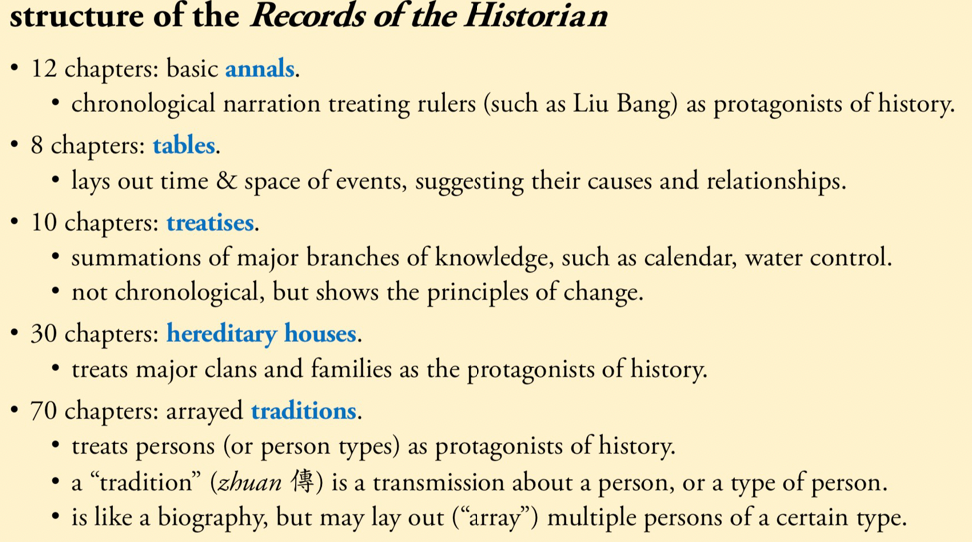
where all the history was unearthed by him, checking archives, going to places physically, etc.
-
however, there could still be biases:
- during ruling of Han Wudi, he had a castration due to political mistake, hence could have grudge to Han
- dislikes Emperess Lv
- student of Dong ZHongshu, had Confucious influences
but today seen as he tried his best to be impartial
Wang Mang Interloper:
- recall that Liu Bang, Empress Lv, and Empreor Wu are all classfied as early Han
- Wang Mang started a rebellion and separated out of the royal clan to start his Xin dynasty (which lasted very shortly) besides Han.
- however, due to the flooding of yellow river at the time and other reasons, Wang Mang’s plan is shortlived
- due to rebellion, Han people relocated to Luoyang, restored the power, had the Eastern Han
- Eastern Han formally began on 5 August AD 25, when Liu Xiu became Emperor Guangwu of Han, with capital moved eastward to Luoyang
- still the Liu clan being the royalty, but the eunuchs has rose up in power
End of Han
- The end of the Han dynasty refers to the period of Chinese history from 189 to 220 CE, which roughly coincides with the tumultuous reign of the Han dynasty’s last ruler, Emperor Xian.
- During this period, the country was thrown into turmoil by the Yellow Turban Rebellion (184–205). Meanwhile, the Han Empire’s institutions were destroyed by the warlord Dong Zhuo and fractured into regional regimes ruled by various warlords, some of whom were nobles and officials of the Han imperial court.
- One of those warlords, Cao Cao, was gradually reunifying the empire, ostensibly under Emperor Xian’s rule
Six Dynasties (220 - 589)
Previously on Han Dynasty

-
Liu Bang, or Han Gaozu, founded the Han dynasty
- Han Dynasty is split into two halves, distinguished by their capitals:
- 206BC - 9 CE: Western/Former Han (Chang’an). Then problem incurred by Wang Mang and forced the move of the royal family
- 25-220 CE: Eastern Han/Later Han (Luoyang)
- under the reign of Emperor Wu: we had great territorial expansion, but weakened the economy of empire. Several milestones include:
- Han-Xiongnu War: Han expansion creates a multilingual, multiethnic empire, enduring political and cultural ties to inner Asia; foundation of silk road and exchange of goods/ideas; but weaken the local economy due to warefare
- note that silk road in reality are a series of short trades, and that it is important to know that many tradings existed before silk road as well. It is just that Wudi made silk road even more trade intensive.
- Dong Zhongshu works to install Confucianism as official state ideology, but draws upon Daoist cosmology; this syncretic Confucianism legitimizes Han order
- Sima Qian, court astrologer to E. Wu, writes monumental Records of the Grand Historian in the Confucian mold, considered founder of Chinese historiography
- Salt & Iron monopoly debates (held 81BC) on Emperor Wu’s economic policies
- Han-Xiongnu War: Han expansion creates a multilingual, multiethnic empire, enduring political and cultural ties to inner Asia; foundation of silk road and exchange of goods/ideas; but weaken the local economy due to warefare
-
Han governance marks continuation of Qin law and institutions, legalist foundation with new syncretic Confucianist state ideology laid over it. => Called the “Han Synthesis,” but the Han is essentially a Legalist state.
-
also recall that in the song, this missing period is essentially the topic of this section: the Six Dynasties

Timeline After Han
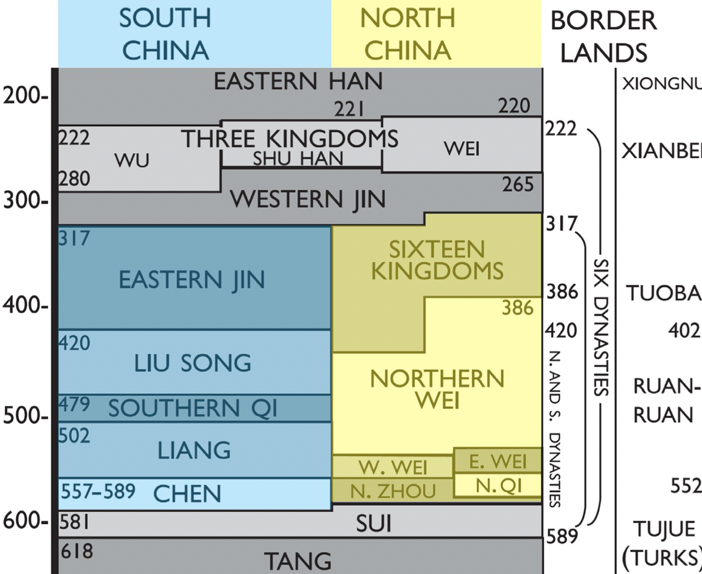
- first split into Wu吴国, Wei魏国, Shu蜀国, the three kingdom period
- then north have been controlled by alien rulers, e.g. Northern Wei. The southern are controlled by aristocrats migrated from north (e.g. to seek refuge)
- recall that south had high humidity = lots of malaria
- oldest form of spoken Chinese in the South, such as Fujian, because south had been “stale” while north was changing, e.g. interaction with steppe people.
- the name “Six dynasties” come from the six dynasty that had capitals in Nanjing (Eastern Wu, Eastern Jin, Song, Qi, Liang, Chen)
- it also overlapped the Sixteen Kingdoms period = warring in Northern China after fall of Western Jin
- the period of Northern Wei + Southern Song to before Sui is also called the Northern and Southern period 南北朝
- Sui dynasty reunified china
The Three Kingdoms
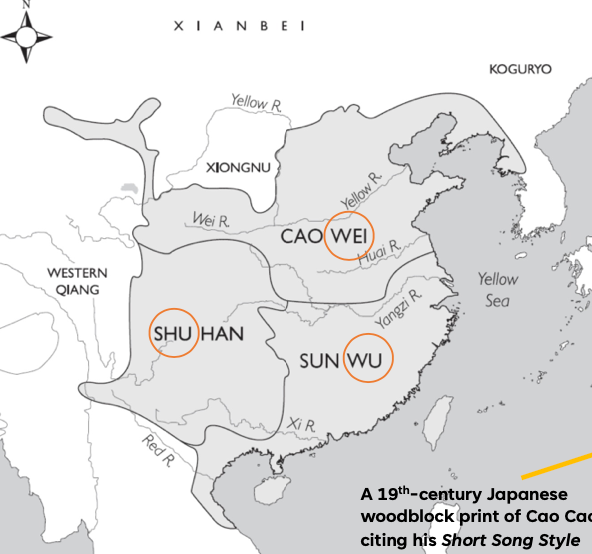
- the three rulers slowly rose to power at the end of Han, by being warlords
- by 205, Cao Cao had made themselves dictator of North China. Since there are so many Wei, we added the surname of the leader to give Cao Wei
- later on Cao Cao also defated Xiongnu, but never able to reunite the other empires, which ended with the Battle of the Red Cliff 赤壁之战
- defeated by alliance between Shu and Sun, and the tiredness of his troops due to long distance marching
- he didn’t die there, but just failed to reunite
- but eventually his Wei prevailed as it has twice the population, and won over the other state
- near the last of Wei’s heirs, Cao Shuang was executed and royal power weakened = rise and eclipsed by the Sima family.
- They eventually took over change the dynasty to Jin 晋
- first time a small reunion of China, but fell apart quickly by the War of Eight Princes (i.e. family member seeking power)
- subsequently, in 304, civil war within and northern invasion of the non-Chinese tribes collapsed
- Therefore, the north became the Sixteen Kingdoms period and the south is the Eastern Jin dynasty
Sixteen Kingdoms and Eastern Jin
-
Non-chinese joined the conflicts and made north a battle ground.
-
life in the north was dangerous hence many people, especially Jin, packed up and fled south = Eastern Jin
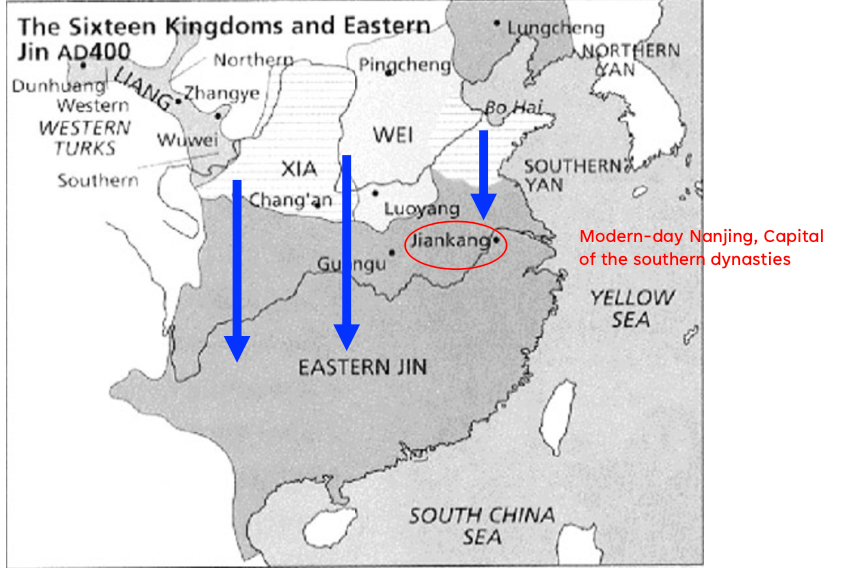
but since there are aboriginal people there:
- the local populartion either pushed away or absorbed
- essentially Eastern Jin is still under the Sima Family
-
one reason why Jin so shorted lived is because its choice of Government officials. The rise of aristocracy from Han through Tang
- Warring States: on the basis of merit (shi class)
- Qin: merit, as a firm principle
- Han: by recommendation (rule of avoidance, so officials there are non-local) + exams
- in reality, since officals are non-local, they basically asked people of importance at that local area for recommendation
- but later this became a problem, that it still became local recommendation by locals themselves
- Wei (under Cao Cao): and the whole era of disunity: the Nine-Grade system
- every family will be assigned a rank = position in government, hence hereditary in nature
- this rank assignment depends in virtue, reputation, talent
- long survival of elite status, and many of those clans persisted to the Tang dynasty
- to preserve this, aristocrat should only marry aristocrat
- Sui: exams
- realize that the exam is the fairest way
Elite Aesthetics:
-
in South China, the educated and the well-off competed in extravagence, instead of the virtue Confucious wanted
-
these people are interested in mythical things, divination and supernatural (“Seven Sages of the Bamboo Grove” below)
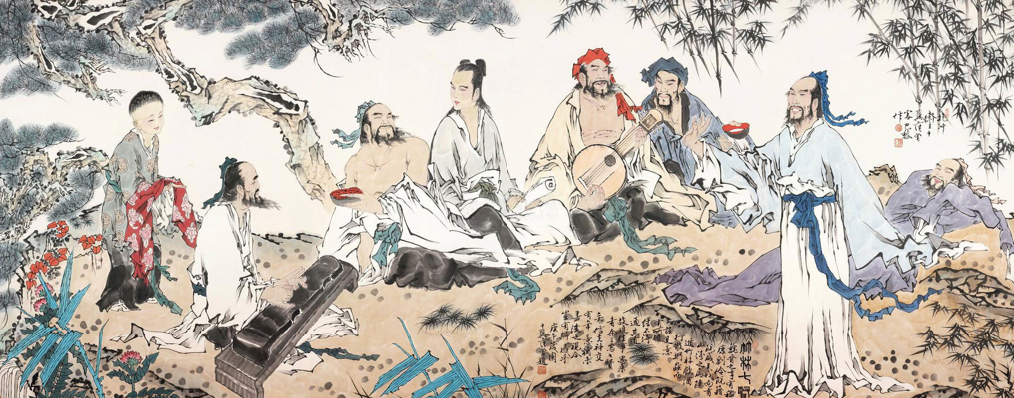
for example, they loved drinking, and some also took drug. Hence those elite people always try to be naked
- challenged public moral at the time, of what is virtuely right
- e.g. one was crying when an unmarried man died, but was eating and drinkg wine at his mother funeral = violated Confucious values
-
but also a burst of self-expression in art and poetry
Northwen Wei Dynasty
-
Tuoba, which included tribes who spoke turkish, mongolish, etc. They invaded and controlled he nothern China after the Western Jin
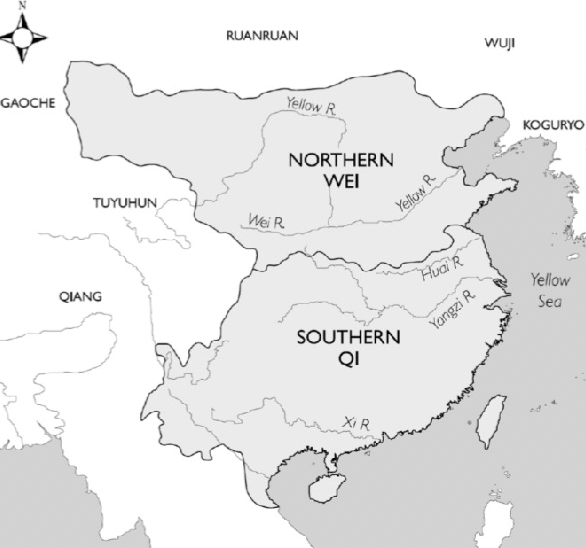
-
however, Tuoba interested in the process of Sinicization (to Sinify: to make Chinese. Latin “Sinai”=Qin=Chinese)
- how can a minority population of Tuoba ($\approx$ 1 million) contorl the vast population of Chinese $\approx$ 20 million?
- one approach is Sinicization, which is wierd but largely because Emperor Xiaowen himself is admiring Chinese since childhood
- proposed a new system of Equi-field, which is reminiscent of Han to tax individual cultivators
- individual family assigned land depending on how many people they have
- this is to ensure that no-land is neglected, and that no people wander off (e.g. don’t want merchant and nomads)
- hence is useful for building a fiscal base
- Emperor Xiaowen: new captial in Luoyang and wanted to transform Xianbei鲜卑 into Chinese
- used chinese surnames
- ordered Chinese clothings in court
- preferred Sinicized Chinese = elites of mixed ethnic backgrounds increasingly became the norm
- Luoyang became popular, many Xianbei nobilities became versed in Chinese
- The cultural and ethnic integration laid the foundation for later reunification of the North and South by the Sui
- however, this eventually lead to the problem that military who are mostly Xianbei are being treated unfairly compared to mixed court officials. This can be said to tbe the root cause of the throw off for Emperor Xiaowen
-
the Ballad of Mulan, when the Northern Wei (where Mulan is born) was in war with ruan-ruan
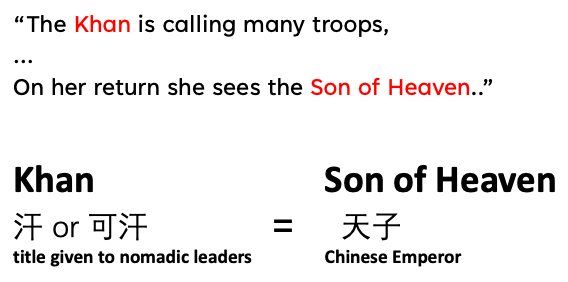
- in the Ode the concept of Khan is equivalented to the concept of Son of Heaven
- indicates the sinicization of north
-
Resistance of Sinicization,
- this acceptance of Chinese culture would lead of loss of identities, and Xianbei in military did not enjoy status that sincized Xianbei in the court had
- since those unequal treatment made militaries unhappy, and lead to rebellion in 524
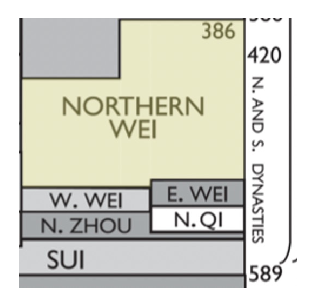
-
but later they all suffered from sinified Chinese, that a mix of culture differences induced alot of conflict
Buddhism:
-
provided a different way of conceving life, death, and cosmos
-
Buddhism originated in India, a lot went to China from the trade routes
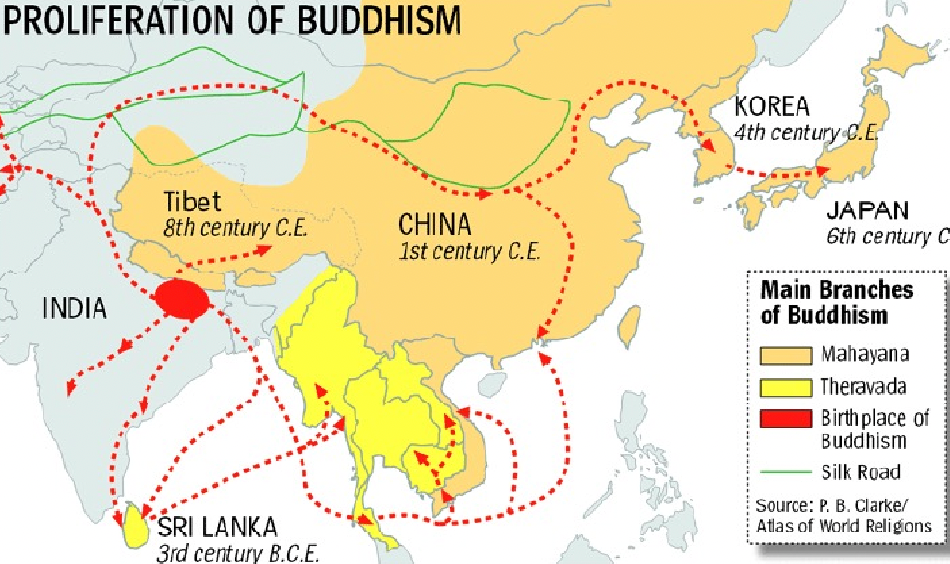
-
instead of a single creed, chinese Buddhism foundd a lot of ideas and practices
- met both Theravada (early buddihism, lesser vehicle) and Mahayana (later buddism, greater vehicle ‘that can carry more people to salvation’)
- problem of translation then was critical
-
since Buddhism is in sanskrit, early translators used Daosim concepts to explain Buddhism
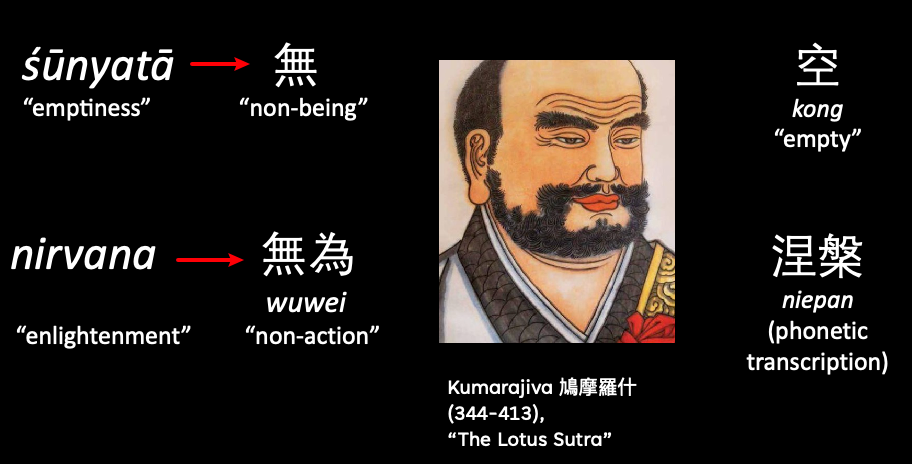
- in the beginning, had lots of problems such as Nirvana $\to$ Wuwei
- then with Kumarajiva and his translation project coining new terms in Chinese (e.g. Niepan, to preserve the foreign phoenic), it became much more accurate
-
how did Buddhism change Chinese culture at large?
- the idea of rebith, and people cycling through life is new to the Chinese
- added the idea of death is also suffering, hence Nirvana is important
- reshaped the relationship between the living and the ancestors
- ancestors become “weak” beings needing to be saved (v.s. before, ancestors are made offerings and then gave help in return)
- how do you save them? Death can be lifted by merit, and merit can be transferred, e.g. by Buddhist clergy
- remade the relationship between living and dead. Idea of ancestor are powerful has diminished
- From the above, induced the rise of the importance of Buddhist clergy
-
how did China change Buddhism?
-
Mahayna buddhism became the famous one, China magnifies Mahayana. e.g. extending the influence to Japan as well
- e.g. Chan, or Zen in Japanese, all purely Chinese inventions
-
developed specific Buddhist schools, all Mayhayana sects
- Pure Land: preach by faith, hence very easy to pratice. Only need to recite the name of Amitabha. Hence welcomed by commoners
- Zen buddism: needs meditation, more attractive to literate elite
-
an example of locaization of Buddhism deity, Guan Yin of mercy and compassion.
Original In China 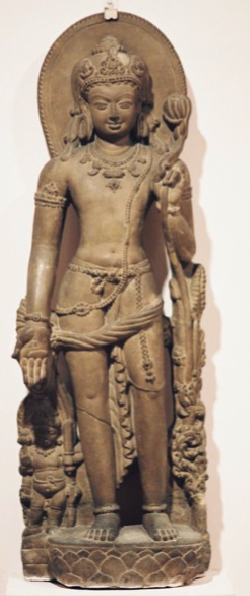
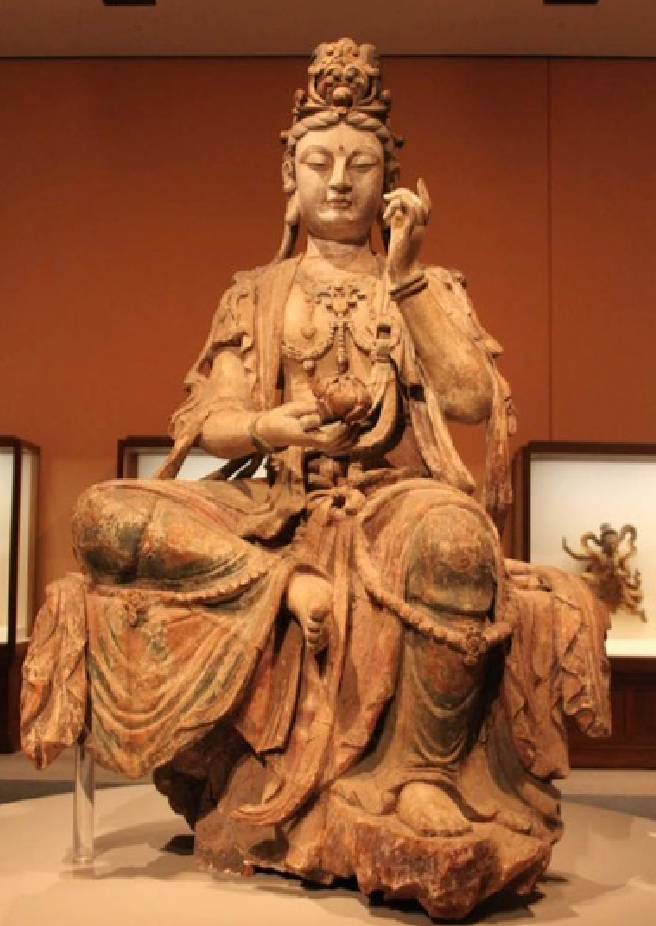
- initially Guan Yin is a male in India, but in China, became female
- promoted the idea of equal gender: “presentation of gender is provisional, situational, audience-oriented”
-
Rise of Daoism:
- Though Han dynasty with popular with Confucious, there are still believers of Daoism and the notion of immortality (e.g. Lady Dai)
- during the Religious Daoism, those sporadic believers (e.g. farmers) suffered from taxations and wars. They wish for peaceful lives (near the end of Han), hence grouped up and formed a more powerful sect and started to gain governence in their own regions = the Yellow Turban, etc.
Religious Daoism
-
gained insights from Cihinese superstitions, and is for pursuing immortality (e.g. Qin and Emperor Wudi)
-
but in 2nd century, there ermges religous Daoism: organized commual religous due to conflicts/dissent near end of Han (notice that something new happens near the end of a dynasty is pretty common by now)
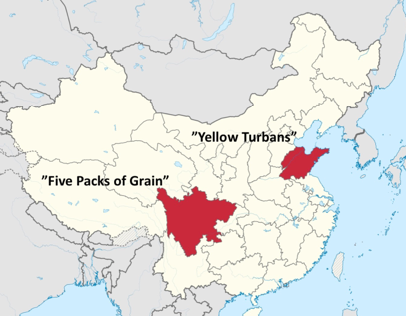
- Laozi is now made into a deity
- had two sects, by Zhang Daoling (五斗米道), and by Zhang Jiao (Yellow Turbans)
- those leaders claim they obtained new revelations and gained a lot believers
-
eventually the growth of Daosim and the incoming Buddhistm lead to strong competition
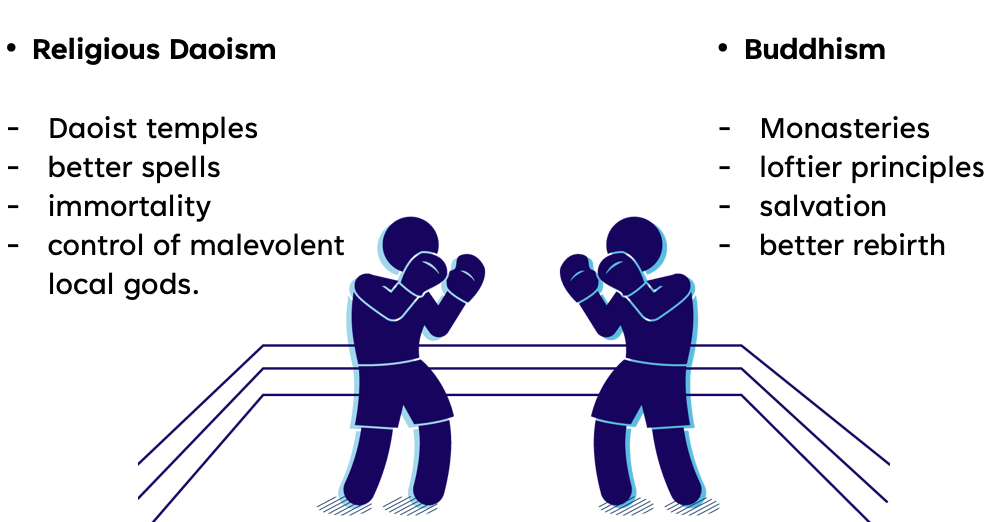
- Daoist built temples v.s. Buddhist monasteris
- Daoist claim that they have better spells, soceries for protection and ailness, etc.
-
There have been much efforts of one religion try to use the emperor to expel religion: but never had a single religion to dominate
- many western misconception therefore though Chinese religion had high tolerance, e.g. the exclusiveness of Islam and Christian
- but that is not true, the reality is that are also trying to exclude but just never works out
Sui and Tang (581–907)
Previously on the Age of Division
- Eastern Han: falls from socioeconomic and environmental strain, and religious (e.g. Yellow Turf), peasant movements. Fractures into short-lived, celebrated Three Kingdoms period.
- North-South division remains significant;
- South underdeveloped, only has 1/6 of N.’s population;
- North: had mostly proto-Mongol or Turkic nomadic people including 1. Xiongnu, 2. Xianbei, 3. Tuoba establish series of “kingdoms” which are usually brief; Northern kingdoms see a degree of Sinicization, but reverse also occurs; ethnicity and culture are fluid
- Differences in geography, climate, trade routes; the rise of aristocracy
- One of the legacies of the Northern Wei (Tuoba branch of Xianbei) is patronage of Buddhism, which was translated ‘through’ Daoism, (i.e. wuwei and nirvana)
- Sui had a series of measures trying to unite and resolve the difference:
- a law code equally applied to all
- the Grand Canal, which linked the Huang He and the Ch’ang Rivers and encouraged north-south trade within China
- Buddhism transforms culture; Chinese culture transforms Buddhism
- Religious Daoism: in competion with Buddhism, wanted to get exclusive patronage by the emperors but never work out
Reunification of Sui
-
some key milestones of Sui and later

- Reunification under the Sui (581-618) Yang Jian 杨坚
- Yang Guang杨广, the first emperor’s son when successed build the Grand Canal (try to keep China together) but also had extravagant rebuilding of capital at Luotang (critisized)
- Yang Guang’s campaign to Korea later was failed, and rebelliions broke out in China = emperor killed = Li Yuan founded Tang
- Early Tang: mainly Emperor Taizong (Li Shimin) & empire-building+conquering – Tang Cosmopolitanism: Chang’an and material culture
- Empress Wu (Zetian), who reigned for a long time, and the role of women
- An Lushan Rebellion forced center to cede much power
-
rescined the ban on Buddhism and Daoism passed by the previous Northern Zhou dynasty in 574
-
monks were already working on Buddhist text protection in Zhou: digging caves and putting Buddhist texts incised in stone
-
but Sui founder was himself a grand donor to Buddhism, built a lot of monasteries
-
-
mixed nordic and Chinese, a reunification of Chinese northern and southern states
- north and southern could have became a permanent separation
- new centralized bureucracy even stronger than in Han, and enforced it in a short periof of time (like Qin)
-
later in Tang, the division seemed a much undesired situation
- as shown by Tang, unification = longer dynasty e.g. Han and Tang became an aim of every later ruler
-
since again, Sui are doing a lot but too soon (alike Qin)
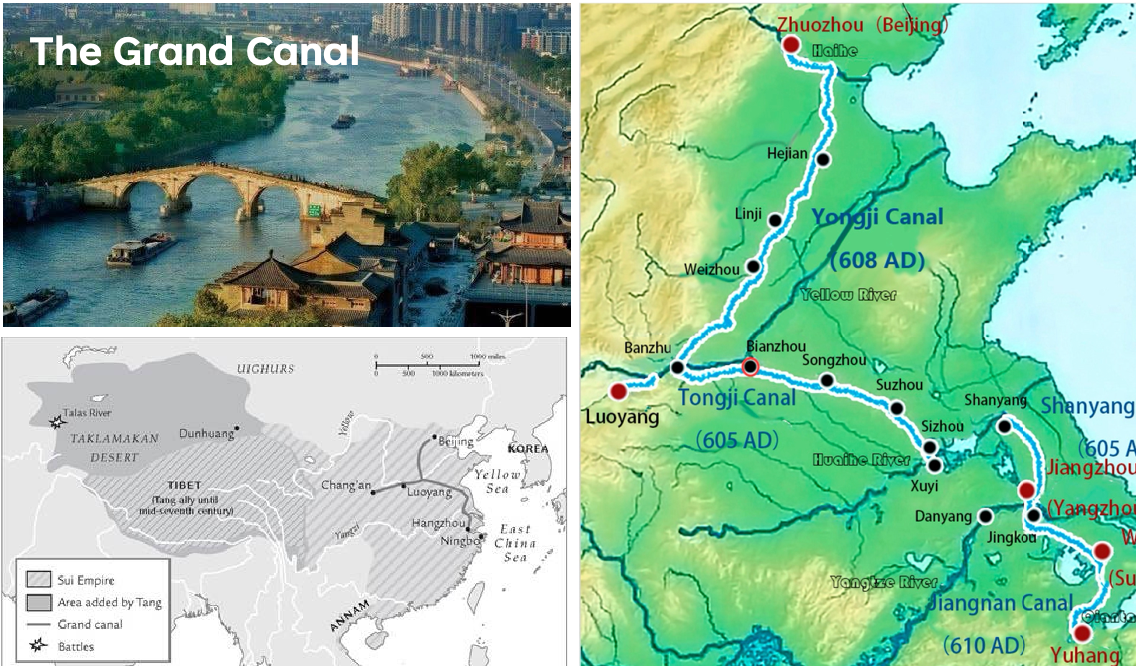
where
- dig a canal to connect north and south, and to ship south resources to north
- faciliated and symbolizes the political reunification of south and north
-
new system by exam in Sui = intended to deprive high aristocracy of power
- opened to a somewhat larger population to serve in government
- but many successful candidates still correlates to power of rich families
-
second emperor wanted to rebuild the great wall, and build a road (much different from the first emperor of Sui, and very alike Qin)
- he also conmissioned lots of army to vietnam, turko-mongol in the north, and korea
- he did too much, distrupt dometic ecnomony, and with the failure of Korea, and became overthrown
Tang Founders: cosmopolitanism about elite culture
- with the disintegration of the Sui dynasty in July 617, Li Yuan – urged on by his second son Li Shimin (李世民, the eventual Emperor Taizong) – rose in rebellion.
- Using the title of “Great Chancellor” (大丞相), Li Yuan installed a puppet child emperor, Yang You, but eventually removed him altogether and established the Tang Dynasty in 618 as Emperor.
- His son and successor Li Shimin honoured him as Gaozu ("high founder")高祖 after his death.
- and later Li Shiming become Tang Taizong, achieved by killing his brother and forced his father to step down
- unethical as it violated Confucian norms, and hence a “legend” arose that emperor was summoned before the King of the dead
- the king of the dead asked why did you do it
- the emperor was terrified, and in the end sacrificied his family for the good of the empire
- shows the belief in afterlife and juristication of the courts of the dead, which is a norm of justice at that time
- ruling in the north become multi-ethnic
- lots of Tuoba intermariage, different families made different choices
- already in Sui: e.g. wife of the founder of Sui was Turkish, and the crazed son of Emperor Taizong (because his father killed his homosexual lover with a palane entertainer) insist on only speaking Turkish. Eventually his wife Wu Zhao took over and became Empress Wu
- in general, very mixed identity in the north
- Tang followed a lot of Sui policies
- both had a modified form of the equal-field system, which originated from Northern Wei by Dowager Empress Feng
- both retrained militia system of nothern dynasties (very ingrained into the population)
- Tang’s founder is the Li family
- also mixed ethnic background, spoke both Turkish and Chinese
- hence with a heavy Tuoba element and steppe culture, e.g. liked horse riding and hunting
- steppe nomads learned to ride from a young age and were expert horsemen
- after An Lushan rebellion, people wanted to draw a more clear ethnic lines
- The tang was an age not just for cultural openenss but of political strength, and had much control over its citizens
- official supervised markets carefully (e.g. periodically monitored prices), and also kept a close watch on rural residents
Tang’s military culture: part of the elite identity
-
e.g. from Han, Wudi was a emperor of strong military
-
in case of Tang, it is different from Han because
-
it is a militarized society, mixed of military and civilist cultures
-
the militia system 服兵 made almost every person had some kind of military knowledge
- Sui and Tang developed this system, which a way to privde a national army from a local level
- based off from equal-field system, so that given land = tax and to supply one soldier, but that soldier is exempt from taxes
-
soldiers are serving by rotations (hence no permanent soldier = less concentrated regional power)

- when off duty = training
- when on duty = go to war if there are wars, otherwise patrols in captials, etc.
- don’t receive salaries, and so need to prepare their own equipmenet, horse, etc, but will have rewards from won battles
- e.g. recall Mulan, who had to buy her own horse
- won battles for rewards in land, cash, ranks, hence can be a way some family desires
-
using the above system, the cost of launching wars is minimized. Hence lead to a high degree of military knowledge penetrating throughout the population
-
-
using this militia system, Tang got a lot of expansion success
-
in 630, conquered Mongols in Mongolian. This victory gave Taizong a title “Heavenly Khan”天可汗
-
also campaigned western states
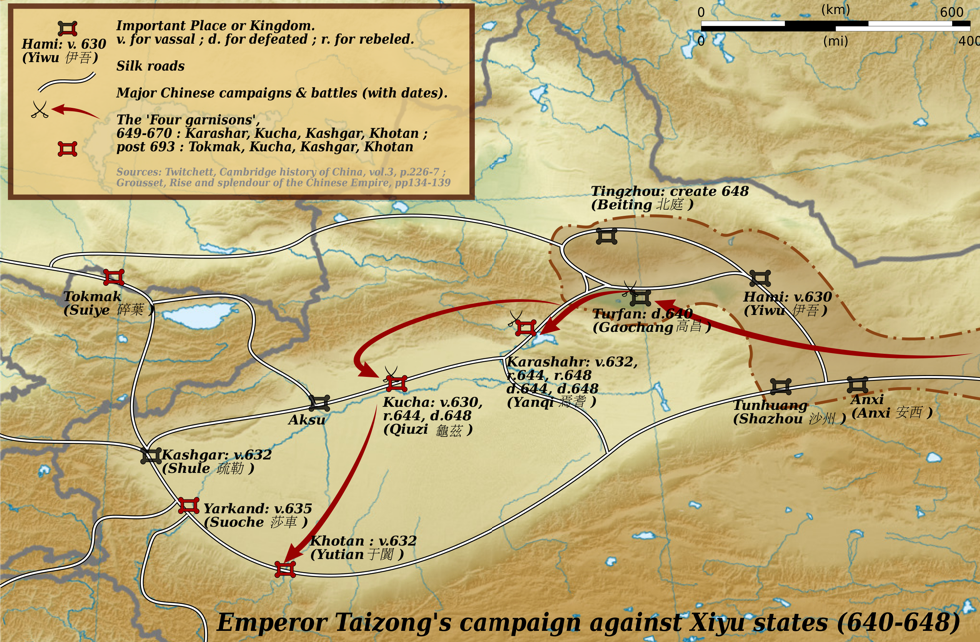
which become mordern day Xinjiang
-
but since a large part of Turkish soldier who were sent from tang’s army settled there, hence they people in Xinjiang speak turkish a lot
-
Established Six Protectorates
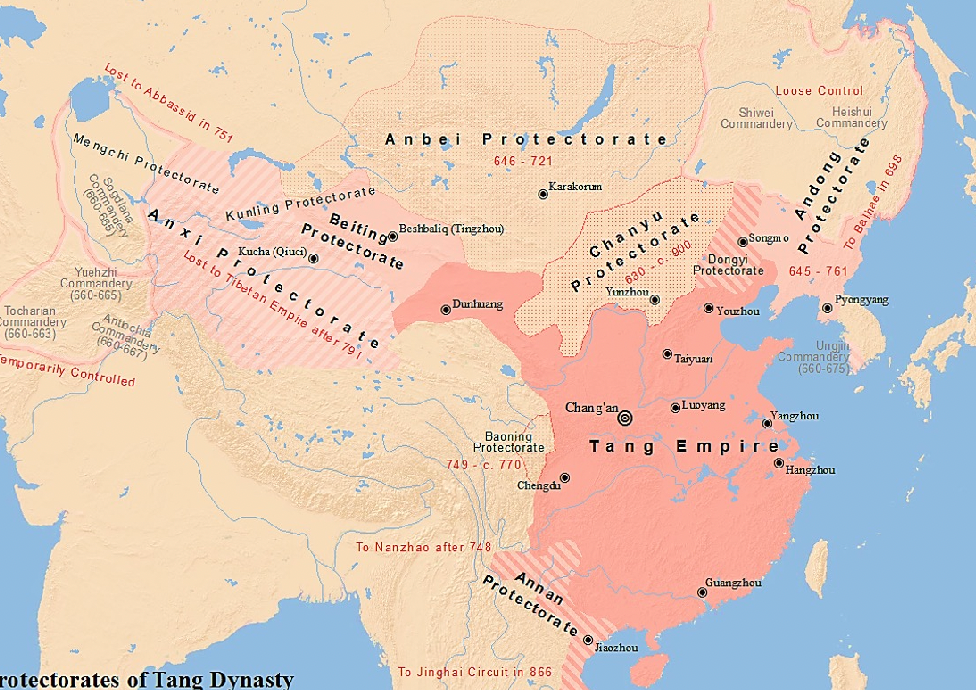
- a protectorates has a local ruler and autonomy
- the protectorate submits to the Tang emperor as the highest sovereign.
- a Tang was to pacified te region
- the protectorates also paied tributes ot the Tang, in return, emperor gave them licenses for trade = trade relationship
State-building at home
- Tang Code of 653 was the earliest code to survive directly, read and copied (before other code was dug up + bamboo)
- principles of crimilal laws, etc.
- many other countries (e.g. Japanase, Korea) adopted a lot of Tang code not for its content, but for the symbol of prosper
- but punishment depends on social status: priviledged, commoners, and inferior people (e.g. slaves)
- the code was also calibrated based on sex, age, and disabilities
- reflected Legalist on appropriate treatment, but also espoused Confucianism values (e.g. killing own father much worse than killing a stranger)
- promoted Confusion education, and expanded the civil exam
- but still Tang’s offcials is only at the early state of change, most still come from wealthy family
- only 20-30 men passes the exam per year, hence bureaucracy still mostly domoinated by aristocrates
- the change is most intensified during Song
- at the start of the Song, those great families started to fade away, perhaps rebellion targeted at aristocracy at the end of Tang = genocide.
Tang’s openness: Changan长安 = eternal peace
- recall that Chengzhou成周=Luoyang, Changan长安= Xi’an
- Chang’an was rebuilt by Sui as a political statement, and was rebuilt by the Tang for the same reason = symbol of power
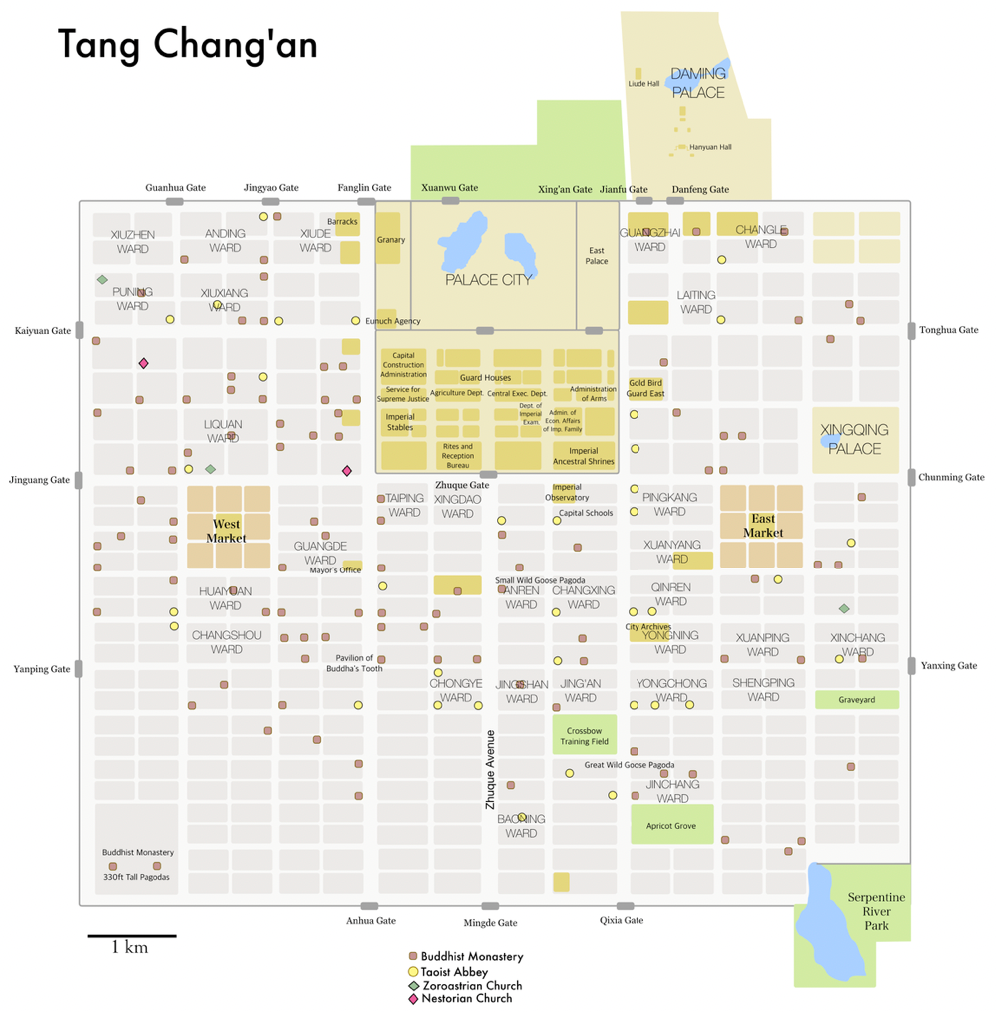
-
the city layout is highly planned, had 1 million living inside and approx another million just outside.
-
a lot of walls for security purposes (had curfews, patrols, etc.)
-
today none of the Tang outer walls remain, but only the Ming wall survived, which is approximate only around the palace city area
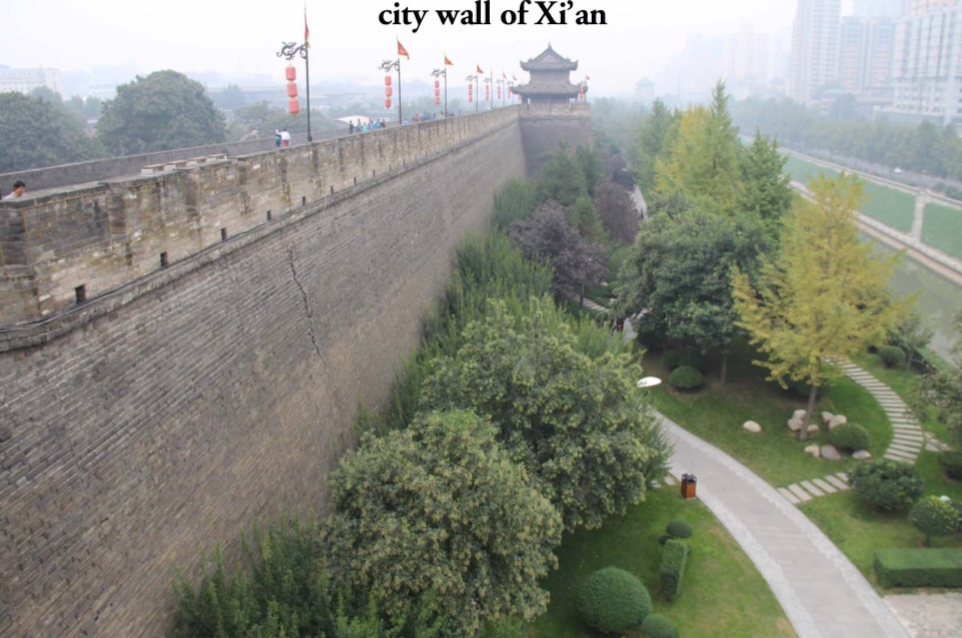
-
emperor palace in the north, and people lived in the rectangular units = a unit. Rich people lives closer ot the palace, and there are also two notable markets, where
- west markets are for foreign trades = most foreign merchant come form west
- east markets are for trading local goods
-
the southern gate also had a very wide avenue: wide enough for much traffic (gone today. but below is reconstruction)
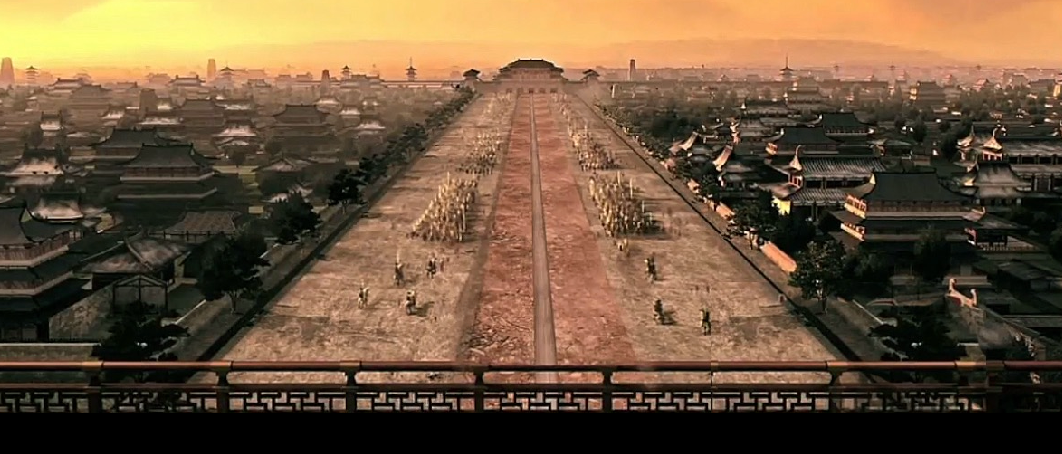
-
Emperor Taizong is very interested by Xuanzang玄奘, a Buddhist in search of Buddhist scripture and came back
- He is known for the epoch-making contributions to Chinese Buddhism, the travelogue of his journey to India in 629–645 CE, his efforts to bring over 657 Indian texts to China, and his translations of some of these texts
- inspired the modern novel: The journey to the West (西天取经), to depict Xuanzang’s journey in search of the Buddhist script
-
knowledge of outside world largely influenced by those exotic goods, central asian musicians, magician, etc.
- attest the love of Tang elite for cosmopolitan cultures and especially those of the central asia
- but they had a hard time diferentiate those foreign people, so called them “Hu”
Who are the Hu 胡?
-
general term for foreigners from the north or west. The origin might be related to homophone “beard.”
-
North influences: steppe peoples, Xiongnu, Xianbei, Mongols.
-
West influences: Sogdians, Parthians, Persians, Turkic.
- Sodigans was an ancient Iranian civilization between the Amu Darya and the Syr Darya, and in present-day Uzbekistan, Turkmenistan, Tajikistan, Kazakhstan, and Kyrgyzstan.
- sodigans were quite useful - important middle-men of Tang and Byzantine empires.
- Sodigans are also promininet among military (e.g. soldiers) and merchants in Tang
- hence have a lot of Sogdian figurines: stablemen, soldiers, musicians.

-
those Sogdian people also brought a major changes to Chinese music (and dance)
|
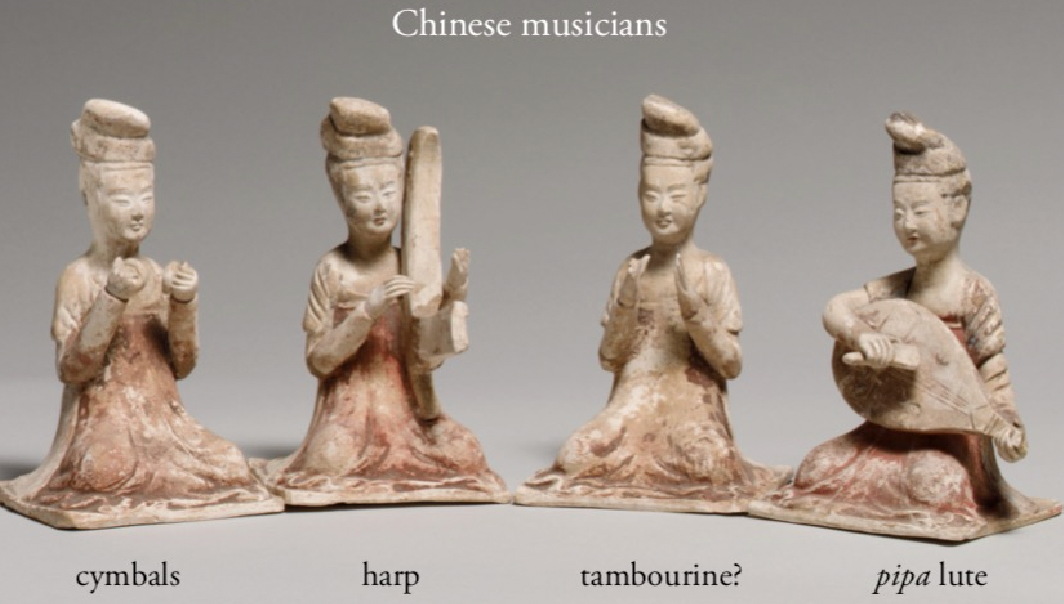 |
| 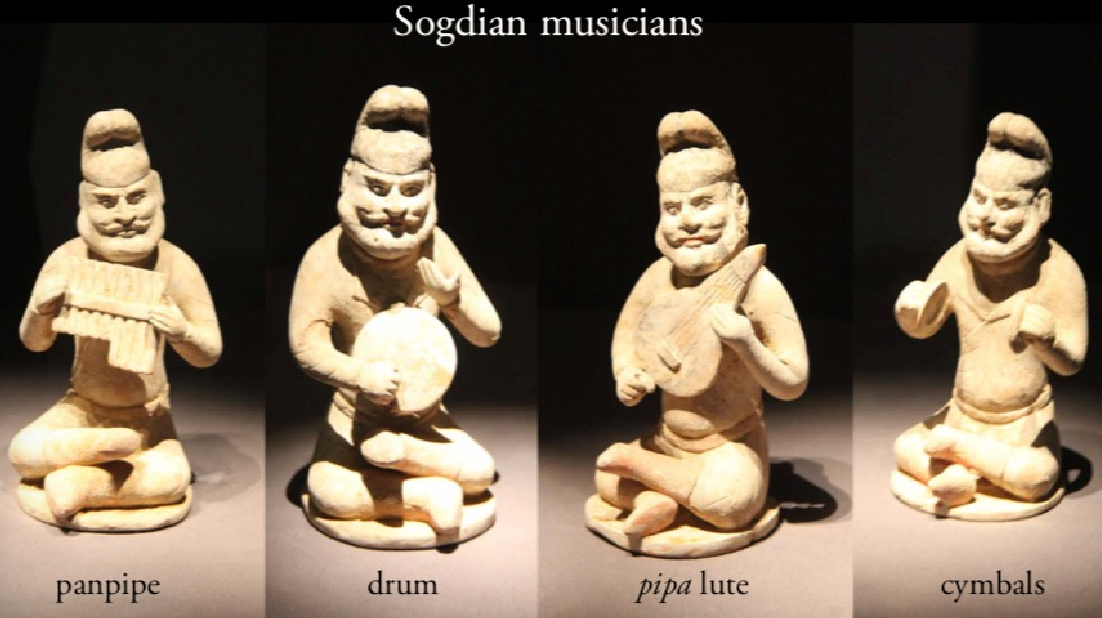 |
| :———————————————————-: | :———————————————————-: |
|
| :———————————————————-: | :———————————————————-: |- pipa was from western asia, but now is a major musical instrument in China
-
before Tang, all chinese sit on the ground with the formal sitting position, but then in Tang people begins to sit in the chair (slowly shifts away to a new pose)
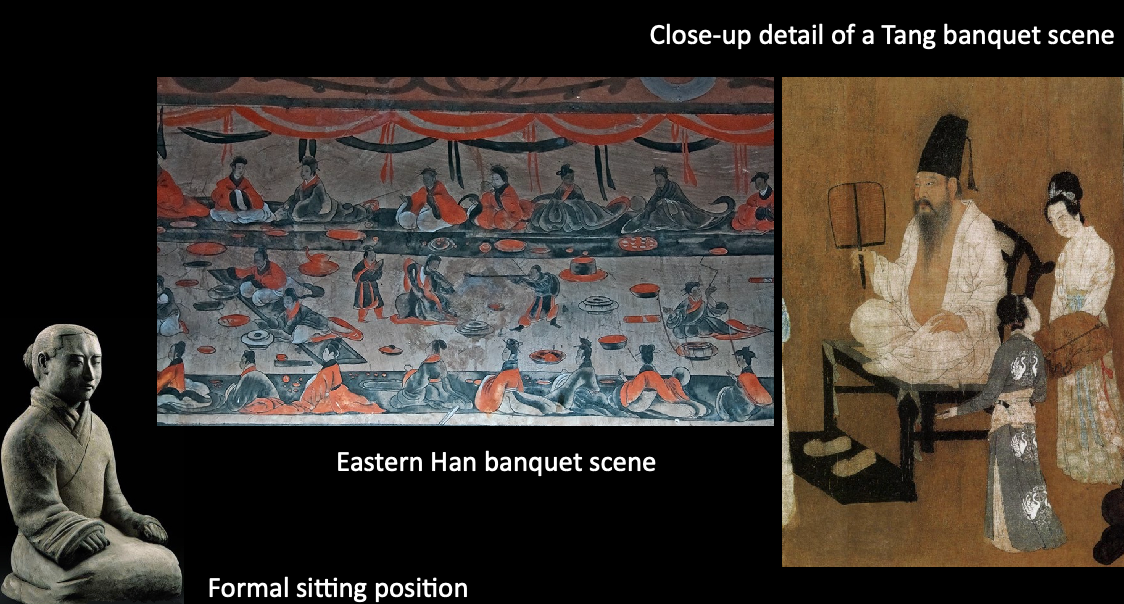
Tang Trade
-
some people say it is buddhist monks brought chairs in for trade
-
Samarkand-based Sogdiana and Ferghana supplied fine horses
-
many exotic foods
- from Central Asia: peas, spinach, garlic.
- from Persia: sesame, pistachios.
- from India: black pepper, cane sugar (native sweetener: malt sugar & honey) • from Mediterranean: coriander.
- grape wine available in Chang’an.
- lychee delivered daily from warm southlands for Consort Yang.
-
Tea became a national drink and a major trade item.
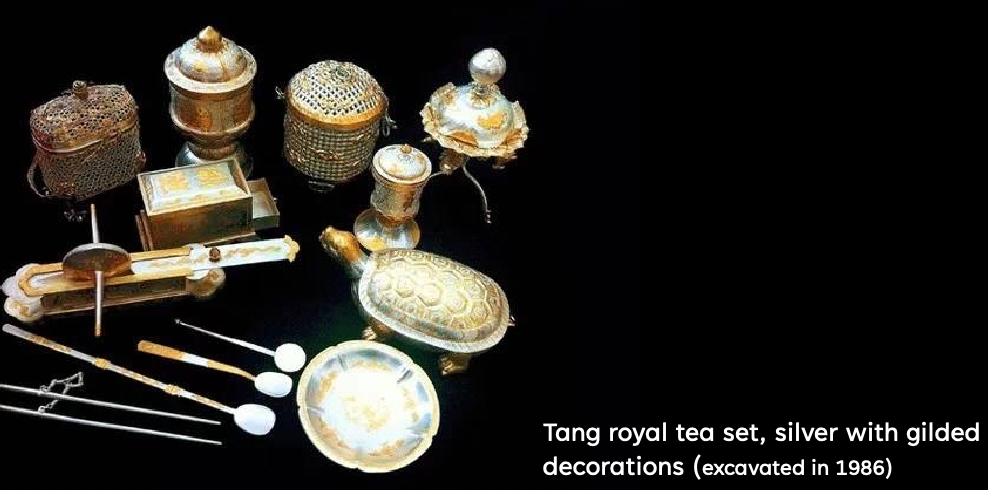
- throught the history people had their own “culture” during their time. In Tang, a specialized tea set above
- added ingredients such as salt, citric peel, etc.
Life of Commoners and Merchants
- merchants much well off than commoners, who need to to menial jobs such as maintaingin gardens
- with the “Tale of Li Wa”, which talked about a high officials family background young man came for examination $\to$ attracted to Li Wa, a prostitute $\to$ used up all his money and was abandoned $\to$ became a begger, almost died, saved by employees at funeral shop $\to$ became a famous professional mourner $\to$ father found out and beated him almost to death (assuming the status of polluted, inferior person) $\to$ saved by Li Wa $\to$ studied hard and became a official
- shows that flux of social class is not that encouraged
Examinations in Tang
- exams are used to recruit men of good character
- therefore, taking examinations = regularly visiting examiners and giving them samples of your writing
- but the good writings = poetry = only those brought up in a good family could be expected to know
- importance of poetry also lead to explosion in poetry writing
- but it ended still with majority of the court composing people from families of high social status
Religion in Tang
-
Buddhist and Daosit are the major players, and Confucian central to states, but more patronized Daoism
- Confucianism thought more like “framework”/structure for organizing the governments, e.g. train candidates in Confucian classics.
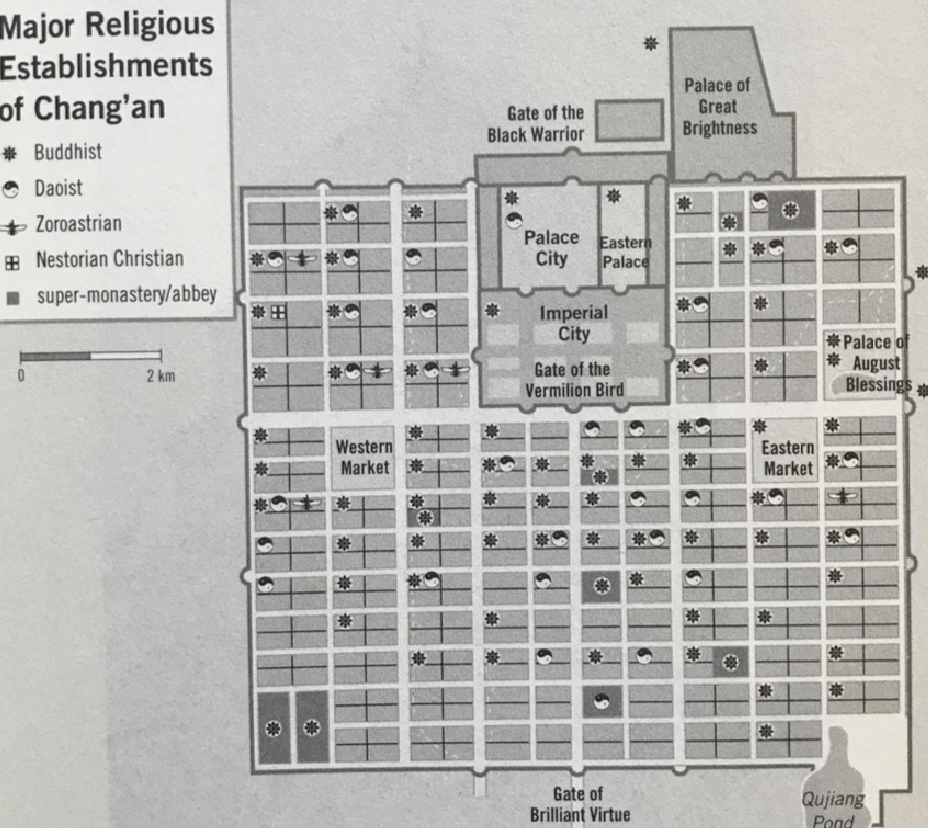
- more support for Daoism, because imperial famly claimed their origin can be traced back to Laozi
- influnce of Buddism is still everywhere, a lot of monarsteries
Tang “soft power” and Japan
-
properous of China attracted much foreign countries who also seek to build an empire (e.g. many Korean and Japanese in Chang’an)
-
Japanese connection also became much deeper
- Japan rulers were also tring to establish empire, since Tang had been so powerful
- based their policy on Japanese pepole who travelled to China study stuff and taking back to Japan with them, and relied on a lot of Buddhists
- the capital of Nara built in 618, and then Kyoto built in 794 are smaller versions of Chang’an: square in shape, geometrically aligned on a north-south axis; grid structure.
- Kimono is from China, and lots of Tang scriptures are importanted to Japanese (who has spoken laguage but not written)
Dynasty Names Adopted as Ethnic Term for Chinese
- Han mainly used in mainland China
- in 20th century mainland, China’s national ethnicity is constructed and called “Han”
- national language also called “Han language”
- Tang, more popular used for the Western, e.g. Tangren Jie=China Town
- because first migration was Cantonese speaking diaspora (control of them was solidified during Tang)
- Tang also had a much broader contact with the rest of the world
Empress Wu: only woman emperor in China
- previous empres are mostly regent, dowager
- personal name Wu Zetian
- regent, 660-690; as the Emperor of Zhou, 690-705
- ruled very capably, but there exists evidence her approach are sometimes ruthless
- her real look must be beutiful (praised by emperor), was borned into a wealth family
- encouraged to read and write in family
- married to emperor family
- interesting story of how she came to power, e.g. was concubine of Taizong, but when Taizong died, bore the first child of Gaozong (from whom she took power from), which indicates incest
-
She successfully succeeded the throne largely because lots of officials also supported her, and justified by using Buddism
- a monk wrote a commentary that told of a female goddess (hint at Empress Wu) who would be reborn as a princess in a small kingdom, etc.
- later Xuanzong made China the most properperous time, but was built by Empress Wu
- but still since Empress = upset a balance of nature, hence some scholars are still concerned
- Confucious idea that natural diasters = emperor problem (Dong Zhongshu, a ruler who did not fullfill = nature diaster)
- earth quake happened, and ministers took it as a problem
- hence, some portray her as a ruthless ruler (e.g. because scribes are mane)
-
avent sponsor of Buddhistm, but to user religion in her favor (e.g. justify her throne)
-
in general Tang people had freeodm and under her, women (tried) to have better freedom
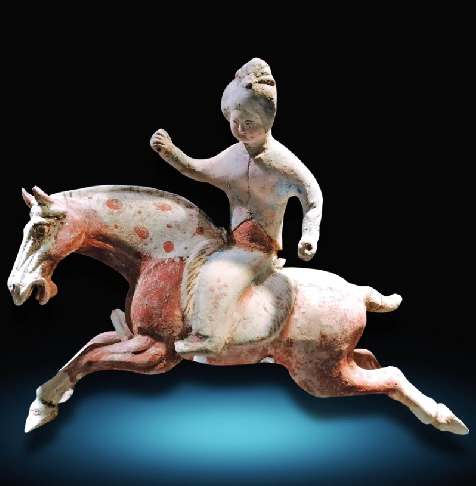
- e.g. shifts in beauty standards: women on horse also appealing.
-
The importance to history of Wu Zetian’s period of political and military leadership includes the major expansion of the Chinese empire, extending it far beyond its previous territorial limits, deep into Central Asia, and engaging in a series of wars on the Korean Peninsula, first allying with Silla against Goguryeo, and then against Silla over the occupation of former Goguryeo territory.
-
other notable changes in value include:
- as wife
- main wife but not cocubine
- men have shorter lifespans than women, so the wife often becomes the only head of the household.
- as mother
- should continue have influence even when sons become adults
- cocubine is lower in status, hence concubine’s son should regard main wife as mother
- as clan advodate:
- encouraged women’s position in government, but still install family males to most positions especially to military
- this is anyway too big of a change for a complete equality of gender here
- as wife
Interesting Note from primary sources:
- Emperor Taizong’s advice on effective government: land is large, need cooperation = give relatives land. Zhou is a successful model lasted several centuries
- Qin had zero relatives to rely on (Li Si’s plan) hence failed
- Han enfeoffed the land too generously: the Six Kingds harbored ambitions of overthrowing throne
- so the best way is to enfeoff many relatives to even up their power and to have them regulate one another and share responsibilities
- and for government officials: 适才所用
- military cannot be eliminated nor used all the time
- emphasis of literary arts and military arts
The Decline of Tang
Previously on Sui and Tang
-
Sui-Tang continuity: Tang was a successor to the Sui and Northern Dynasties
-
Three features of Tang culture (mostly elite)
-
cosmopolitanism: ethnic diversity, Tang ruling family (Li) as a classic example
-
importance of military pursuits and military cultures to elite identity; a more militarized society than later period
-
aristocracy remained dominant in government (the system of examination is only fully utilized for social flux at Song Dynasty)
-
- Tang Empire (618-907) marks culmination of the turn toward Central Asia that began in the Han Dynasty, and continued through age of disunity. Tang military institutions, urban culture, silk road trade and religious life look westward
- however, in Late Tang due to much political disunity they withdrawn their troops and lost most of the control in Central Asia
- Emperor Wu Zetian is the only woman to rule under her own name; powerful and competent (some ruthless approaches), expanded empire, but disparaged by later generations because she is a woman

Emperor Xuanzong: the peak of the Tang
-
Emperor Xuanzong: early half of his reign: astute ruler, the empire expanded to the high point; patronage of the arts (especially poets)
- Empress Wu had his daughter tried to poison her, trying to become the next empress. So there were some instability, but Emperor Xuanzong made it
- recall that Empress Wu had a lot of her family relatives in government posts, and sponsored a lot of Buddhism, e.g. claimed that she is the incarnation of Bodhisattva. Emperor Xuanzong tried to redress/reform those
- he also reformed Equal-Field system due tax problems encountered during their time
- there were also threats from the Turks, Tibetans, so he restructured military system and give commanders great authority (among them he particularly gave An Lushan much power)
-
change of women’s clothing, don’t reveal shoulders or backs
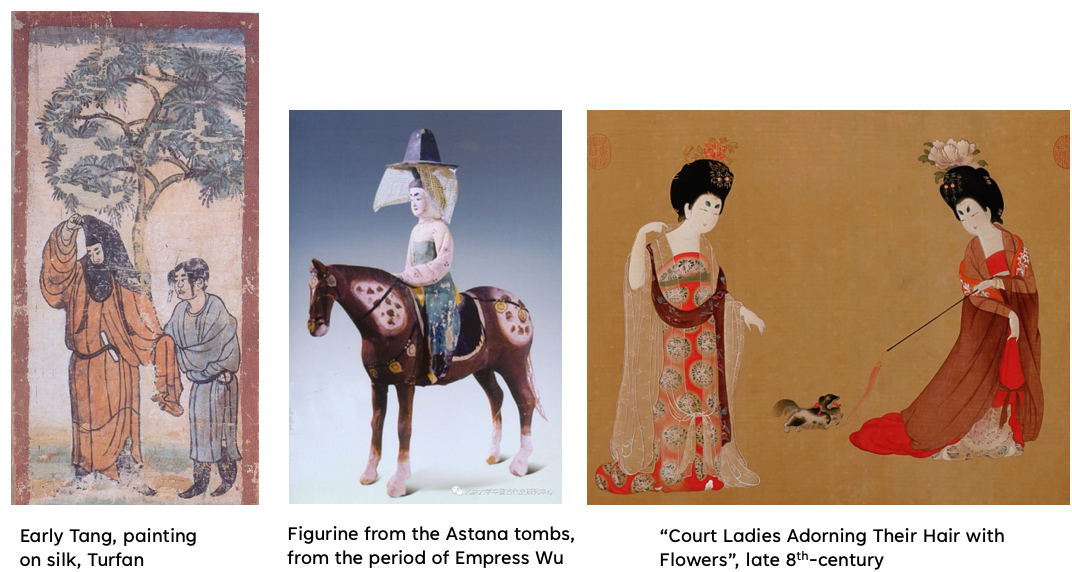
yet this type of dress (rightest) is not for commoners, and it is more popular for them to wear men’s clothing = meaning more physical mobility. An example below are all women:
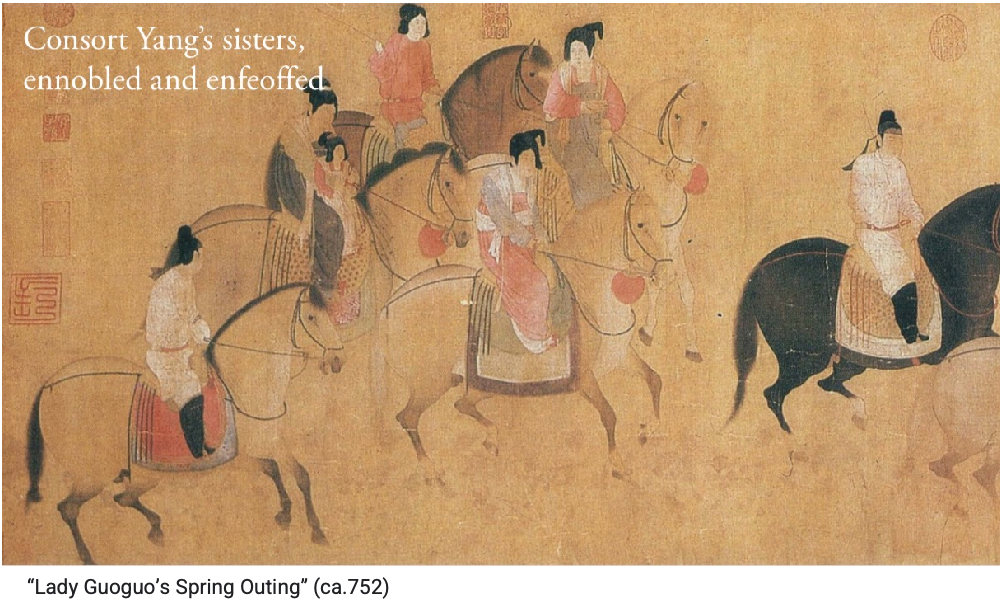
hence this tells something about the change of attitudes towards women
-
freedom of women wearing riding trousers with faces uncovered, where as in later centuries women of equivalent status would always be veiled, ear robes, and be restricted to sedan chairs (Song dynasty)
-
but unfortunately due to decline of Tang later, it reverted to conversative clothing
-
-
however, at late ages had some problem. He fell in love with Prized-Consort Yang杨贵妃, and gave too much power to her
- falling in love with 杨贵妃, who lacked political sense, even when he is 60
- gave too much power to Yang and her relatives, so they almost monolpolized the government
- basically becomes a femme fatale
-
An Lushan liked by Emperor, but relative from Yang’s family disliked his power, so arrested and executed An Lushan's supporters in court
- this oral history and gossip recorded in Bai Juyi’s “A Song of Unending Sorrow”
-
however, Yang did show us the standard of beauty at that time is to be a little bit chubby
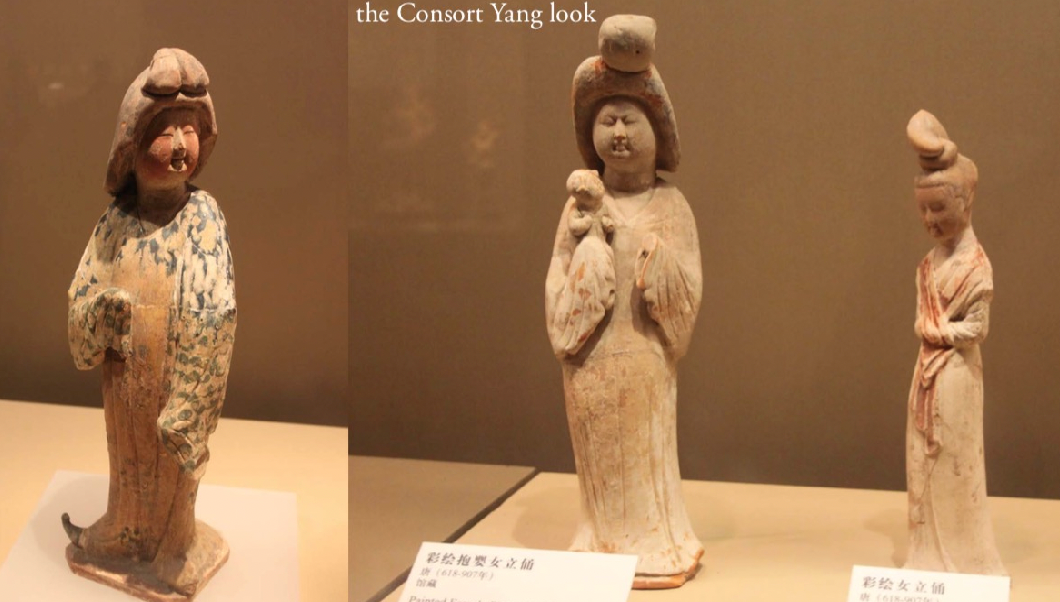
Battle at Talas: in modern Khazakhstan
- suprised by the sudden defection of China’s tribal allies, the Chinese lost the battle to the Islamic Abbasid caliphate
- marked the beginning when region of Central Asia turned away from China towards the Islamic world
General An Lushan’s rebellion (755)
-
recall that Yang Guozhong (cousin of Prized-Consort Yang, chief minister) began to purge members of General An Lushan’s faction due to Yang’s relative’s dominance in court
-
also at that time, due to malfunctioning of equal-field system, state relies on soldiers from alien tribes instead of collected from each field
- problem 1), they don’t pledge alliance to Tang
- problem 2), they become long-lasting, whereas equal-field collected soldiers will go back home
- problem 3), An Lushan was also particularly powerful due to prior likings of Emperor Xuanzong
-
General An Lushan:
- commanded two large frontier armies in the northeast, in modern-day Beijing.
- father was Turkish; mother was Sogdian.
- alarmed that his supporters at court were being arrested and executed.
- in 755, leads an army of 150K troops towards the capital cities.
- he first captures Luoyang, the ‘eastern capital’ on the edge of the plains.
- from Luoyang, the fortified Tong Pass blocked westward passage to Chang’an.
- but Yang Guozhong pressed imperial forces to leave the Pass and do battle—and were destroyed by An Lushan. - frontier troops were professional, war veterans; capital troops, unseasoned.
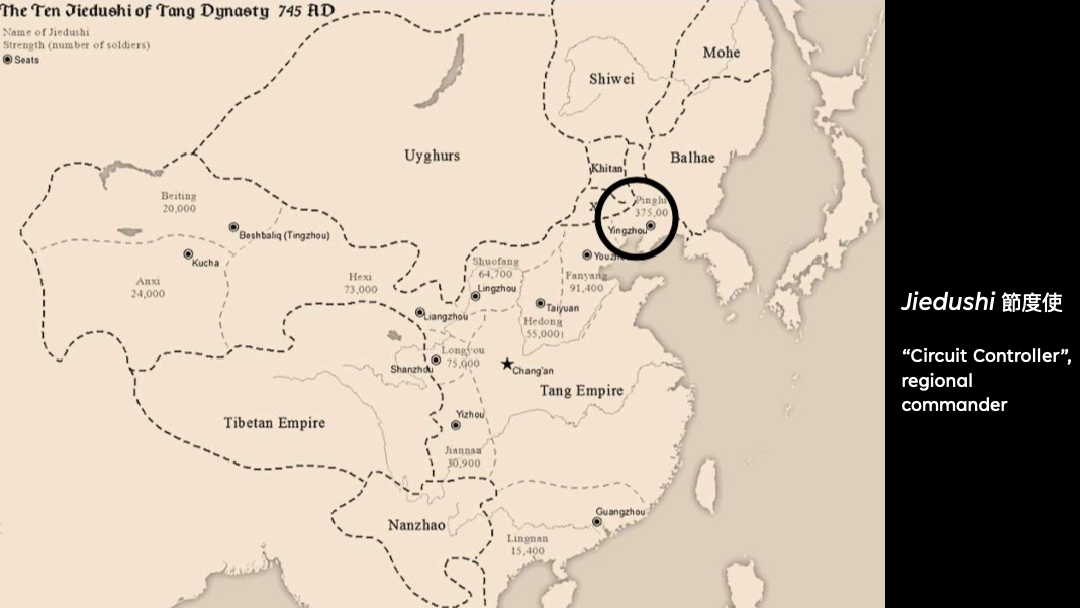
-
as a result, Emperor Xuanzong flees from Chang’an to Chengdu (modern-day Sichuan), and eventually abdicates the thrown to his son.
- note that Chengdu is also the capital of Shu, and hence “The road to Shu is steep” from Li Bai is relevant
Consequences of this rebellion? A major turning point for Tang: decline of Tang stability
- Tang’s forces in central asia has to be recalled for rescue. Tibetan Empire and Muslim Caliphate are also encroaching those areas, so a retreat made Tang a lost of control there, which eventually caused the lost of control of the Silk Road
- Xinjiang ceded to Tibetan empire and Muslim Caliphate
- central asia then changed from Buddhism to Islam
- cut-off from horse supplies due to lost of Silk Road
- became less cosmopolitan in western eyes
- without this buffer zone frontier, capial Changan is more exposed to incursion
- rise of regional warlordism: to quell the rebellion, Xuanzong gave a lot of power for regional governors.
- then those regional governments later made themselves autonomous, hence results in political chaos
- but also caused an even further increase in local military knowledge
- rebellion resulted from, caused, or simply coincided with
- collapse of the equal-field system (for collecting tax revenue)
- during quenching rebellions, system of household registration collapsed = does not know how many residents are there = cannot collect tax
- because there is a shortage of land (due to population increase, aristocrats gathered too much land). Government cannot raise enough revenue.
- lost hold of household registrar = lost direct control of the people! Then then had to rely on regional governments to report those numbers, which never works out.
- collapse of the militia system, since no money, hence has to relie on foreign solders who pledged alligence to comamnder bu tnot dynasty
- collapse of the equal-field system (for collecting tax revenue)
- all of those contributed to the collapse of the down fall of Tang
- this is also a period of time hard for ordinary people to survive, e.g. as deadly as first world war
- as the battle happed in the capital, Du Fu and his family fled. This also becomes a major turning point in Du Fu’s life
Poetry: Li Bai and Du Fu
-
they are friends but differ greatly in work. Li Bai write about nature, especially wine, but Du Fu is more for his social consciousness (e.g. events happening at Tang)
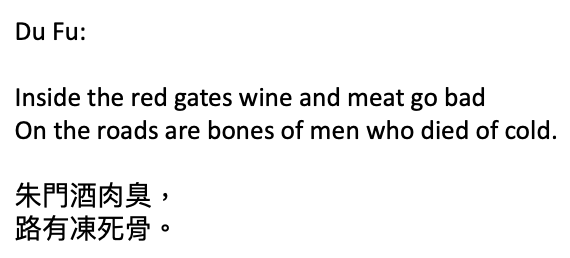
-
the rebellion was also a turning point of Du Fu
- no longer a confident scholar, but become an ordinary person, hence his writing style becomes much heavier and realistic
- became a helpless pawn, and wanted to write the things he wanted to say (春望: 国破山河在, …)
Change of Territory
-
Tang is the first dynasty where knowledge of the outside world is really accessible for China commoners lives (e.g. in west markets, and pilgrim, merchants, caravans have been traveling back and forth). Before in Zhou dynasties, and even in Tang, those knowledges are mostly exclusive to the court
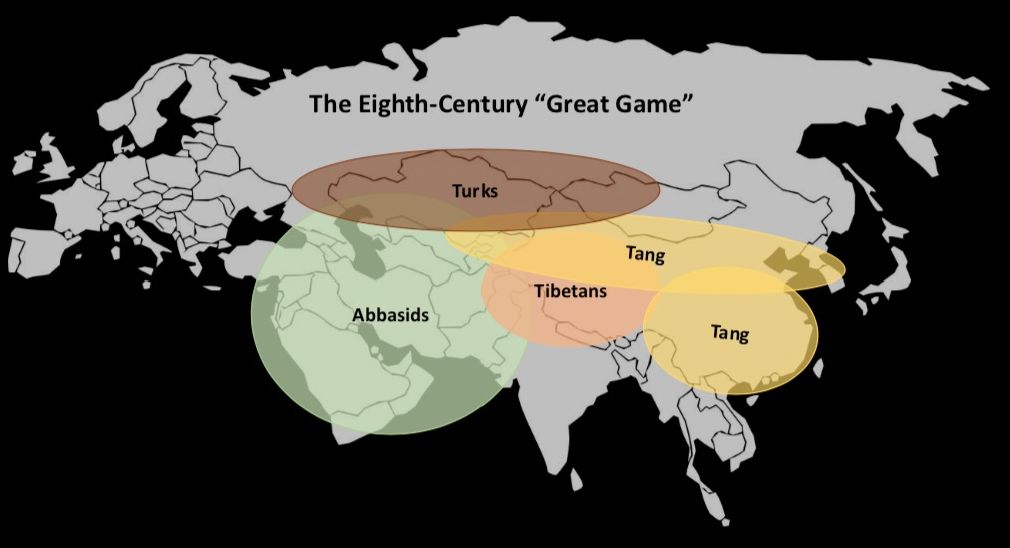
but now, China can no longer see himself as the only civilized nation (e.g. Zhou King once said the others are barbarians). Several other great civilizations exist, for the control of Central Asia trade routes
-
Muhhamad preaches Islam
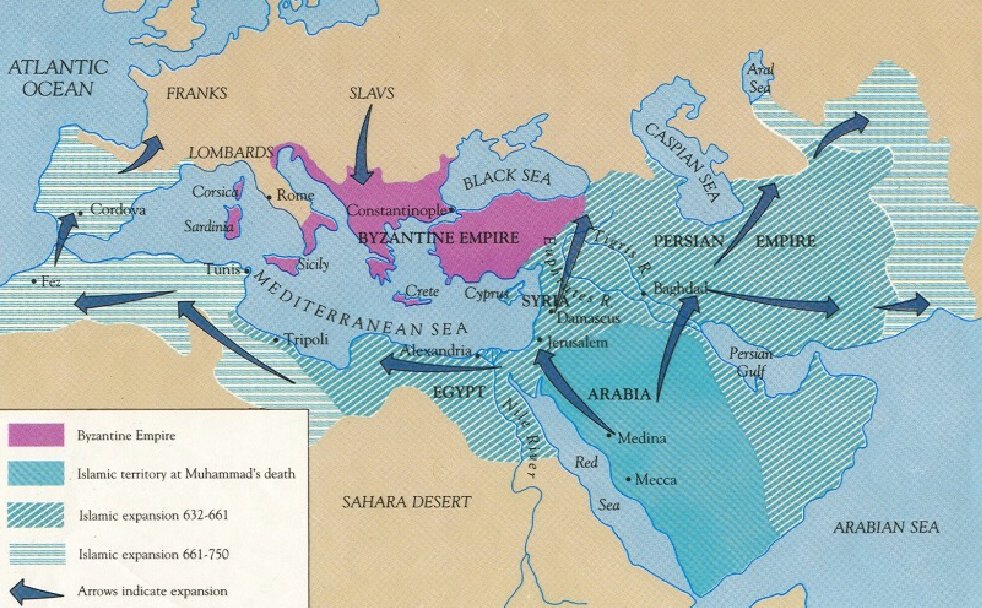
-
Arab Caliphate v.s. Tang, wanted Tang’s submission
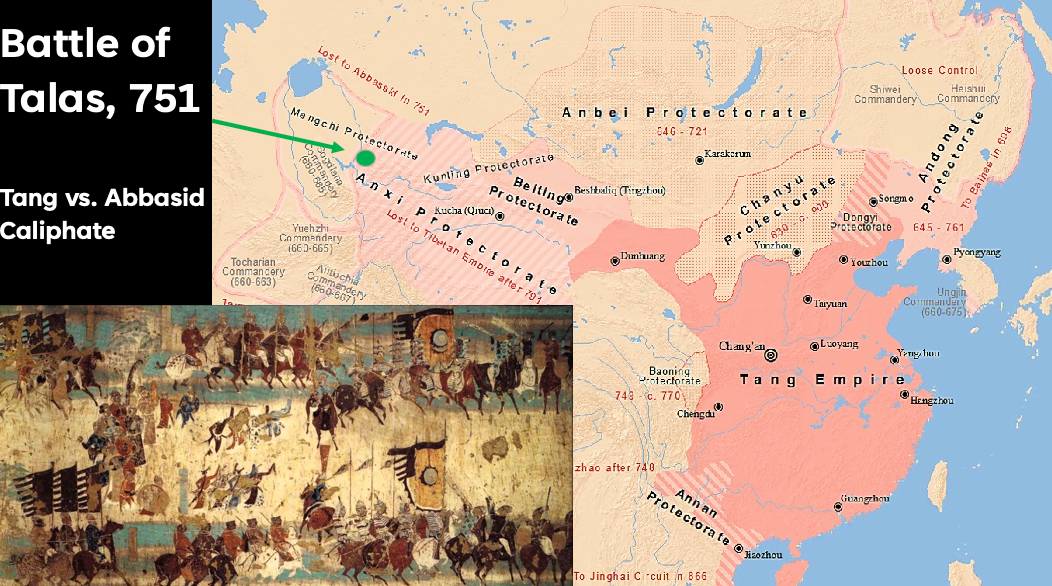
which was before An Lushan, where Tang had some initial success but suffered a decisive defeat shortly before An Lushan Rebellion.
-
Defeat = those Chinese painters, craftsmen are taken as prisoners in Caliphate = introduction of paper making and gave technology away
- people argue that this also marks the end of Tang’s west expansion
- sooner or later Islam also spread in thos area
-
-
another force was Tibetan Empire in the mid-7th century
|
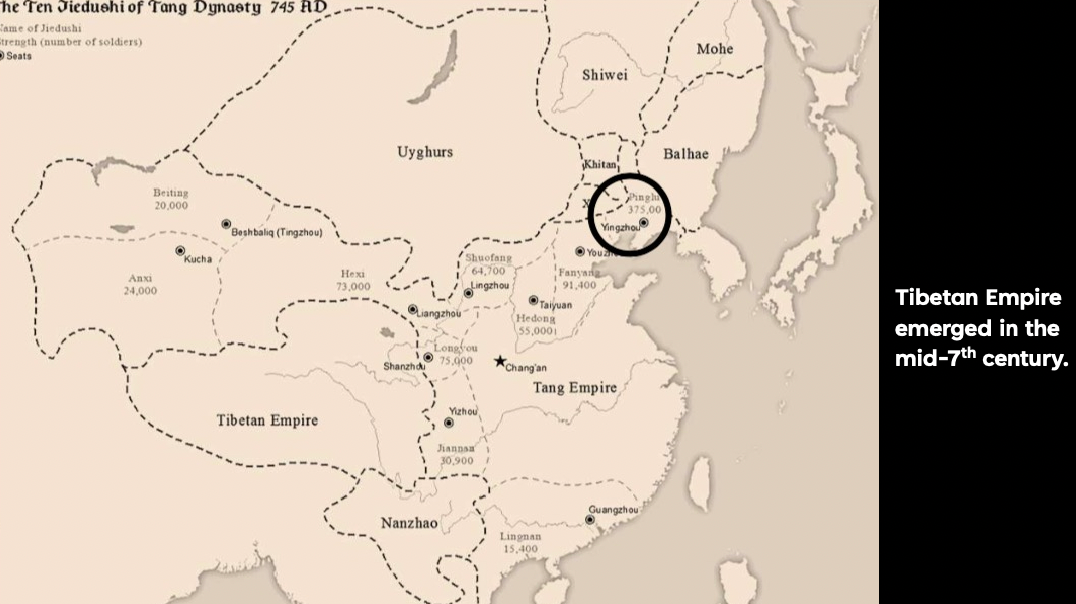 |
| 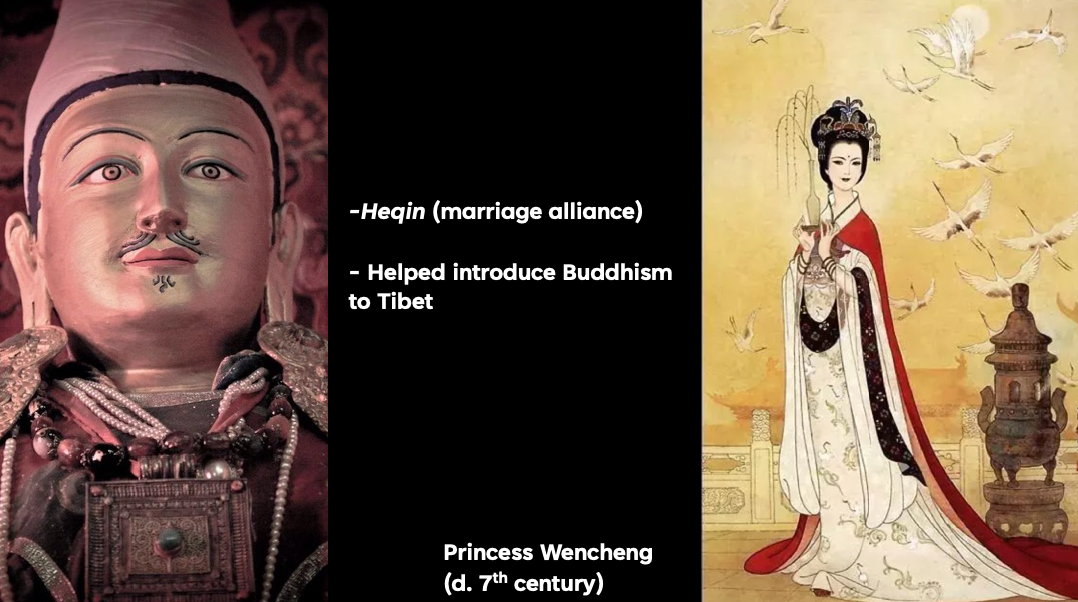 |
| :———————————————————-: | :———————————————————-: |
|
| :———————————————————-: | :———————————————————-: |the birth of this Empire comes from Songtsen Gampo, lead to organized state and powers
- Tang wanted a peaceful relation, hence had consort sent to Tibetan King, and made alliance with Tibet
- this princess is said to bring agricultural technologies, and to introduce Buddhism
- later, Songtsen Gampo also married a Nepal princess, who had their own version of Buddhism
- after Songtsen Gampo, (esoteric) Buddhism became Tibet’s religion, but very differnt from Buddhism in China
even though there are some peaceful times, it eventually deteriorated. So after An Lushan, Tibetan Empire recaptured the land and tried to press on deeper in China

this also caused the direct routes for Silk Road is no longer at Chinese hands
Examination System In Late Tang: Bai Juyi
- even after all those territorial changes, the system of examination stayed basically the same as in Early Tang
- exams tested on
- classics and literary ability/merit: write essays on a given topic
- social ability: establish good relations with examiners
- sons of powerful official families often given high scores, hence still mostly elite families in offices
- In 800, for once the exam is just based on merit, and Bai Juyi passed
- a different structure in Song
The Rise of Eunuchs
- usually eunuchs are for serving women’s quarters (guard the women’s living areas), and some for messengers and some for spies on military commanders
- but after An Lushan’s rebellion, they began to
- gain control of the emperor’s personal army
- placing adopted sons into different offices, and forming factions with each other
- hence eventually obtained high positions and controls
- over the ninth century, there are eight more changes of emperor where each accession was engineered by eunuchs working in concert with political factions
- hence, life at court such as Bai Juyi depended a lot on which faction is in current power
Mogao Caves and Dunhuang Library
- The ‘Caves of the Thousand Buddhas’ (Qianfodong), also known as Mogao, are a magnificent treasure trove of Buddhist art. They are located in the desert, about 15 miles south-east of the town of Dunhuang
- By the late fourth century, the area had become a busy desert crossroads on the caravan routes of the Silk Road linking China and the West. Traders, pilgrims, and other travelers stopped at the oasis town to secure provisions, pray for the journey ahead or give thanks for their survival.
-
adjacent to one of the caves was the hidden Dunhuang Library discovered by Daoist Wang: a secret library of 40,000 documents was discovered inside cave #16 by Wang Yuanlu. The library is referred to as cave #17
- almost half of the text where Buddhist text in Chinese or Tibetan
- first time purely original documents not for public use (compared to books written after the fact) to reveal the real life - religious and civil in Tang.
- but because papers are recycled, the margins and backs display all kinds of documents, including literacy work, contracts, government documents, etc.
-
some civil and religious life revealed include
-
During the thousand years of artistic activity at Dunhuang, the style of the wall paintings and sculptures changed. The early caves show greater Indian and Western influence, while during the Tang dynasty (618–906 C.E.) the influence of the Chinese painting styles of the imperial court is apparent.
-
donor portraits with Xianbei ethnic feature
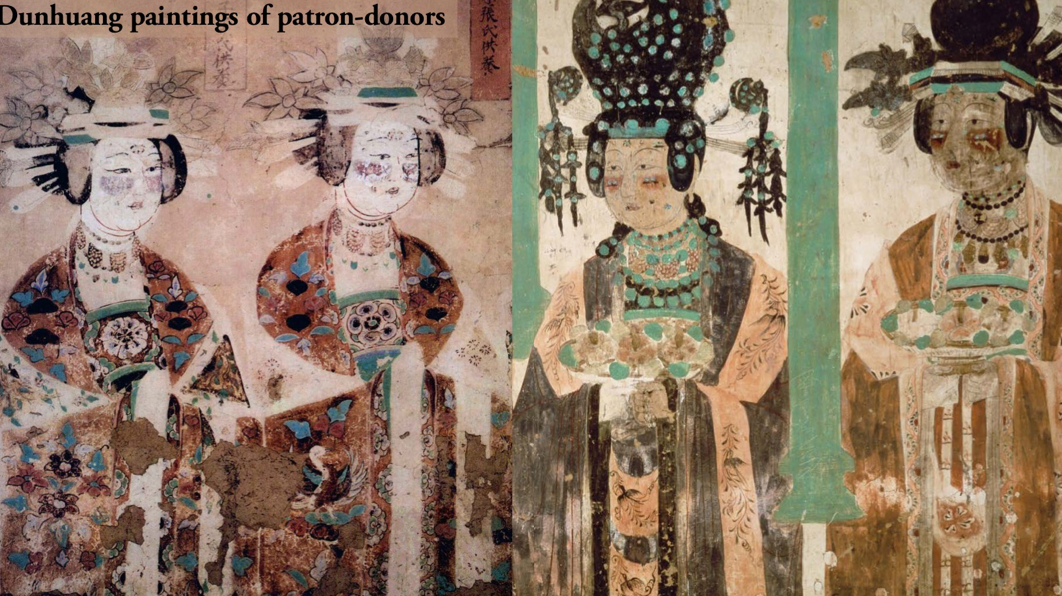
-
monasteries at Dunhuang also ran a variety of money-making enterprises, including oil presses
-
Sodigan letters, Irq Bitig (8th-9th c), the only Old Turkic manuscript partially overwritten with Buddhist verses in Chinese
-
The Beginning of Printing
-
the first printed book found in Dunhang library cave.
-
during Tang there were a high demand for texts (e.g. religions), hence lead to invention of woodblock printing, and later in Song 活体印刷
|
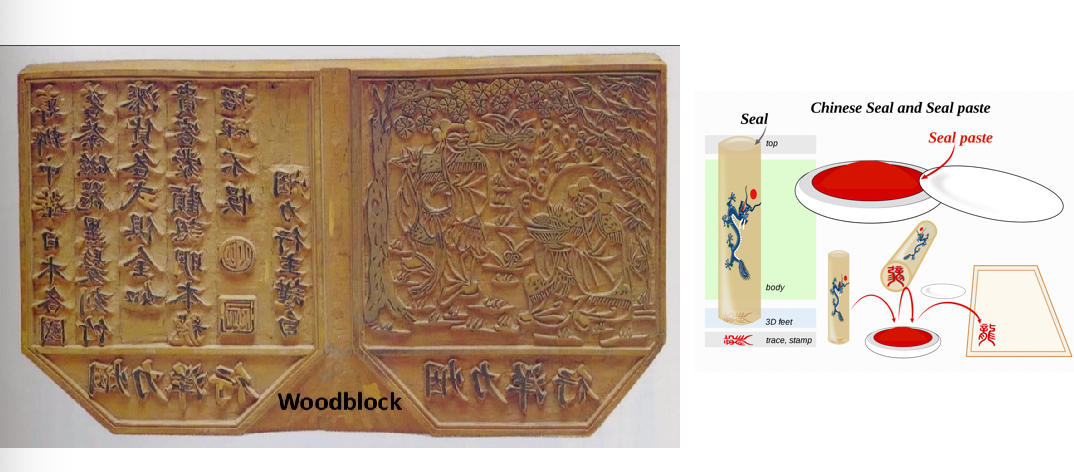 |
| 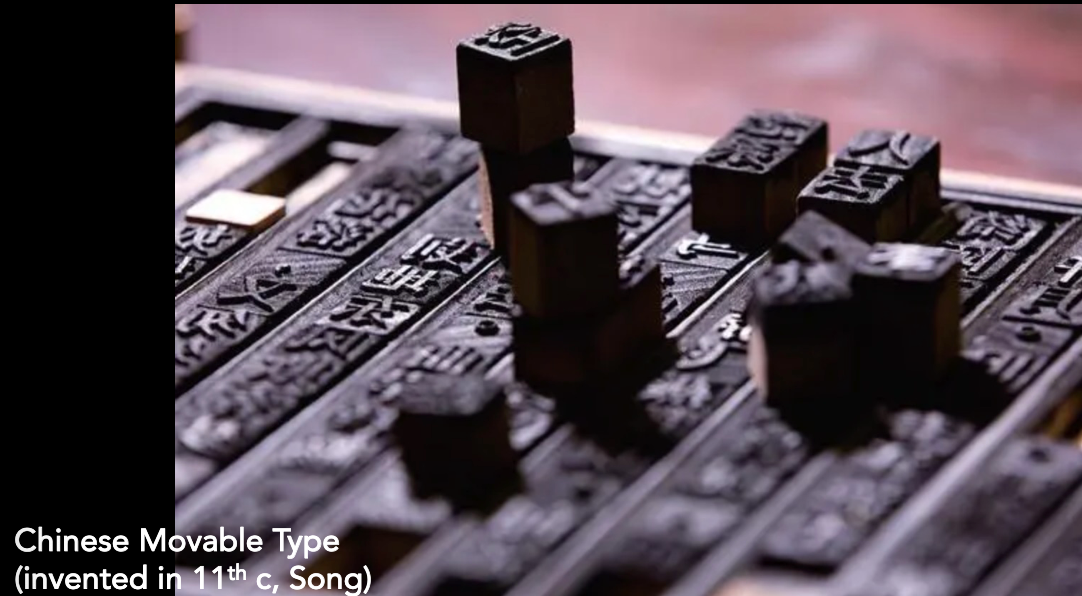 |
| :———————————————————-: | :———————————————————-: |
|
| :———————————————————-: | :———————————————————-: |where the problem with the old technique is that if you made a mistake, the whole mold is useless
Persecution of Buddhism (840 - 846)
- many aristocrats were using land as Buddhism temples to evade tax
- but also a lot of conflict between Buddhism v.s. Daoism and Confucianism
- at the end of Tang persecution of Buddhism provoked by Daoist, but also rationalized by Confucians
- sees those temples asked commoners to buy weird goods and donate money while undermining tax revenues
- see Buddhism to undermine family ties, give up your own responsibility and become a monk, hence violates Confucians ideal
- during (840-846), also as emperor favored Daoist, Buddhism was persecuted = lots of monks and nuns have to be returned to their normal social status
- while Buddhism did not diminish, their impact in China never rose again to the peak in early times
Huang Chao Rebellion
-
ruined Chang’an, never again as China’s capital
-
put an end to high aristocracy in court by targeting the aristocrats of Tang
-
contributed to the fall of Tang in 907, and the distribution of power in China after the rebellion becomes
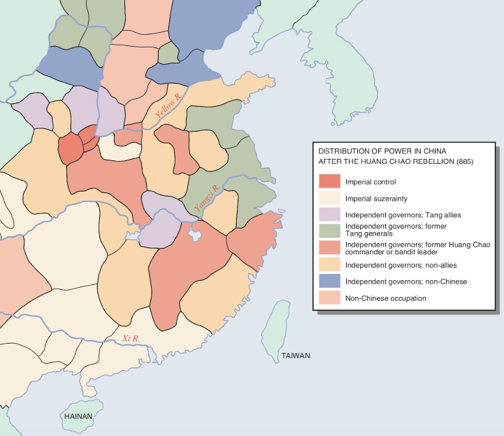
Song (960-1276)
Previous only the downfall of Tang
- Tang critically weakened by the An Lushan rebellion (755-63), allegedly caused by intrigue surrounding the Precious Consort Yang, Tang dynasty enters decline
- retreat of forces in Central Asia lost control of it
- Eurasian Empires in the 8th century: Tang, Tibetans, Muslims, Uyghur-Turks
- Tibetan Empire: Songtsen Gampo, Princess Wencheng. Eventually took over the Hexi corridor which is critical for Tang’s access to Central Asia
- Abbasid Empire (Muslims): the Battle of Talas (751) between the Tang and Abbasids, signals Tang loss of control over silk road and central Asia
- The Mogao Caves in Dunhuang: provide an abundance of vivid materials depicting Buddhist arts, religion, culture (4th-14th c), the largest body of Buddhist art in China; the library found there includes many secular texts that tell about politics, economics, ethnic relations of the local society in western China.
- Persecution of Buddhism: an example of conflicts between religion and state
- Buddhist monasteries before operated oils, loans, banking services, and hold a large land being tax-exempted
- hence the central government became annoyed especially when they don’t have enough tax revenue
- Buddhism survived the persecution, but never reached its peak status as in Tang until today
- Regional rise of warlords in late Tang (just like the final breakup in the Han dynasty)
- government became decentralized during rebellion, and many elites fleed and clustered in Chang’an and Luoyang.
- then those elites are obliterated/almost compteletly wiped out during Huang Chao Rebellion
- hence a period of disunion in 907 - 960, and the Wei river valley, Chang'an + Luoyang never again reach their prosper in the past
- therefore, this removal of stale upper-class aristocrats also contributed to the success of the civil service exam in Song = really based on merit = based on your ability to read, understanding Confucian classics
An Early Modernity in Song
China’s Population throughout History
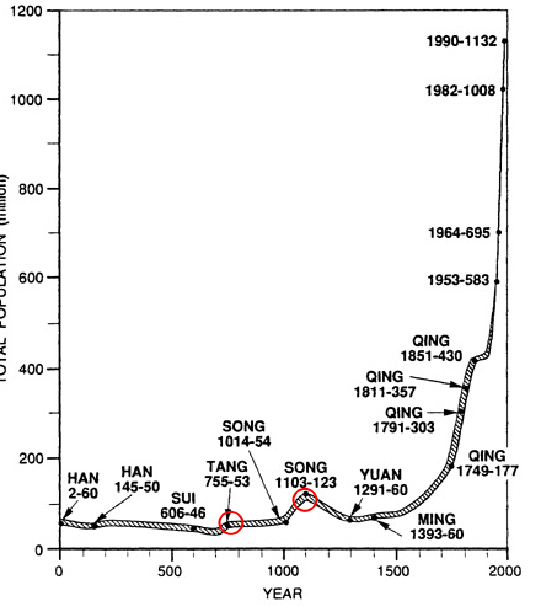
-
inability of government in Tang might not mean bad economy. In fact, late Tang stimulated economy: rise of population, almost doubled even during Tang decline
-
also a significant shift of population from north to south.
- Before North:South population is 2:1 in Early Tang
- After An Lushan Rebellion 1:1
- In Southern Song 1:2, when their capital in Kaifeng is sacked
-
late Tang also have lots of technological developments, such as paddle-wheel Ship and Woodblock Printing
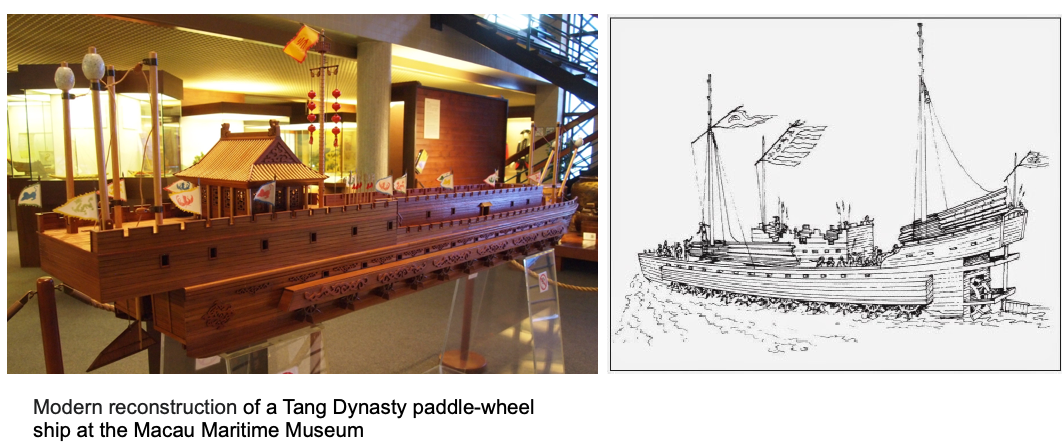
Song Territory
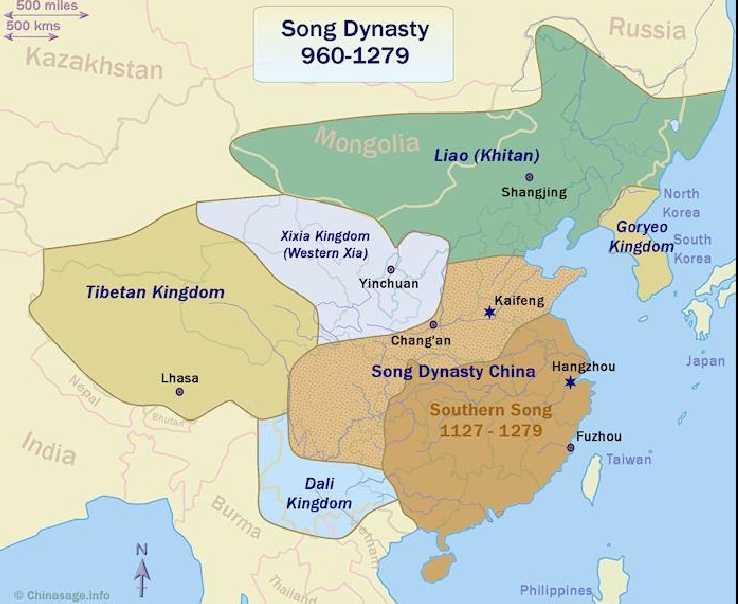
- Song’s territory is the smallest among all of Tang, Song, Yuan, Ming, Qing
- also divided in two periods.
- Early/Northern Song rules both north and south, including Kaifeng
- Late/Southern Song rules only capital at Hangzhou (Kaifeng is sacked by the northern enemies, i.e. the Jurchen forces)
- but Song in general have a modern economy being industrialized and monetized
Agricultural Leap in Song: factors contributing to rise/improvement in agriculture
-
new strains of rice from Champa/Vietnam = more rice yield as it can harvest twice a year
-
mass iron production for plows and farm tools
-
mobilization of bio-power (human and animal labor inputs).
-
improved, intensive farming techniques of rice plots.
- wider application of fertilizers
-
dikes, canals to convert wetlands to farmland.
-
advances in water/irrigation control, including pump and water mills
Pump Mill 
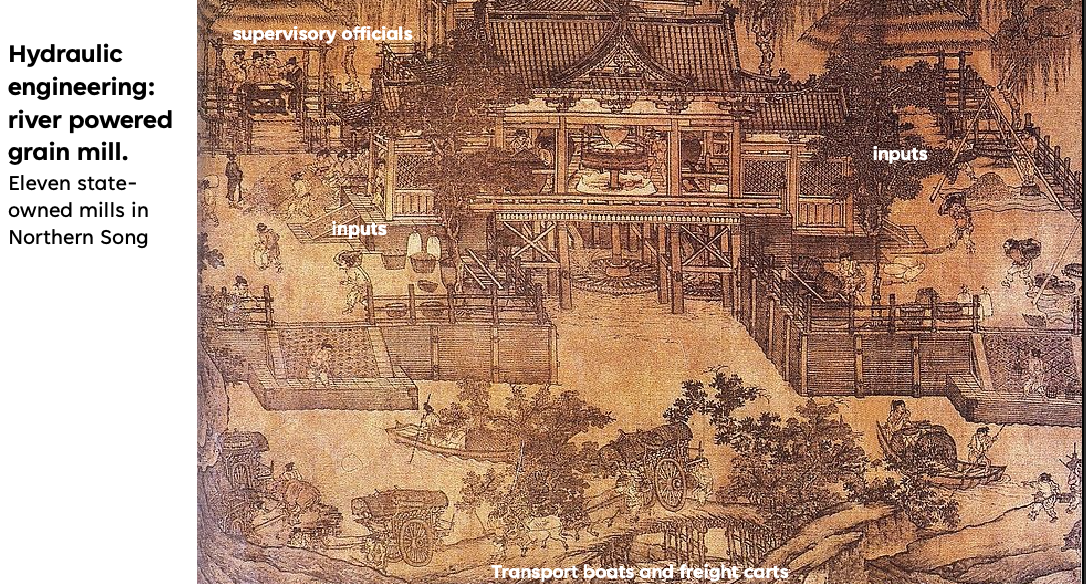
hence families can get more rice then needed = can sell the rest and exchange goods
-
as a result, population doubles to 120 million, from 60-65 million in Tang
Commericial Modernization in Song
-
new/more agriculture techniques + invention means more specialization
-
peasants can just exchange for other goods instead of trying to produce it themselves
-
in late Song cottons=cash crop
-
-
as compared to regulated trades in Chang’an in Tang, in early Song, merchants and shops are spread out in town to intermix with residence
- some even had the stock system = manager+owner of business
- credit systems adopted by traders
- an increase of people in middle class
-
encouraged maritime trade (as compared to Tang), due to cut off of silk road
-
encourage foreign traders to come to China as well
-
to achieve maritime trade, needs improved ship technologies

as well as the invention of compass
-
-
as trade increase, demands of money increased. In addition, silk was also used as currency
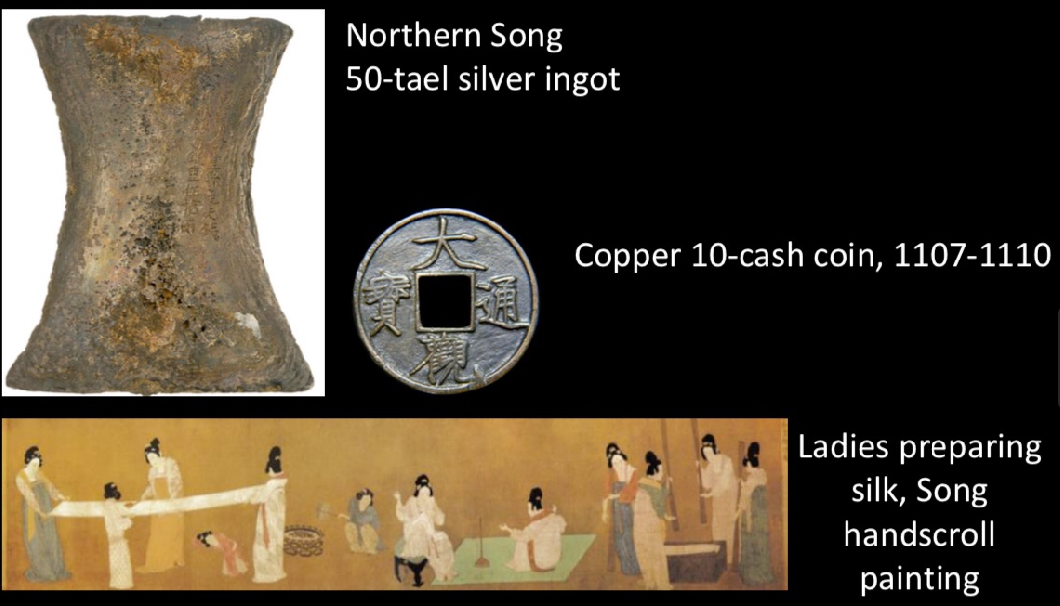
the largest output in Tang was 320 million coins a year. But in late Song, government maintains more than 6 billion coins. But there was still not enough, as there is still no inflation.
- government requires more money in circulation
- demand has been so great and hence issued the first paper money, which can be created out of nothing
Paper Money Government Logistics 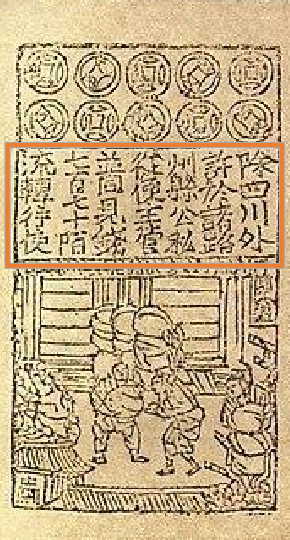
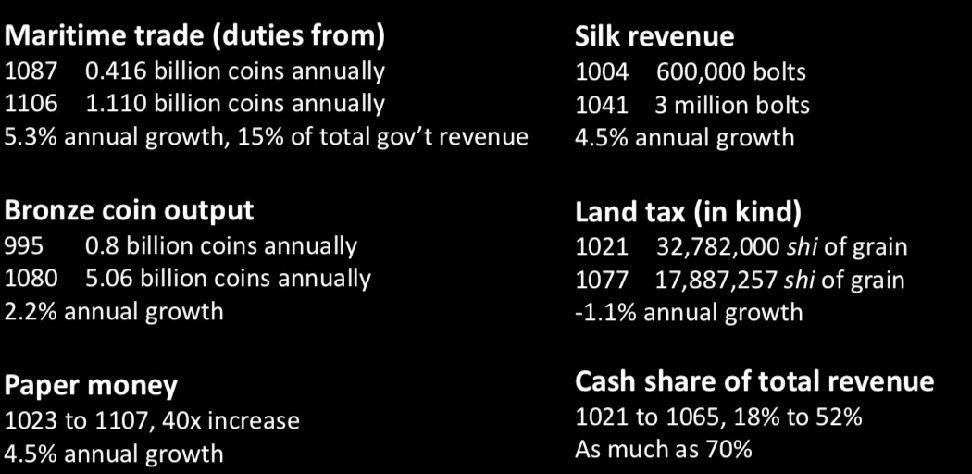
hence Song’s economic change to China is almost revolutionary
Wang Anshi vs. Sima Guang
-
despite overall economic boom, some farmers still suffer from interest rates and tax
-
The Emperor Shenzong of Song faced declining taxes and an increasingly heavy burden of taxation on commoners due to the development of large estates, whose owners managed to evade paying their share of taxes.
- Therefore, he sought for advices, and comes Wang Anshi
-
Wang’s primary objectives of New Policies (xinfa) were
- cut government expenditure and strengthen the military in the north (which requires funds)
- To do this, Wang advocated for policies intended to alleviate suffering among the peasantry and to prevent the consolidation of large land estates which would deprive small peasants of their livelihood = aimed to help improve the wealth gap
- in reality, his policies is effectively the last effort by Song government to control the economy = last strand
- but this failed because the local officials implemented this policy were rewarded for how much loans they gave out $\to$ local officials benefited more than the farmers
-
Specifically, his policies include:
- fixing fiscal policy: Green Sprout reform, which give peasants money in the beginning and ask for repay with 40% interest at harvest time (so they don’t need to rent from landlords)
- schemes of transporting money
- pumped more currency into the economy
recevied initial success but failed in the end
-
Sima Guang (not related to Sima Qian) is one guy opposing Wang’s policy: wanted incremental reform instead of all processes done at once = too fast
- Wang Anshi almost like Legalist, as he is making state intervening deeply to people, hence denounced as un-Confucian
- Wang Anshi therefore needed more support in court = reformed civil exam system to teach his thoughts
- further exacerbated the problem
Organization in Song: Idealized urban life
-
Qingming scroll, idealized urban life in Kaifeng (debatable), but anyway exemplifies Song’s rigor and commerce
Full Scroll Center Piece 
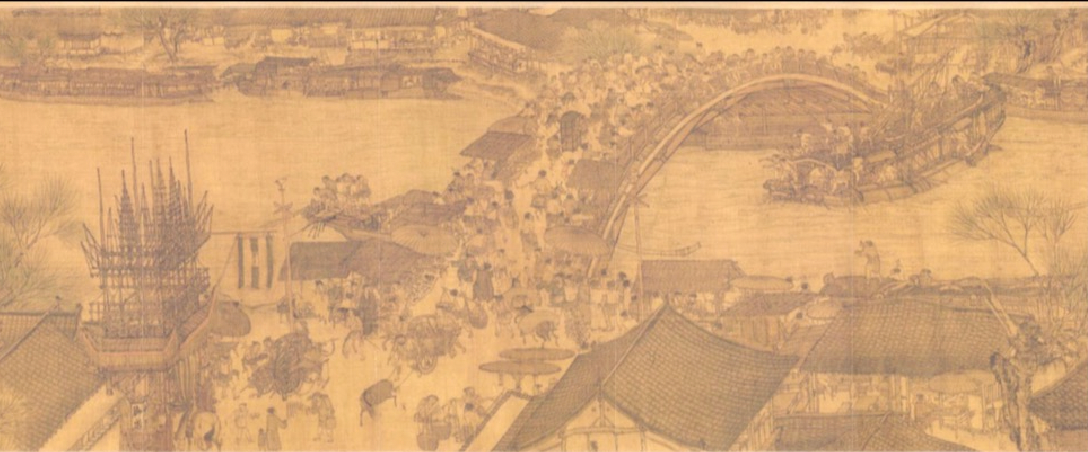
notice the overall city structure is very different than Tang: symmetrical + structure, but Song = more organic. This hints at the difference between Tang and Song: Song is moving away from society full of aristocracy to more middle class based society, hence different city layout, etc.
-
transportation in Song: important people on horse backs and in caravan
|
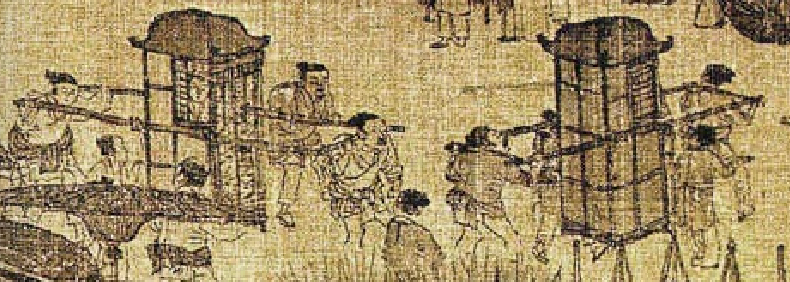 |
| 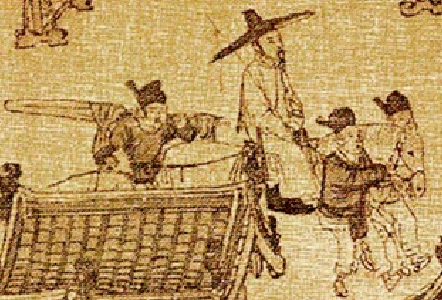 |
| :———————————————————-: | :———————————————————-: |
|
| :———————————————————-: | :———————————————————-: | -
but notice the lack of female figures in the scroll: if this were Tang’s time, women on streets with beautiful dresses, why such changes?
- recall that Empress Wu tried to improve women’s status, and during Emperor Xuanzong women can come out homes and wear men clothes
- but in Song, there is
- commercialization=market economy, so that with coinage + paper money $\to$ women became commodified again (e.g. prostitutes, sold daughters, etc)
- foot binding in Song, women having small feet = standard of beauty = object of sexual desire, because this means it feet becomes a private part of body only seen by herself and husband
- correlates with the growth of Song’s commercialization, and that families sell daughters + people kidnap women
- women transformed into commodities who were bought and sold on the basis of appearance
- women of good families compete with women with bound feet, hence 卷起来了
- however, in general women do exert greater autonomy at home by handling the household estate as men die earlier
-
some unrealistic aspects of the scroll is
- notice that there is no trash on street
- no fire stations, weird because lots of houses should be made of wood
- another modern visualization from some text include

notice a fire station and soldiers repairing canal
Capital at Hangzhou: south already contained a lot of population but then with capital shifted to Hangzhou in late Song, living in south becomes popular
- recall that in Late Song, Kaifeng is sacked, so people moved to Hanzhou
- since Late Tang people are migrating, but recall that
- south was hard to irrigate = solved by building canals
- north much exposed to steppe culture, and to the northern enemies, hence much more chaos = less preferred eventually
| 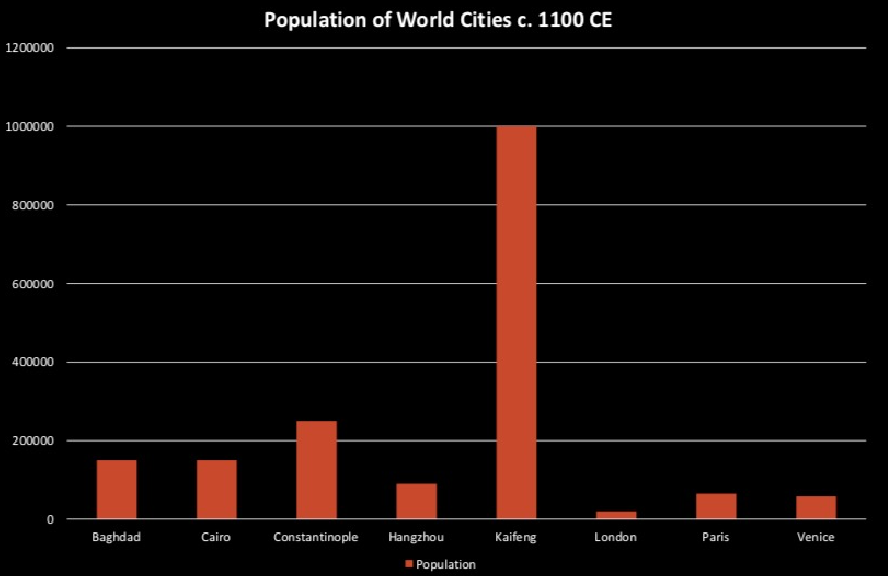 |
| 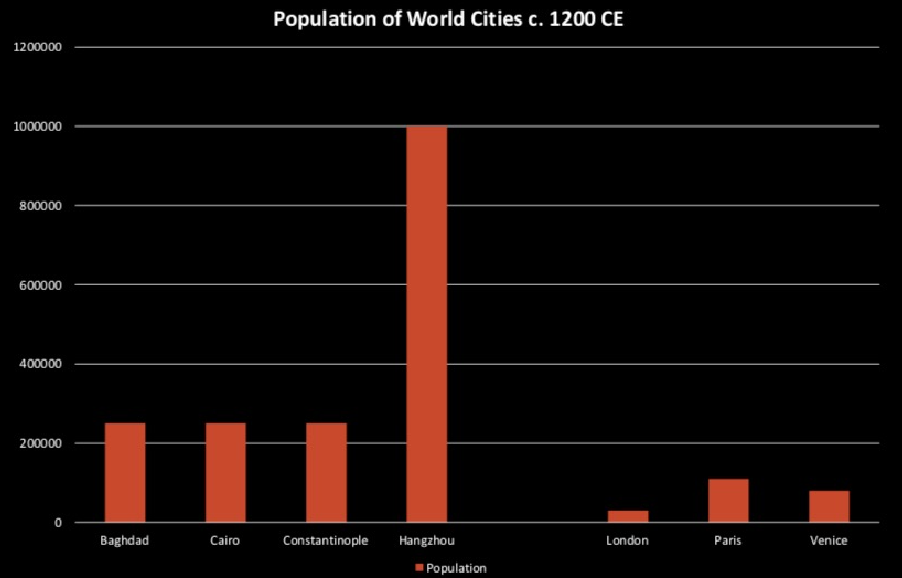 |
| :———————————————————-: | :———————————————————-: |
|
| :———————————————————-: | :———————————————————-: |
Urbanization in Song
-
as advancement in agriculture = food surplus = people can have other occupations
- movement of both people and good into cities
- both Kaifeng and Hangzhou were linked by the Grand Canal (built in Sui)
- both Kaifeng and Hangzhou had population reaching at least 1 million
-
in mid Song, 5% population already urban
-
however, this raid commercialization can have adverse effect on government
- technology advancement so fast that government cannot keep up with it
- e.g. in Tang, a small elite group in government is easy to control. But now in Song there is an emerging elite class/middle class with new found wealth = push against the centralized control Tang had
- this diffusion of “resources” also relates to the “laicization” of Song religion. Practicing religion becomes shifted away from institution but more towards individual activities any lay people can do, e.g. building their own shrines
- very similar diffusion of governmental control, so it now the religious institutions
therefore, the general theme of rising middle class and a "anti-centralization" of resources as compared to Tang is also a distinct factor in Song
New Elite: Scholar-Officials (shi士, or shidafu士大夫)
-
recall that shi was in Zhou as mlitary people
- In the first half of the Chunqiu period, the feudal system was a stratified society, divided into ranks as follows: the ruler of a state; the feudal lords who served at the ruler’s court as ministers; the shi (roughly translated as “gentlemen”) who served at the households of the feudal lords as stewards, sheriffs, or simply warriors; and, finally, the commoners and slaves.
- In Warring States period, they become more specialized forces (e.g. in defense) that includes people of humble origin (climbed up by education)
- shi in Han = Confucian scholars, but shi still dominated by aristocrats since Han officials are appointed by local recommendations. However, there is a shift towards more literal skills/non-military such as poetry.
-
in Song, shi are scholar-officials certified through the civil service exams
- this new civil service exam aims to guarantee that elite families cannot simply occupy government
- success in exam = prestige in family. If passed the highest level become jinshi
- without passing exam, you will just be officials of low rank
- therefore became very competitive, 400,000 people taking but government post is very limited
- firs time in China history that ended large dominance of northerners in the officialdom (e.g. since Sui and Tang, a lot of prestigious family members have mixture of northern roots and are in the government)
- recall that Sui and Tang has a lot officials still from north + exam system are initial and social status are very fixed
-
the exam curricululm includes (ultimiate aim is for governing)
- elementary education: Analects, Classics of Filia Devotion
- ancillary exams, such as math and legal codes
- core content: classics and history
- write eesays on policy (chief examiners can take people who side with their positions)
- poetry composition
- ability to allude to historical events and personages
- easily gradable as it is standarized/ryhmed, etc.
- hence a candidate needs to memorize a lot of classics: (word count)
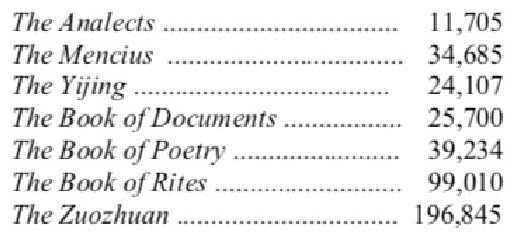
-
recall that Tang candidates know their examiners, but Song insist on the anonymity of candidates
- candidates writing will be re-copied by clerks to remove hand-writings styles
- no consideration of personality of candidate, e.g. as in Tang, and hence a very restricted version of merit
-
more state and local academies are built in Song, and increased literacy made this exam popular and hence work
-
the scholar-official (*shi*) class came to be defined by classical education and scholarly activities
-
supported also a thriving market for books, art, and connoisseur cultures. Therefore the invention of movable printing enable this remarkable demand
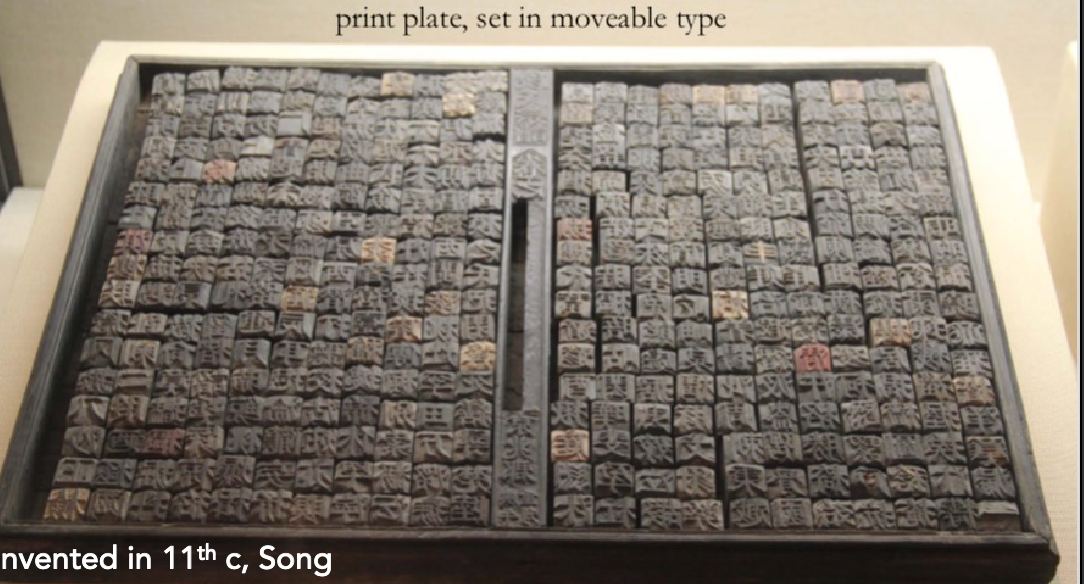
Cultural and Intellectual Changes in the Song
Previously on the Song
-
The Tang-Song transition sees a major shift of China’s population centers and economic activity southward. Population doubles, rapid urbanization, more trade (emphasis on the maritime)
-
Social change ushers the Song commercial revolution. Trade facilitated by paper currency (technology of printing) and technological innovations in agriculture, water transport, and metallurgy.
-
key innovations: paper money and woodblock printing
-
increased agriculture output = farmers produce more than they need = can specialize and trade
-
- Wang Anshi’s new policies: set of interventionist political-economic reforms designed to improve rural welfare, solidify tax base, etc. But meets Confucian opposition because implementations are legalists
- Qingming scroll aims to depict idealized life at Kaifeng, but we know that benefits did not apply to everyone.
- Civil service exams create a new bureaucracy and a new scholar-elite shi class as compared to before
Crisis on the frontier: Tanguts, Khitans, Jurchens
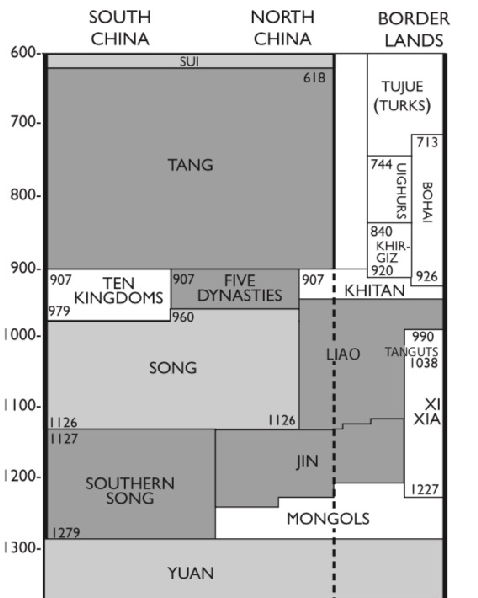
- the policies from Wang was also to cover the spending to military
- recall that Tuoba clan of the Xianbei during Six dynasties had a large army
- Tang recruited soldiers to push out China’s border, but in Song times, progressively more northern land is conquered. Specifically the Khitan, Liao, and Jurjan Jin, and Tanguts (Xi Xia).
- Eventually Yuan ruled over: Yuan was a Mongol-led imperial dynasty of China
Tanguts and China
-
Tanguts (people of Tibetan origin) after Tibetan fell apart, took Hexi corridor which is critical for the path to Central Asia
Tanguts v.s. China Horse Farm, Hexi Corridor 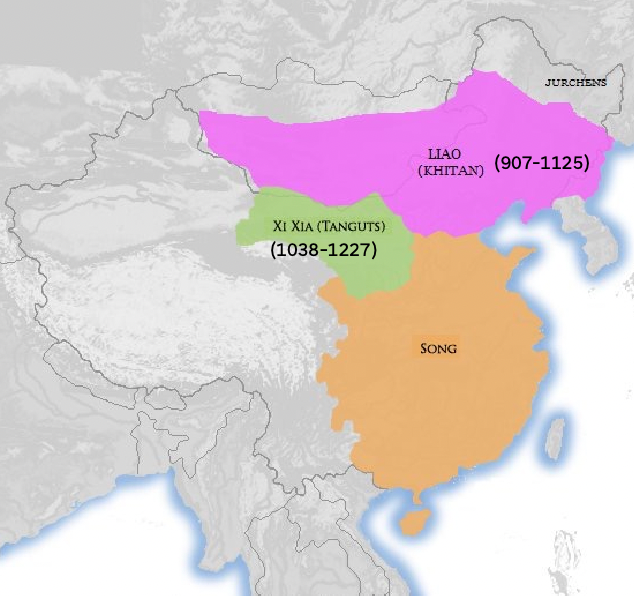
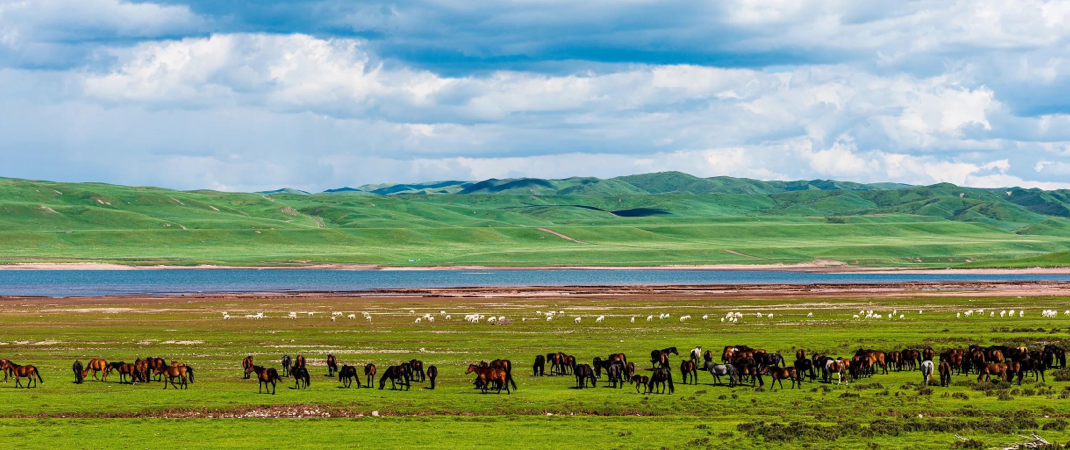
however
- has no official history because Mongol attempted to genocide the Tanguts in 1227, hence most of their text and architectures are gone
- Tanguts had a lot of heavy calvary
-
Xi Xia (Tanguts) people look lie
Costumes Scripts 
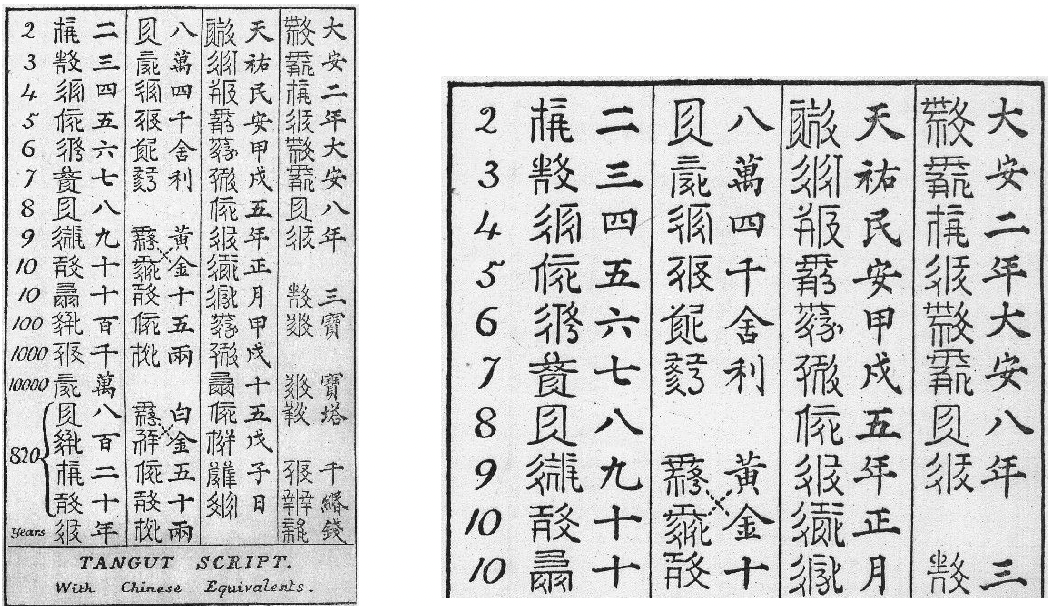
notice that
- Xi Xia aristocrat looks very alike China, because they adopted much Chinese policies and had Sinicization
- but later their Emperor mandate their specific form of hair style to keep their culture
-
their scripts are also modelled from Chinese, but much more complicated
-
Tanguts people made beautiful Buddhist artifacts in the Mongol caves as well
|
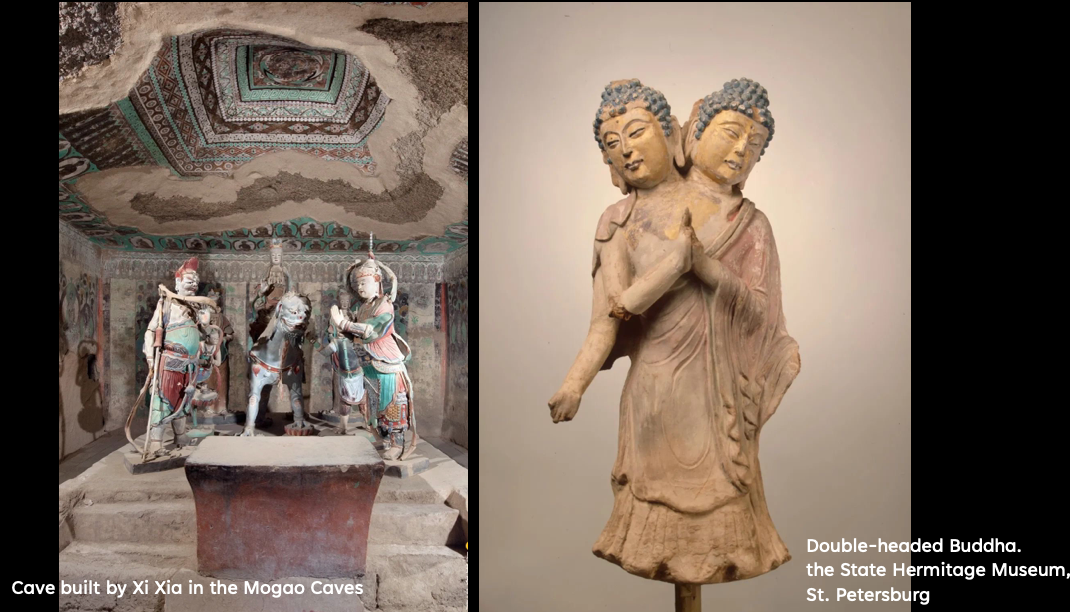 |
| 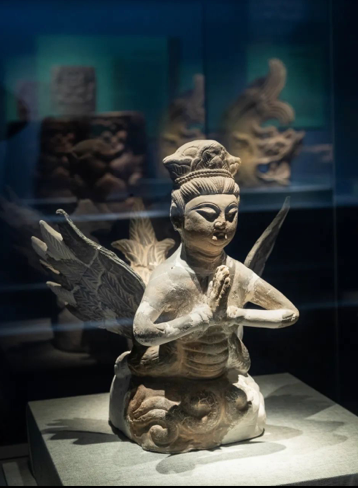 |
| :———————————————————-: | :———————————————————-: |
|
| :———————————————————-: | :———————————————————-: |
Tangut as Xi Xia (1038 - 1227)
-
In 881 they helped Tang to suppress Huang Chao rebellion
-
religion fusion: Chinese + Tibetan Buddhism
-
in early Song, lots of trade between Tanguts and Song, and many silk road goods went through them. But their relations with Song is volatile: in later Song they asked for equal status with Song Emperor:
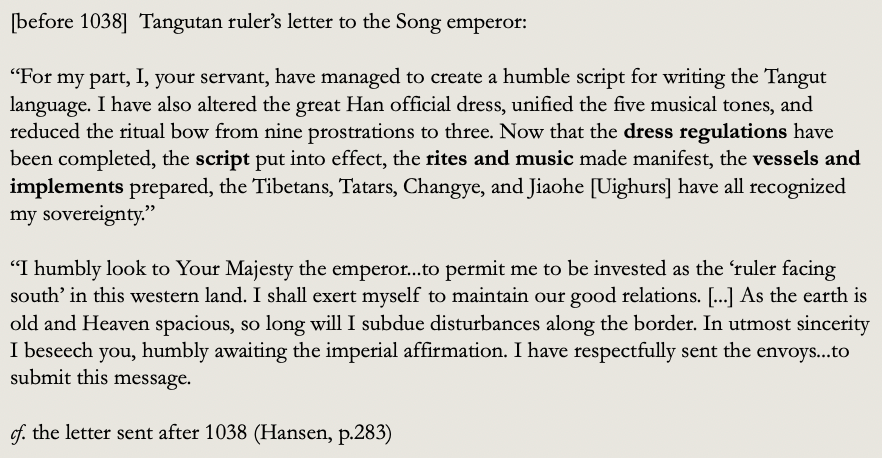
notice that
- before 1038, Tangut was polite and referred to itself being a vassal state. But after 1038, no justification is needed
- before, mentioned much culture/music as justification = imply that Confucianism is a standard for civilization = acceptance of Chinese’ idea of civilization
Khitans (Liao), 907 - 1125
- Abaoji established the tribal federation = connecting many tribes together = the Liao Dynasty
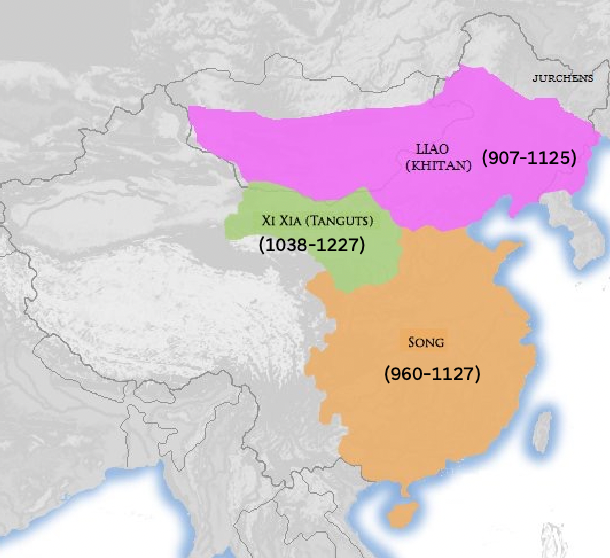
-
Khitans are not friendly to Tanguts either, but they posed more threat to Song
-
they conquered and occupied the Sixteen Prefectures, which also included Beijing, hence a lot of sentiment in Song
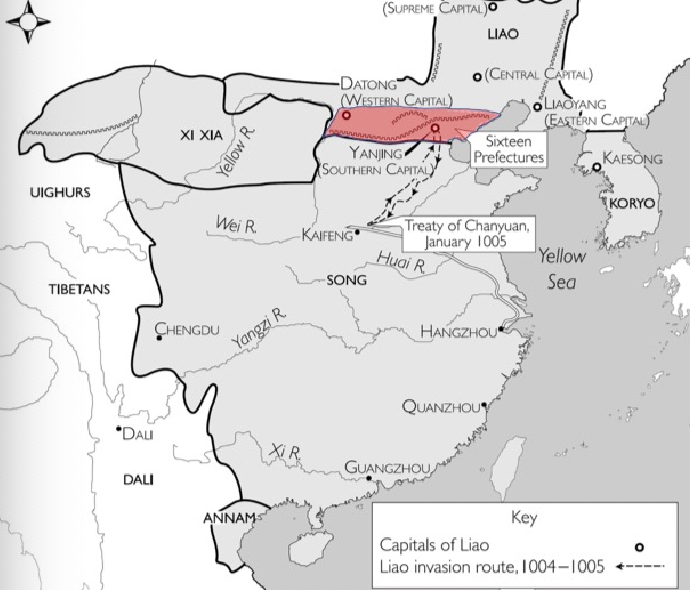
- many Song emperor tried to recover this land from Khitans, but failed
- this strip had strategic North- South chokepoints between central plains and northern steppes, Manchuria.
- was not re-captured until Yuan
-
Song was defeated by Khitan, hence signed a Peace Treaty of Chanyuan
- clear boundaries, sixteen prefecture that Song wanted is kept by Liao
- Song paid indemnity for peace, which is a reasonably cheap price hence gives little incentive for them to fight back
- Song was also forced to recognize Liao as peers (etc. Khitan would address Song emperor as elder brother)
- this is rejected by Chinese people = now you have two sons of Heaven
- sense of humiliation, major source of strong sentiment in Song
- but at least this avoided wars between them. Maintained until 1125 until Song invited Jurchens to attack Liao
-
government in North is a mobile civilization = nomadic culure. In the southern = 16 prefecture, so people kept the Chinese style
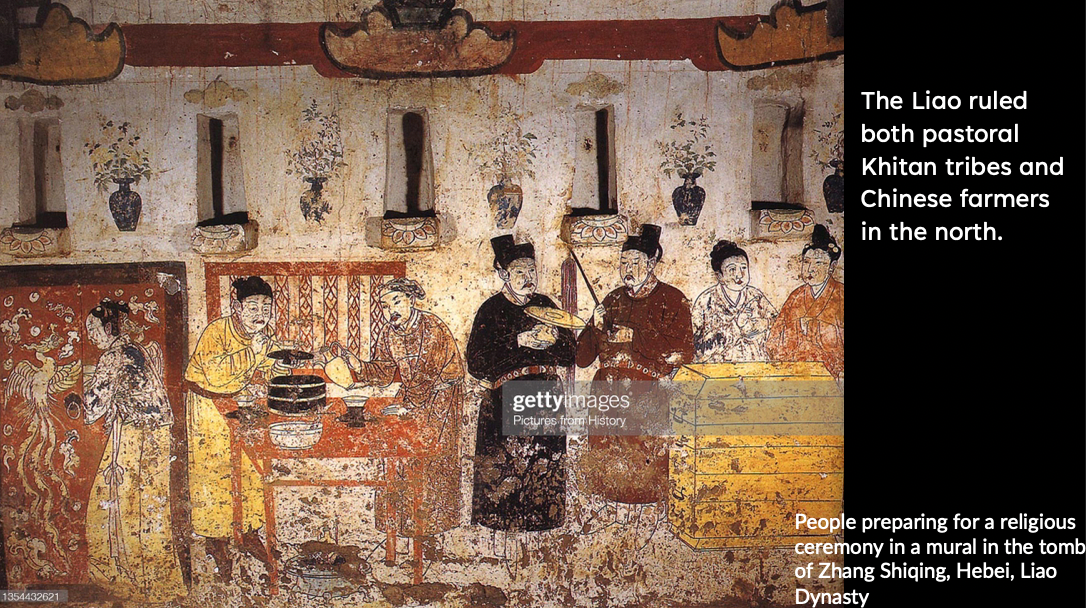
so essentially Chinese lived under Khitan rules
-
Khitan also, used by Jurchens who conquered Khitan and later adopted their own scripts based on Chinese
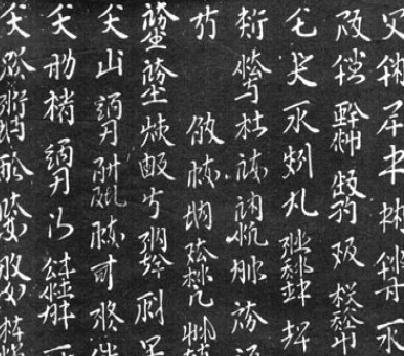
Jurchen Jin
-
further east of the Khitans, being half nomad utilizing both hunting and farming
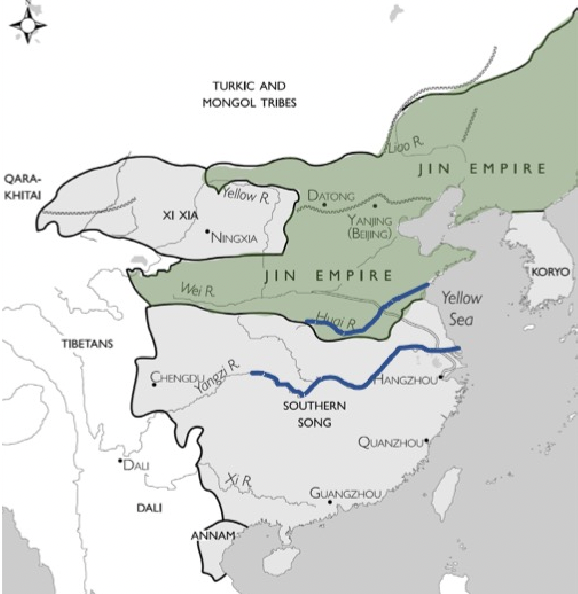
-
Originally they were subjects of Khitan, but later Aguda formed a confederation of tribes and rebelled = Jurchan
- nomad usually do not pose threats until formed confederation. But this also means that in them people are not from the same tribe
- they named themselves Jin金 dynasty
-
Jurchen was also the reason Song became Southern Song in later periods. Since every Song wanted to retake 16 prefectures from Khitan but non worked, Emperor Huizong decided to be allied with Jurchan. In 1123, Juchen defeated Khitan, but in 1127, they turned on their Song ally, and Kaifeng is lost. After that, Huizong abdicated and Song had to move south to Hangzhou.
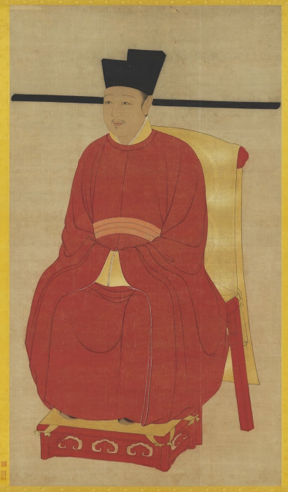
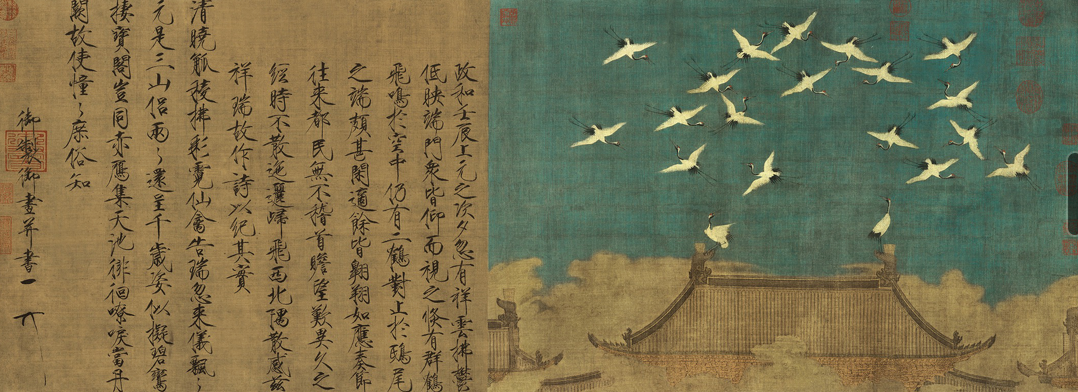
- is a great painter (e.g. three perfections, painting, poetry and calligraphy)
- Emperor Huizong wished to retake the “Chinese” territory of the Sixteen Prefectures (area including Beijing) from the Khitan Liao, but is responsible for losing the North and hence criticized by later historians for his indulgence in aesthetic pursuits
-
hence, Jurchan moved their capital to Kaifeng. But unlike Khitan who kept a duo system, Jurchan went Sinicization
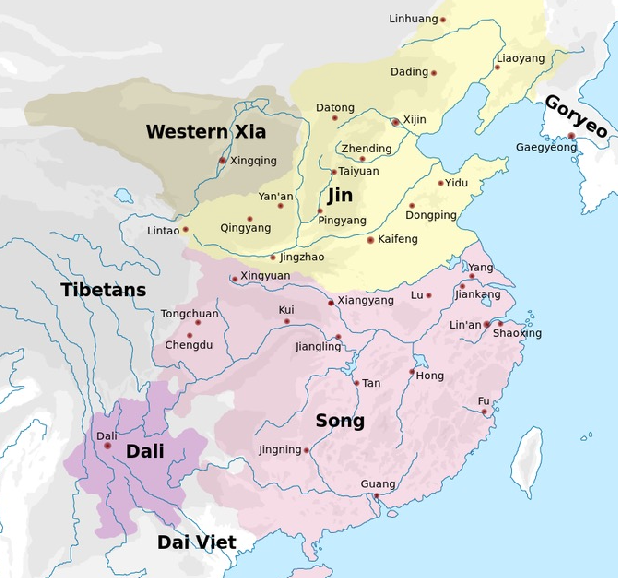
so a lot Jurchan spoke Chinese, dress Chinese, like Northern Wei
-
in total, Song at this point had to sign treaties including:
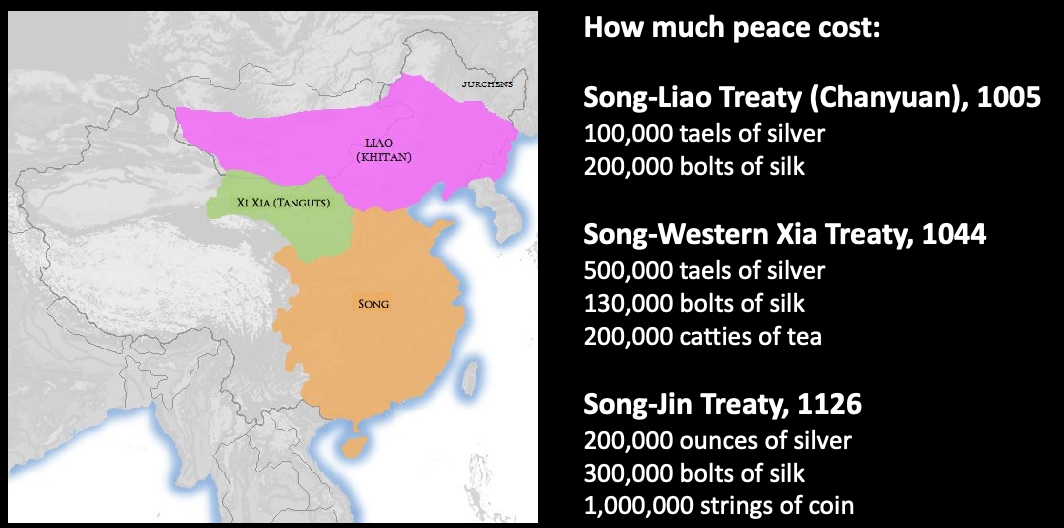
but was actually not a big burden, as they did not exceed 2% of state avenue, because Song’s modernization and is rich. However, most went to pay for military, which took up $3/4$ of the revenue for just maintaining the army.
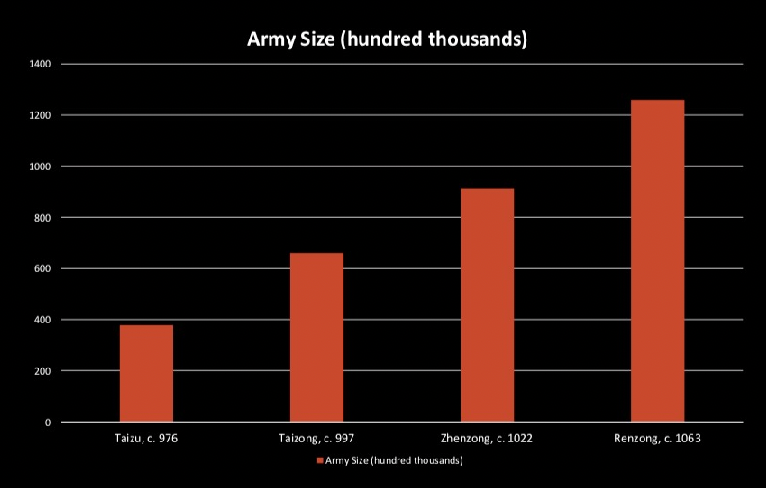
Essentials of Military Classics (Wujing Zongyao 武經總要)
-
commissioned by Song emperor and had instructions for a broad range of weapons
Siege Ladders Triple Crossbow 
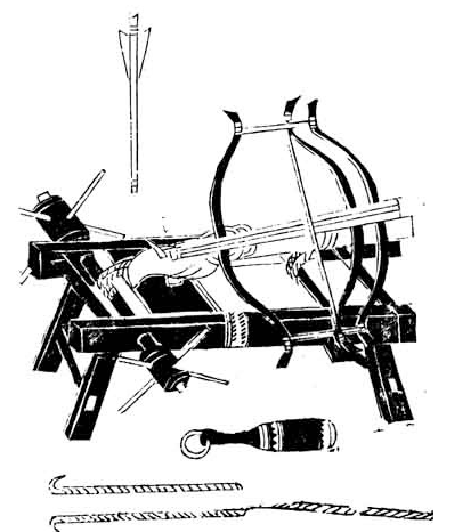
even though Song had advancements in military and spent a lot on its army, it did not conquer their lost territories back:
- Jurchan are sinicized anyway, and payment for peace was cheap
- however, you still need to keep a strong army in case of future infringement
-
this book also recorded the invention/production of gunpowder, which was found from Daoist alchemy accidentally
-
but even with those, it didn’t give much advantages because artisans are captured by enemies. e.g. those siege machines are also employed by Jurchen
Neo-Confucianism: in response to Chinese cultural identity crisis at borders
- “It was perverse for Chinese to forget their ancestors and abandon sacrifices to them, serving instead barbarian ghosts.” —Shi Jie ⽯介
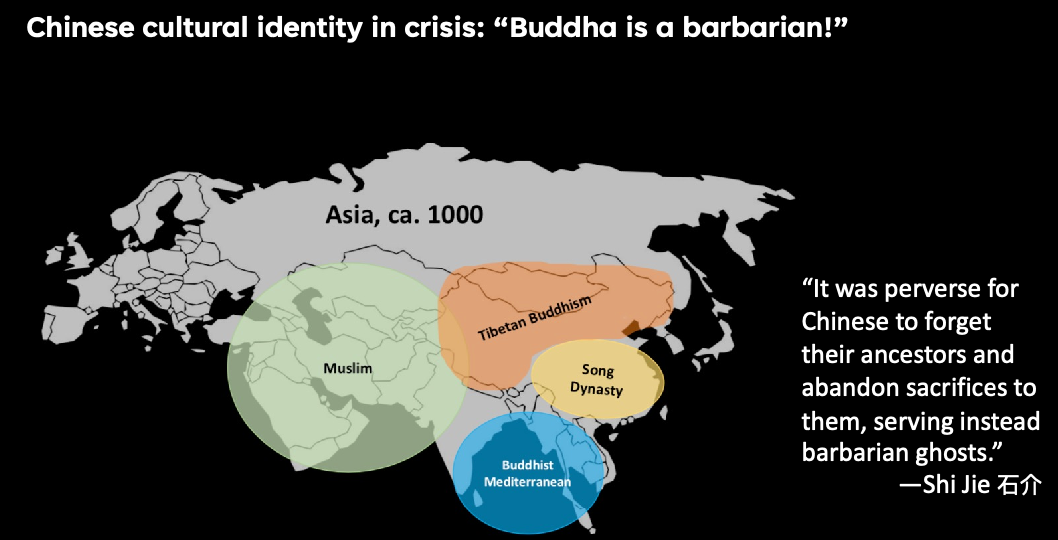
-
Buddhism was already in 1000 years, but now they start to reject the religion as it is not indigenous and practiced by their enemies
-
recall in Tang times Buddhism was wide spread. But in Song, due to changes of international politics, such as the Khitan Liao and Tanguts are buddhists, Song scholars thought of Buddhism as religion of enemy
-
story about Cai Wenji who lived in Han but abducted by Xiongnu, to show the barbarian culture of the northern people as compared ot Chinese architectures
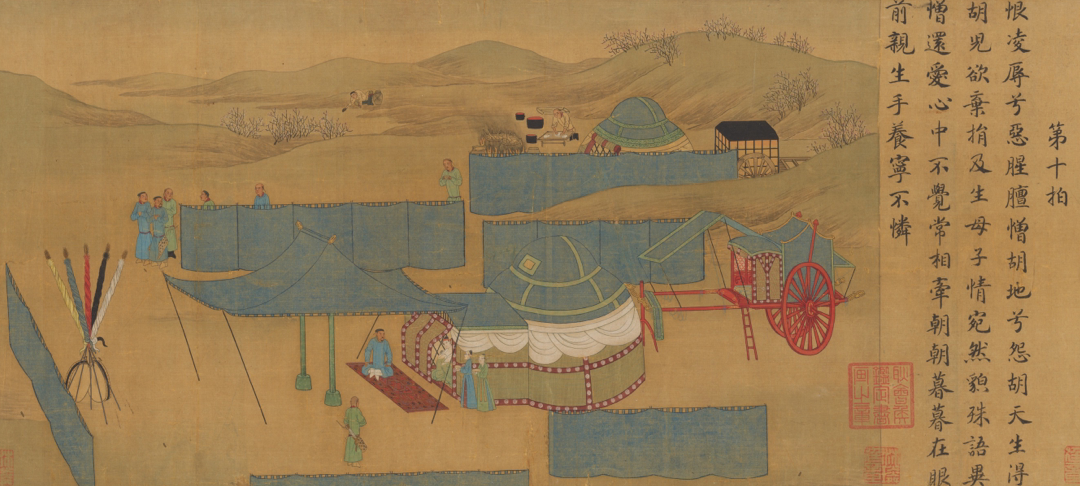
however, notice that here they are dressing in Khitan = used as a symbol of foreignness = barbarianism of their northern enemies
-
-
late Song had a lots of problem: big armies taking much expenditures, officials not selected properly, and taxes not collected properly $\to$ scholars believe that everything needs reform
-
but unlike Wang Anshi’s new policy, Song scholars aims to revitalize in Confucianism $\to$ Neo-Confucianism
|
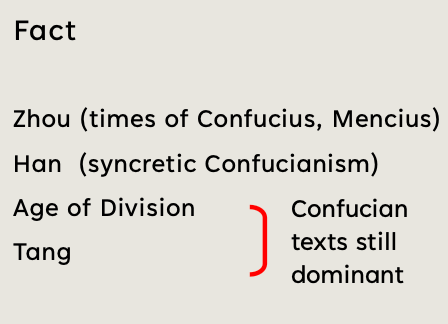 |
| 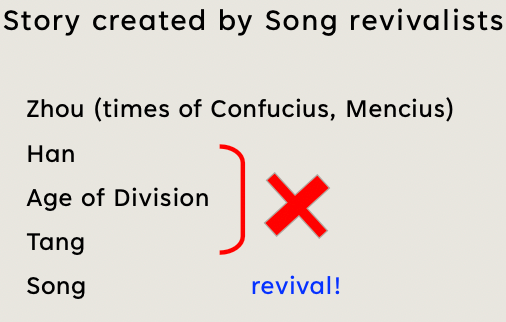 |
| :———————————————————-: | :———————————————————-: |
|
| :———————————————————-: | :———————————————————-: |-
even during Age of Division and Tang when there are a lot of Buddhist, Confucianism technically is still used as texts for exams
-
but those scholars dismissed them and said Confucianism is lost since after Zhou, that it was all about Buddhism and Taoism. Hence they considered themselves as revivalists = reinterpret the traditional Confucianism core = becomes a dominant idea among Song intellectual
-
-
-
Zhu Xi (as a representative and consolidator) for Neo-Confucianism
-
Buddhism had life cycles, and hence Confucian also had Metaphysics about li 理 (principle) and qi (vital energy)
- believes that nothing can exist without li
-
used the two concepts to explain human’s good nature. Humans born with good li but qi is impure = hence people do bad things
- sages had perfect qi, so people needs to work on this
-
Zhu Xi’s take is that li is more important $\to$ how do you investigate things
- rigorous study to probe li in things
- your methods of study should include nurture reverence + pursue knowledge
-
the ultimate goal is self-cultivation, which is believed to lead to harmonious society (if everyone does it). But how to cultivate it?
- Zhu Xi’s idea is to investigate things, hence his school = *Li Xue* = a mainstream Neo-Classical school
-
since Zhu Xi believed one needs to study, he helped establish private academies = rise of private schooling for transmitting new ideas
- also wrote Commentaries on Analects, which is later made an official text in 1241 until 1905
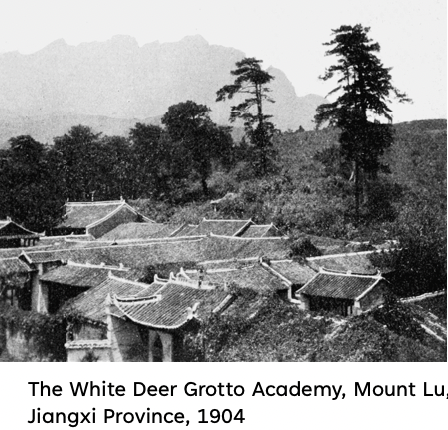
-
since Zhu Xi wanted to revive, he called himself Daoxue or Lixue, they don’t called themselves Neo-Confucianism
-
-
even though those new thoughts is a response of the time of crisis to attack Buddhism or Taoism, but they are not immune to their influence,
- e.g. still use Buddhist practices such as medication and adopted Buddhist terms in Neo-Confucianism
- i.e. has a lot of elements drawn from them
Song Women’s Status
- pretty complicated
- commodification of women, selling daughters gives farmers a ton of money, to be prostitutes
- foot-binding, which started in the sing-song class, but eventually expanded throughout = small foot had sexual allure for men
- but women can also use that to their advantages, and some had autonomy, such as in the reading that some women had words that judges listen to
- foot binding in Song. women having small feet-only seen by herself and husband (264)
- correlates with the growth of Song’s commercialization, and that families sell daughters + people kidnap women
- women transformed into commodities who were bought and sold on the basis of appearance
- women of good families compete with women with bound feet, hence 卷起来了
Midterm
- three main parts
- Identifications of people, places, key concepts
- e.g. equal field system
- a list will be given out, also explain the historical importance of this key term
- short answer questions
- explain the deeper meaning/significance of a passage
- e.g. a paragraph long
- one long essay
- e.g. half of the test
- e.g. interaction with steppe normadic culture, e.g. explain shi class in warring states and implications in later dynasties
- e.g. bidirectional influences between stuff
- like three to fourth paragraphs, and you need to provide a structured, argument-based response
Yuan Dynasty (1271 - 1368)
Yuan was a Mongol-led imperial dynasty of China and a successor state to the Mongol Empire after its division. It was established by Kublai (Emperor Shizu), leader of the Borjigin clan, and lasted from 1271 to 1368.
- Although Genghis Khan had been enthroned with the Han-style title of Emperor in 1206 and the Mongol Empire had ruled territories including modern-day northern China for decades, it was not until 1271 that Kublai Khan officially proclaimed the dynasty in the traditional Han style
- Genghis Khan = Chinggis Khan later in text
- Kublai’s conquest was not complete until 1279 when the Southern Song dynasty was defeated in the Battle of Yamen. His realm was, by this point, isolated from the other Mongol-led khanates and controlled most of modern-day China and its surrounding areas, including modern-day Mongolia.
- Mongol rule was cosmopolitan under Kublai Khan. He welcomed foreign visitors to his court, such as the Venetian merchant Marco Polo, who wrote the most influential European account of Yuan China
- In 1368, following the defeat of the Yuan forces by the Ming dynasty, the Genghisid rulers retreated to the Mongolian Plateau and continued to rule until 1635 when they surrendered to the Later Jin dynasty (which later evolved into the Qing dynasty).
How did the Mongols managed to conquer all China during Yuan?
- they didn’t have literati, didn’t have language, didn’t have permanent houses
Raising Warriors: especially women warriors
- can reveal Mongols political, cultural and social priorities
- Eurasian steppe: resource scare, nature is volatile, human is small compared to nature
- generating only a minimal surplus, and internal disputes arises due to resource scarcity
- therefore perpetual uncertainty, hard on both women and man, little time on inequality
- nomad = group is prized more important than individual survival = young children were taught a universal skill set
- has highly non-gendered training, e.g. horsemanship, women and men equal competence
- herd and hunt typically taught by mothers, e.g. Chinggis Khan’s mother
- learned bravery during hunt = bravery in battle
- horsemanship, bravery, shooting skills for all
- e.g. Alaqa Beki, a women leader of large army
Groups Win Wars: prizing group advantages
-
military tactics through surprise, ambush. Hence also requires soldiers strong in acrobatic skills
-
caracole tactic:
- horses are faster in group
- shoot at 40-50m = general kill zone, so every warrior can contribute to the arrows
-
feigned retreat

- appear to be overwhelmed and flee, to lure enemies to ambush location
Climatic Changes
- 15 year Pluvials (increased rainfall=wet) climatic favored Mongol
- to being able to support a record-holding amount of animals (e.g. horses) due to biomass flourishing. So many perhaps more than the rest of the horse in the world combined
- zero foot-soldiers, or supply chain, but each horseman have 4-5 well-trained horses
- those horses would respond to the unique whistle of the owner
- soldiers can sleep on their horses
- place their meat underneath saddle
- can also train blood from horses as calorie intake if needed
Semi-private/public Ger
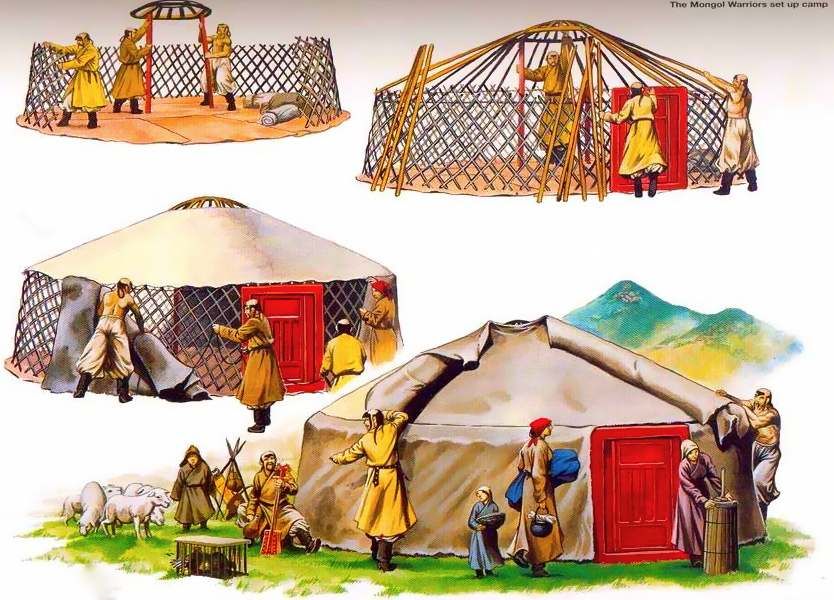
- Ger is a single room structure (tent)
- often entire family lives in a single Ger. This means sometimes many people all into 100 sqrft space, for both women, men, and kids
- hence also little room for inequality
- Ger is Mongol’s only structure shielding from nature
- place for everything, all resources
- technically owned by the female
Buying Loyalty
- Chinggis dissolved conquered population to create a structure for him as head of power
- then perform military integration = some of them become part of the army
- each person loyal to their direct superior, and is recursive until the top, which is Chinggis
- so ultimately each gifted population (along with their stuff) is still owned by Chinggis
- those owners then need to populate the armies
- so source of income is plunder or tribute
Women in Mongols’ Political Sphere
- chiggis wealth transfer to the youngest child
- not only were women are entitled to power, men also believed in their power
- women power has nothing to do with proximal relationship with men, as in early China (e.g. Zhou dynasty)
- women in general (including Chinese) enjoyed a more fairer status:
- mongol named a women Yang Miaozhen (successful and fearful leader of army) to the position of provincial governor - probably the highest power ever to be held by a civilian women in imperial China
- women has power in conducting family affairs (334-336). e.g. Zhao’s wife, Guan Daosheng, has a commanding role in household management
Extreme Violence Saves Lives
- e.g. Persia killed Mongol’s envoys, so Mongol went on to decimate them
- believed violence during warfare is a necessity, so they wanted to spread their image of violence
- so a town under their attack can
- surrender and pay tribute (survive)
- not useful become slaughtered (decimated)
- the useful, such as artisans were saved to improve techniques. Or a few terrified were allowed to flee and spread this terror (survive)
- mongol invasion in south is slow
- instead of plunder/kill farmers, tax them was proposed
Mongol Ruling China
-
The Yuan dynasty created a "Han Army" (漢軍) out of defected Jin troops and an army of defected Song troops called the “Newly Submitted Army” (新附軍).
- as many women (still physically strong) start to shift more to political poewr
- initially 30% are Mongol women in army, but now forces are not even many Mongols
- Kublai wanted to also focus on governing in China
- eventually adopting alternating policies favoring their own steppe culture and sedentary culture of the vast population of Chinese
- no evidence that Kublai converted to Buddhism, nor Confucianism
- only a rudimentary knowledge of Chinese, hence certainly not Confucianism
- sensitive not to rely on Chinese, but military ones in western/central asia
- suspended the examination system = no group can challenge Mongols
- only later emperor Ayurbarwada restored the civil exam system due to his tutor teaching Confucius and he liked it
- Kublai considered South Chinese the least trust worthy group, hence at the bottom of four divisions
- Specifically, the four classes of people by the descending order were Mongolian people, Semu people, Han people (in the northern areas of China) and Southern Chinese (people of the former Northern Song Dynasty)
- perhaps because Southern Chinese are the latest to be conquered
- prioritize economic growth, some
- Kublai nevertheless sought to keep good relation to both Chinese and Mongols
- as ruler for Mongol sought to preserve martial values, and having mongol women as concubines
- as ruler for Chinese, established capital in China and subsidized Chinese art
- in reality, even only for 100 years it is still hard to both rule sedentary China and steppe Mongol.
Fall of Yuan
- However, eventually depopulation in China and increasing stress on people caused rebellion
- Kublai launched huge campaign using sedentary Chinese are army = many died
- increasing amount of burden + natural disasters (drought) + ineffective government policies inflicted struggle, famine in people
Ming Dynasty (1368 - 1644)
Previously on the Mongols and the Yuan (from Chinese perspective)
- Tribal confederations became a major threat
- Throughout the period of the Southern Song (1127-1279) Mongol confederation under Genghis Khan gaining strength in the north.
- Mongols being effective in warfare, e.g. brutality
- embrace new war technologies from captured artisans
- migration possibly encouraged by climate changes
- high productivity of horses, on average each mongol solider has 3-5 horses
- Eurasian steppe nature, hence a small population = lose control when large territory
- i.e. problem of minority rule: assimilation v.s. their elite identity also needed to be balanced
- Mongol’s nomadic culture + small population = both women and men trained equally
- no need a supply chain, just plunder and adopt technology
- but also had succession crises
- Kublai Khan defeats Southern Song and established Yuan dynasty
- first non-Chinese who rule the entire China both north and south
- divided people into 4 ethnic group and favored non-Chinese = arise Chinese ethnic consciousness and desire to regain China = eventually lead to Chinese rebellions = downfall of Yuan
- recall that they were military strong in horseback but as the creation Han Army and Newly Submitted Army made many mongols become sedentary + a much smaller population, it becomes hard for them to hold the vast population of Chinese
- Yuan was overall political unstable but flourishing time for culture
- e.g. Yuan drama, literature, blue and white porcelain
Ming Autocracy
The strangeness of Early Ming: despotism and an agrarian vision of economy and society
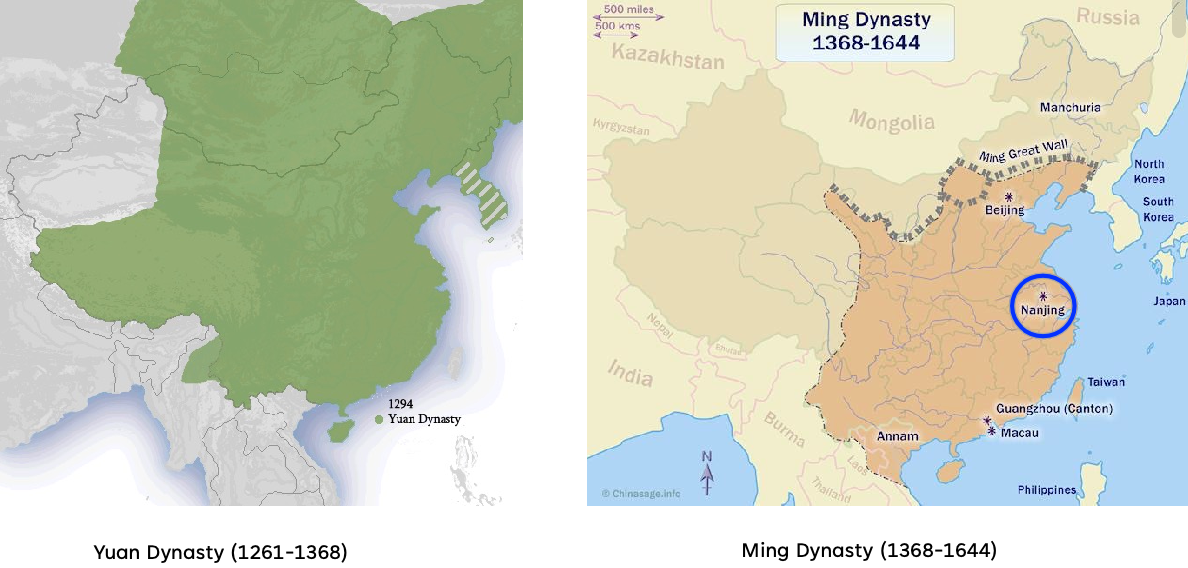
-
smaller than Yuan as Mongolia is not in Ming’s control, and captial at Nanjing (capital during Six dynasties)
- rule both north and south from a southern city for the first time
-
Founder Zhu Yuanzhang朱元璋, with reign title Hongwu (1368-1398)
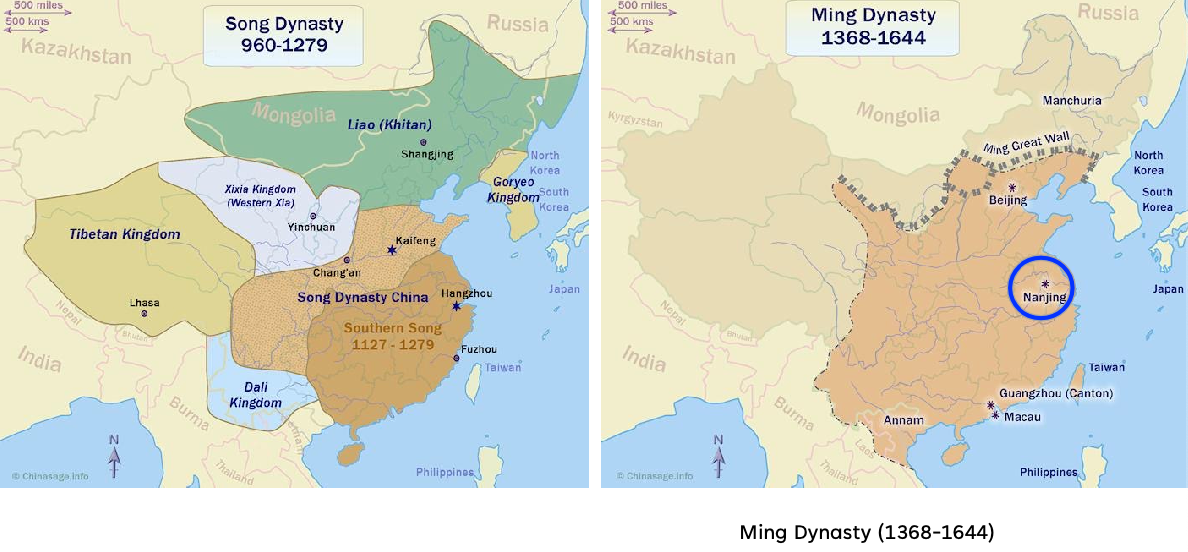
- Hongwu reign year 1 to represent 1368
- reign title chosen by himself, because of his military achievement: Ming has expanded and included corridor area in north and sixteen prefectures (later Beijing become capital under YongLe)
-
An extraordinary life experience of Zhu Yuanzhang
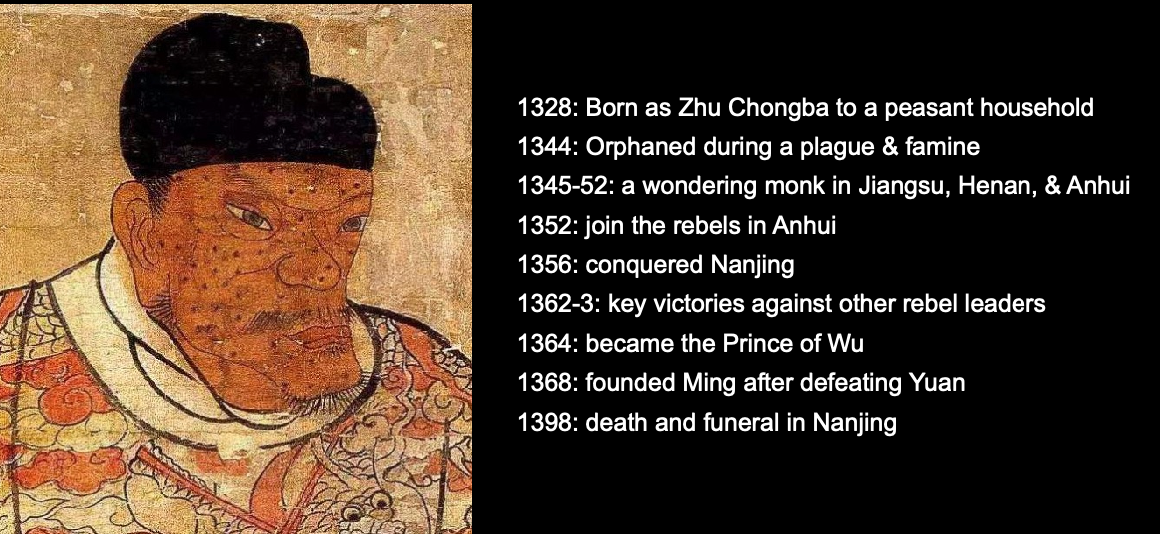
- parents were poor, and was a wondering monk for several years
- Mongols burnt down the monasteries, and he joined rebels
- commoner to become an emperor since Liu Bang
-
part of his experience in his own words (explains why he shaped a conservative vision as government/weird early Ming)
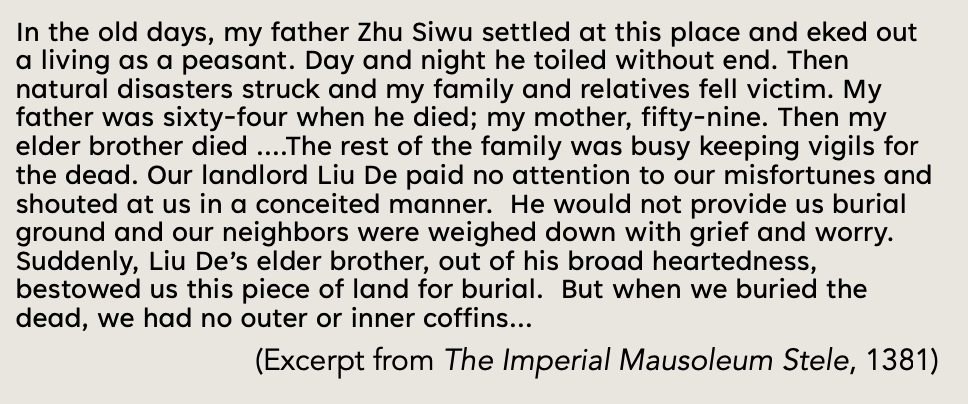
he claimed to “restore S. Song style”, but kept many Yuan policies (conservatives)
-
emperor to bureaucracy below him is much more hierarchical/autocratic, and strong personal subordination to emperor
- did not hesitate to have officials beaten openly = very despotic
- became a regular mean to punish officials: rarely used in Tang, but Mongol did use it frequently
-
paranoid for treason: frequent execution of officials
- great purges: zero toleration of corruption and disloyalty. Executed over 30,000 victims
- didn’t trust prime ministers, made himself the chief director for large and small matters and removed “Great Chancellor” as a rank
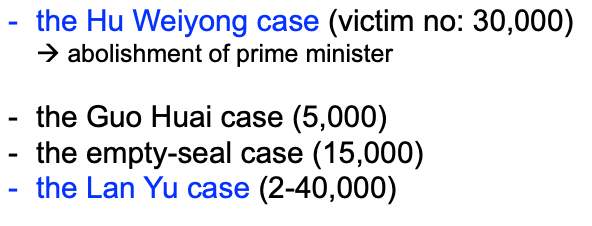
for example, the first and fourth is due to (he believes is) disloyalty, and the 2nd and 3rd for corruption.
-
-
emperors are now complete autocrat. related to Mongol’s style,
- comparison of the past: officials were somewhat confident and powerful in decision making
- In Tang they sat in chairs, in Song not required to kneel (also vowed not to execute officials even bad news/disagreement). But in Ming, a lot more autocratic
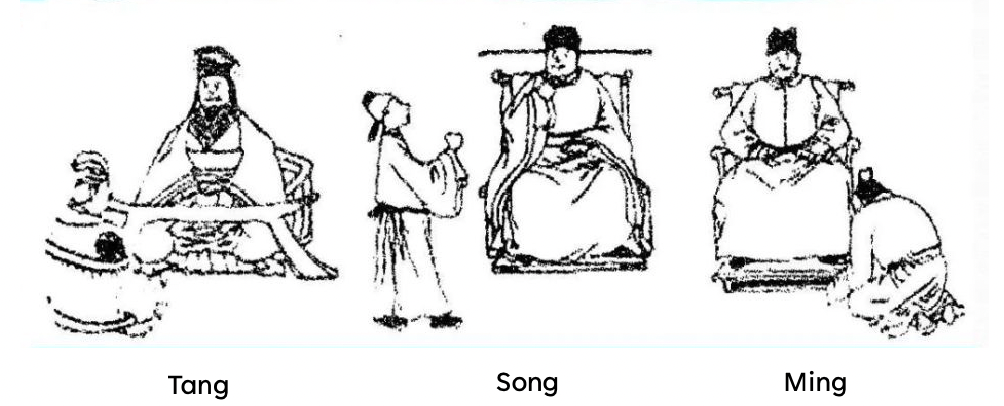
Despotism: new government structure
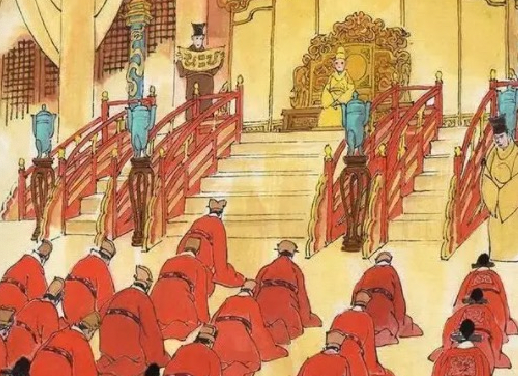
-
this despotism in emperor dominating over bureaucracy is highly related/originated by
- decline of hereditary aristocracy since Huang Chao rebellion = recruit based on merit/little family influence = earlier those aristocrat families are well venerated and hence easily exerts strong influence even in court
- the rise of civil service exam and the above = aristocrat “class” are flexible, can hardly create equal influence
- the only special case is during Song, when emperor explicitly said not to execute scholars if bad news/disagreements hence those recruited by merit base can have influence
-
his peasant background also made him have dislikes of anti-intellectuals
- though Emperor Zhu Yuanzhang did not have civil system for a decade but eventually needed help = depended on them, so a power balance is subtle
-
since Tang to Yuan, government structure were somewhat similar. But in Ming
Tang and Song Ming 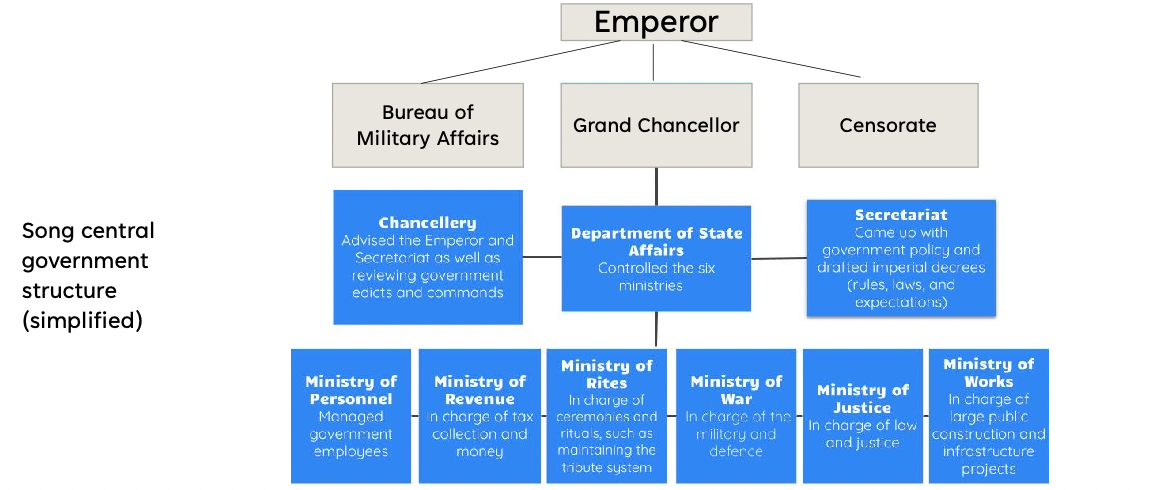
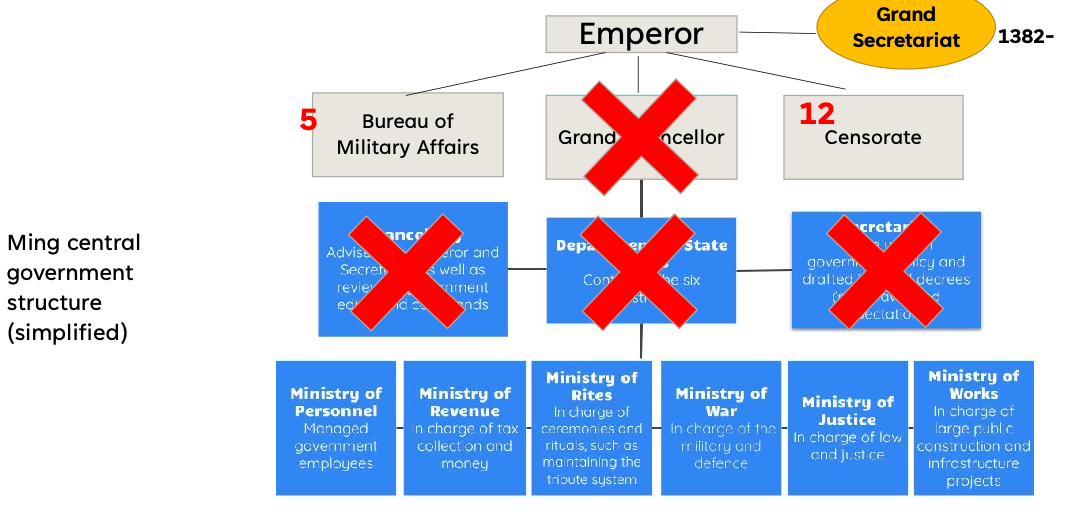
- before, grand chancellor (developed in Song, e.g. Wang Anshi) have a high degree of influence in decision making, but now is removed
- strong centralization of authority in the throne
- abolished Grand Chancellor = Prime Minister
- military bureau divided into 5, and censorate into 12. In total 23 ministries directly reported to Emperor
- grand secretariat = mid level officials = good at writings as helpers
- after Zhu Yuanzhang, they gain power and even reject emperor’s decisions in the long run = basically functioning as prime minister
- this induced a large workload for emperor, and seem only possible with Zhu Yuanzhang
Social reorganization at the local level
-
Zhu Yuanzhang liked rural areas as being less corrupt and simple + close community of farmers
- very different in Song time’s commercialized farmers
-
therefore, developed an ideal economical life being “rural”
- aimed for rural self-sufficiency
- developed the Lijia 里甲 system (+ registration system for direct control of people, like Qin period)
- developed the “Sacred Edict of Six Maxims” (for spreading Confucius teachings)
-
Lijia (hundred-and-tithing): village registration system
- assign people with land and get taxes as well. so that
- 10 households = 1 jia, and 10 jia = 1 li. Hence 100 households per li
- additional 10 wealthy ones in charge of managing hence 110 households
- the idea of self-supervision + direct report to emperor was raised by Shangyang in Qin
- registering households as done similarly by Mongol, which
- origins as early as Qin (which was for recruiting military).
- In Song, Wang Anshi also employed a a similar policy for governmental interference in economy
- but Zhu Yuanzhang wanted this more for control of people (the book yellow registers)
- effectively transfer govern responsibility to local community. Emphasized community self-management including tax-collecting, transportation, judicial, police services, etc.
- intent is a small government as peasants manage themselves = no need for high tax as well
- assign people with land and get taxes as well. so that
-
he also uses Lijia to teach people about the laws and Confucianism
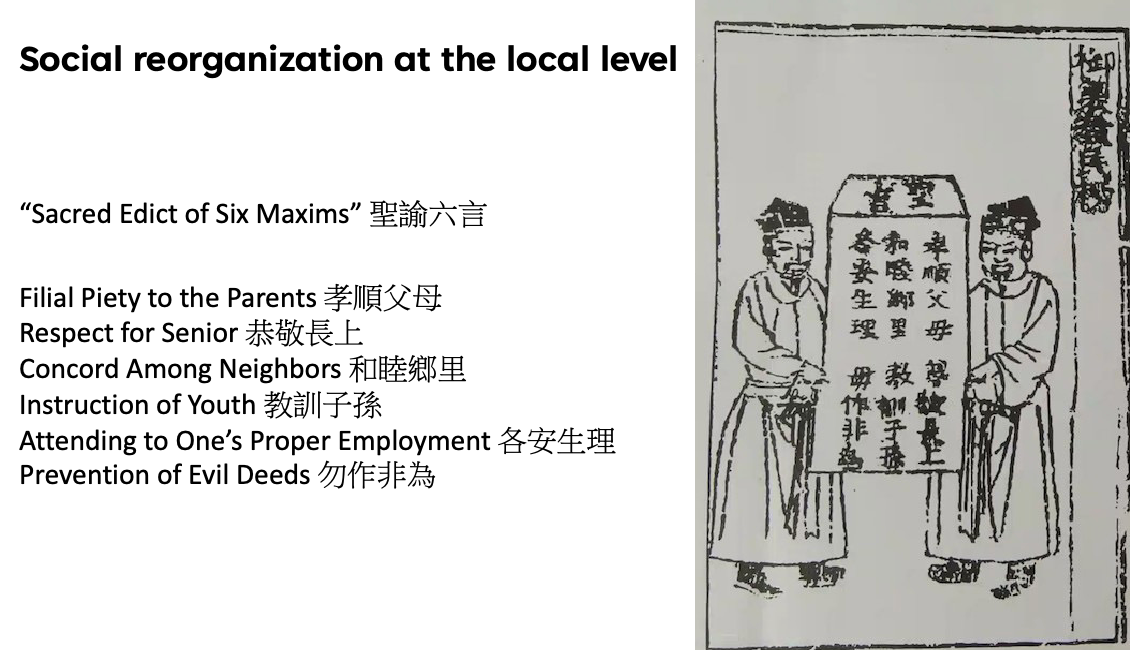
- “sacred edict” read aloud regularly, people urged to behave with Confucian values such as Filial Piety
- very effective mean of imbuing people (including illiterate) with Confucius values
Four Categories of People
-
Mongol had this division: 1) Mongol; 2) Semu = colored-eye people, from west/central Asia; 3) Northern Chinese; 4) Southern. Reveals how much Mongol confederation trusted each group

-
in Ming, he also categorized peopled base on occupation SPAM
- but later this doesn't work for economy, and broke down with high commericialization later
- attempted to demarcate social boundaries, e.g. merchants, farmers, must do different things. But since Song, people are highly dynamic, as in commercialization, many specialization and trading/work across occupations. So that was a failure of his policies
-
recall that exams during Yuan was hard, so a lot of scholars changed direction and went to medicine
- of course, getting a degree is still valuable, but as more and more people receive education and exam even more intense, a lot of novel occupations/diversified future of scholars
- but still, Southern literati elites regardless held immense influence in local society = localist turn (started in Southern Song). e.g. story of cruel family getting hold of the entire local community
- before, passing the exam = route for wealth, status and fame. But now they realize this is not the only route and can exert influence on a local level. (which is very related to neo-Confucianism - build society from local level) = establishment of local roots
- for them, civil exam is now just among the many exams, but just sitting for the exam still gives status.
- so south weathered the Mongol invasion much better than the north thanks to their established local roots = as they anyway didn’t rely on the civil exam to get wealth = your life stays hereditary
-
again, even as merchants at the bottom category, they are often the wealthiest, e.g. Shen Wansan (a merchant)
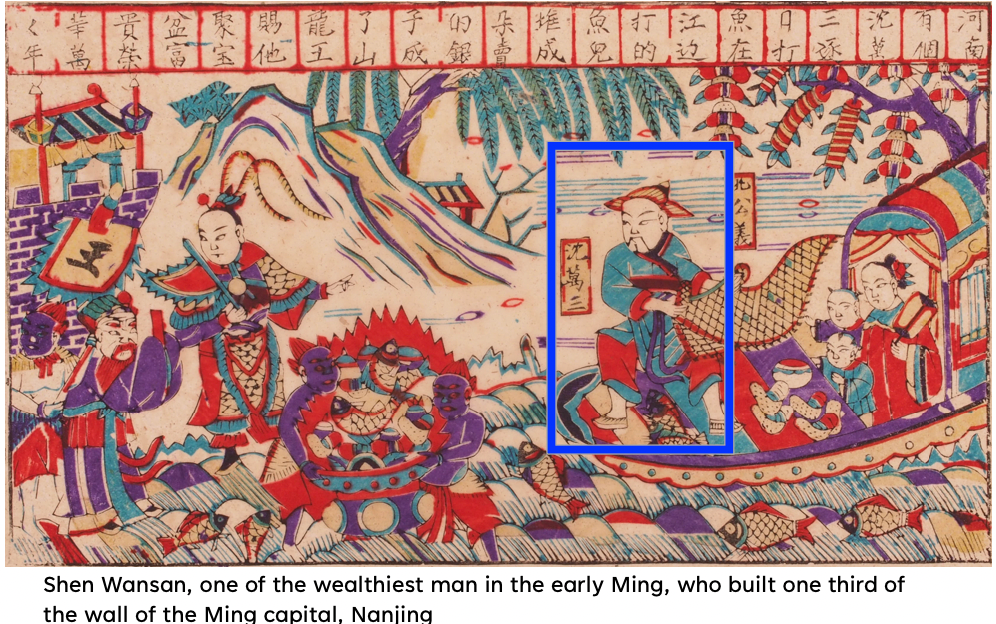
since education requires money, they are at an advantage: merchant can infiltrate by marriage into gentry (shidafu) family, or just adopt their sons
Zhu Yuanzhang’s successors
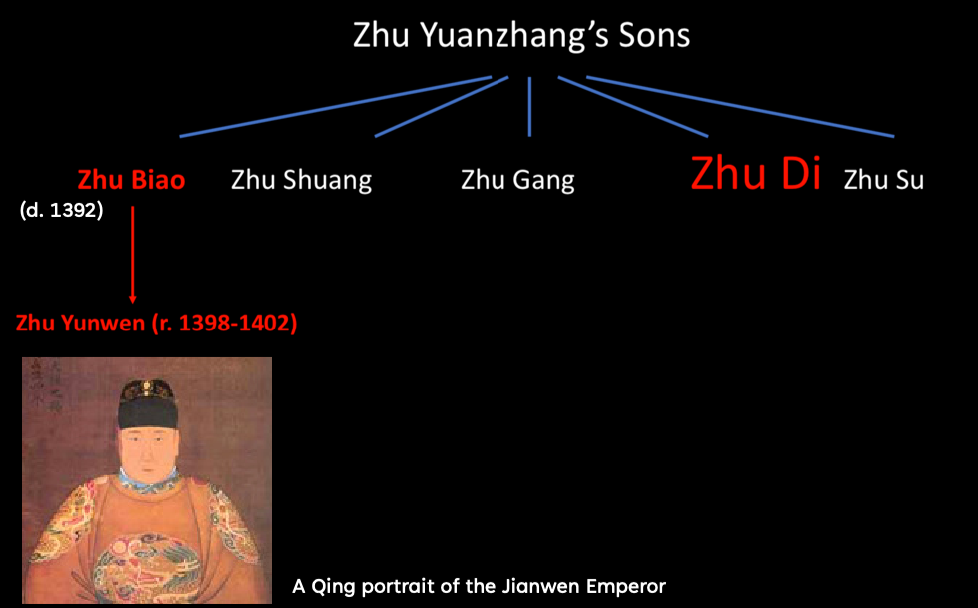
-
succession crisis after death. The correct line of succession should be Zhu Yunwen, but Zhu Di = his uncle got it (hence seen as “illegitimate”)
-
Zhu Di gives himself the reign title Yongle, and did several important things
-
one major change is Nanjing being demoted to secondary captial and Beijing becomes capital

- he felt insecure in the south (as he is an illegitimate ruler), and his generals are all from northern areas
- demographically it is strategically important to protect central plain from north but not safe
- it is also not very developed yet, so resources needed to shift from Nanjing/the south
- but Beijing became the capital for the rest of the 7 centuries until today
-
Yong Le’s achievements
-
be ready for the Mongol: rebuilt sections of great wall, and grand canal for transportation, expanded military
- successive dynasties built and maintained multiple stretches of border walls. The best-known sections of the wall were built by the Ming dynasty
-
his palace at Beijing = the Purple Forbidden City
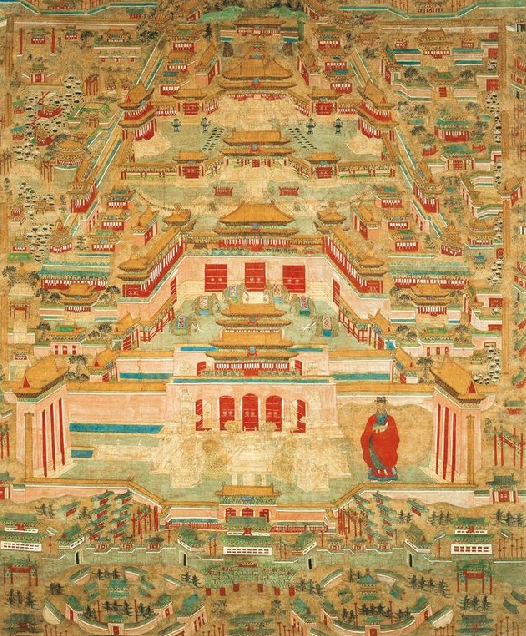
-
also extensive maritime voyages: Zheng He
-
sponcered a lot of Buddhism, but unclear if he is loyal to Buddhism as sometimes he pursues as Daoist. Perhaps as a tool to establish trust in his subjects
- but did forge a strong relationship with Tibet
-
-
Yong Le’s sponser of Zheng He’s voyage
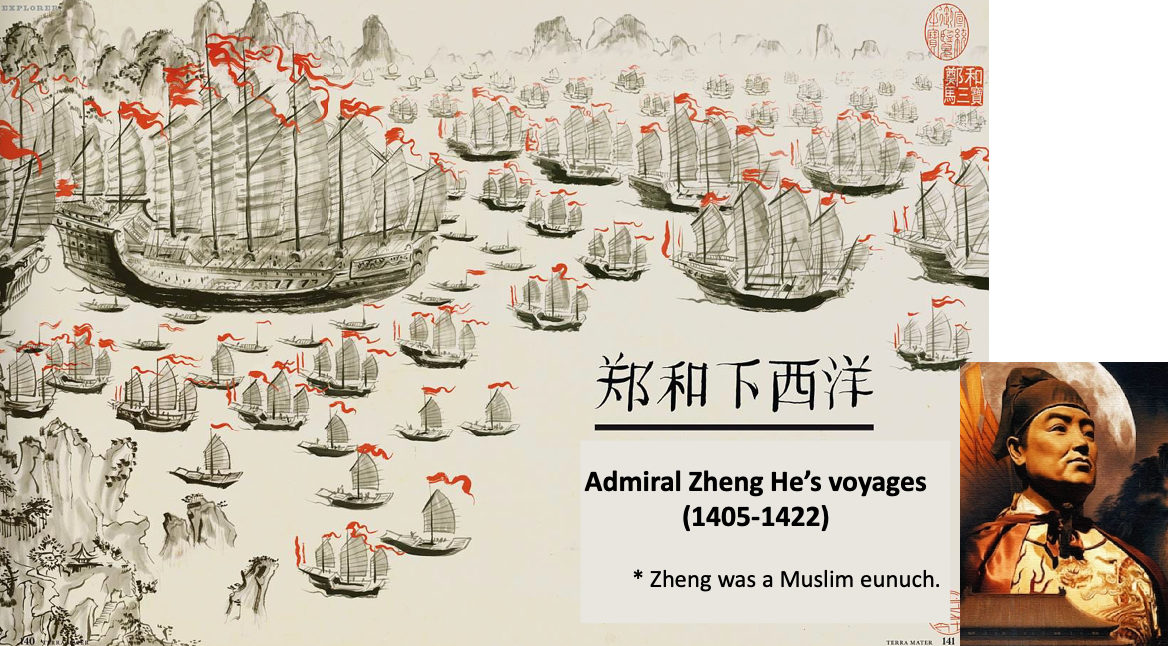
- the aim was to mask his illegitimacy of ruling (as an uncle took power from the direct grandson of emperor), by announcing to the maritime world that he is emperor
- therefore, voyage was for diplomatic reasons
Admiral Zheng He
-
the mission was diplomatic: to all tributary states that Yong Le is now the emperor. Hence Zheng He also had military force brought along
-
as a by product of the voyage
- enlarged trading routes
- furthered Ming’s tribute system (see next subsection)
-
brought back some exotic info/products, e.g. giraffe is named as 麒麟

-
some of Zheng He’s fleets routes
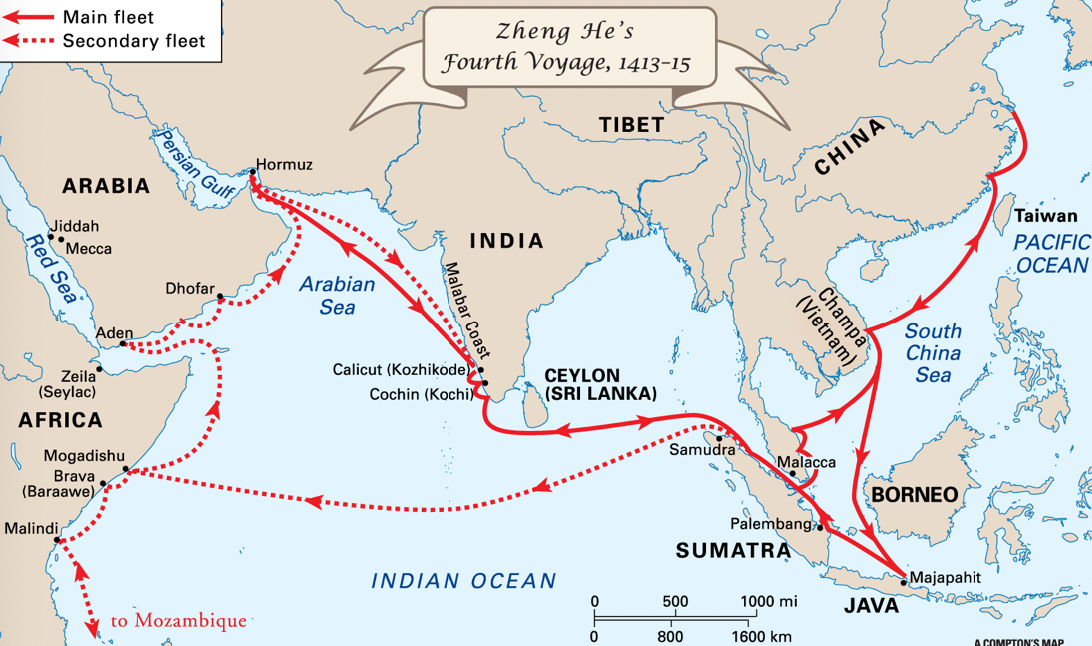
The Tribute System
- was a old system. Two mechanisms of Chinese regimes’ relationships with foreign states: tribute and trade.
- the system:
- foreign rulers to send embassies to China bearing tribute in the form of local exotica
- emperor in turn gives gifts of equal or greater value; bestowed titles on tributary rulers; and permitted a controlled volume of trade
- as it is mutually beneficial:
- a device for mutual recognition, and to establish political and cultural prestige of China internationally
- more trade opportunities
- in most times both parties are happy
End of Yongle Fleets: only YongLe emperor promoted maritime trade/voyage
- expeditions cost a lot of money: in 1424, Yongle died, and new court considered the expeditions as wasteful expenditures that did not benefit the people’s welfare.
- eventually people switched focus to their northern land: shifted policy to focus on northern steppe enemies
- 1449 Tumu disaster: Mongol Oirats capture the boy emperor and threaten Beijing—this marks permanent shift in foreign policy away from the sea and towards the steppe.
- hence this end also signals the ended the state-sponsored sea voyages and foreign contacts/trade overseas. Instead of maritime trade, a lot became used for defending
Ming and the Global Economy
Previously on early Ming
- Hongwu (1368-98): autocracy and inheritance of Mongol polices + social reorganization (agrarian view)
- autocracy of emperor in court is supported by the decline of aristocracy + rise of civil exam in Song
- social reorganization involves demarcation of people into four classes $\to$ did not work at the end as society often have boundary crossings
- Yongle (1402-24): usurper = deeply concerned of his ruling = moved capital from Nanjing to Beijing
- build the forbidden city in Beijing
- eager to pursue tributary relations with new states = recognize his legitimacy of ruling
- for a similar reason above, sponsored Zheng He’s voyage
- Zheng He’s voyage: massive expedition primarily as a diplomatic tool
- a by-product is to encouraged private maritime trade (commercialization later)
- but costly + enemies in the north made China shift focus
Monetization in mid-Ming: second wave of commercialization after Song dynasty
-
e.g. description of the prosperity and commercialized economy in south
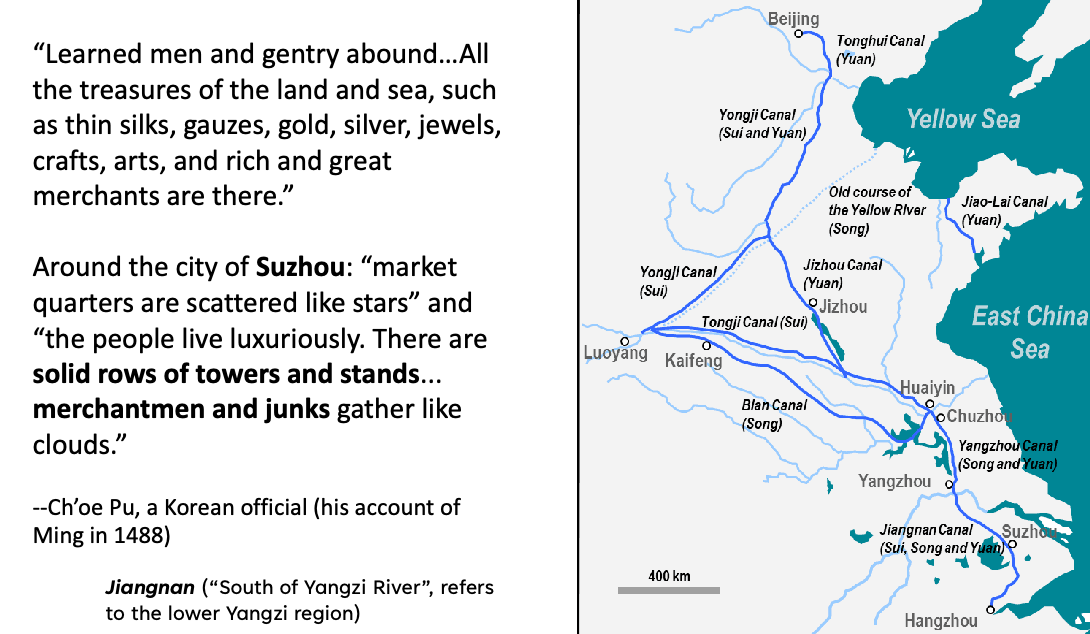
material property + commercialization = non-agrarian society starts to come back again
- Hangzhou was also reasonably prosperous, as previous Song capital
- Jiang'nan = south of Yangzi river = most prosperous region in mid-Ming = lots of records come from this area
-
recall that Lijia 里甲 (hundred-and-tithing): village registration and self- management system + tax system in kind (e.g. rice if produced rice)
- assumption that people stays in the land, and had loopholes = corruptions = less tax collected from wealthy people who try to evade
-
more effective policy to collect tax all in “cash” = Single Whip Reform (1570)
- pushed forward by Grand Secretary Zhang (recall that grand secretary is very powerful in court)
- complete resurvey of all cultivated land (1580) = updated information = can ask all taxes to be paid in copper/silver
- aims to simplify taxation and increase efficiency = very effective later
- 1568-73 Imperial Treasury’s annual deficit: 2-3 million taels of silver
- 1582 The treasury has 4 million taels of silver surplus and grain reserve for a couple of years
- critical to help Ming dynasty to reach its peak
Currency of the Hongwu Reign
-
paper money is issued by the government, but they are printed/produced without backup hence people lost faith in it:
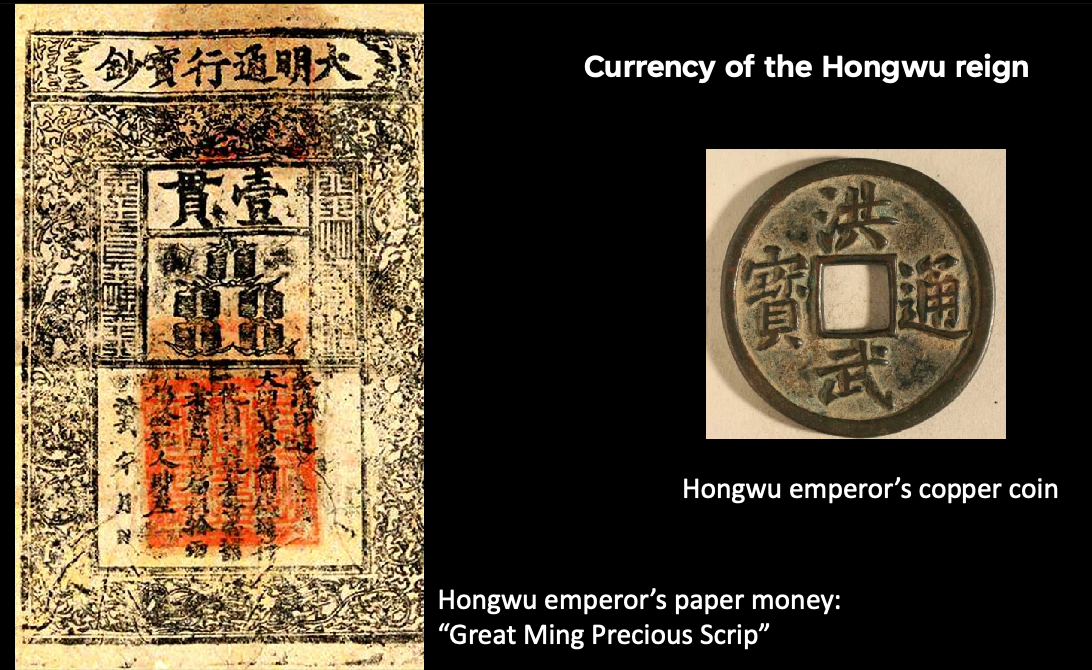
-
for tax: payment needs to be in copper coin/silver
-
people lost faith in paper currency because Zhu Yuanzhang issued paper money without backup $\to$ can use silver to exchange paper money but when asked to exchange from paper money to silver, government cannot issue
-
regardless, government encouraged paper money = wanted to restrict digging silver. But they never succeeded in controlling its currency = ends up relying entirely on copper coin and silver ingot
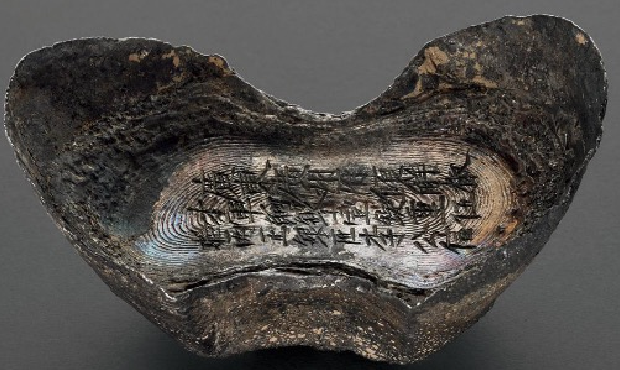
(note that silver ingots are trusted more as copper can regularly debase)
-
-
thirst for silver ingot = encouraged for global trade (foreign countries using silver to trade for valuable Chinese goods)
-
lots of foreign private trade activities from European
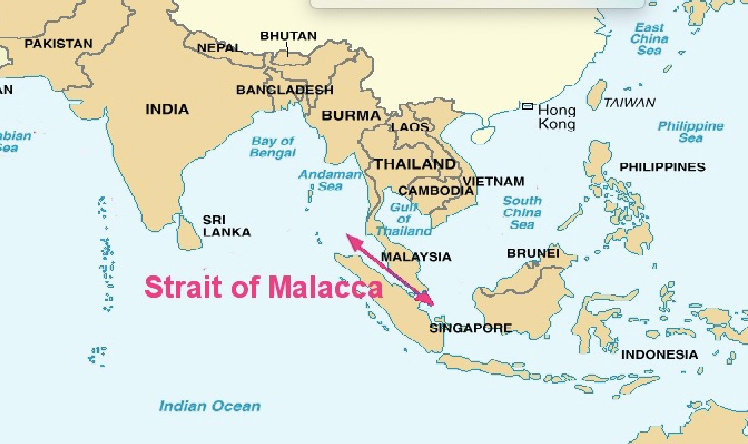
recall that:
-
Ming government did not sponsor maritime trade (opposite in Song’s altitude = took large revenue from maritime commerce)
-
this is perhaps because a) gov charged light tax in commerce b) agrarian view c) private maritime trade tied with piracy = political problems. Hence very suspcious with private trade outside diplomatic reasons
-
-
trade with Portuguese: arrived and found a vigorous trade network in China
-
some maritime traders treat Chinese ships as competitors = kill them and take over their business
|
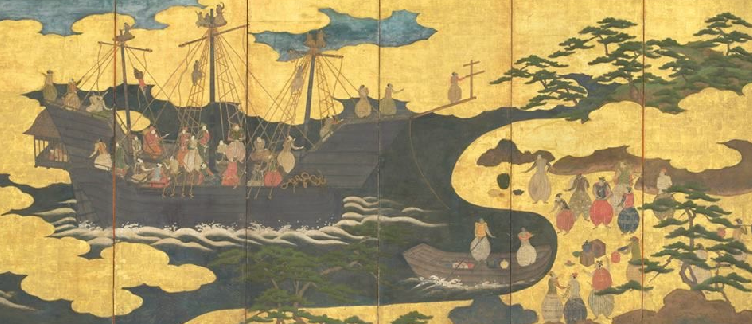 |
| 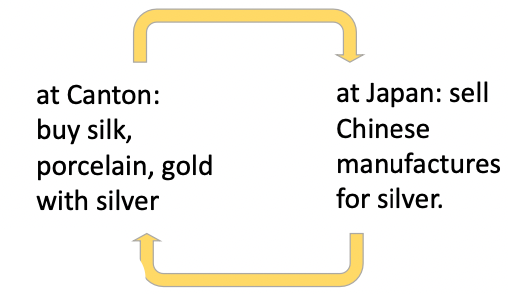 |
| :———————————————————-: | :———————————————————-: |
|
| :———————————————————-: | :———————————————————-: |this caused some problem: where China official did not support trading with Japan due to piracy and suspicions, those Europeans don’t care hence those Chinese goods are illegally leaked to Japan
-
but eventually, local Chinese officials sees trade benefits and defied government decisions = Portuguese conspired with local officials to establish a port in Macao (a backwater at the time) to trade with Canton and Nagasaki
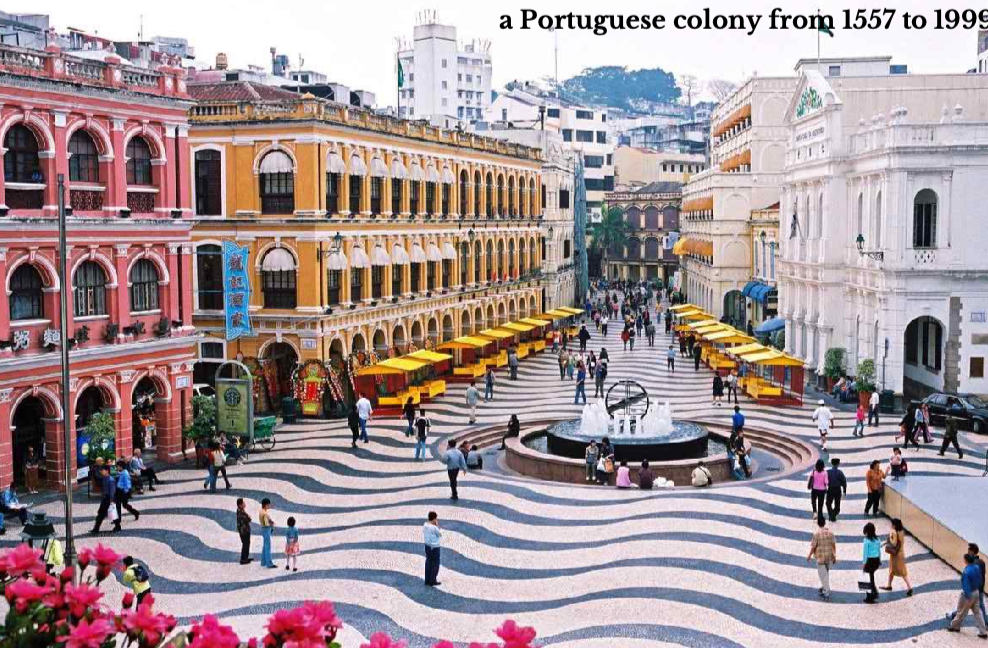
Macao = first and last European colony in China ruled by Portuguese
-
-
-
what goods did European liked from China? some trades included porcelain = Chinese artisans mass produce porcelain specifically for foreign trades:
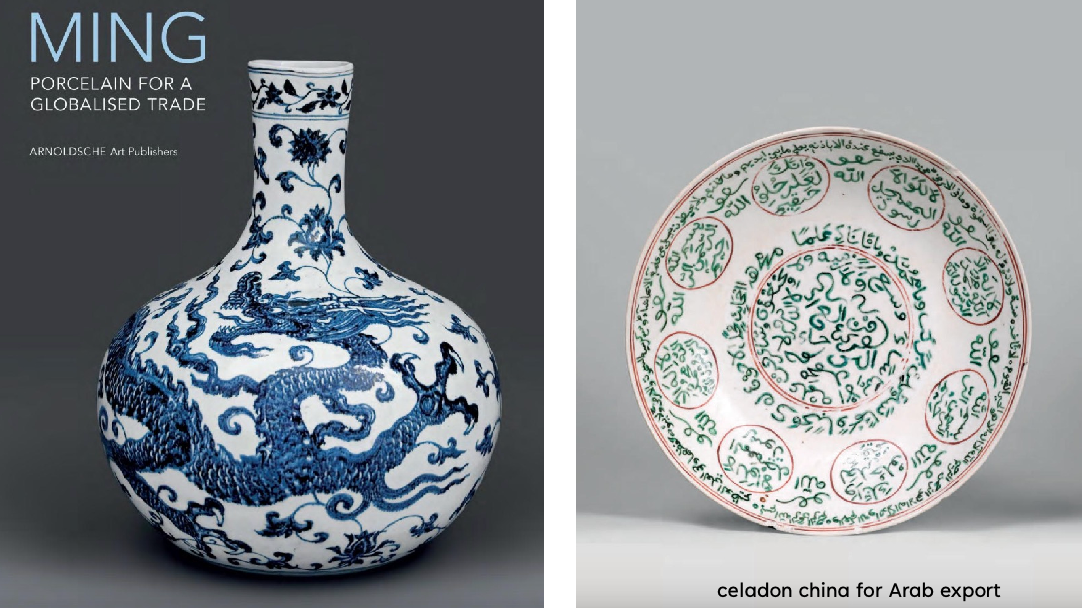
most of exported ones are not best quality, and best ones often reserved for China’s home market
Trading with Spanish and Dutch
-
results of private maritime trades = period when porcelain appearing popular in countries such as Dutch
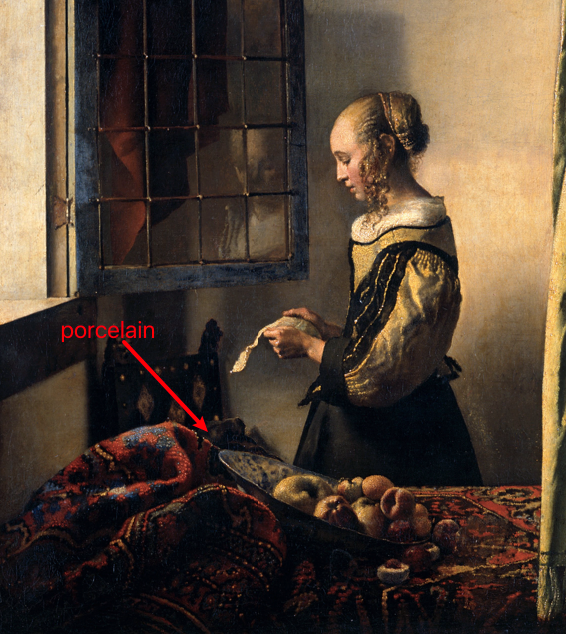
-
both Spanish and Dutch also had high trade interest with China
- early 1570s, the Spanish established a trade port in Manila (Philippines), still far from China.
- in 1623-62, the Dutch East India Company (VOC) occupies fort in northern Taiwan
- note that at that time Taiwan was not under Ming’s control.
- Once colonization by Dutch took place, Chinese went and Taiwan become incorporated into the Qing
-
Spanish found China was silver hungry = traded/provided a lot of silver as they had extraordinary level of silver from mines in its colonies
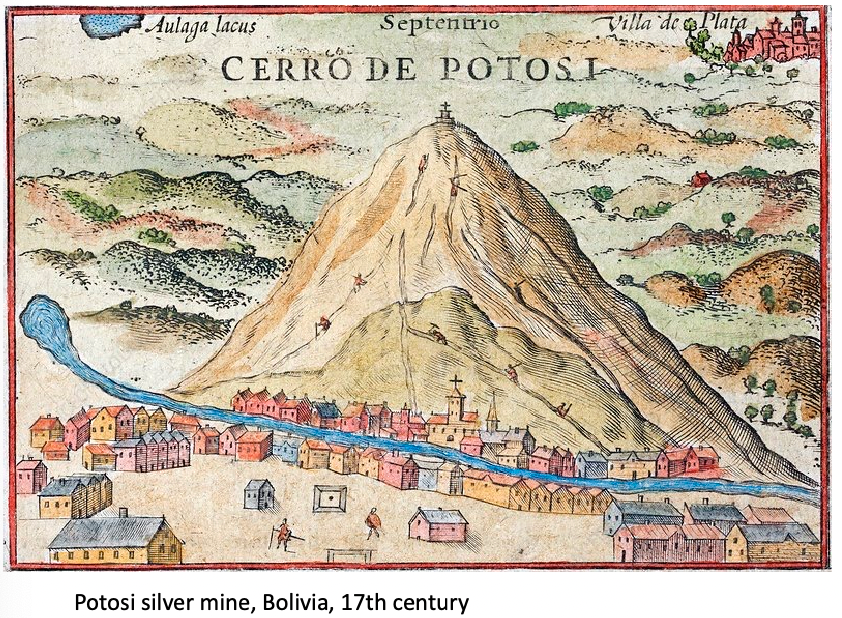
Spanish ship silvers to China = established a stronghold in trading = on average more than 2,300 tons of silver arrived in China from abroad
- note that: since 1493 - 1898 the Americas were invaded and incorporated into the Spanish Empire, with the exception of Brazil, British America, and some small regions of South America and the Caribbean
-
in 16th – 17th c., the trade imbalance with China was filled with silver from Spain’s New World colonies, and from Japanese mines
- gold flow out, silver flow in = as silver seen more important in China
-
gives many bad consequences (as well as few good ones)
-
Consequence of the influx of silver:
-
depreciation of silver = inflation; market speculation; .. all contributed to Ming’s collapse in the long run
-
immediate effects = rise of merchant = wealth can surpass the gentry family = destabilize the social order
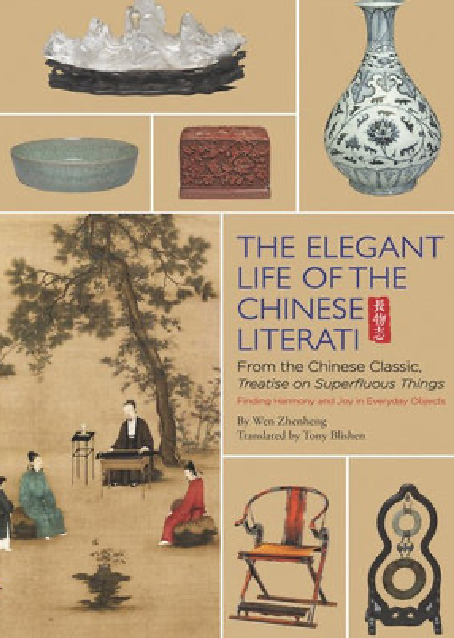
e.g. the above is a book written for gentry/scholar class to instruct them how one spend silver in a way to not look poor = anxiety of Confucian gentleman facing the threat of status change from merchant class
-
-
Consequence of foreign trade:
-
increase in population
-
recall that Song population grew due to new tech for agriculture + new crop from Vietnam
-
similarly, in Qing: new crop from Amiercan by spanish colonizers. Maize, Sweet potatoes, etc, grows in places unsuitable for millet and rice and have high yield:

hence also helped the life of poorer people
-
-
Ming fascinated by Europeans’s ballistic technology, e.g. cannon

many Chinese officials realized they are lagging behind in technology, and hence some advisers: should hire European governments to help defend northern enemies
-
famous Jesuits in China:
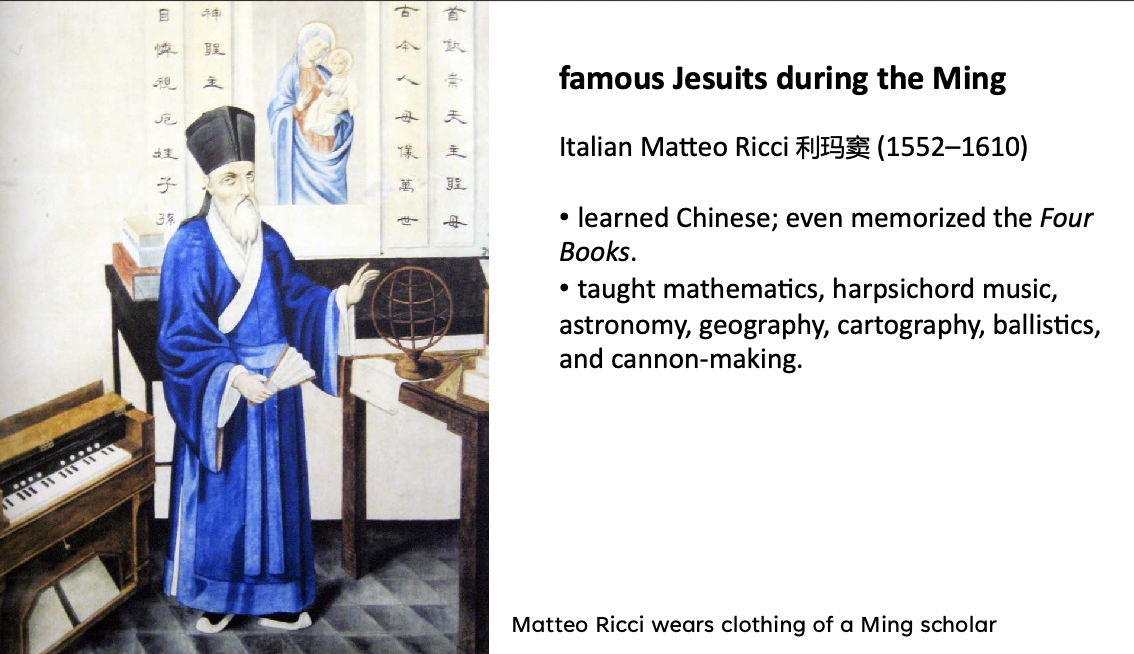
-
impersonate as Confucian scholar to blend into Chinese society at first
-
aimed to convert Ming gentry to Christianity, by reconciling Christian beliefs with Chinese beliefs
-
managed to convert some but very small numbers to Christian, as many Chinese gentries are more interested in European tech than religion
-
contribution to the world map = remembered as a person introducing western info + tech much more than as a preacher
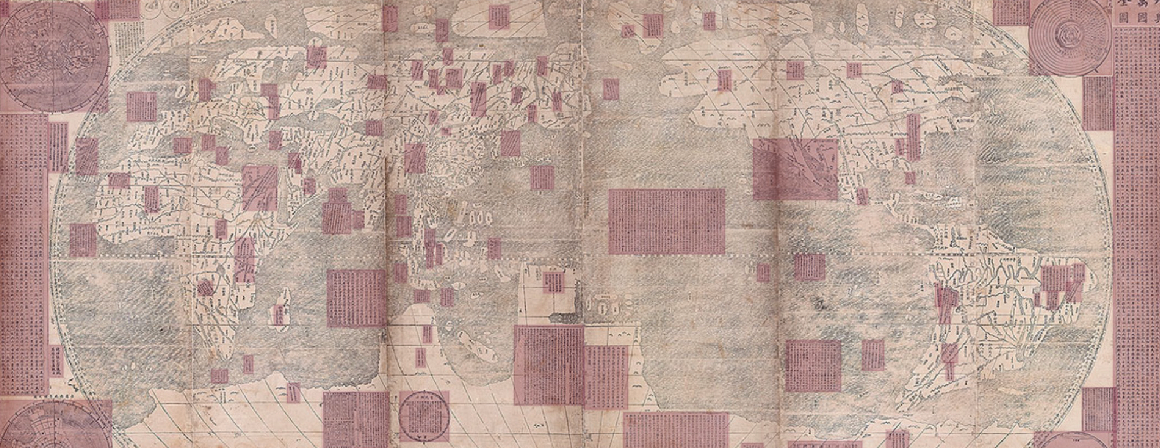
-
-
A new cultural form: novel
-
recall that good economy usually results in prosperity of culture
-
Ming poetry becomes less important hence less poets from Ming (and Qing), but more into (fictitious) novels: 3 out of the 4 classics of Chinese literature produced
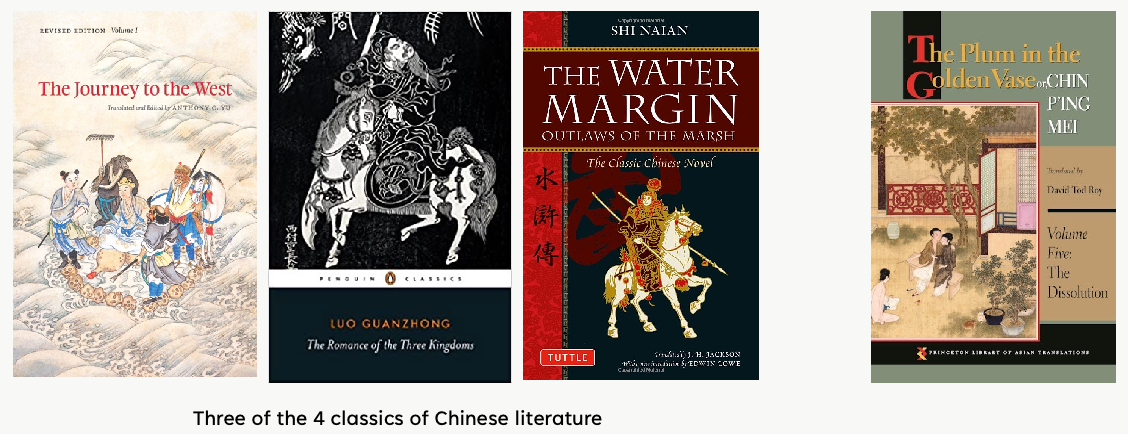
- Journey to the west: Xuanzang’s trip to see Buddhist scripts during Tang, but a fantasied novel
- Three Kingdoms: is history
- The water margin: set in the northern Song period = how a group of 108 outlaws trying to rebel the government
- The Plum in the Golden Vase: 16th century work focusing on the corrupt noble in China = known for erotic reasons
-
educated gentleman writes prose and fiction = those are more likely survive. The lack of novels in early time means novel might be there as well
- however, many novels are fictitious yet poems were real. Why are people suddenly interested in unreal things? Don’t know
- some say that it is due to Wang Yangming; others believe using easier language catered to a wider audience
Changes in gender relations
-
overall, women facing increasingly intense subjugation
- female infanticide: wanted to keep small family size, hence kills girls rather than boys who can labor and continue family line
- revised inheritance and property laws = intended to help but reverse effect for women
- female seclusion = find themselves confined and even not allowed to visit temples a lot
- chastity cult = encouraged widow to be a widow. However, this was an ideal and in reality widow remarriage is common (as they lose properties from husband, due to Ming laws)
- foot-binding. started in Song, but in Ming becomes more extreme. Accepted by women as a way to ensure good marriage
-
confined inside hence they are socializing within themselves.

-
but there are also some benefits
- rising level of female education + men sponsored female readers & writers. Perhaps because men are exerting so much control that they think nothing can go wrong by allowing these
- compassionate marriage
- perhaps better education means men can more easily communicate with women
- worship of personal feeling and sentiments = influence of Wang Yangming
Qing Imperialism
Previously in Ming and the World
- Ming Dynasty: large-scale trends in population growth, commercialization (again since Song), and global trade (private maritime trades)
- much global influence from private maritime trade. Discouraged by government due to piracy + political reasons + their northern enemies
- Single-Whip tax reform: simplify taxation procedure, so that almost all are paid in cash (mostly silver)
- so that tax evasion becomes harder = increased government revenue
- but increased demand of silver
- large demand of silver faciliated global trade
- export Chinese manufactured goods such as porcelain, imported silver from abroad
- also funded the rise of Atlantic (e.g. Spanish) empires
- along with silver, Jesuit commissionaires also came to China aiming to convert Chinese to Roman Catholicism
- reconciling Christian with Confucian pratices,
- but Chinese are more interested in European science and technology rather than religion, hence not very effective
- introduction of western science into China
- Novel as a new literary genre: vernacular language and a wide readership
- Women more subjugated but increased education
- also more women publisher
Manchu Conquest
Decline of Ming: several factors (importance is unranked)
- early period we had aristocratic emperor, but later also inattentive emperor
- Emperor Wanli reigned for a long time but stopped attending to court affairs for 30 years
- ruling often needs regulation and interventions; promotion needed his approval; But he simply did not care
- climate changes and natural disasters, such as famine, droughts, epidemics, cold spell, etc. in the 1630-1640s.
- was also the coldest decade in Russian history = poor agriculture due to the cold as well = famine
- Beijing had frequent epidemic and grand canal become highways to spread
- collapse of fiscal system due to eventual shortage of silver
- commoners do not have much silver to pay tax; govern cannot pay soldiers defending their borders
- 80% of counties stopped forward taxation to central government
- Europeans became reluctant shipping silver to China as time goes on = also contributed to silver shortage
- threats from Mongol and Jurchens
- Ming also needed money to supply military = attempted to increase taxes, etc. all of which are non-popular approaches for the people
- all of those combined gave revolts
- the two most prominent groups led by former soldiers Li Zicheng (1606-1645) and Zhang Xianzhong (1606- 1647) eventually captured the capital Beijing
Rise of Jurchens/Manchus
- recall that Jurchan were powerful during the Song: they established Jin金 dynasty, helped Song to defeat Khitans but turned to sack Kaifeng later
- Jurchans established the Jin dynasty but also become much sinicized in the past and their
- Jin dynasty 1127 - 1200s, when later Mongols sacked and took control of northern China = Yuan dynasty
- in 1600s, they see themselves as Later Jin hence a political legitimacy for restoration of power

- brief overview: The Jurchens are chiefly known for producing the Jin (1115–1234) and Qing (1616/1636-1912) conquest dynasties on the Chinese territory. The latter dynasty, originally calling itself the Later Jin, was founded by a Jianzhou commander, Nurhaci (r. 1616–26), who unified most Jurchen tribes, incorporated their entire population into hereditary military regiments known as the Eight Banners, and patronized the creation of an alphabet for their language based on the Mongolian script.
-
they live in China’s north plain, had long engagement with Chinese in terms of trade, tribute, ally/enemy
- Jurchans where half-sendantry = different from Mongols
- had settlements, but also a lot of raids, enslaved captives, hunting and fishing, etc
- profited a lot from trade with Ming: Chinese liked ginseng. 25% silver went to Jurchen because of the ginseng trade = they now have money to fund military
- rise of Jurchan as Nurhaci brought up a strong tribal confederacy
Nurhaci: leader of Jurchen Confederacy
-
From the lineage of Aisin Gioro愛新覺羅
-
Ming’s divide and conquer strategy actually made his own tribe stronger
- first subjugated to Ming and used it to defeat other tribes to make his tribe strong
- in 1595 Ming awarded him the title of Dragon-Tier General
- eventually his tribe became the strongest, so Ming turned against him, and Nurhaci allied with Mongol tribes
-
in 1616 he declared himself the khan of the Great Jin (restoration of Jin dynasty as descendents)
- captial at Mukden, modern Shenyang
- adapt Mongolian alphabet to the Jurchen speech
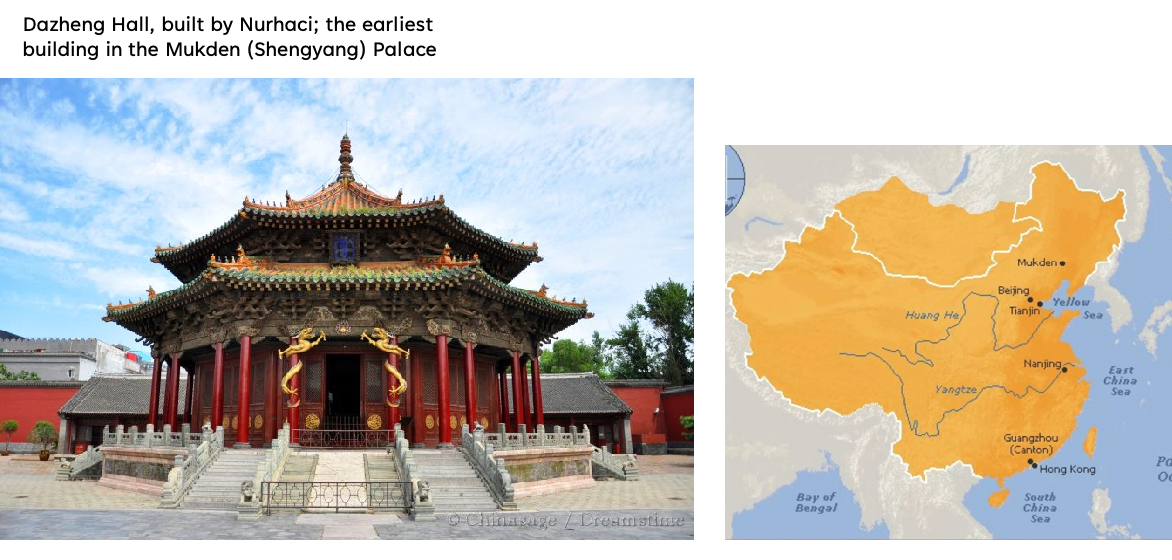
so Shenyang was the center of their political power
-
another decisive step is the Eight Banner system: reconstituting social structure
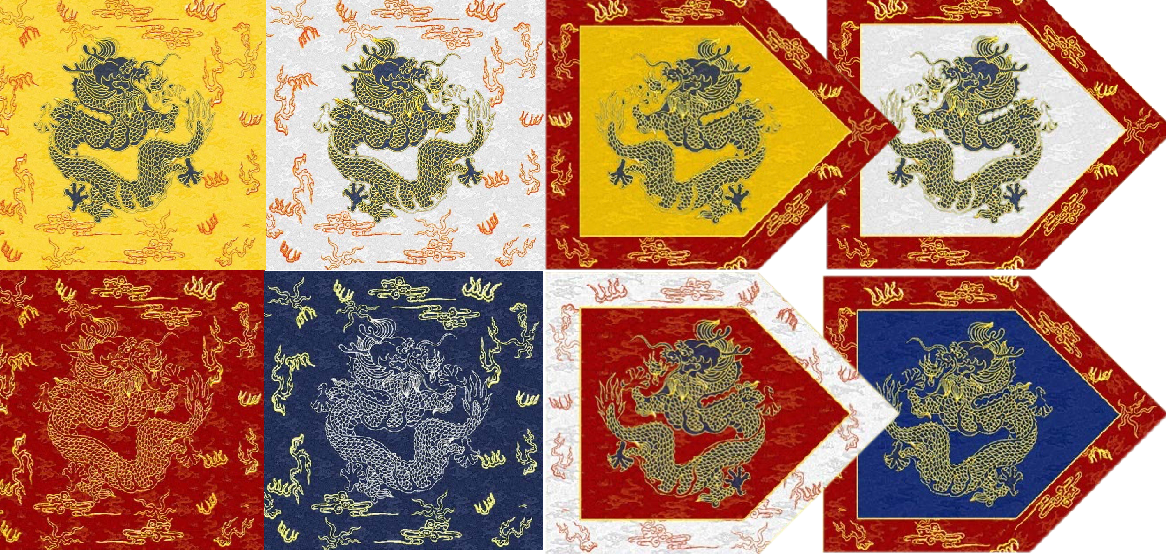
-
each banner is a permanent group also a fighting unit + unit of residence
- included dependants of fighting mens includeing women children and servants
-
hence shared identity and shared clothing within a group
-
over time, each banner becomes somewhat ethnic groups = close relationship within the group, but not purely one ethnic within a group
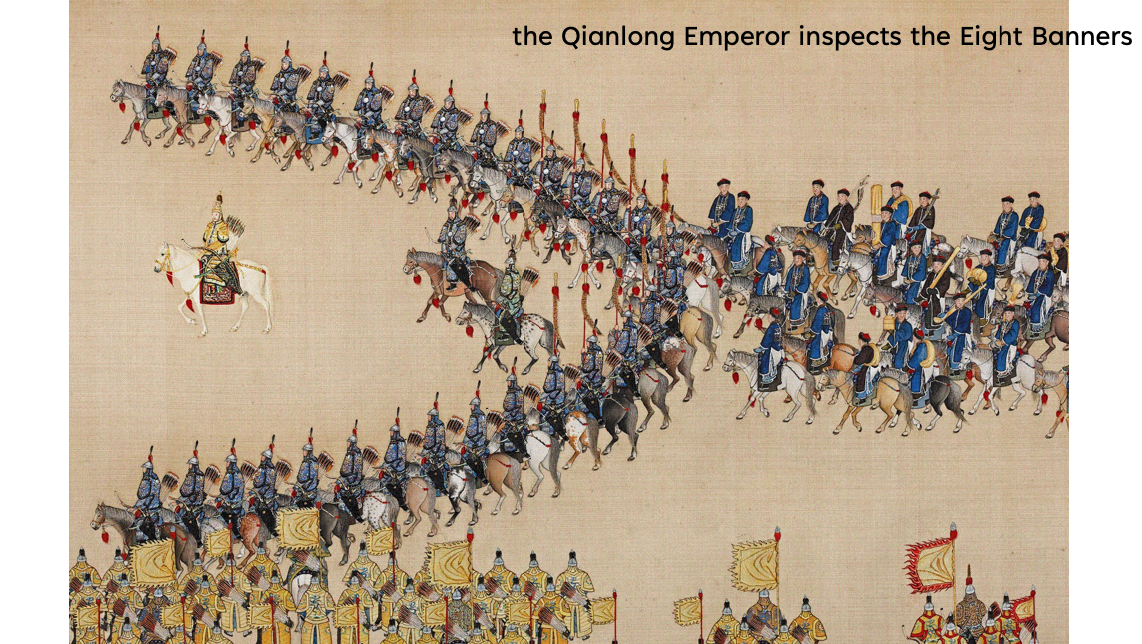
-
Hong Taiji’s creation of Manchu Qing
- succeeded Nurhaci, second Khan of later Jin
- declares himself emperor of the Great Qing
- Qing because Qing = clear, hence water related > Ming = fire (and moon)
- this new dynasty name is a clear announcement of his intention to conquer Ming
- some measures he took to rule include
- ordered translations of Chinese culture to Jurchen so he could study them
- moved towards Chinese-style burearcarcy centralization
- in 1636 he creates a new identity for his people called Manchu
- one key thing to realize is that Manchus are also not one ethnicity = rather amalgamation of steppe nomadic people + sedentary Chinese + etc. Therefore, Manchu as an “ethnicity” more like a political construct
Manchu Identity
-
Manchu identity is not determined by birth, but by just being a member of the Banner
- a tool for integration: shared identity overcame linguistic-ethnic differences of banner families that included Jurchen, Mongols, Korean, Chinese
- a tool for segregation: emphasized unique claim of Manchus to rule China.
-
They also emphasized identity markers such as hair styles and clothing, to be different from that of Han people
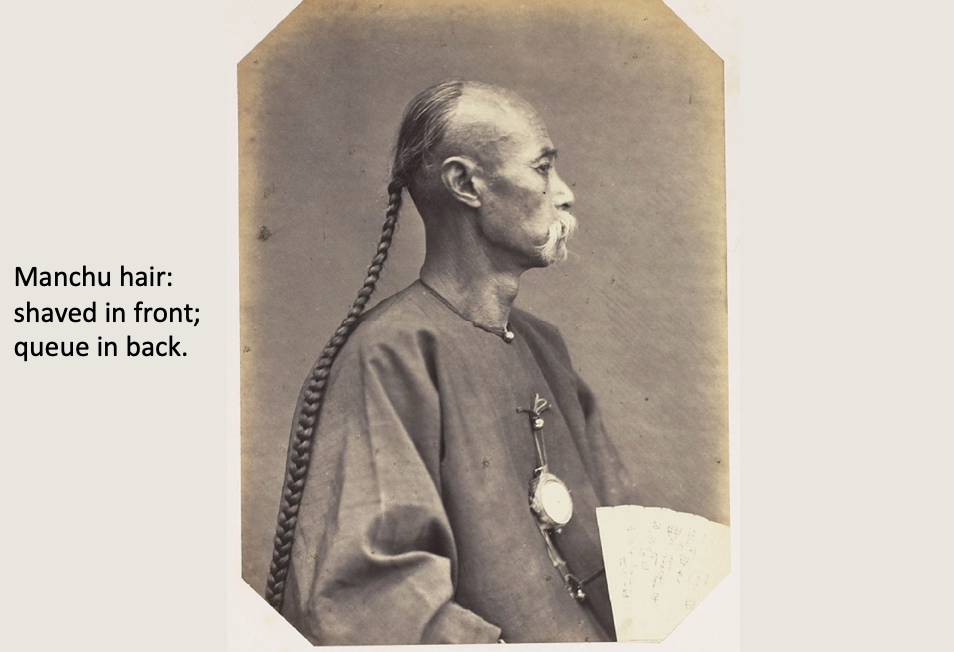
so men hair style become political tool as well: shows who you are submissive to.
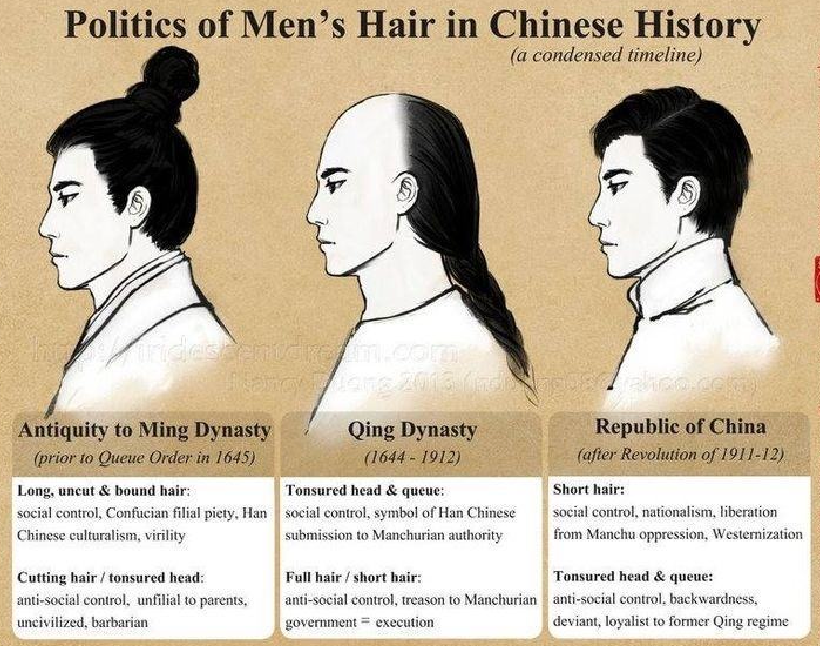
examples of Manchu clothing is more diverse. e.g. soldiers uses a lot of bows
Soldiers Qing Officials 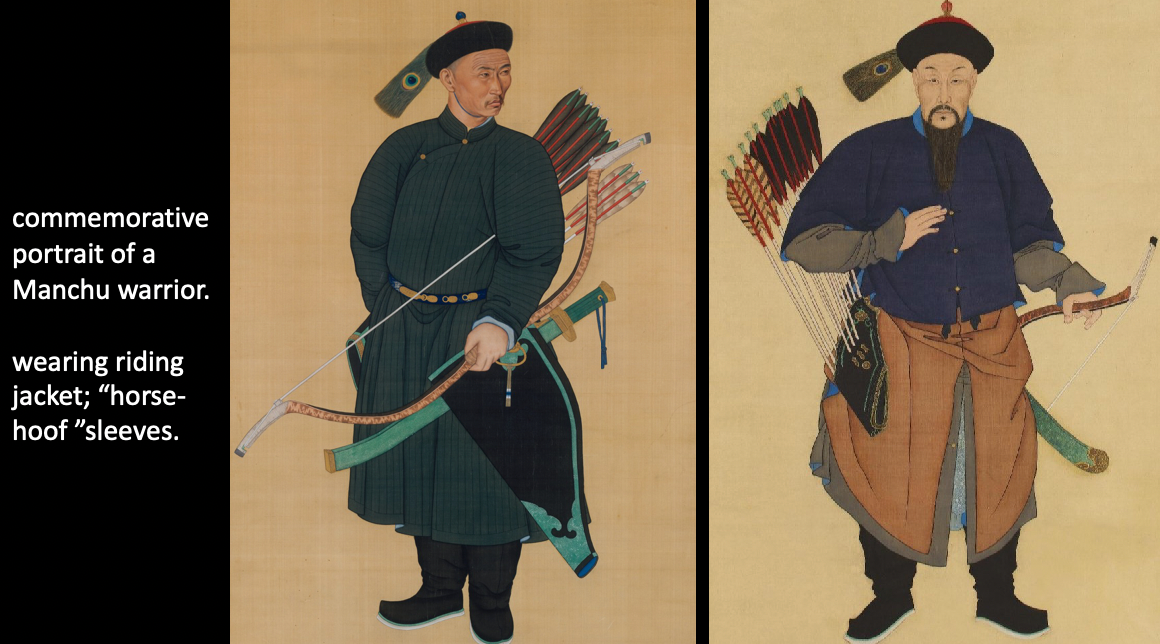
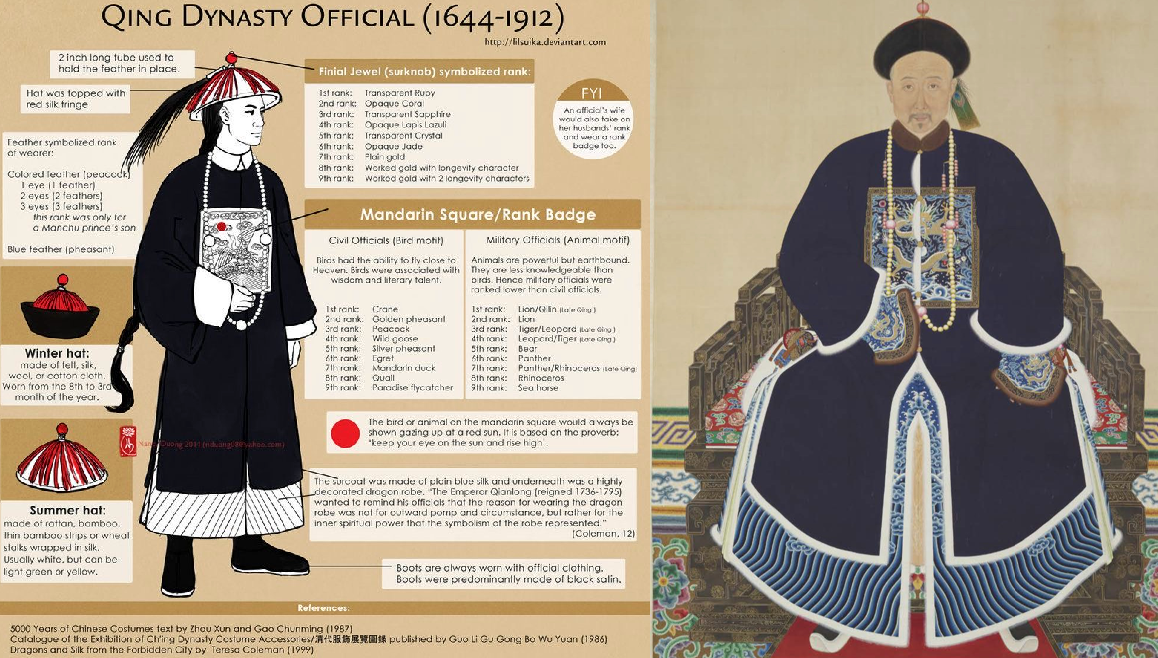
-
Manchu also tried to forbid women to foot-binding
- but that ban didn’t work: foot-binding practices are already very entrenched in Han Chinese minds, and it was seen as attractiveness/object of sexual desire
- so most Manchu women don’t bind their feet, but Han people still continue the practice
- why no enforcing this change like with mens’ hairstyle? perhaps because men already submitted, no need to change women
- but the general trend in Ming and Qing can also be viewed as tightening controls of its people = also of women
- Ming being active in domestic affairs with its Lijia policy, and using morality manuals (Sacred Edict of Six Maxims)
- prior to Ming, pre-martial sex was not proscribed. But in Ming and Qing there are a lot of much focus on chastity = interference from government
Qing conquest of Korea and Japan
- wanted to at least prevent Korea to join Ming to fight against them, so basically conquered Korea (but left little cultural footprint)
- initially, Korea see Jurchens as barbarians = many had Confucius thoughts
- Korea also wanted to help Ming because, before when Japan tried to invade Korea, Ming helped.
- but eventually Korea surrendered to Manchu due to their military strength and became vassal state of Qing
- so no choice but to join conquest to Ming
- sees themselves as repository Confucian hence named themselves soHwa
- as in fact it is true: Ming is the last dynasty ruled by Han Chinese
- Qing conquest of Ming also shocked Japanese
- the Japanese sees this as Ka-i Hental華夷變態 = transformation of China from civilized to barbarian
- (recall that during Tang, they see Chinese as a model for culture and civilization)
- so after this, Japanese also think that East Asian culture superiority is no longer in China, but in Japan
Last Years of Ming empire: there player. Ming, the Rebels, Hong Taiji’s successor
- Ming asked Manchu to help quell the rebel, but eventually they had a bigger plan and conquered the whole China
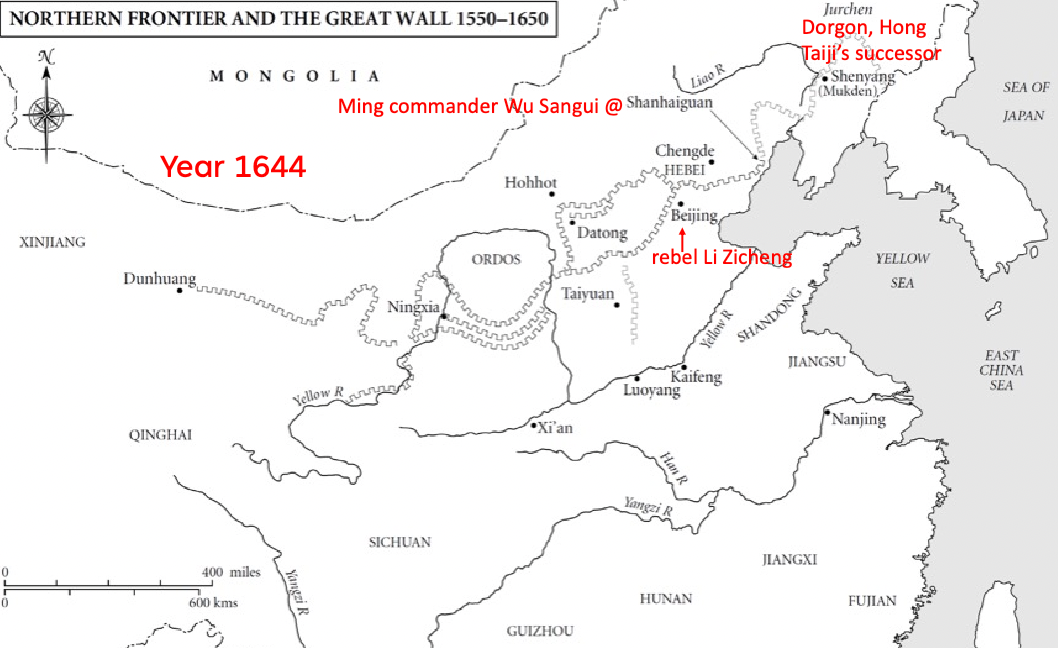
-
Qing took several yeas to conquer China proper, and expanded territories
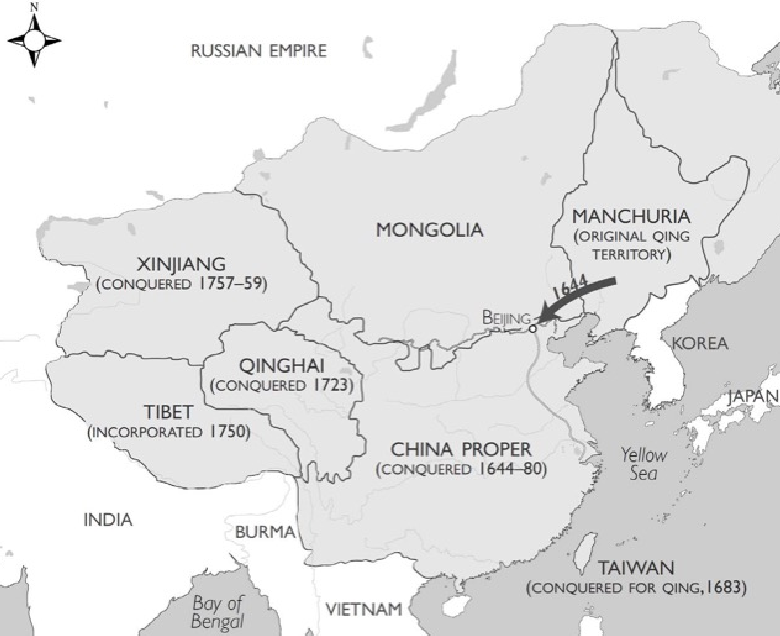
-
Qing had remarkably capable emperors = High Qing: Kangxi Emperor (r. 1654-1722) Yongzheng Emperor (r. 1722-1735) Qianlong Emperor (r. 1735-1796)
- set most of the boundaries of today’s China: Xingjiang, Tibet, etc
Kangxi
- The Kangxi Emperor is considered one of China’s greatest emperors.
- He suppressed the Revolt of the Three Feudatories, forced the Kingdom of Tungning in Taiwan and assorted Mongol rebels in the North and Northwest to submit to Qing rule, and blocked Tsarist Russia on the Amur River, retaining Outer Manchuria and Outer Northwest China.
- The Kangxi Emperor’s reign brought about long-term stability and relative wealth after years of war and chaos. He initiated the period known as the “Prosperous Era of Kangxi and Qianlong” or “High Qing”, which lasted for several generations after his death.
Yongzheng
- A hard-working ruler, the Yongzheng Emperor’s main goal was to create an effective government at minimal expense. Like his father, the Kangxi Emperor, the Yongzheng Emperor used military force to preserve the dynasty’s position.
- Although Yongzheng’s reign was much shorter than that of both his father (the Kangxi Emperor) and his son (the Qianlong Emperor), the Yongzheng era was a period of peace and prosperity.
- Yongzheng Emperor cracked down on corruption and reformed the personnel and financial administration
Qianlong:
- As a capable and cultured ruler inheriting a thriving empire, during his long reign, the Qing Empire reached its most splendid and prosperous era, boasting a large population and economy.
- As a military leader, he led military campaigns expanding the dynastic territory to the largest extent by conquering and sometimes destroying Central Asian kingdoms.
- This turned around in his late years: the Qing empire began to decline with corruption and wastefulness in his court and a stagnating civil society.
Qing Conquest of Taiwan in 1683
-
recall that Dutch conquered in 1623 and established their colony in Taiwan
-
brief history of Taiwan
-
Fall of Ming 1640-1650: people from Fujian started settling there, and Ming loyalists retreated to Taiwan
-
Zheng Chengong 1662: drove out the dutch and more=100k Chinese emigrated there
-
Qing defeated the Zheng regime 1683: but allow it to exist autonomously and made it a prefecture (district under the government of a prefect) of Fujian
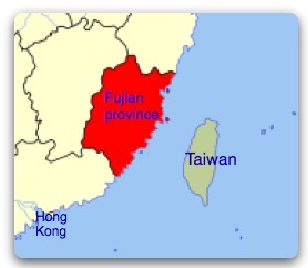
-
in 1870s, Taiwan became its own province as it is a key port for martime trade
-
1894-1895 after Sino-Japanese war and WWII: became part of Japan. A lot of buildings today still have Japanese style
-
at the end of 1945-1949: 孙中山 being the first leader of the Kuomintang (Nationalist Party of China), lost and followers immigrated to Taiwan.
- Thinking they can go back and recover, but obviously never happened. These are also considered as Waisheng and don’t speak Taiwanese (now the “ethnic” gap is much smaller)
- since many Waisheng are governments, so they are also kind of upperclass in Taiwan
-
-
therefore, Taiwanese very much takes over from Mingnan dialect from Fujian
-
but again, Qing in general had loose control over newly conquered regions
Qing conquest of Dzungar Mongols
- western Dzungar dmoinated the west euroasia in 1630
- long batter with Dzungar Mongol, and subdued Dzungar Mongol in 1696
- but a lot of revolt by Dzungar Mongols = Qing launched genocide in 1750s
- effectively ended the northen Mongol problem
Qing conquest in Tibet
- Dzungar mongols tried to expand into Tibet = hence they invaded in 1717
- so Qing invaded Tibet and installed a pro-Qing Dalai Lama; Tibet became a protectorate
- but again little interference in Tibetan local governance: hence maintained Tibetan culture
Qing creation of Xinjiang
-
in the Han dynasty, some chinese troops stationed there, but not in Tang and Song as Chinese had lost control
-
finally re-acquired by the Qing = again Qianlong’s troops basically massacred Dzungar troops and completed subjudation
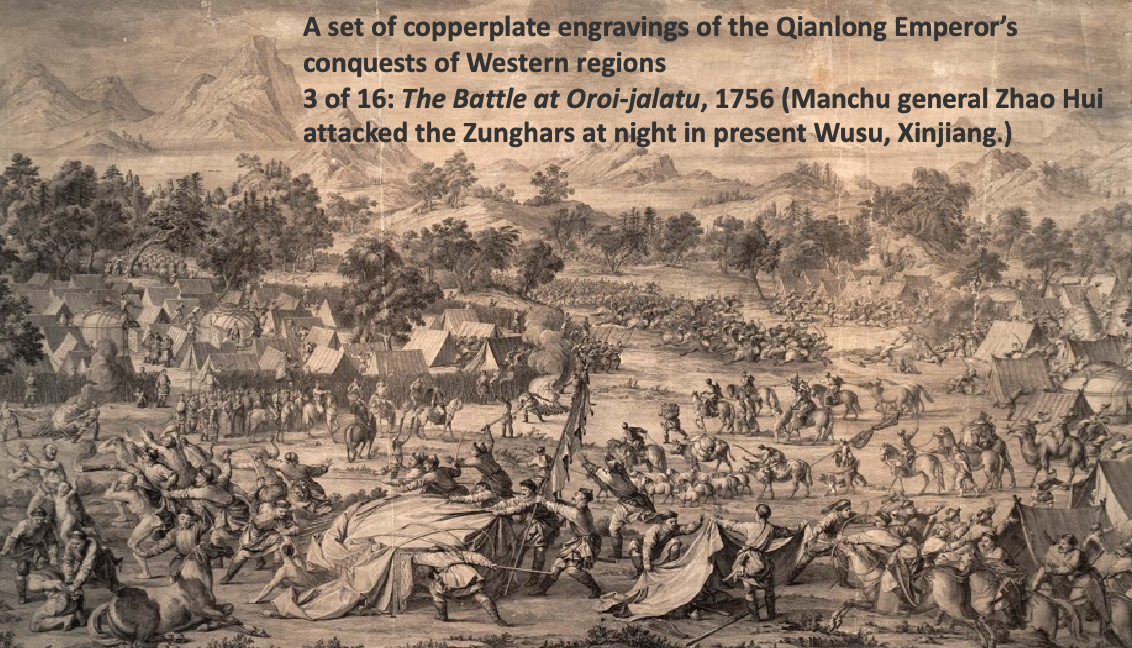
-
after this conquest, in 1768 announced the formal annexation = Xingjing, meaning new dominion
- but again, territory under control of Manchus, but local poeple also allowed to contine their practice
- no restrictions as with Han chinesemen
-
however, maintenance of far territory is also a financial burden, e.g. military spending. Therefore, perhaps most effective use of Xinjing in Qing is as a penal colony = 10% officials in Xingjinag as punitive banishment
Managing large territory and diverse people
-
Qianlong assumed different persona to different audiences = portray him in many different costumes
as Manjusri as Confucian as European-style Warrior 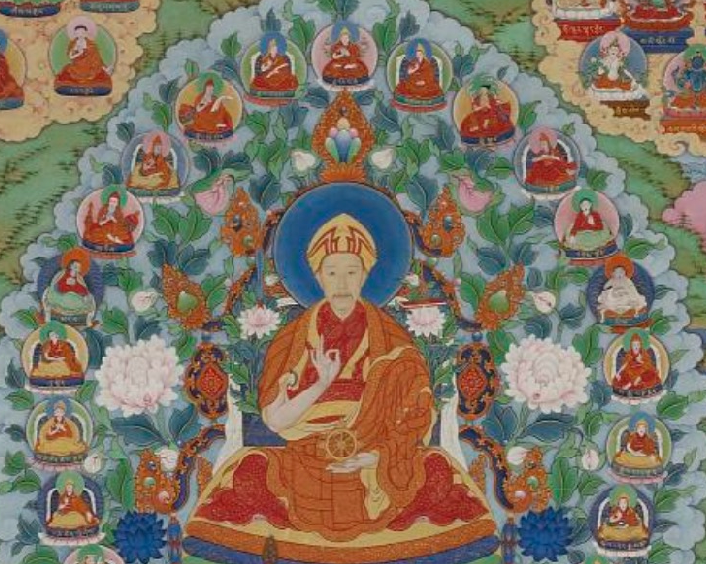
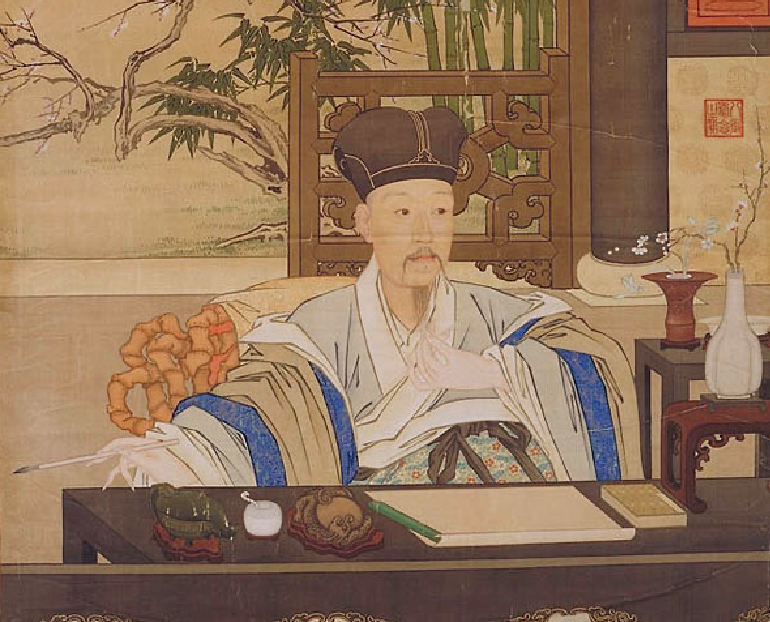
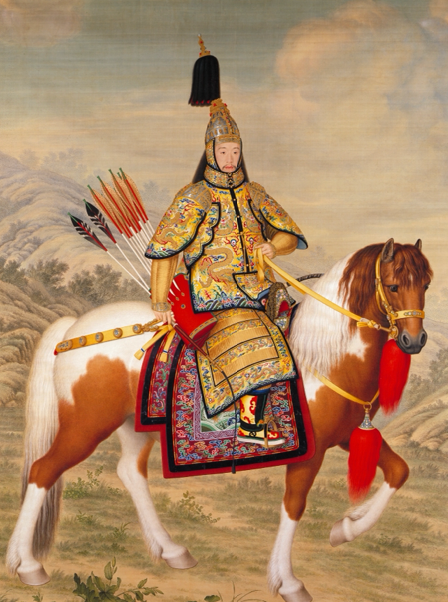
e.g. as Manjusri = appeal to Laima in Tibet, or as Confucian scholar when speaking to Han Chinese
- acknowledges culture differences and ethnic distinctions, also especially wanted to preserve his Manchu ethnicity
-
so in general, Qing are interested in conquering new lands but not governing those new land
- global history: Russian expanded east-ward: time of imperial land grabbing = have as much land as possible = control over resources
- but remember those from Qing are not peaceful conquest = e.g. Xinjiang lots of people massacred due to dissent. So still insisting on their political dominance but not really in establishing culture statues
Euroiserie in China: Yuanming Yuan built near a lake outside Beijing
-
imperial palace began construction in 1707, added a number of western style building with the aid of Jesuit architects
-
unfortunately destroyed by British and French in 1860. Historical drawings shown below, and attempts of restoration in progress
|
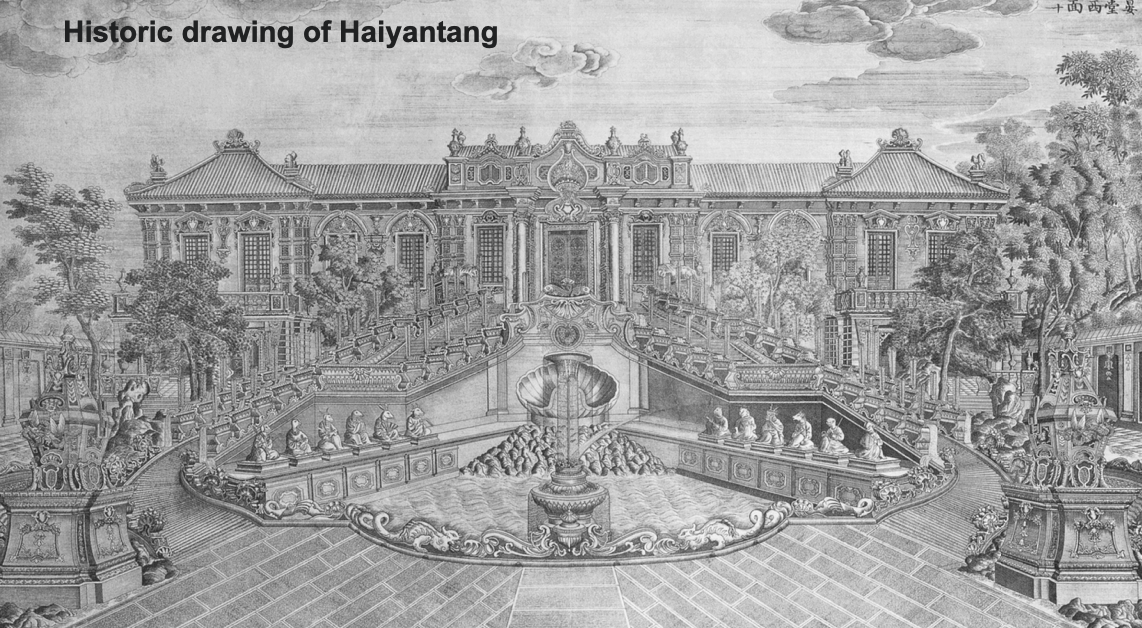 |
| 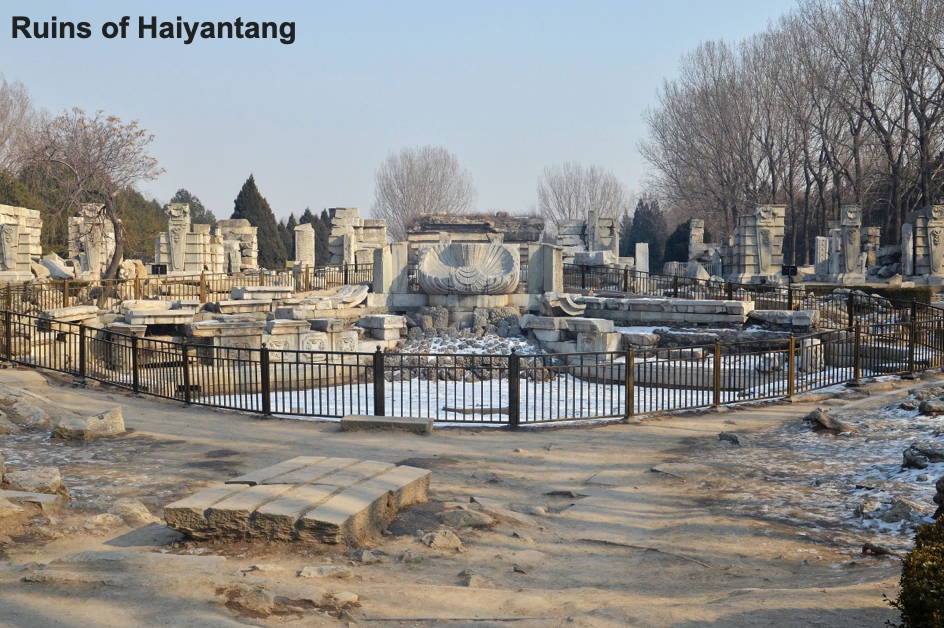 |
| :———————————————————-: | :———————————————————-: |
|
| :———————————————————-: | :———————————————————-: |
The Qing in Crisis: Opium & Western Imperialism
Previously on the Qing Conquest
- Decline of Ming and rise of Manchu Qing
- Ming facing adverse climate, peasant rebellion, etc
- Peasant rebellions give opportunity to Manchus from NE China, descendants of Jin金
- Qing did really well and controlled China for almost 3 centuries
- Qing used the Banner System which constructed a “political” ethnicity
- a banner group represents a unit of a military organization/ unit of residence
- joining to be a Bannerman = being a Manchu = an “invented” ethnic group
- Manchu Qing emphasizes that Manchus were not just Sinicized, but regarded Qing as a multiethnic empire;
- e.g. Qianlong with multiple faces, different policies, etc.
- High Qing: territory reached the greatest extent
- 18 century: unrivaled standard of living and invention flow more from east to west
- 19 century: outmatched by western countries
The Canton System: Qing’s international trade
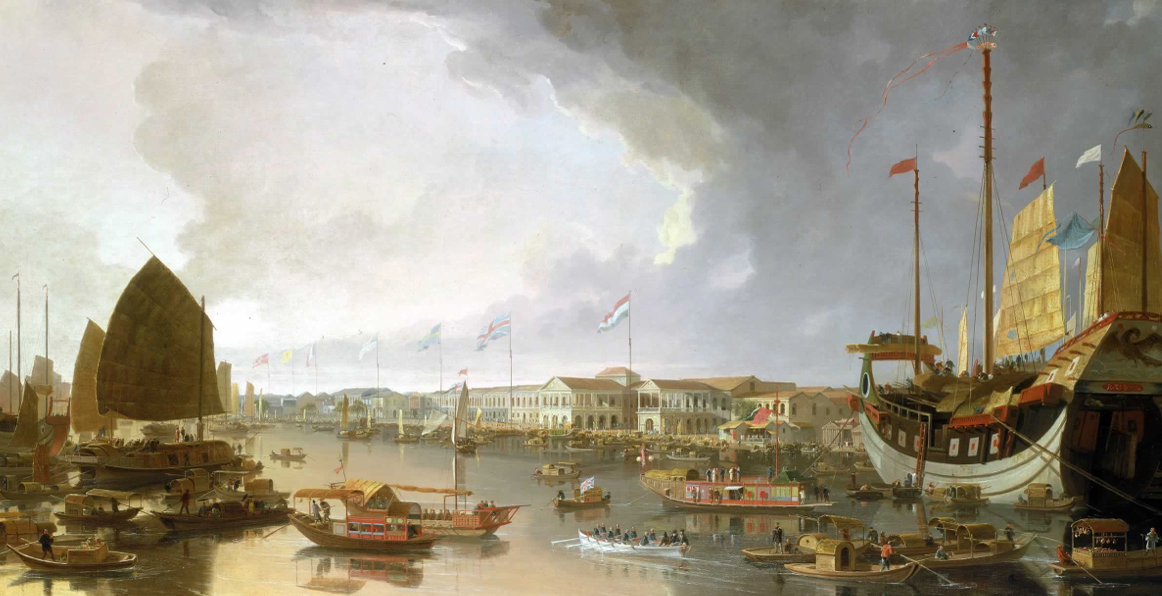
-
Qing legalized private maritime commerce, though restricted to Canton
- there were many prosperous trade ports, but all abandoned by people and finally went with Canton = most dominate place in sino-western trade

-
wanted to control western influence
- control with inflow of western foreigners: fear illegal infiltration of western missionaries
- therefore, in 1757: Canton the sole port open for Western trade
- 1760 court imposed regulations on foreigners (e.g. their mobility) in order to keep them from disturbing Chinese
- even when trading, they need to deal with designated Qing merchants (hong行)
13 Hongs of Canton: 十三行
-
Chinese merchants controlled business and monitored European trades
- Hong = A hong 行 originally designates both a type of building and a type of Chinese merchant intermediary in Guangzhou (formerly known as Canton), Guangdong, China, in the 18–19th century, specifically during the Canton System period.
- foreigners can only spend a few weeks in the Hong, then return to Macao, which was still a Portuguese colony
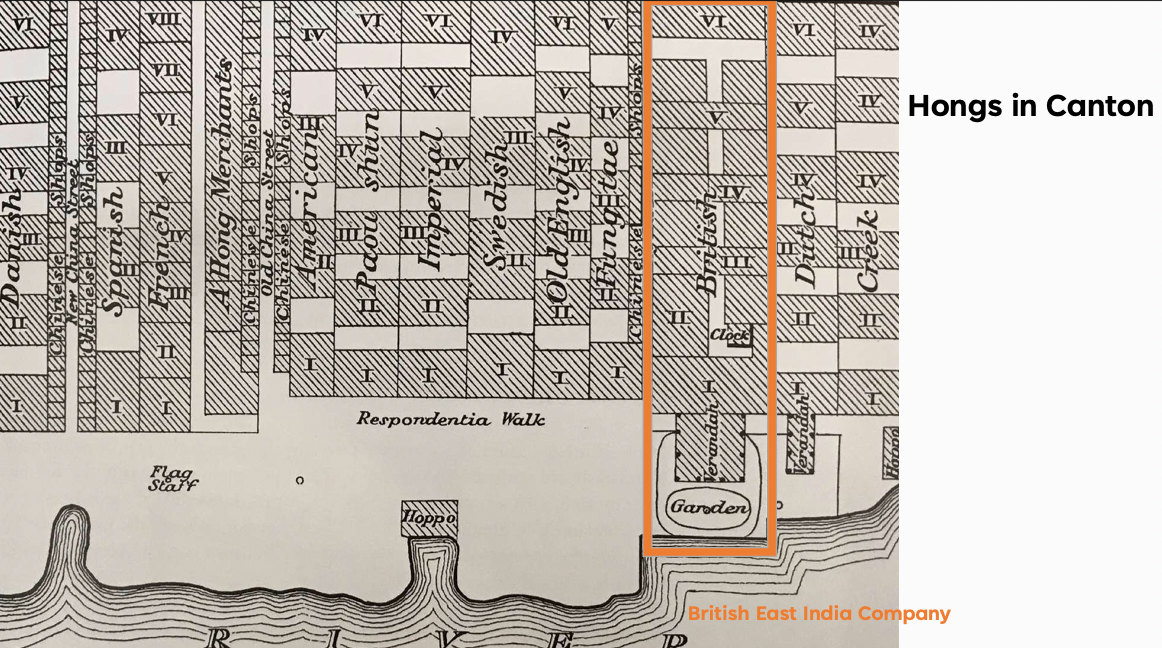
-
Wu Bingjian 伍秉鑑 (1769–1843), known as “Howqua”浩官: most powerful merchant at the time
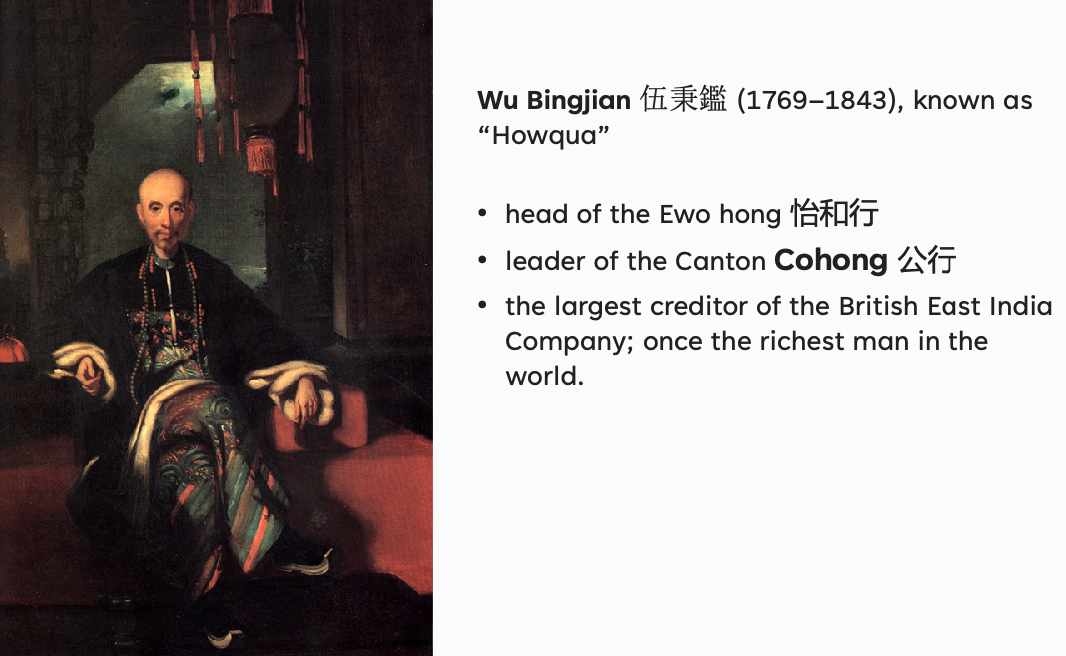
- all Chinese home merchants belong to a guild: Cohong 公行 = responsible for policing the trade with westerners
- granted right to monopolize import and export trade, but in turn guarantee to government all duties and proper behavior of western
- he also involved in the opium trade = people in China today therefore have a fixed feeling towards him
-
during 18th century, industrial revolution in Britain made it became leading commercial nation with colonies (e.g. in India)
- English trade with China monopolized by British East India Company = allowed by Queen Victoria
- but this powerful company is still restricted by Chinese Hong in Canton
The Industrial Revolution was the transition to new manufacturing processes in Great Britain, continental Europe, and the United States, that occurred during the period from around 1760 to about 1820–1840.
- This transition included going from hand production methods to machines, new chemical manufacturing and iron production processes, the increasing use of steam power and water power, the development of machine tools and the rise of the mechanized factory system.
- Output greatly increased, and a result was an unprecedented rise in population and in the rate of population growth.
Macartney Mission of 1793:
-
British wanted to improve profits/trade footholds in China, e.g. get tea cheaper and establish footholds to store goods
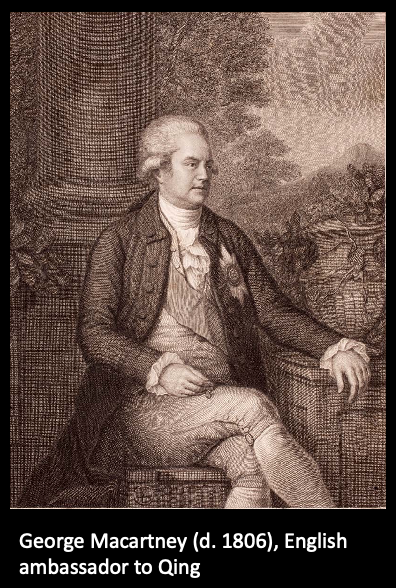
-
hence wanted China to abandon tribute system = towards more in how European deal with each other
-
a more direct trade. Free trade + Adam Smith = Wealth of Nation = justify British idea to ask China abandon Canton system
-
-
requests include
-
open commercial warehouse in Beijing
-
sought extra territoriality:British nationals exempt from the Qing legal jurisdiction
i.e. wanted to revise the canton system to trade more freely in China
-
-
Therefore, missionaries sent to China brought some interesting European goods but Qianlong is not interested in
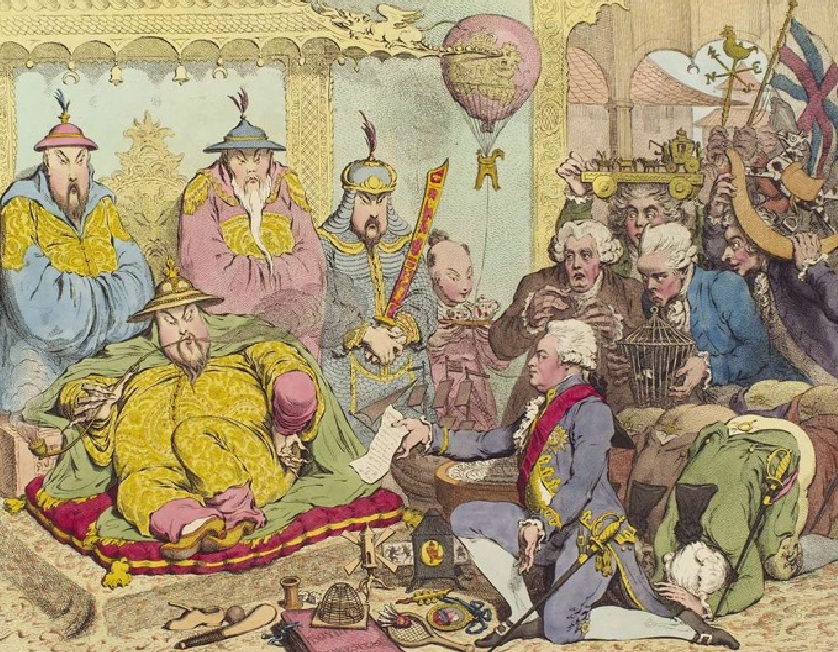
notice that in this painting westerner tried to portray Chinese as despotic and un-understanding, because Qianlong (in his 80s) decisively refused all British request in a very condescending/arrogant tone:
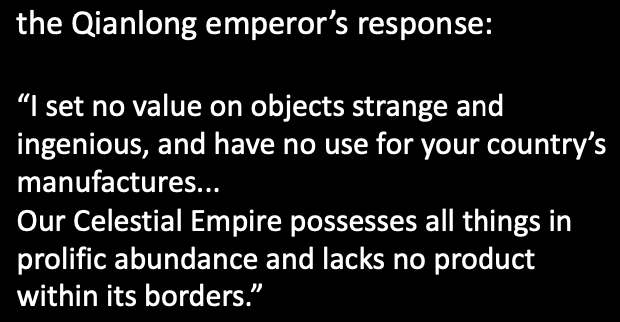
-
Why did Qianlong reject those requests?
- fundamentally, those requests themselves are somewhat went overboard.
- perhaps Qianlong is not interested in western goods? Note that they did collected a lot of western gifts from other countries, so it is what presented was not new = China didn’t really need British manufactures
- however, later on the major problem is his slight on western (military) tech
- perhaps because the missionaries did not kowtow? Recent research shows that obsession of the ritual does not come from Qianlong, but the missionaries
-
Why was Qianlong so arrogant?
-
indeed, China was powerful as there is a huge trade imbalance: silk and porcelain, and tea became drink of choice in Britain
-
large amount of silver flow into China,
|
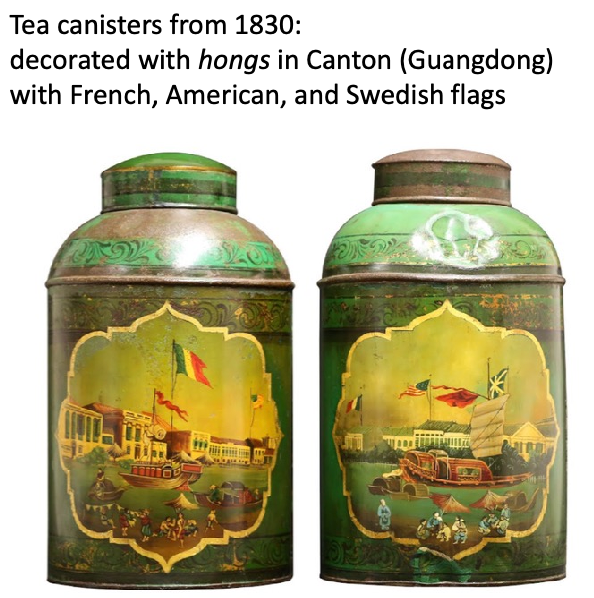 |
|  |
| :———————————————————-: | :———————————————————-: |
|
| :———————————————————-: | :———————————————————-: | -
so British had to have plans of coming up alternatives commodity to trade:
- cotton + silver from new world
- tried to re-sell tea to the US to get profit: Boston Tea Party. The target was the Tea Act of May 10, 1773, which allowed the British East India Company to sell tea from China in American colonies without paying taxes apart from those imposed by the Townshend Acts. Hence is unfair and Americans dumped/destroyed entire shipment of tea
- Finally, British turned to opium
-
-
Opium trade with China
- opium was not new, but only used for medical purposes before
- 17th century: smoking opium and tabacco caught on in China, just like how British took tea.
- The great demand of opium then solved the trade deficit with Britain
- 19th century: net outflow of silver from China due to opium trade
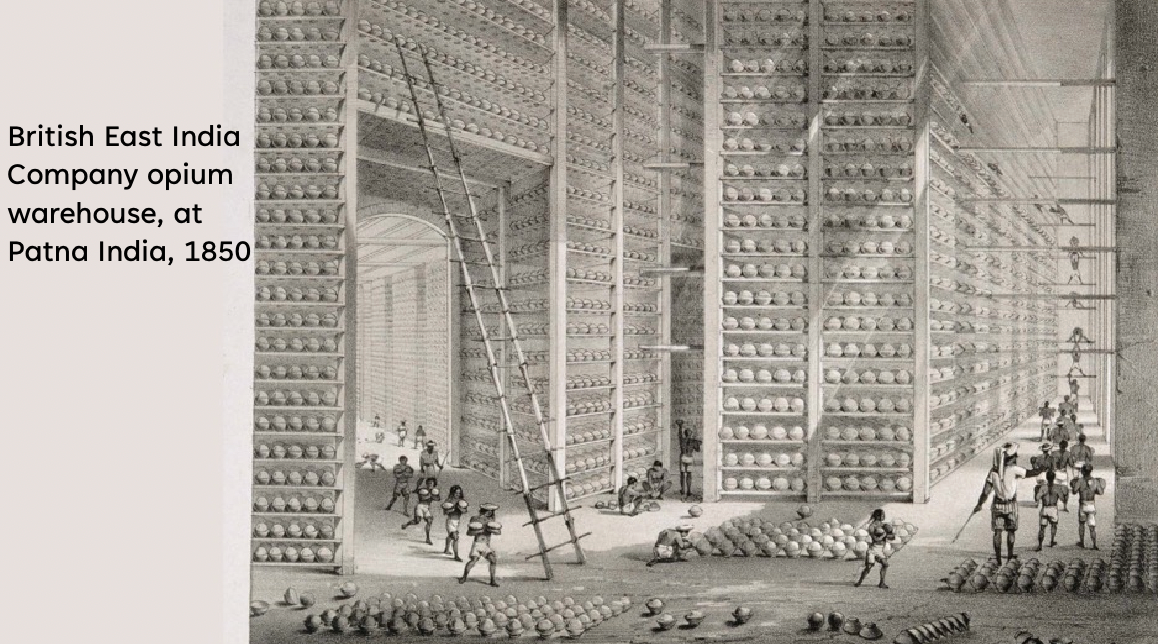
Opium Imports from India to China
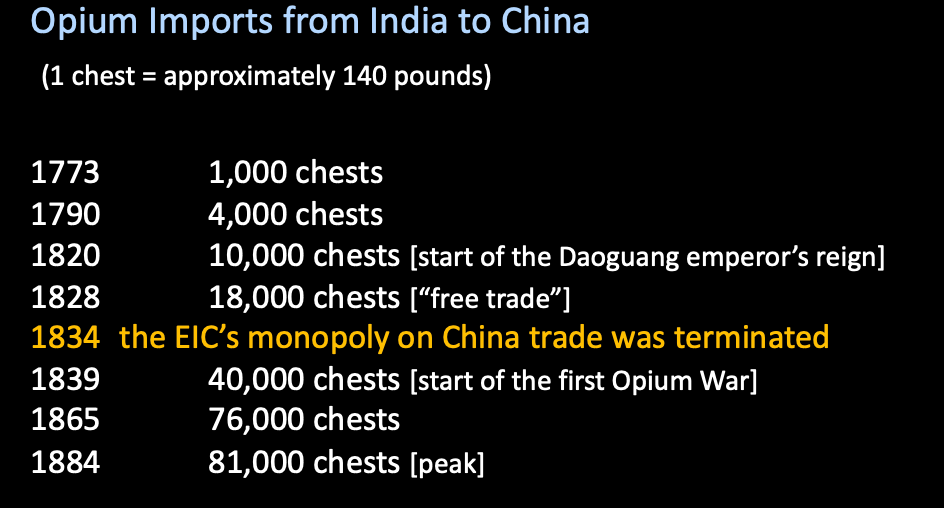
- opium became major product in China over time
- EIC monopoly ended and private trade (e.g. Russel & Company) begins, even more opium (like freedom of trade)
- e.g. lots of American gained most fortune from China trade
- then obviously this caused a lot of problems
- 2 million addicts in China
- difficult for Chinese to enforce ban
- attempted 1729 first opium ban; 1800, banned importation and domestic production
- however, this did not work (even open trading disappeared) because there are lots of European smuggling + corruption from local officials and underground networks
- since opium was illegal, Qing made no tax revenue from it
- net silver flow out = silver shortage soon caused problem in money supply
- 2 million taels deficit in 1820s and 9 million in early 1830s
The Opium War and its Aftermath
- opium war fundamentally changed the relationship between China and the Western
- before, China shows dominance over western power, like how most civilization in centered in China and how Mongol/northern tribes conquered lots of territories, and establishing tributary/vassal states
- now, difference in technology made China lag much behind western in power
-
Emeperor appointed Lin Zexu to destroy opium at Humen
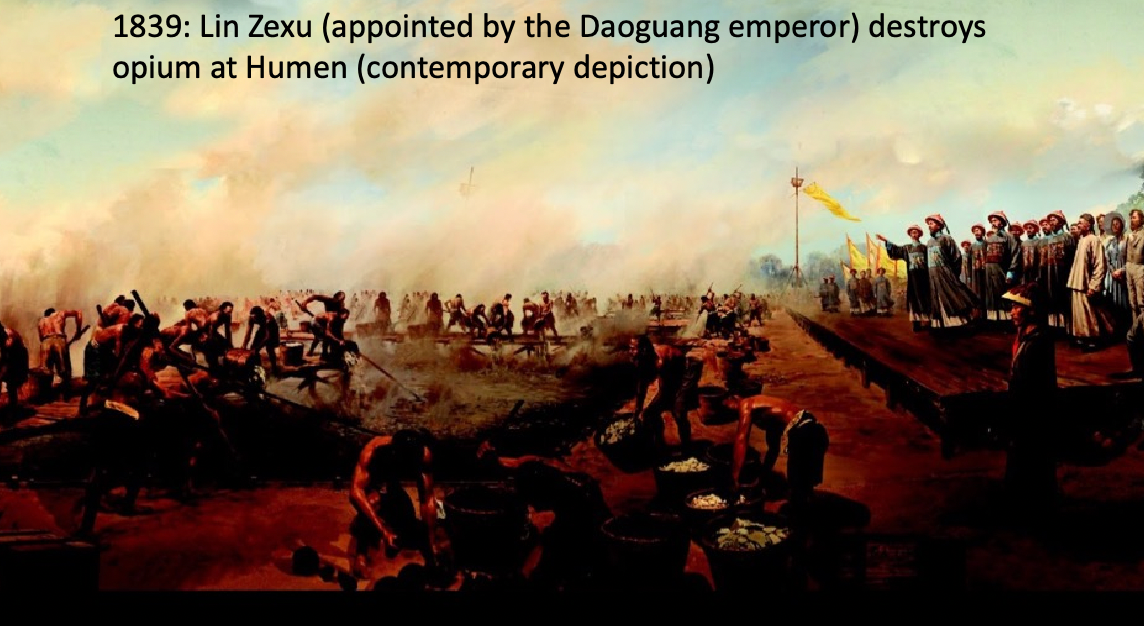
- Charles Elliot (Chief Superintendent of British Trade in China) promised to compensate the merchants after confiscation, but did not happen after Lin confiscated them
- hence English commercial interest pushing war with China, so Lin’s confiscation of opium became a justification for war
-
Qing navy was ill prepared against British navy forces
- China had no significant government input in maritime tech after Zhenghe’s voyage
- in general, low tax imposed = low research fund for strong navy power
- ended up having fully iron warship from British v.s. wood ship in China
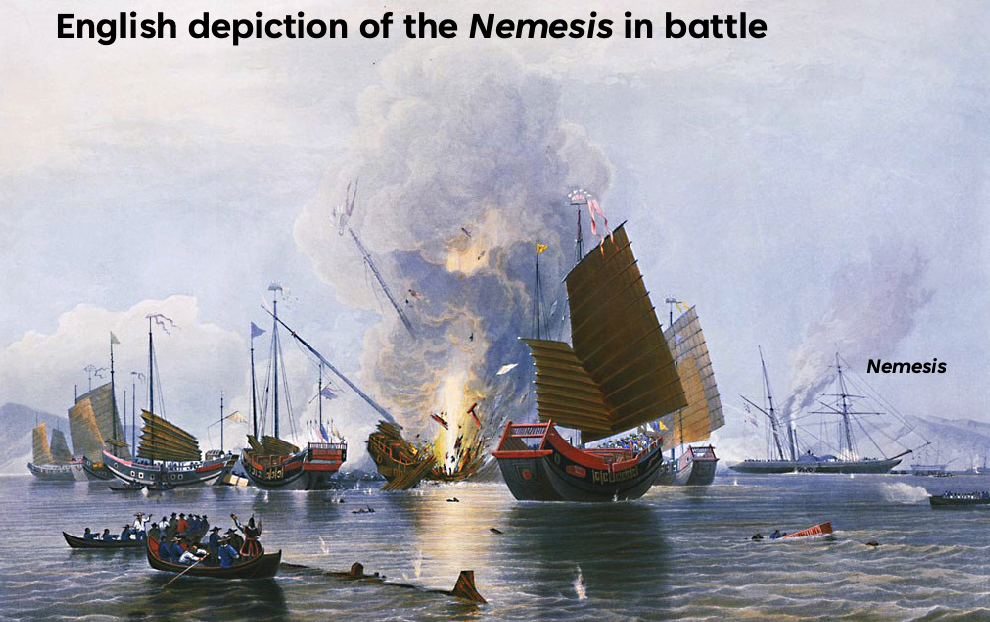
Treaty of Nanjing: defeat and humiliation
-
China lost easily and is forced to sign unequal treaties
-
those treaties include:
-
21 million silver paid to England as punitive indemnity
-
“opening” of treaty ports, such as Shanghai (later, “concessions”)
-
gave England Hong Kong ‘in perpetuity’ (later, returned in 1997)
-
pressured more opium trades
-
low tariff set for the English
-
in 1843: extra-territoriality: Qing laws did not apply to the English in Qing territory. (e.g., Englishmen could kill
Chinese and not be subject to Qing law. )
-
-
all of those undermined Qing's autonomy
- other treaties are also signed after Treaty of Nanjing
- China gradually had to rely on European, opium trade continued, even more unequal treaties
- Christian missionaries are allowed to preach
“Century of Humiliation”: the PRC’s narrative of national history
-
this period refers to when China lost control of territories to Westerners, and starts with the Opium War (approximately 1839 - 1949)
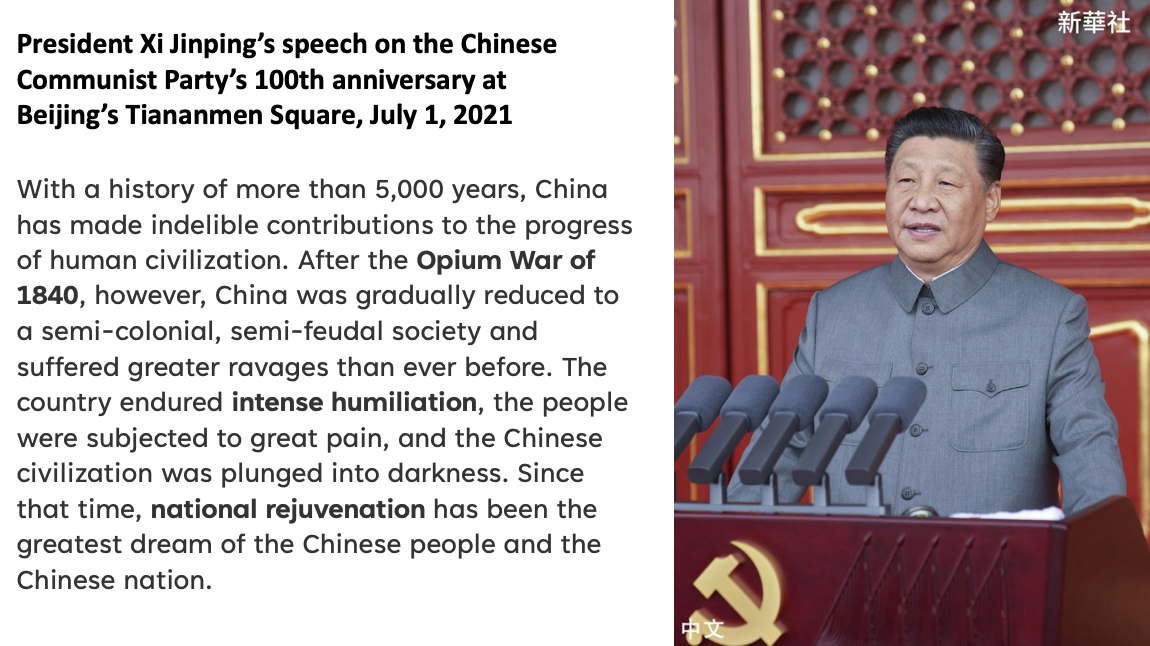
emphasize national rejuvenation by the community party
-
lots of current policy is driven by the fear of China losing to western power
- China’s modern-day policies are driven by this “never again” mentality.
From Taiping to Sino-Japanese War
Previously on the Qing Opium Crisis
- Canton System (1757-1839/42): regulated Qing’s trade with the West through Chinese hong merchants; restrictive yet worked well before the abolition of the EIC’s monopoly in 1834
-
Mccartney Embassy (1793) is Britain’s attempt to revise the Canton System, it features two expansionist empires, bringing competing notions of world order; taken as a misinformed example of British flexibility vs. Chinese rigidity and xenophobia
- British E. India Company ships opium to Qing, in exchange for silver and goods; Qing court orders opium confiscated from British and destroyed, triggering Opium War (1839-42), Treaty of Nanjing is first of many ‘unequal treaties’
Domestic Problems under Qing: towards later rebellion
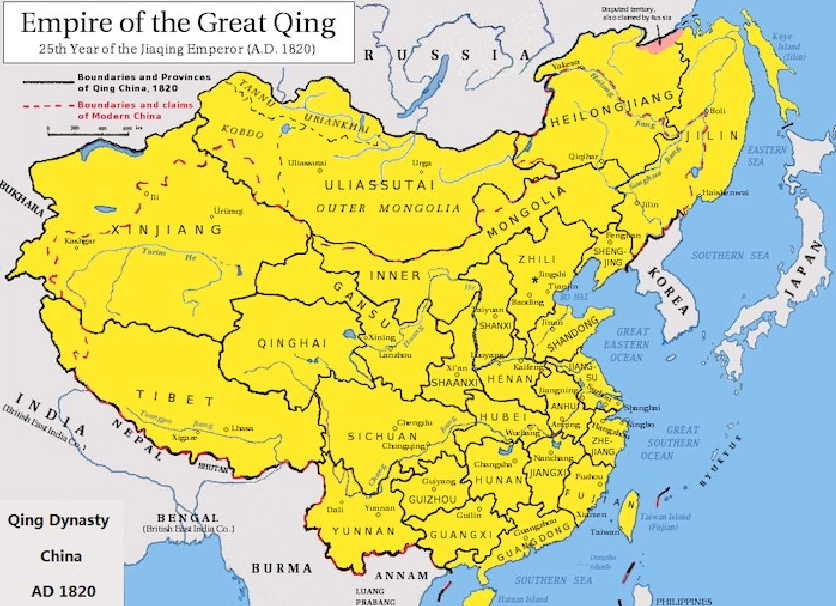
-
recall that Qing at its best time (High Qing) had large territory and high standard of living
- around the turn 19 century, government failures and international relations caused trouble
-
now, silver became scarce after 1800—especially due to silver outflows from China in order to purchase British EIC opium.
- silver scarcity meant more copper cash required to pay same taxes (in silver).
- in 1750: one tael of silver needed 780 copper cash
- in 1838: one tael of silver needed 1,650 copper cash.
- in effect, silver scarcity meant tax burden more than doubled
- people can’t pay → taxes more burden on taxpayers → tax evasion → less governments revenue → weaker government
- silver scarcity meant more copper cash required to pay same taxes (in silver).
-
source of internal unrest: limited resource and population pressure
- recall end of Ming had climate change and wars, where starting from Qing 1640 increases

- however, as more population amount of arable land is still fixed
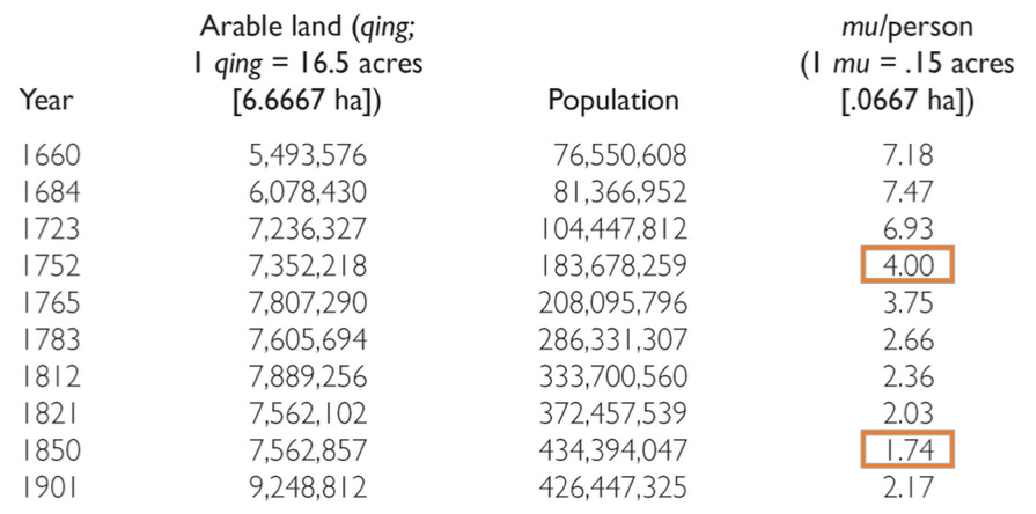
hence this lead to environment degradation and competition for resources
- unstable water ecosystems due to intense land reclamation
- deforestation = erosion, flooding, and desertification = 30,000 died in Kaifeng due to flooding. From 1645 to 1855, a flood almost every 1.89
-
talent glut = talent grows faster than the number of jobs available = students being jobless
- lower degree holders: 40k in 1400; 600k in 1700; over 1 million in 1800 (but gov only fixed 20k official posts)
- a social problem, hence causing those unemployed/underpaid people indignant, who later contributes to rebellion (combined with factors above)
-
two of the largest (many) civil wars that occurred in Qing in 19th century
- Taiping rebellion (1850-64)
- Nian rebellion (1851-68)
Outbreaks of Many Rebellions
-
White lotus rebellion (1796-1804)
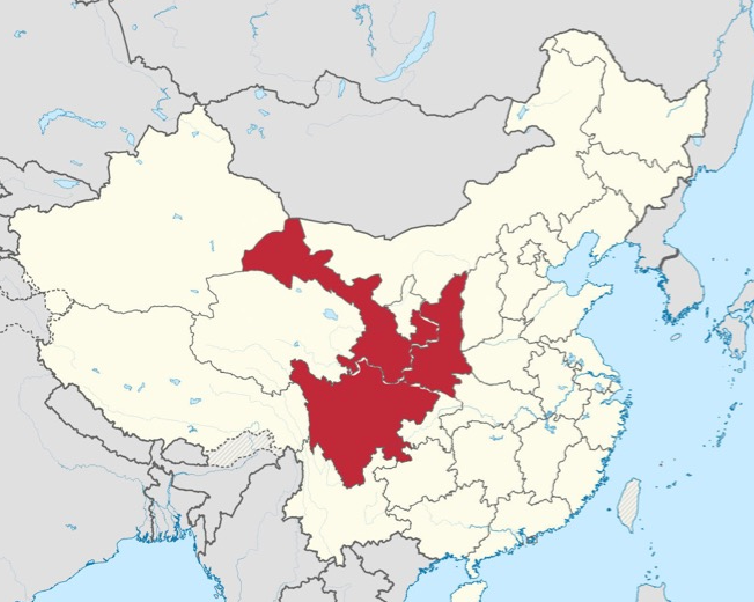
- White Lotus Society: a millenarian Buddhist secret society that first appeared in the Yuan dynasty
- help poor people, women played leadership roles
- political movement of grass roots society in the area shown above, and organized them into rebel movement
- again a result of economic strain, overpopulation, government corruption, etc
- impoverished peasants feeling indignant
- took 8 year to take them out and spent 5 years of government = further stress in government
-
Eight Trigram: another secret society
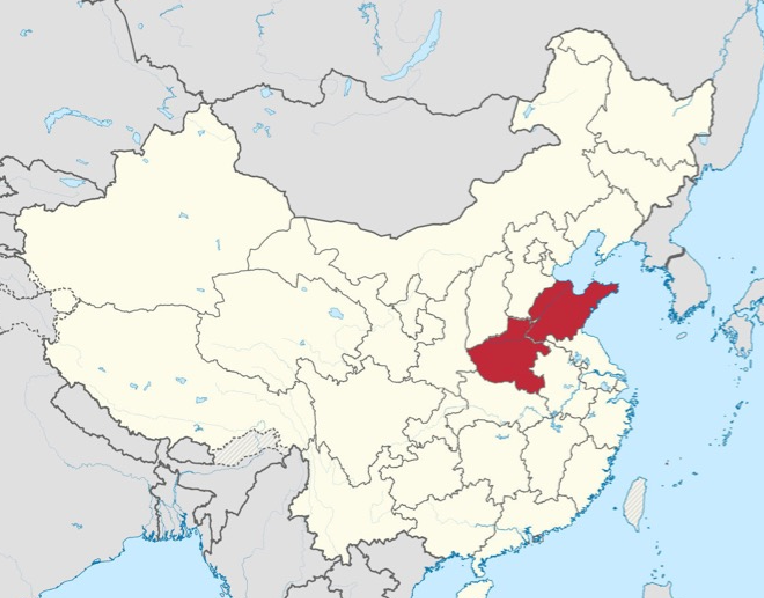
- in 1813, off-shoot of white lotus, again became a rebellion and many people died
-
Triads
- impoverished, hence people formed fraternity group = anti-Manchu and pro-Han
- smuggling activity and armed quarrels = quite militant group of people
-
Taiping Rebellion (more detail next)
-
other rebellions such as
- Nian Rebellion
- crushed by Generals Zuo Zongtang 左宗棠 and Li Hongzhang 李鸿章
- chef invented that General Zuo’s Chicken 左宗棠鸡 is from the same Hunan province, has nothing to do with Zuo Zongtang as person
- Panthay Rebellion: ethnic tension between Muslim and Manchu
- Ya’qub Beg Khante: turkey had Muslim establish autonomous regime, then suppressed by Zuo Zongtang
- Nian Rebellion
Structural Difficulties of Managing Crisis
- country too large and too populous
- many ethnic groups, and population outpaced administrative control
- limitations of bureaucratic efficiency before telegraph and rail (e.g. wrong info from local)
- competing national and local interests
- e.g., local officials overreported rebel threats to siphon funds.
Taiping Heavenly Kingdom
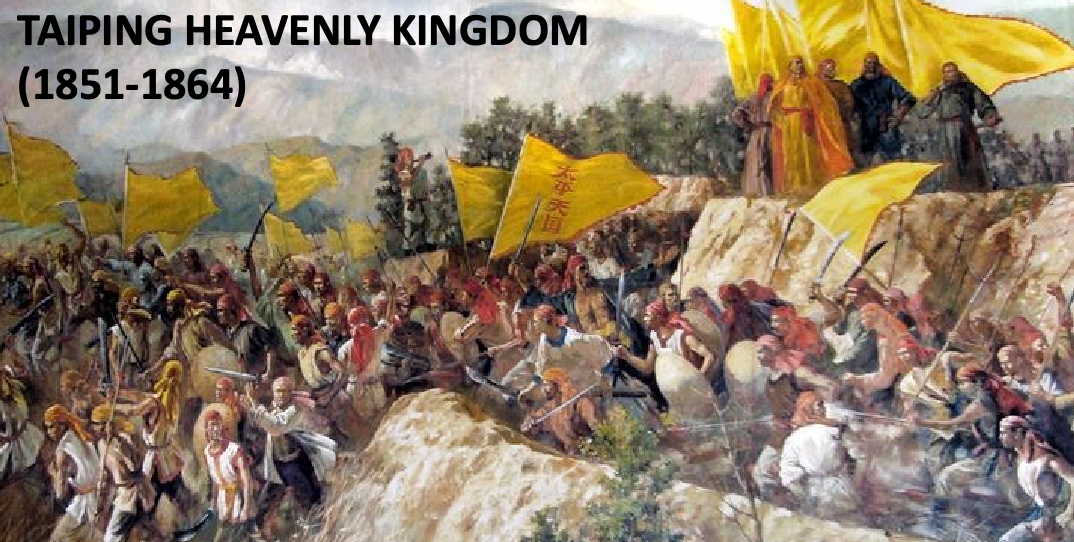
-
greatest revolution the world has yet seen
- people are positive about the revolution as being confident in the portrayal
- involves both peasants and failed exam takers, being indignant of the stresses
-
starts from the South: where may conflicts are from locals and Hakka (guest, ethnically Han who fled from north to South to evade from Xiongnu during the Han dynasty)

as newcomers, Hakkas are seen to compete resources and not welcomed by locals
- architecture themsleves with a hole is for defensive purpose = tension with the locals
- can be found in Guandong, Guangxi, and Fujian
-
Hong Xiuquan = a Hakka who organized the rebellion
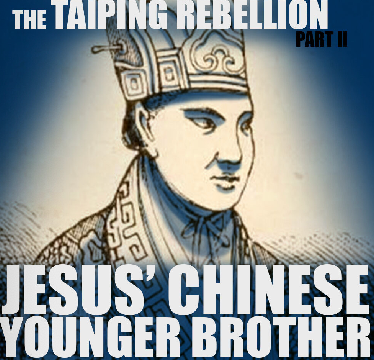
- from a poor family, failed examination four times.
- after failed the 3 time = had dream vision who when he was the second son of God, and brother of Jesus.
- then he
- smashed shrines dedicated to Buddhist and Confucian worship.
- added anti-Manchu strain to his preaching
- calling people to rise up and defeat the Manchu rulers

eventually they expanded and included people outside of Hakka and went all the way to Nanjing, and made it a capital. There, he urges for
- equalization of land holdings, equality of men and women
- equal exam but test on stuff such as translation of bibles instead Confucian classics
- Utopian view of the society
- from a poor family, failed examination four times.
-
Western reactions to Taiping: Taiping armies known for their puritanical zeal
- western (both english and american) missionaries hoped Taiping will succeed
- Hong Xiuquan claims to be related to Jesus = hope it will succeed and convert Chinese to Christian
- European liked to because it is radial and revolutionary (devotion of equality)
- English government: was neutral and they wanted just trade. So they took advantage of it help Chinese to quell the rebellion and in turn take more privileges in trade (heavily dependent in trading in China and US)
- note that US civil war is also during 1681 = less supply/trade from US; and similarly Taiping broke out in China
- English fear that their trade econ will collpase as they are major traders
- so they need to interfere somewhere = decided to intervene in China
- western (both english and american) missionaries hoped Taiping will succeed
-
but the largest credit of quelling Taiping still goes to Han Chinese officials
- note those Han Chinese gentry (not people who failed, who usually join rebels) have not much anti-Manchu thougths
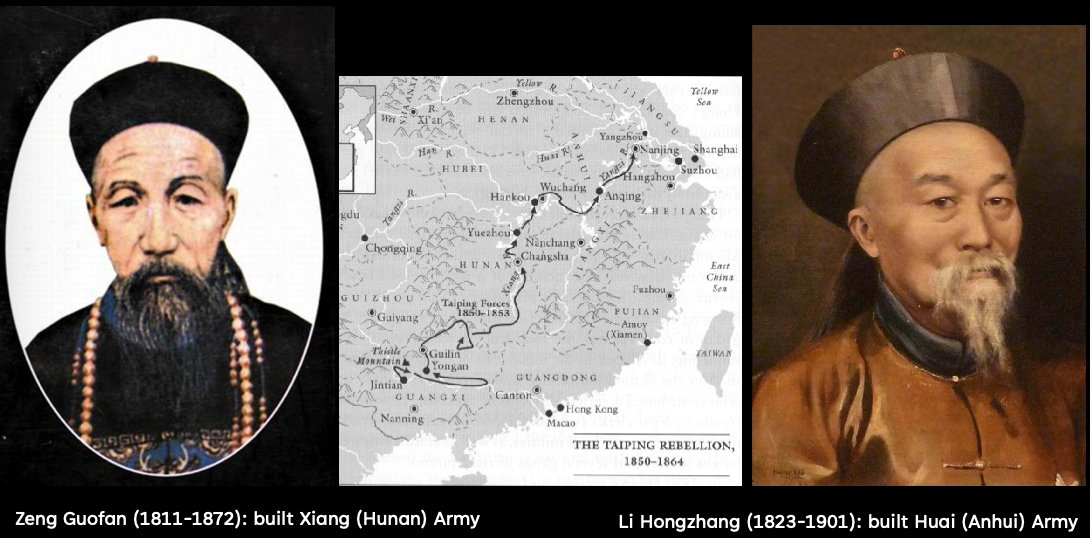
- he built an army from his home province = Hunan, hence Xiang Army
- financed through local gentry instead of Manchu lead government
- indicates a shifting (military) power to locals from the center/government (e.g. rise of Han)
-
the Taiping rebellion caused
- nation-wide: affected 16 out of 18 provinces
- unprecedented death toll: at least 20 million, up to 40 million. (by comparison, 620,000 died in the American Civil War)
- devastated the economically important lands south of Yangzi.
- so close to bring down the Qing dynasty, but didn’t.
- Recall that the pattern of rebellion replacing dynasty was: warlords rise in power to quell the rebellion, but after they compete and winner takes a new Dynasty
- Now, the army still remains to be part of the imperial army. But after this local provincial army became so strong = replacing Manchu garrisons as major power = shift of balance of power from government to the locals
-
this rebellion in total lasted 15 years, because Qing was also busy doing something else: fighting the Europeans
The Second Opium War (1856-1860). Also called Arrow War
-
right in the middle of Taiping Rebellion, China was also engaging with great Britain and France in addition to Taiping rebels
-
called Arrow War as it is named by the Ship in suspicion of piracy, how ever it is layer registered with English.
- British use this incident as pretext to start war, to add more unequal terms to treaty
- at the same time, a French was to be executed, hence French joined as well
-
ended with (second) defeat of Qing government to the English

resulted in
- burn down of Summer Palance (built for Qianlong and his successors and had European style architectures)
- more unequal treaty signed (1860 Convention of Peking), more ports opened, and huge indemnity. Some Chinese being taken as slaves to the Americas (indentured)
- Indentured servitude is a form of labor where an individual is under contract to work without a salary to repay an indenture or loan
Self-Strengthening Movement 1861-95
-
Qing fear that dynasty is going to collapse soon. Most urgently they wanted to reform the military and modernize with western tech
-
Li Hongzhang as an example:
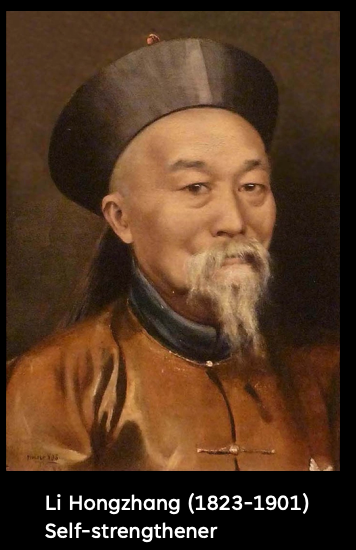
- equipped his army with imported weapons and developed modern provincial armies to defeat Taiping rebels.
-
this promoted Qing to
- set up factories to build western style weapons and warships
- education infrastructure to study western inventions/thoughts
- e.g. schools of science and technology in the Fuzhou shipyard and Jiangnan arsenal.
- school of foreign languages.
- study abroad programs in America, England, and France
-
knowledge about the west gradually improved
- e.g. chinese kids sent to educational mission to the US, including going to Yale and Columbia
- China then also added structures such as railways
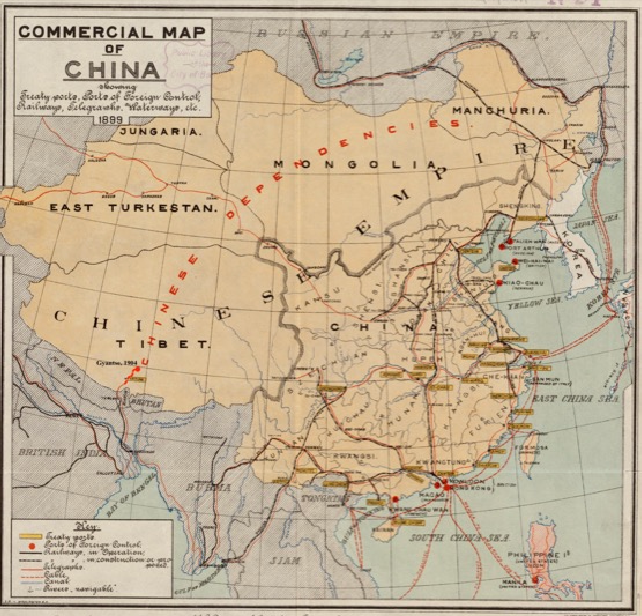
First Sino-Japanese War (1894-95)
-
though the self-improvement movement is doing well, until Japan defeated China
- before, China thought Japan is a little brother
- now, there is this humiliating defeat
-
Meiji emperor during the time: conflicted with Qing influence of Korea, and engaged into war
- Korea had long been China’s most important client state, but its strategic location opposite the Japanese islands and its natural resources of coal and iron attracted Japan’s interest.

-
war broke out mostly at sea, and Japan had China sign a treaty after China’s defeat

- term includes ceding Taiwan to Japan, and recognition of Korean Independence (short-lived, for it was colonized by Japan in 1910)
-
Qing realized that its nation is weak, but why even after self-improvement movement?
- some people see self-improvement movement as useless
- others attribute to problems such as corruption + lack of training and organization/literacy of Chinese troops despite advance in technology
regardless, the failure of the Qing in its late decades also contribute
From Empire to Republic
Previously on the late Qing crisis
-
Just prior to the start of the Opium War, silver shortage, ecological stress, have pushed Qing China into general economic crisis; peasant unrest and tax revolts proliferate
- Taiping Rebellion (1850-64): failed scholars espousing heterodox Christianity (Hong Xiuquan)
- had motivation for equality, but also the most destructive rebellion
- long lasting rebellions = resulting in Qing dynasty power is severely undermined
- Han provincial gentry come to aid of the dynasty, raised local armies to defeat Taipings
- also came to initiate self-strengthening movement to learn western technologies
- e.g. Li Hongzhang, builds western arsenals, weapons, and translate western texts.
- Arrow War (1856-60) at the same time, also tension with western especially the English and French
- Qing lost again to the Anglo-French force, and have summer palace burnt and more unequal treaties signed
- Sino-Japanese War (1894-1895): Chinese defeat again, still due to technology diff or lack of military organization/coordination? Don’t know.
- defeat has deep consequence = realizes how astonishing weak the empire was = Chinese loss of faith in Manchus
Hundred Day’s Reform: and later a serious of rebellions/reformed until 1911 Xinhai Rebellion 辛亥革命 ended Qing in 1912
-
when China lost Sino-Japan War, western realized Chinese weakness and were competing for territory.
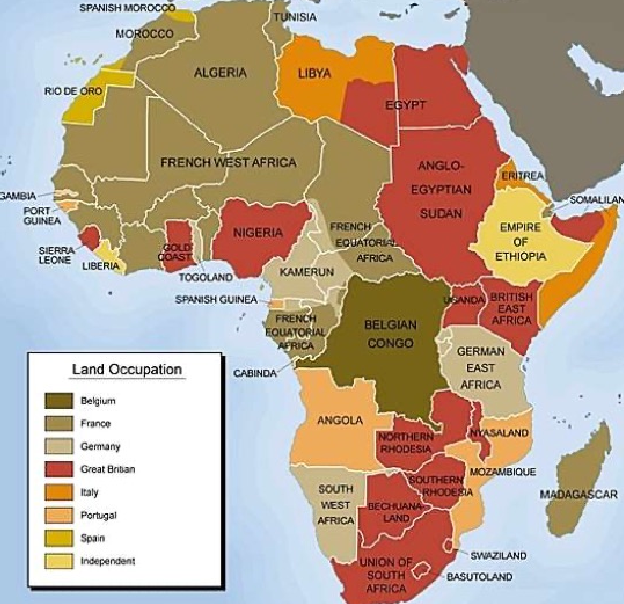
previously they were mostly occupying parts of South-East Asia. But seeing how easily China is defeated by Japan, westerns are also lurking and China is “cut up” during 1902-1903:
|
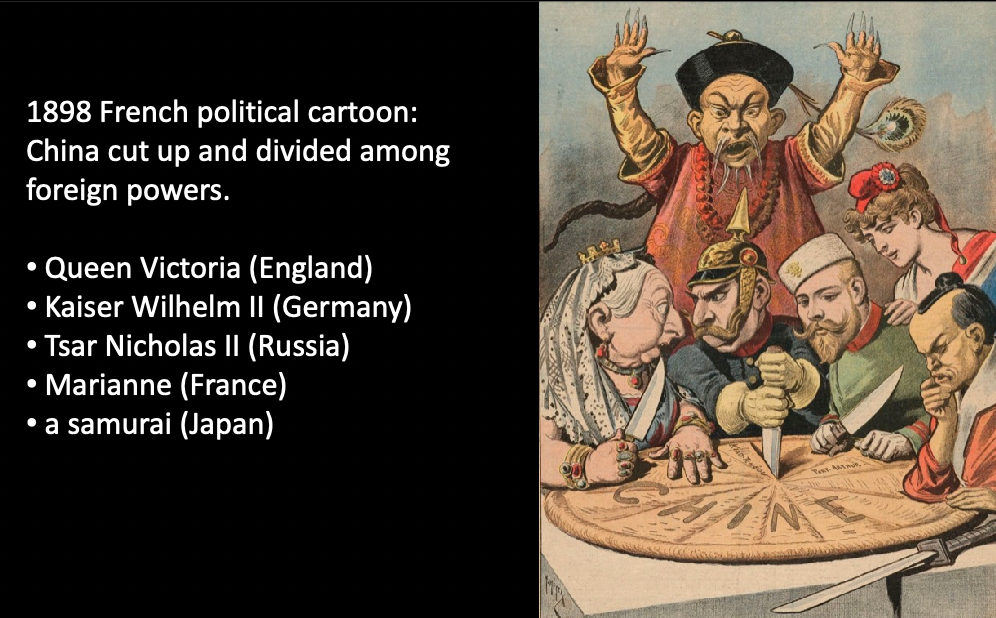 |
|  |
| :———————————————————-: | :———————————————————-: |
|
| :———————————————————-: | :———————————————————-: | -
How to save China? First attempt by Hundred Day’s Reform 戊戌(Wu Xu)變法
- was a failed 103-day national, cultural, political, and educational reform movement that occurred from 11 June to 22 September 1898 during the late Qing dynasty
- they heard the humiliating signing of Sino-Japanese defeat treaty, and became indignant
- in 1898, they launched a reform funded by Guangxu Emperor (but Cixi is power behind the throne = most powerful since Wudi)
- Cixi’s aim is to maintain her role and power, rather than help people. e.g. reform policies approved usually for self-serving purposes
- but in 1898 she allowed Guangxu to rule on his own, and K and L are asked to help with the reform
|
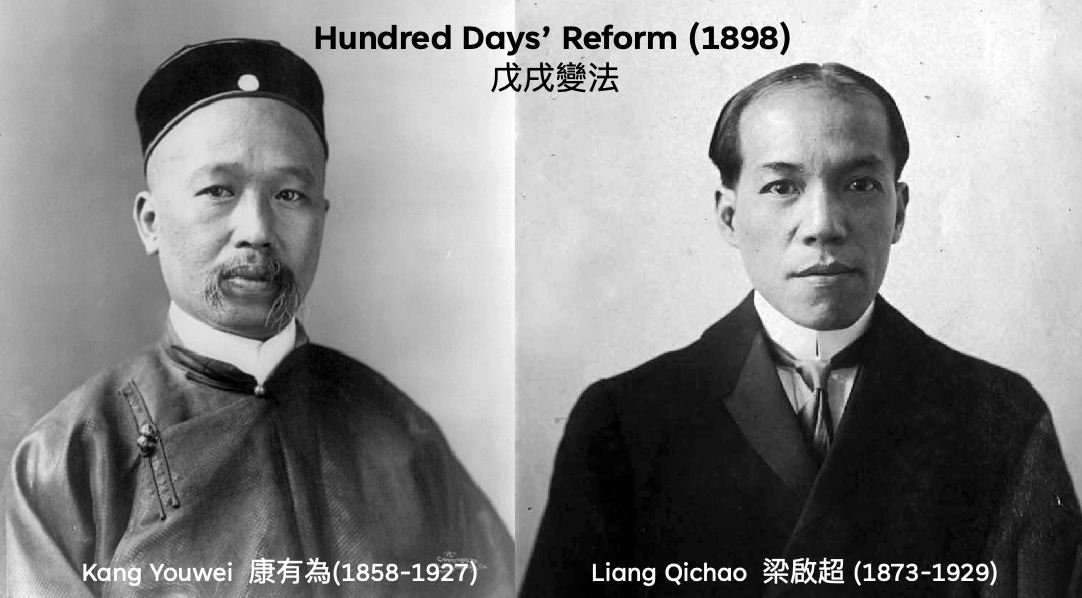 |
| 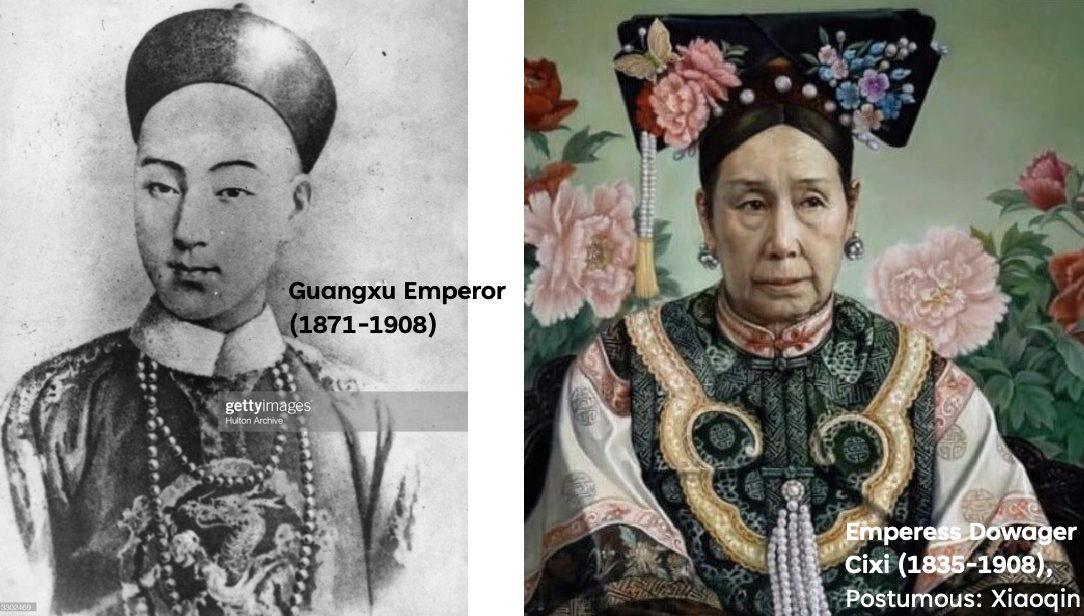 |
| :———————————————————-: | :———————————————————-: |
|
| :———————————————————-: | :———————————————————-: |- she then was afraid that Guangxu’s reform would undermine she power and Manchu, so locked up Guangxu and the reform proponents fled to Japan = hence only 103 days of reform
- Cixi = ended last chance of China to change peacefully
The Boxer Uprising (1900): purge foreigners and Christians. It was an anti-foreign, anti-colonial, and anti-Christian uprising in China between 1899 and 1901, towards the end of the Qing dynasty
-
Chinese blamed failing/natural disasters to be caused by foreigners: e.g. wrongly influenced Chinese culture and practices
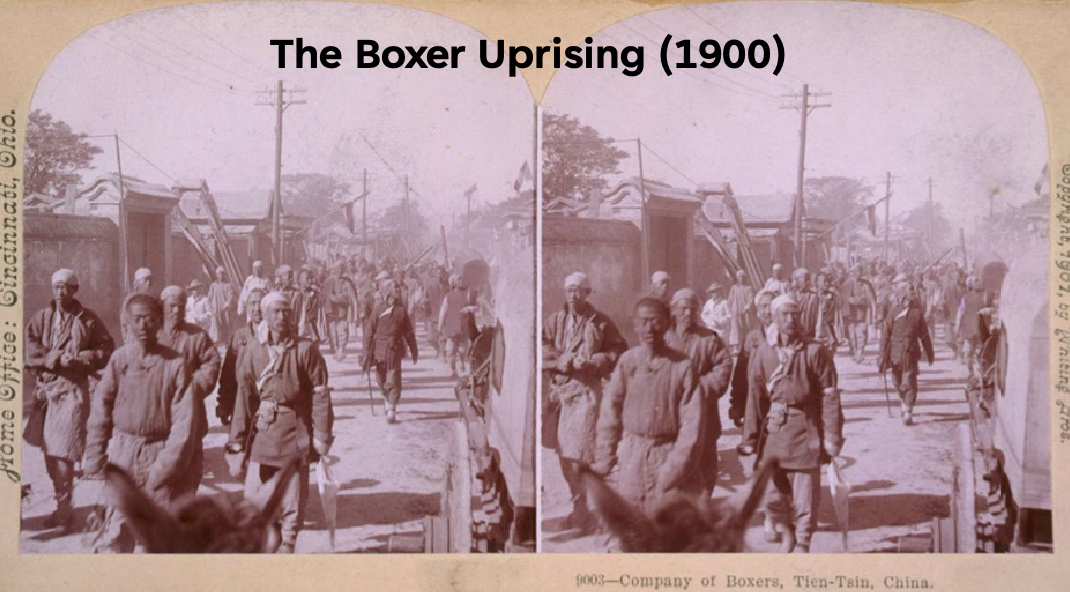
note that mostly peasants, and called “Boxer” because they mostly fight with martial arts
-
emerged also in 1898 after 100 days reform, and hates foreigners and converts (to follow foreign religions such as Christianity)
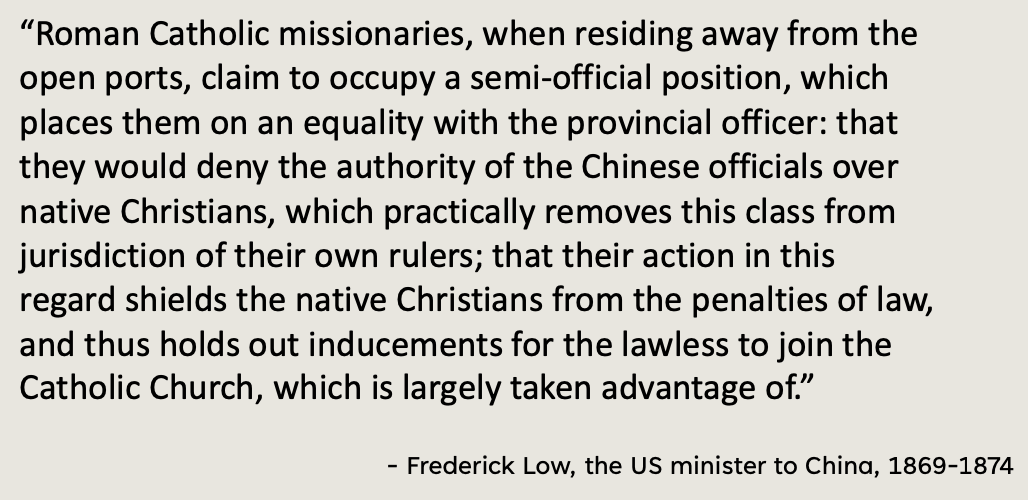
as you see it is technically “not a religion problem”, but the socio-economic problem that whoever converted to Christian had this unfair protection and foreign backing.
-
The events came to a head in June 1900 when Boxer fighters, convinced they were invulnerable to foreign weapons, converged on Beijing with the slogan “Support the Qing government and exterminate the foreigners.”
-
To counter this rebellion against foreigners, an Eight Nation Alliance of American, Austro-Hungarian, British, French, German, Italian, Japanese and Russian troops moved into China to lift the siege, and afterwards took over the palace in Beijing
|
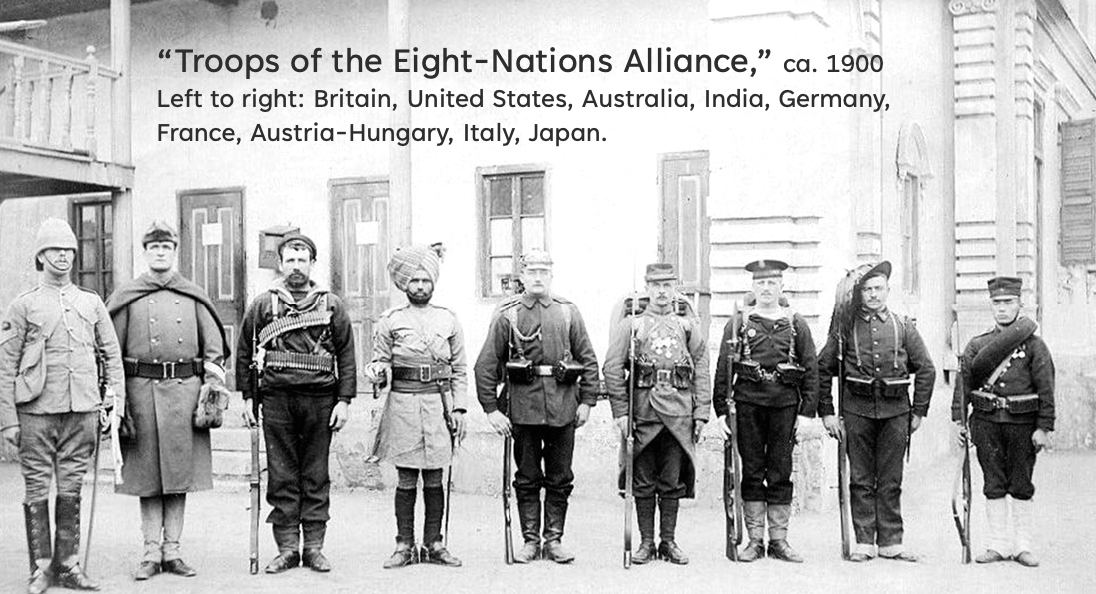 |
| 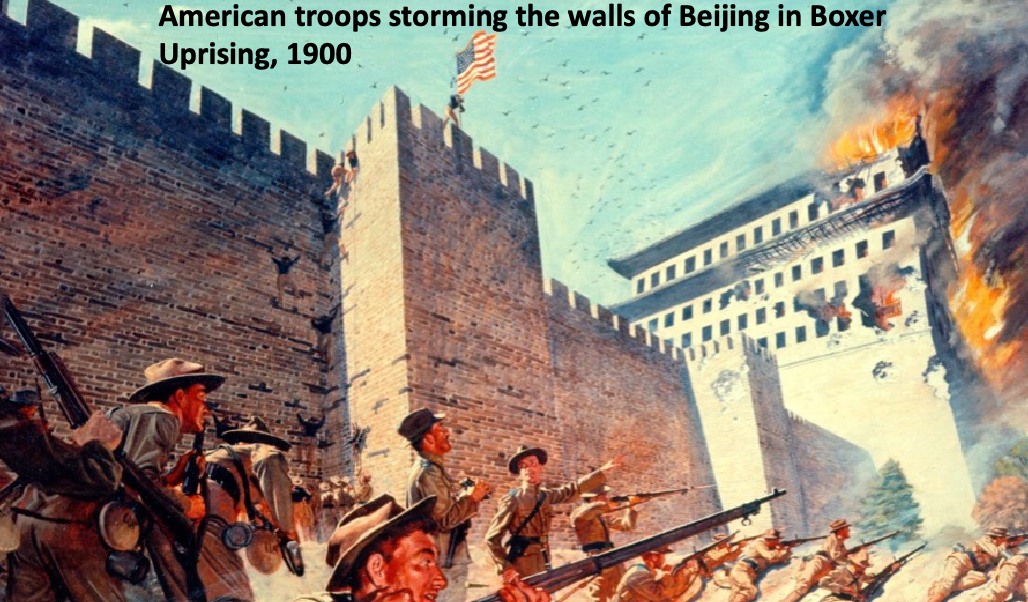 |
| :———————————————————-: | :———————————————————-: |
|
| :———————————————————-: | :———————————————————-: |and again Chinese’ loss lead to the Boxer Protocol in 1901 = total indemnity of 450 million
-
again spurred national debate of how China can still move forward
Third and Last Attempt to Save China: 1911-1912 辛亥革命
-
so far we see efforts starting from self-strengthening, 100 days reform, boxer uprising, all failed
-
people needed will reformation = Zou Rong, an anti-Manchu nationalist and published the Revolutionary Army journal
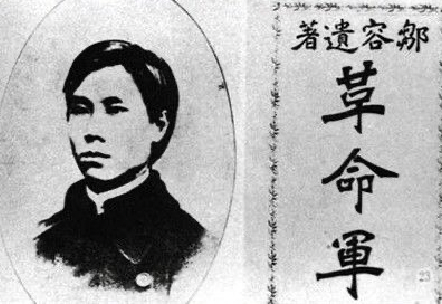
- convinced that wipe out Manchus is necessary, and called out in the Revolutionary Army journal for comrades
- advocated to establish the Chinese republic
-
Sun Yat-sen: the most prominent anti-Manchu revolutionary and a founding member of anti-Machu
- believes the best way to overthrow is to ally with the secrete society (e.g. the triad, etc)
- he spent most of the time traveling to many foreign grounds = to gain financial support to fund uprisings in China
- in 1905-12 he formed the Revolutionary Alliance = people with many different ideals such as socialist and republican, but all allied to overthrow the Manchu rulers and revive China. Later this alliance is transformed into Guomingdang (KMT)
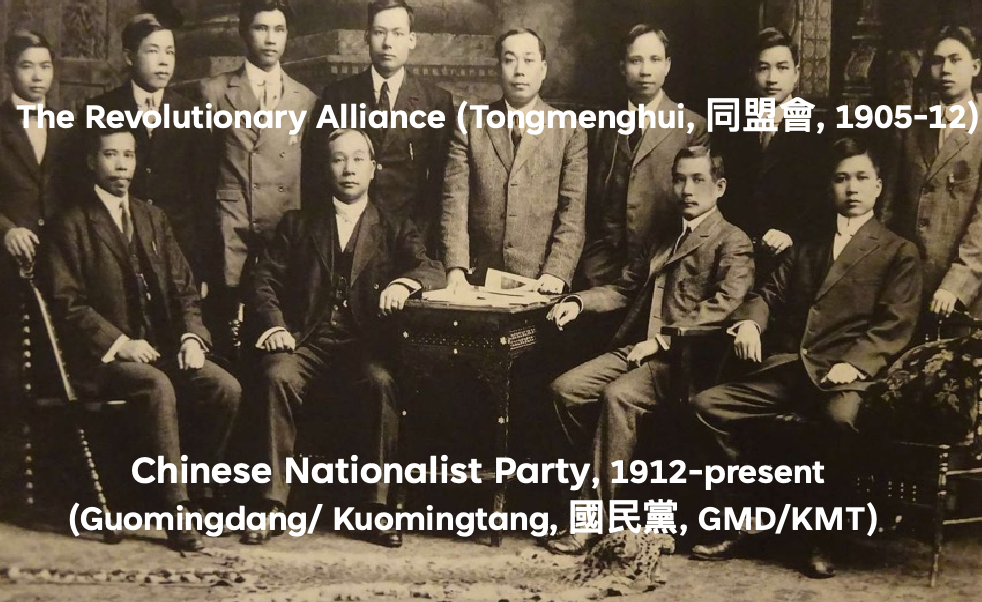
-
his three main principles are
- nationalism 民族主义 = members of the country to pay highest loyalty to the nation, rather than to family, etc.
- democracy 民权主义 = to him it means western constitutional government
- livelihood of the people 民生主义 = social welfare such as food, housing, transportation, and etc.
-
revolutionary broke out in 1911 (Xinhai Revolution), many provinces declared independence, and ended Qing in 1912

- Qing gave up in only 4 month
- “founding father” at that time was at Colorado, so some people say this title of “founding father” is overestimated
- On 1 January 1912, the National Assembly declared the establishment of the Republic of China, with Sun Yat-sen, leader of the Tongmenghui (United League), as President of the Republic.
-
But Sun quickly gave away the power to Yuan Shikai = no longer the Chinese coin of hole in the middle = western style coin
- because there was this promise that: Sun would resign in favor of Yuan Shikai, who would become President of the new national government, if Yuan could secure the abdication of the Qing emperor
- Even Sun had gather fund, had ideals, but he didn’t have much military power. Hence Yuan Shikai, who was appointed as the leader of the powerful Beiyang Army by Qing
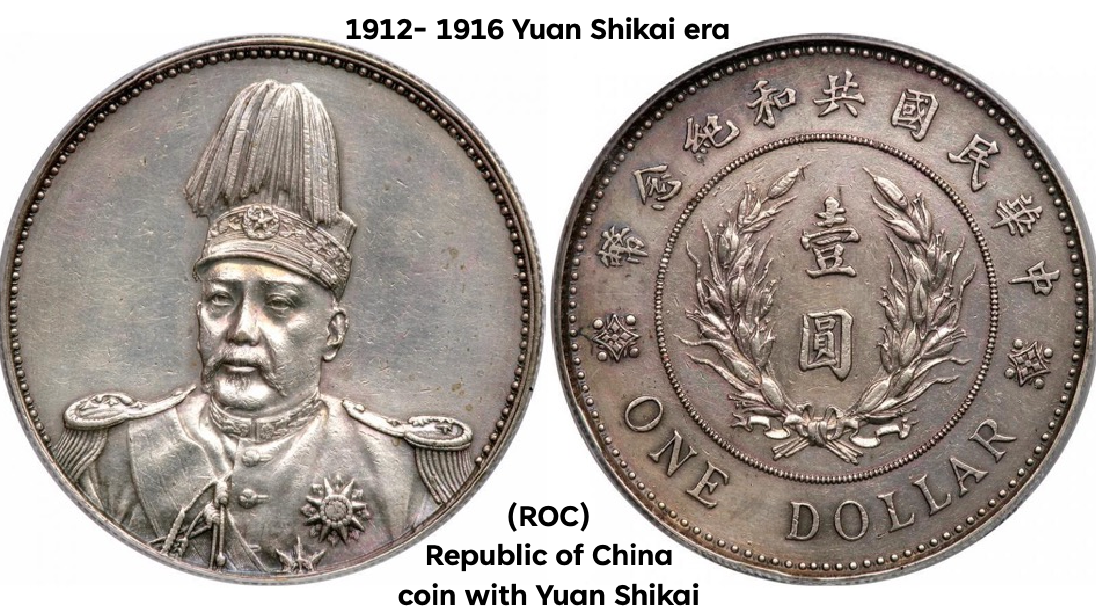
-
however, Yuan Shikai died early before he could consolidate a legitimate central government before his death in 1916, led to decades of political division and warlordism, including an attempt at imperial restoration = China entered again the unrestful warlord period (1916 - 1927)
Change of Beliefs and Practices in China during 1915-1926
-
a new periodical serving as a source of new ideology and heavily influenced the New Culture Movement and May 4th protests later
- The May Fourth Movement was a Chinese anti-imperialist, cultural, and political movement which grew out of student protests in Beijing on May 4, 1919. Students came to protest the Chinese government’s weak response to the Treaty of Versailles decision to allow Japan to retain territories in Shandong that had been surrendered to Germany after the Siege of Tsingtao in 1914.
- The New Culture Movement (Chinese: 新文化運動) was a movement in China in the 1910s and 1920s that criticized classical Chinese ideas and promoted a new Chinese culture based upon progressive, modern and western ideals like democracy and science.
-
the new periodical: New Youth was a Chinese literary magazine founded by Chen Duxiu and published between 1915 and 1926

-
founded by Chen Duxiu, advocate for individual freedom, and some major ideologies including rejecting Confucianism and crave the energy of youth (hence challenge the Confucius idea of young obey elders), promoting the young to think by themselves
-
advocated serious ideas in vernacular language v.s. in the past those serious writings tend to use classical styles
-
also had works from both Lu Xun and Mao Zedong
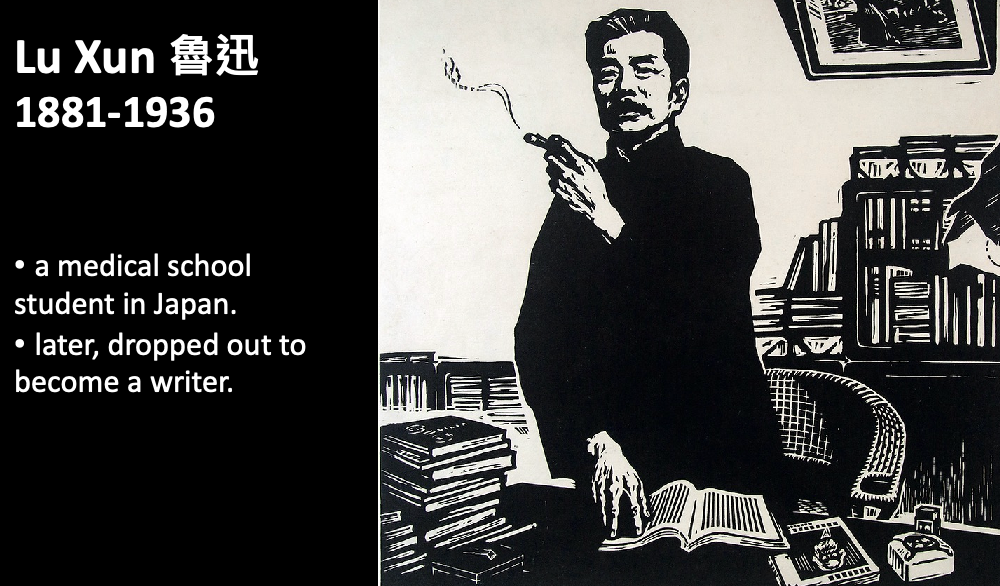
note that even though Japan is disliked due to its invasion, Japan was still the first choice of over sea study because it is a) close b) had modernized tech, and c) similar language
-
the journal also focused the adoption of Western ideals of “Mr. Science” (賽先生) and “Mr. Democracy” (德先生) in place of “Mr. Confucius” in order to strengthen the new nation (though science was better received)
|
 |
| 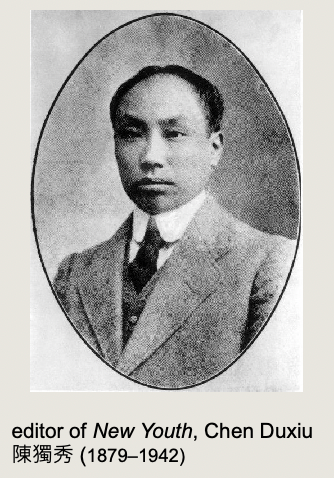 |
| :———————————————————-: | :———————————————————-: |
|
| :———————————————————-: | :———————————————————-: | -
-
during this period, many male also came out to speak for women’s rights (e.g. Lu Xun, a male and He Zhen, a female)
May 4th Protests, 1919
-
recall that China joined allies, so when German defeated territories in China should be handed back to China, but the result was disappointing that German concessions will be handed over to Japan due to the Treaty of Versailles decision
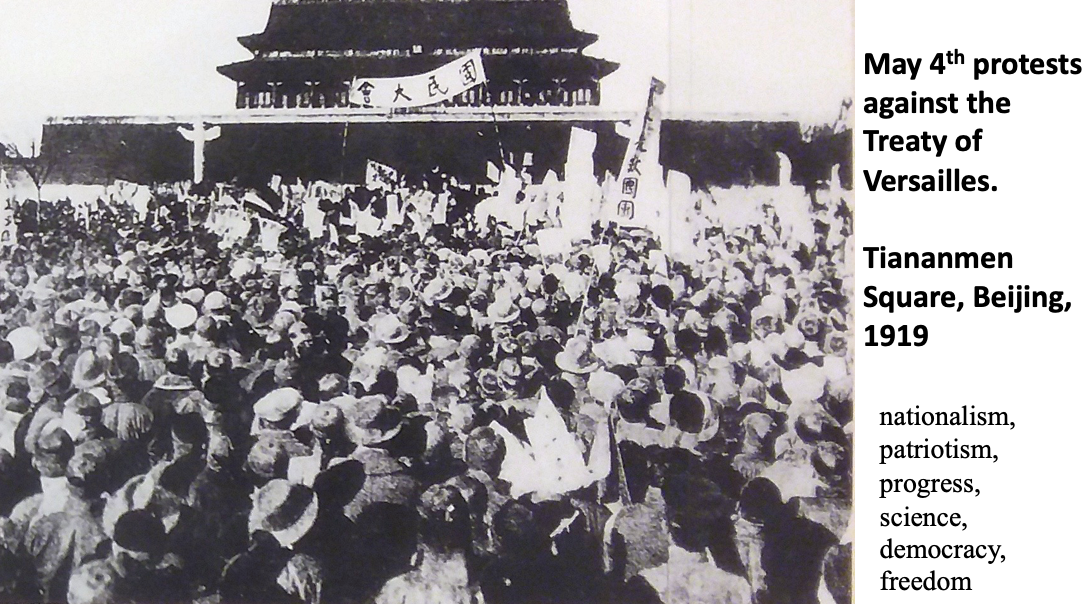
-
students were very angry = government arrested student leaders = general consensus is reached among the students such as nationalism, patriotism, science, and democracy, and enemies are imperialism, warlordism, etc.
Founding Chinese Communist Party (CCP) in 1921
-
at the same time WWI finished, where Marxism and Leninism is successful as seen in soviet union
-
also had anti-western, so liked soviet union a lot
-
Marxism and Leninism shows capable of revolution = exactly what China need
-
-
again founded by Li Daozhao and Chen Duxiu, for Maxism (Mao Zedong also influenced by Li Daozhao)
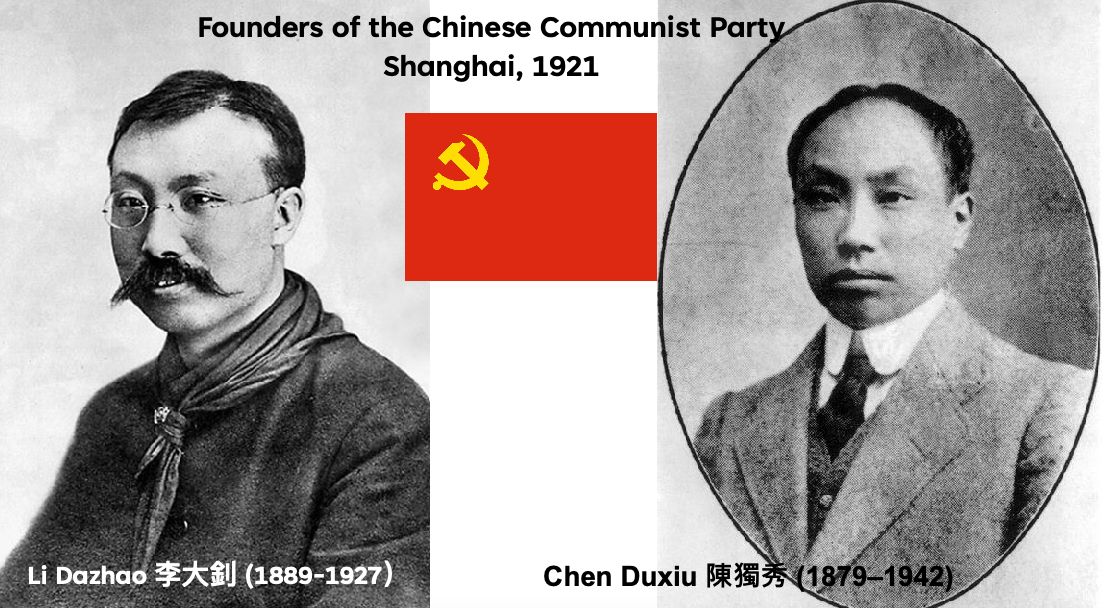
-
as we know later, under the leadership of Mao Zedong, the CCP emerged victorious in the Chinese Civil War against the Kuomintang, and in 1949 October 1st Mao proclaimed the establishment of the People's Republic of China.
Into the Modern China: a short review and preview of major events until 1949. In general, this is the period with much more foreign influence compared to past China/Dynasty changes. Another difference is that before: rebellion = restoration of past glory. But now modern = completely new motivation/ideology
- 1841 - first opium war
- 1860s - second opium war: imperial incursions and increasing christian missionaries, English, etc in China
- christian autonomy in local society here is central to the cause of the later boxer up-rising
- 1861-95 self-strengthening movement
- 1895 - Sino-Japanese war: watershed moment that losing to Japan (long seen as vassal state) made Chinese realizes its weakness + anti-Manchu
- 1898 - Hundred Days reform
- 1900 - Boxer rebellion. Can think of as “thugs” trying to bring back Chinese ruling. Quelled by the eight-nation alliance
- 1911 - Xinhai Revolution. Starting in Wushang - we’ve rebelled, who will join us - lots of provinces joined quickly
- in Feb 1912 Qing abdicated the throne, and Republic of China found 1912 Jan 1 (recognized in Taiwan), and Sun Yat-sen was the head
- however, Sun didn’t have military power but the ideals, hence collabed with Yuan Shikai = will be the new president if his military can help
- 1916 - 1927 warlord period of decentrailized china = time of disunity
- Yuan Shikai died in 1916 - very short reign before the government is coalesced
- 1921-24: KMT allied with CCP to march north and subdue the warlords and reunified the coountry
- In 1921, Chen Duxiu and Li Dazhao led the founding of the CCP with the help of the Far Eastern Bureau of the Communist Party of the Soviet Union and Far Eastern Secretariat of the Communist International.
- For the first six years of its history, the CCP aligned itself with the Kuomintang (KMT) as the organized left-wing of the larger nationalist movement.
- 1919 May 4th movement: territory not given back to China - highly literary movement of intellectuals such as Lu Xun and Cheng Duxiu trying to incorporate western ideas into China governing
- 1925: Sun Yat-sen died, who is a key figure making the alliance of CCP and KMT together, things goes wrong between CCP and KMT
- General Chiang Kai-shek, who became the Chairman of the Kuomintang after Sun’s death and subsequent power struggle in 1925, began the Northern Expedition in 1926 to overthrow the Beiyang government.
- In 1927, Chiang moved the nationalist government to Nanking and purged the CCP, beginning with the Shanghai massacre. The latter event forced the CCP and KMT’s left-wing into armed rebellion, marking the beginning of the Chinese Civil War
- basically KMT turned against CCP. Bear in mind that former had strongholds in cities, whereas latter whose ideal is communist only yet had supports by peasants in countrysides
- 1927 - 1949: a lot of upheaval and disunity
- CCP fighting with KMT, and Japan is also attacking
- The Second Sino-Japanese War (1937–1945, WWII) or War of Resistance (Chinese term) was a military conflict that was primarily waged between the Republic of China and the Empire of Japan.
- 1949 - CCP won and start of People Republic of China
- The Communists gained control of mainland China and established the People’s Republic of China in 1949, forcing the leadership of the Republic of China to retreat to the island of Taiwan.
The Nanjing Decade (1927 - 1937)
Some key terms in this period
- Fascism is a authoritarian and ultra-nationalist political ideology, characterized by a dictatorial leader, centralized autocracy, militarism, forcible suppression of opposition, belief in a natural social hierarchy, subordination of individual interest for the perceived good of the nation and race, and strong regimentation of society and the economy
- Imperialism is the state policy, practice, or advocacy of extending power and dominion, especially by direct territorial acquisition or by gaining political and economic control of other areas, often through employing hard power, but also soft power.
- Warlord Era
- The Warlord Era was a period in the history of the Republic of China (not PRC) when control of the country was divided among former military cliques of the Beiyang Army and other regional factions from 1916 to 1928.
- In historiography, the Warlord Era began in 1916 upon the death of Yuan Shikai, the de facto dictator of China after the Xinhai Revolution overthrew the Qing dynasty and established the Republic of China in 1912. Yuan’s sudden death created a power vacuum that spread across the country hence the warlord area.
- The Nanjing Decade:
- The Nanjing decade (also 南京十年; 黃金十年) is an informal name for the decade from 1927 (or 1928) to 1937 in the People’s Republic of China. It began when Nationalist, or even “Confucian Fascist” Generalissimo Chiang Kai-shek took Nanjing from warlord Sun Chuanfang halfway through the Northern Expedition in 1927. Chiang declared it to be the national capital despite the existence of a left-wing Nationalist government in Wuhan.
- The Nanjing decade was marked by both progress and frustration.
- The period was far more stable than the preceding Warlord Era. There was enough stability to allow economic growth and the start of ambitious government projects. Entrepreneurs, educators, lawyers, doctors, and other professionals were more free to create modern institutions than at any earlier time.
- However, the Nationalist government also suppressed dissent, corruption and nepotism were rampant and revolts broke out in several provinces; internal conflicts also perpetuated within the government. The Nationalists were never able to fully pacify the Chinese Communist Party, and struggled to address the widespread unrest and protests over their failure to check Japanese aggression
- The decade ended with the outbreak of the Second Sino-Japanese War in 1937 and the retreat of the Nationalist government to Wuhan.
There will be a lot on student protests, resistance, etc.
- Racism in Shanghai, Chinese tormented by powerful imperial forces.
- On going struggle between KMT, CCP, and the encroaching Japanese Imperialism
The Warlord Era
-
In 1915 Yuan Shicai with his Beiyang army has declared himself a new emperor, with the intention of finding new dynasty = Republic of China (the one with Sun Yatsen). But he died soon in 1916 so China is divided into regions ruled by separate generals and hence a warlord era
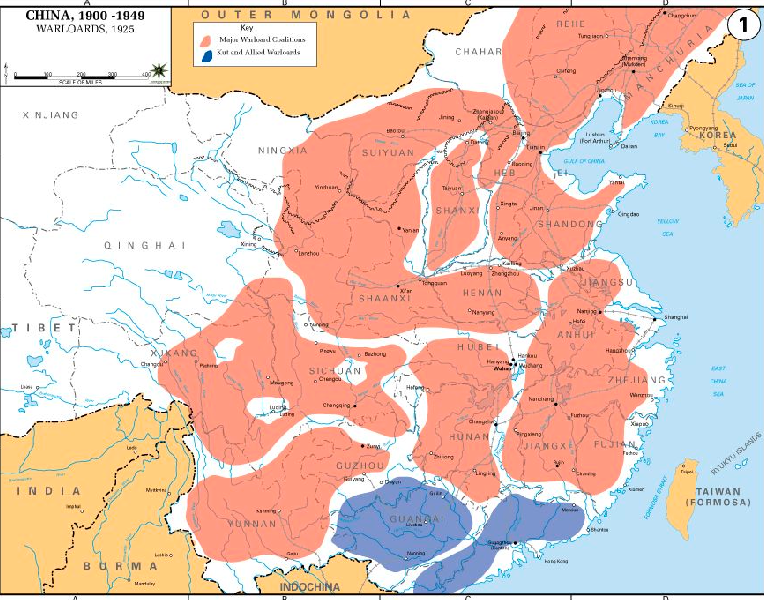
-
KMT revival with Sun Yat-sen’s return in 1917, and Communist continued their activities
- intense ideology struggle on both sides, nationalist v.s. communist
- on KMT, some were believing in fascist, but also some sympathizes with communist. Same on CCP’s side
-
but both KMT and CCP agreed on bourgeosis revolution (as with Marxism–Leninism in Soviet), hence they cooperate to create United Front
-
launch northern expedition against warlords in the north
-
before the beginning of expedition, some tension: nationist turn on CCP because of its popularity
-
e.g. May 30, KMT police opened fire, leading to strikes in many cities
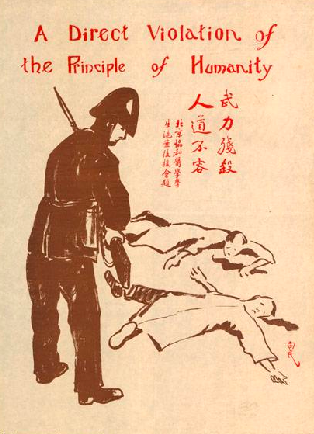
which made CCP grow even more in power/popularity.
-
-
In general, many KMT encouraged CCP to cooperate, while some right-wing from KMT do not trust CCP = cannot co-exist
-
hence KMT into two major wings: left wing sides with CCP, while right wing believes in militarism
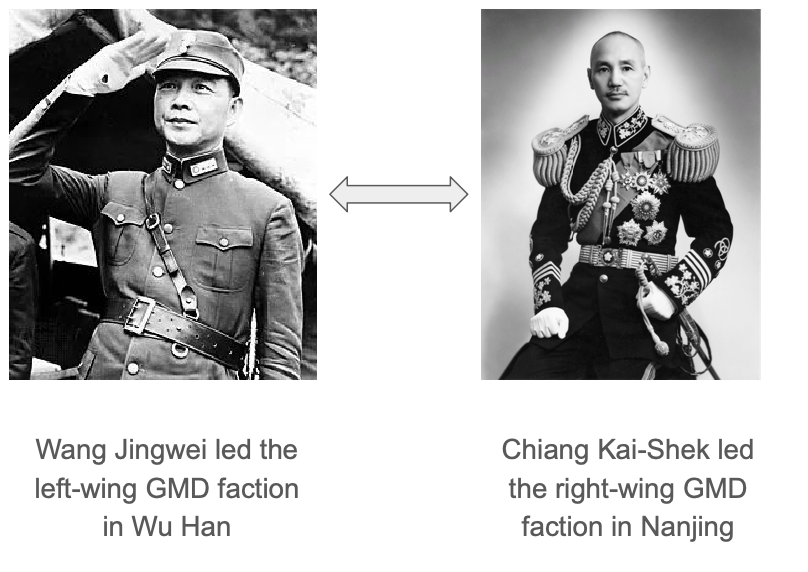
-
-
then in 1927 = White Terror = surprise attacks KMT arrested hundreds of CCP people and executed them = end of KMT support from people
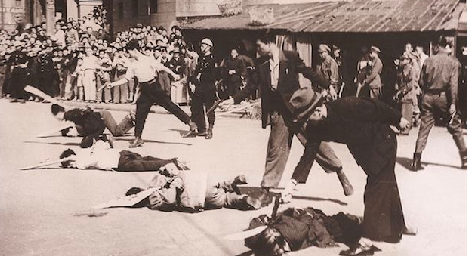
- many of these purges were executed by the more extreme factions in KMT
Shift towards an Agrarian Communism
-
believes that factory workers would be the ones for Communist revolution in China
- Mao’s emphasis of investigation = historical materialism from Marxist
- Firmly situated peasants as revolutionary subjects - and moved Chinese communism towards an agrarian focus.
- Saw ritualistic and violent struggle against class enemies as critical to revolution. This is a key difference from KMT socialists, who believed in “cooperatives to support “people’s livelihood”

End of the First United Front
-
CCP and KMT civil war, and CCP establish bases/soviets between 1927 to 1933 (the main one being Mao’s base)
-
worried by CCP’s growing support even in urban areas, Chiang Kai-shek launched four massive military campaigns to encircle and annihilate the Jiangxi Soviet, all of which were repulsed by the communists with their guerrilla tactics
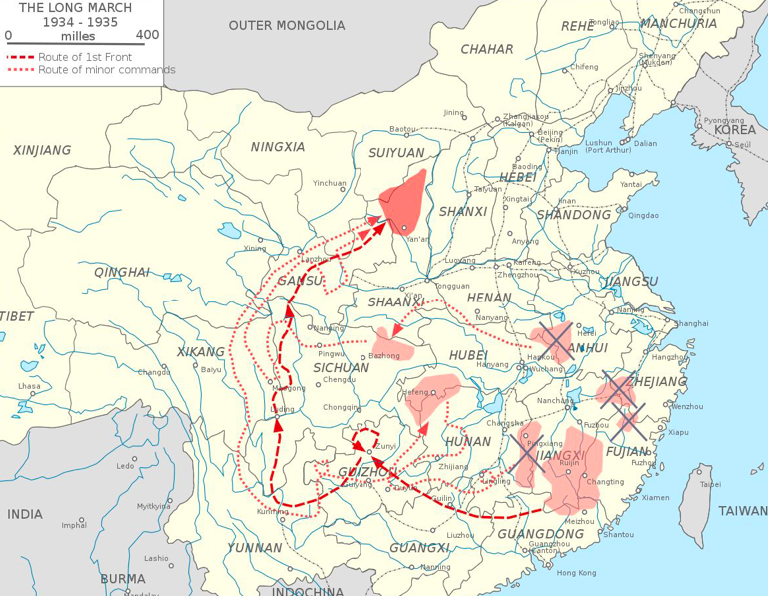
- however eventually CCP had to retreat, hence this long march shown above = recorded as their heroic struggle
Diff of KMT v.s. CCP in Economy
- China had econ problem such as famine before, and both parties are concerned about imperialism that Chinese cannot survive. But they differ in how to solve this problem
- nationalist believe
- accumulate national wealth, aim to annihilate dependencies on others hence social strength/self-sufficiency
- econ independennce = autarky = national prosperity is precondition for happiness of people
- wanted export lead economy. but this did not work with the great depression in 1932 (Wall street crush), so silk and tea lost much markets, and Japan’s influence made China grow (China exporting raw materials to Japan while Japan grows in technology)
- solve poverty by increasing production = need tech advancement = gives land questions
- Left-wing (Wang Jingwei and others) wanted to build up land cooperatives
- Right-wing (Chiang Kai-Shek) more concerned with military control of villages
- but there are conflicts with private industry, as they needs its own profit but nationalist needs national wealth
- does not care much about rural, but more central power
- CCP focused on rural organization, land reform, and class struggle
- global capitalism is the problem, and being semi-colonized = both landlords needs to be overthrown and wealth redistributed
- land reform program, redistribute to peasants
- focus a lot on women emancipation = e.g. local women can diverse their husbands, can own land, etc
- give peasants opportunity to read and write
Diff in Military mobilization
- Mao’s Red Army: Guerrilla warfare
- draw enemy into deep CCP territory such as mountains, so KMT becomes naturally split up due to landscapes
- red army are mostly consists of volunteers; and hold respect to civilians
- Eight points of attention: do not hit or swear others, be honest about buying and selling, etc
- helped increase popularity = a lot of support from peasants + China had a large size of peasants
- cooperate between army and people
- Nationalist
- advance altogether in one column, traditional approach
- more than half are soldiers, not civilians = Chaang Kai shek prioritized military discipline
Factions within KMT
-
two big groups controlling the executive functions, CC Clique and Blue Shirt
-
CC Clique v.s. Blue Shirts
-
CCP Clique return for Chinese past and vision for future. LHS has stuff from the past such as great wall, on the RHS tech advanced visions
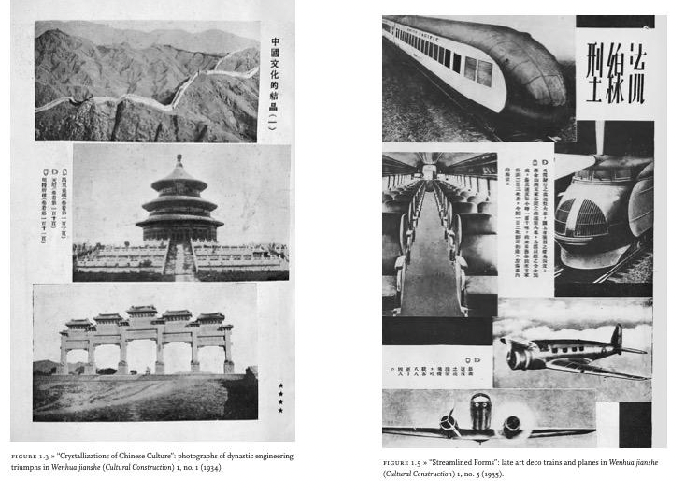
-
Blue Shirt: emphasize of strngth and strong young people
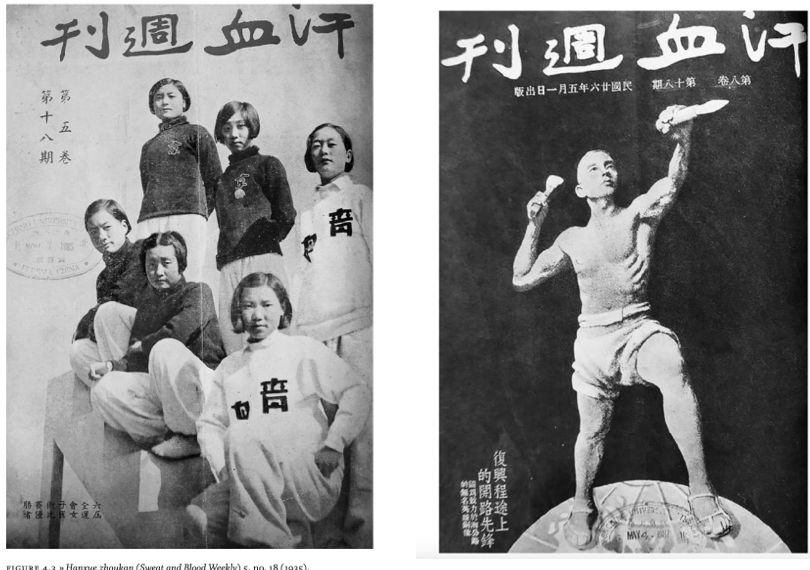
-
New Life Movement (nationalist)
-
draw on four virtues, advocate that these virtues penetrate peoples life
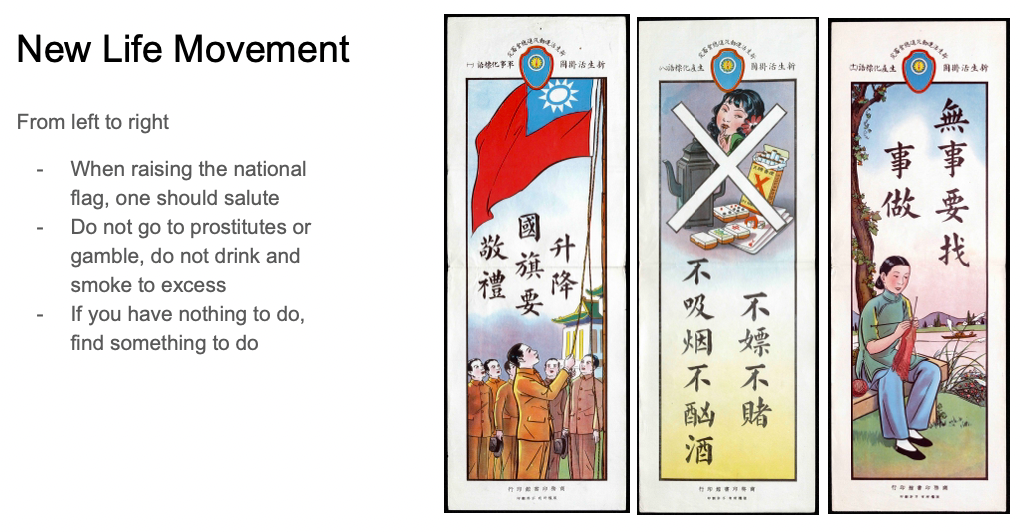
being productive at all times
-
then Chiang Kai-shek’s Speech incorporates ideas of convergence of militarism and being productive in life
- i.e. your individual behavior can hurt the wealth of the entire nation = you should stick to your social role. If everyone perform their social role, then not chaos and uprising associated with communist

- but still gained a lot critique from Confucianism:
- New Life Movement was an attempt to suppress individual freedom and to impose a rigid and authoritarian ideology on the people = the movement’s emphasis on obedience and conformity was at odds with the principles of Confucianism, which emphasize personal responsibility and self-cultivation.
Left-Wing Cultural Movement
-
Marxist texts, concerned with every day life, and experimented with new literary forms
- aim to make literature appeal with the masses = new form of short novels
-
two famous person her is Song Dingling and Mao Dun
-
but then left wing faced cracked down by 5 prominent being executed

-
overall had rich cultural production, both soft v.s. hard films as tools for politic education
-
KMT supported tabloits and defamed Cai Chusheng (a famous women actor at that time) and her movie = committed suicide
- impact on later communist cultural production
- Mao: importance of appealing to the masses
Japanese Imperialism: belief that Japan can relieve the influence from western by conquering Asian countries and ruling them
-
Japan controlled a lot of due to their control of the Manchurian Railway
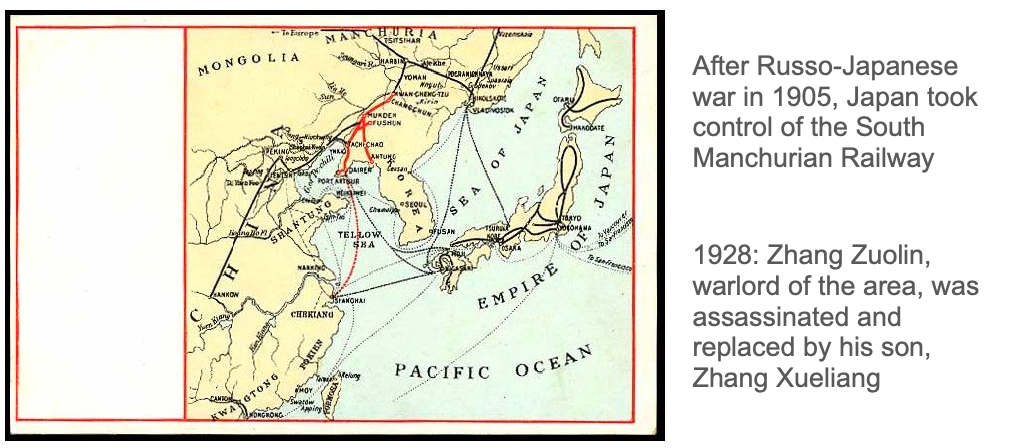
basically the 东北region
-
Battle ensued when plain clothes Chinese
- eventually Japan won the right to police Shanghai
- Japanese established Manchukuo within that Chinese region, which enraged CCP and KMT
-
then goes to the Second Sino-Japanese war
- and Paul Robeson and our national anthem
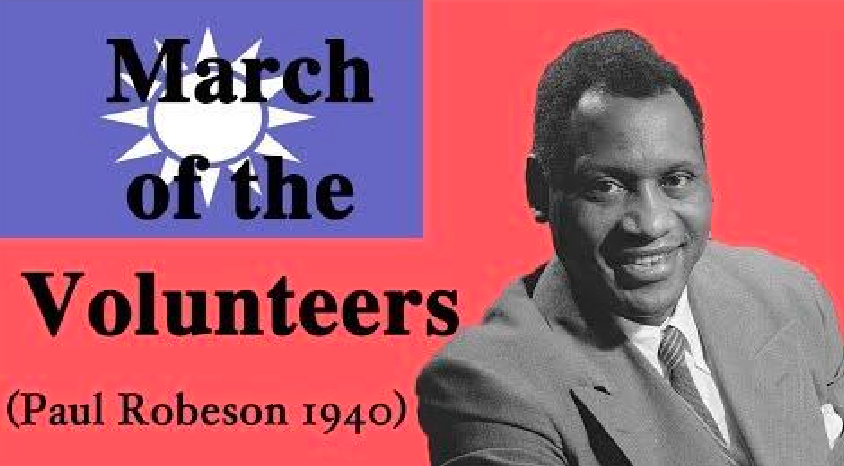
WWII and Second Sino-Japanese War (1937-1945)
Previously on the Republican Era
- 1911-16 The first Republic
- first Sino-Japanese war and Boxer protocol are national traumas
- 1911 revolution: replace Qing and new government, and Sun Yat-Sen established the first Republic of China
- Sun soon replaced by Yuan Shicai, who had strong military. However Yuan died early in 1916, leading to warlord era
- 1916-27 The Warlord Era
- Centered around Beijing, the New Culture Movement sees a new generation of intellectuals question the Confucian basis of social, moral, political traditions. Believe that those are the reason for Chinese’fall, and emphasized on Mr. Science and Mr. Democracy
- May 4th Movement (1919) politicizes intellectuals (anti-imperialist movement)
- CCP founded 1921 in Shanghai.
- 1927-37 The Nanjing decade
- Chiang Kai-Shek (CKS) succeeded Sun and became KMT leader, and with (appear) allied with CCP to go on northern expedition to re-unite China from the warlords = First United Front
- CKS with his strong military belief never trusted CCP, hence white terror in 1927, and CCP flee
- retreated to Jiangxi Soviet. Stop of Soviet Union’s support to KMT, and Mao start to emerge as the leader in CCP
- then KMT then tried campaigns to get rid of Communist in Jiangxi, and in the 4th occasion, CCP fled despite their encirclement and went on a long march (34-35) all the way to Yan’an, Shaanxi
- only a bunch of true faithful people in CCP left (a lot key figures including Mao, Zhou Enlai, Xi’s father, etc). But they collected lots of supports along the way
- CCP regroups, builds peasant support through land reform, uses mass movements to accomplish objectives
- hence overall a unity after the chase, and KMT + CKS become the major government in China. CKS’s view is highly militaristic and productive, that through discipline in a top-down approach we can make ourselves stronger
- New Life Movement to impose discipline and morality on China’s society. Inspiration drawn from the Italian fascist and German Nazi movements
- also many cultural influence during the time: leftist intellectuals making films, etc.
Some Major Events in this period
In 1931, the Mukden Incident helped spark the Japanese invasion of Manchuria. The Chinese were defeated and Japan created a new puppet state, Manchukuo; many historians cite as the beginning of the war
- The beginning of the war is conventionally dated to the Marco Polo Bridge Incident 卢沟桥事变 on 7 July 1937
- Since the Japanese invasion of Manchuria (东北region) in 1931, there had been many small incidents along the rail line connecting Beijing and Tianjing.
- On this occasion, a Japanese soldier was temporarily absent from his unit, and the Japanese commander demanded the right to search the town for him. When this was refused, other units on both sides were put on alert; with tension rising, the Chinese Army fired on the Japanese Army, which further escalated the situation, even though the missing Japanese soldier had returned to his lines.
- following this incident, Japanese scored major victories, capturing Beijing, Shanghai and the Chinese capital of Nanjing in 1937, which resulted in the Rape/Massacre of Nanjing (南京大屠杀) beginning on December 13, 1937
- As the Japanese approached, the Chinese army withdrew the bulk of its forces since Nanjing was not a defensible position. The civilian government of Nanjing fled
- The perpetrators also committed other war crimes such as mass rape, looting, and arson. The massacre was one of the worst atrocities committed during WWII
- Due to multiple factors, death toll estimates vary from 40,000 to over 300,000, with rape cases ranging from 20,000 to over 80,000 cases
- Following the Sino-Soviet Treaty of 1937, strong material support helped the Nationalist Army of China and the Chinese Air Force continue to exert strong resistance against the Japanese offensive. By 1939, after Chinese victories in Changsha and Guangxi, and with Japan’s lines of communications stretched deep into the Chinese interior, the war reached a stalemate.
- in August 1940, the United States supported China through a series of increasing boycotts against Japan, culminating with cutting off steel and petrol exports into Japan by June 1941. Additionally, American mercenaries such as the Flying Tigers provided extra support to China directly.
- In December 1941, Japan launched a surprise attack on Pearl Harbor, and declared war on the United States. The United States declared war in turn and increased its flow of aid to China
CCP v.s. KMT: grassroots v.s, organizations
-
some degree of fluidity/flexibility within the party, but overall differ in how to restructure/rule
- CCP: socialist, redistribution of land and peasants can now on lands
- appeal to peasants and grassroots
- start revolution by helping the peasant, and note that China at that time had a lot of peasants/is rural
- KMT=nationalist=Republic of China: in a more extreme way, a bit fascist and military society.
- Hence new cultural movement, refining and strenghening China in a militaristic way; also a lot of focus on productivity and utilitarianism
- both had some influence from Soviet Union, e.g. Marxist-Leninism
- The Communist International (Comintern), was a Soviet-controlled international organization. They sent advisers and aids to help with revolutions
Japanese Imperialism
-
South Korea asked Japan to ban the rising sun flag during Olympics, which is also the war flag of imperial Japan (which occupied Korea and part of China)
|
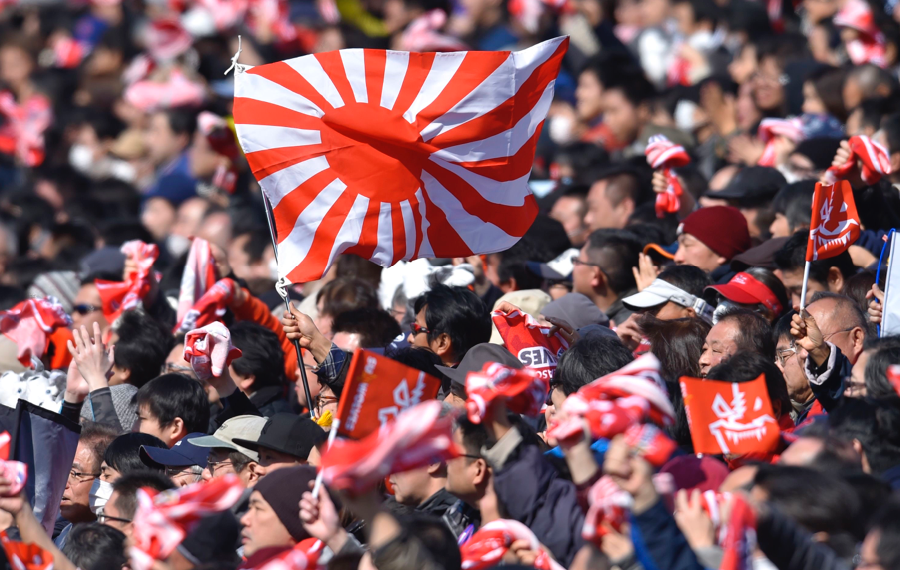 |
| 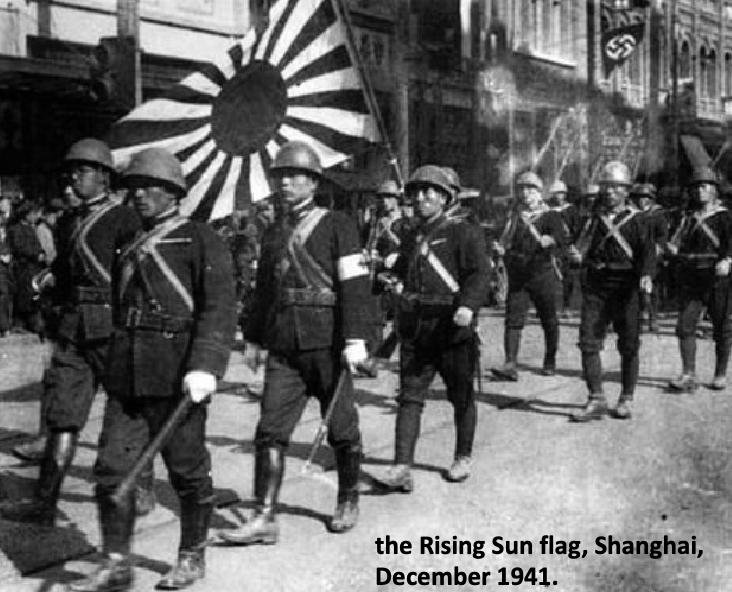 |
| :———————————————————-: | :———————————————————-: |
|
| :———————————————————-: | :———————————————————-: | -
recall that before, Qing has lost Korea territory and Taiwan to Japan; Japan became competitor with Russia for influence in China in the north
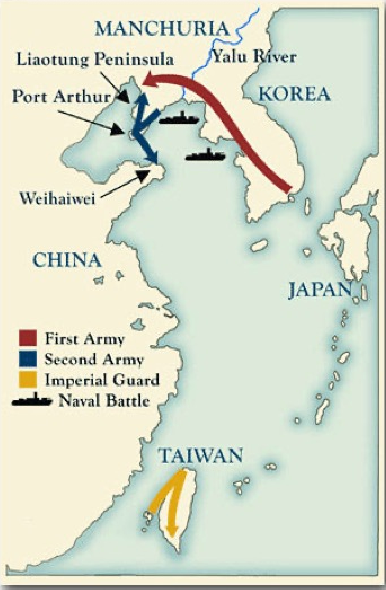
- surprisingly, they even defeated Russia in the northern territories in China = 1904-5 the Russo-Japanese War
- in 1931 the Mukden incidence and established Manchuko满洲国;
- Japan really took this territory as its colony; made a lot of investments; therefore it could be the most prosperous area in China at that time
- 1937-1945; Japan tried to encroach into deeper China, and hence second Sino-Japanese war
Marco Polo Bridge Incident: July 7, 1937
-
CKS wanted to first unify Chinese = open non-resistance policy = became very non-popular. He is then kidnapped and forced to ally with CCP to fight against Japan
-
hence high tension between Japanese and Chinese with this minor Marco Polo Bridge Incident = triggered second Sino-Japanese war
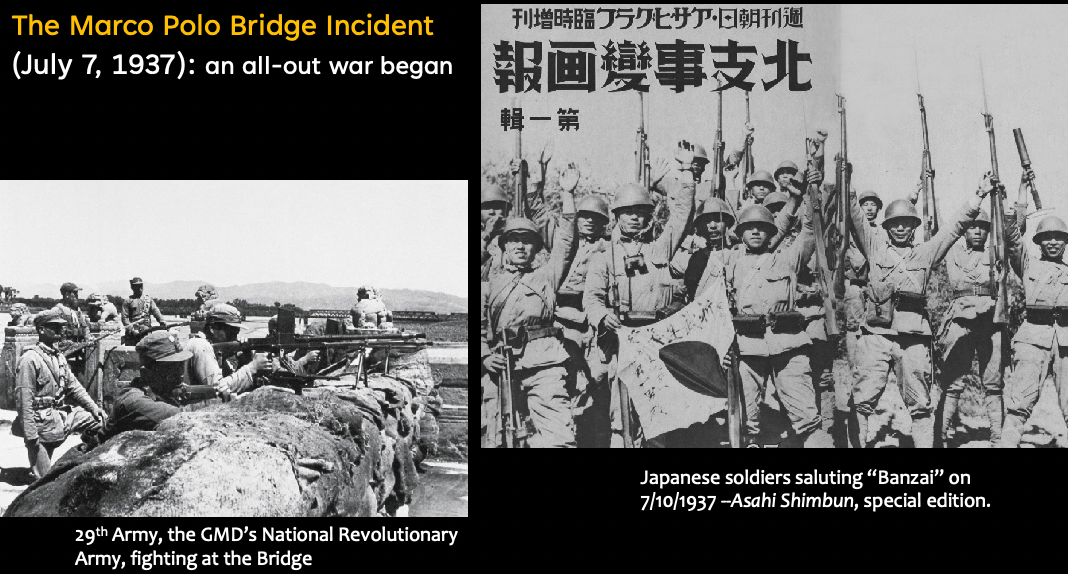
- after that Japan attacked Beijing, Tianjing, etc.
First Phase of Sino-Japanese War: Battles
-
Shanghai is an main source of Nationalist revenue + strategic position = proximity to Nanjing;
-
Shanghai had significant western living in there; but their policy is to not interfere at the moment
-
However nationalist eventually lost, Battle of Shanghai (1937)
- first and fiecest of the 22 major enegagements, lasted three month before Chinese failed
- the bloody Saturday + anti-Japanese feelings
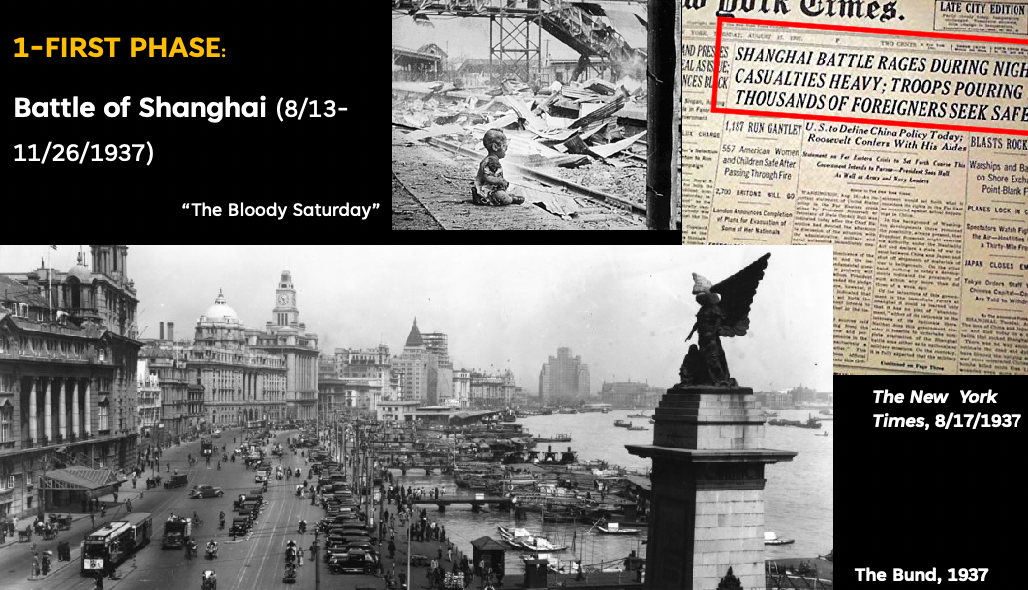
-
big defeat of China, CKS lost over 30% of elite German-trained divisions troops (later on contributed to CCP’s victory during civil war)
-
however, at least pushed some unification of China (some warlords) to face the Japan troops
First Phase of Sino-Japanese War: war crimes
-
Nanjing Massacre and Rape of Nanjing. Japan failed to conquered Shanghai quickly= angered Japanese, hence when conquering Nanjing this happened
- Japanese troops went on rampage for six weeks
- 20,000 - 80,000 women and girls of all ages were raped, many of whom were mutilated or killed in the process.
- 200,000 - 300,000 civilians and POWs were killed.
- a woman writer recorded this, who turned the school into a sanctuary, and her diaries records those war and atrocities
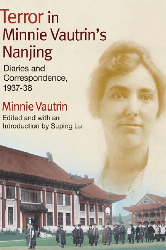
up until now, they still had not apologized for this, compared against Germany = Japanese acquired reputation for cruelty
-
“Comfort Women”, i.e. sex slaves; ensure an isolated group of women to satisfy solider’s sexual eneds
- an estimate of 200,000 young women and girls were forced into this service; mostly Korea, but also Chinese, Japanese, etc
- one women assigned for 70-80 soldiers before battle
- again, Japanese arguments were that they were paid prostitutes; but many are not/are abducted
-
Human Experiments and use of Biological Weapons: using diseases as weapon
-
like Nazi’s, Japanese conducted experiments with human = death camp = infected healthy subjects with various diseases and observe them; operating them without anesthesia
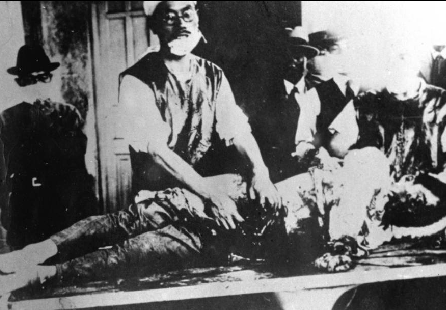
-
many biological weapon researchers escaped punishment and went to continue research as other countries feel worried if they are behind; questions of medical ethics = had no ethical standards setup yet
-
First Phase of Sino-Japanese War: Man-made Yellow River Flood
-
nationalist government made a desperate decision to breach the dam = cause the flood to stop advancement of Japanese troops
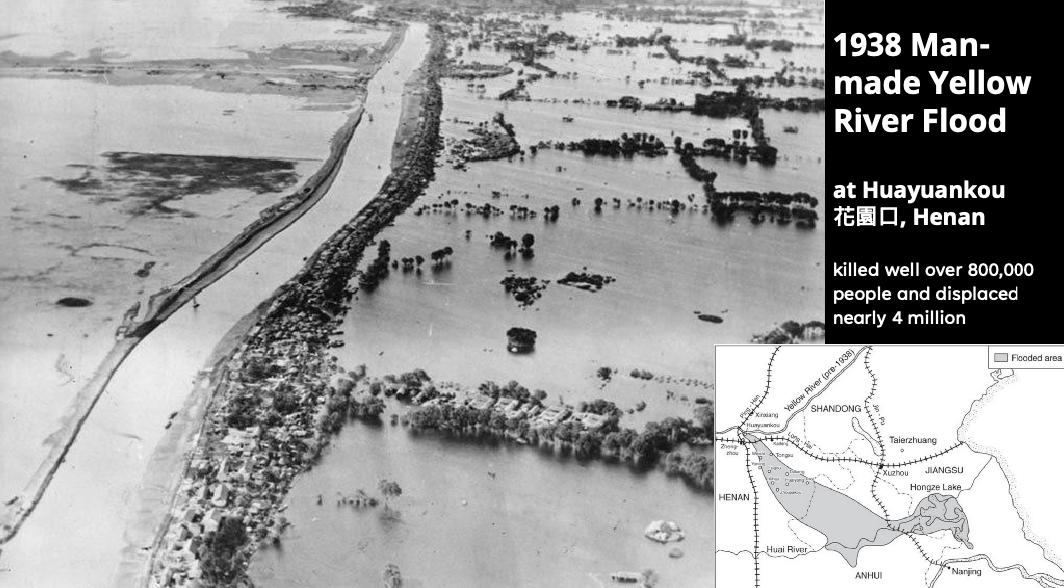
-
flood inundated a lot of land and killed over 800,000 people in those provinces (unexpected by the government) = sacrificing million of lives to stop Japanese = though only stopped them for five month, and later continued to capture Wuhan
Second Phase: Stalemate 1939-41
-
blue is territory occupied by Japan, and nationalist government moved to interior
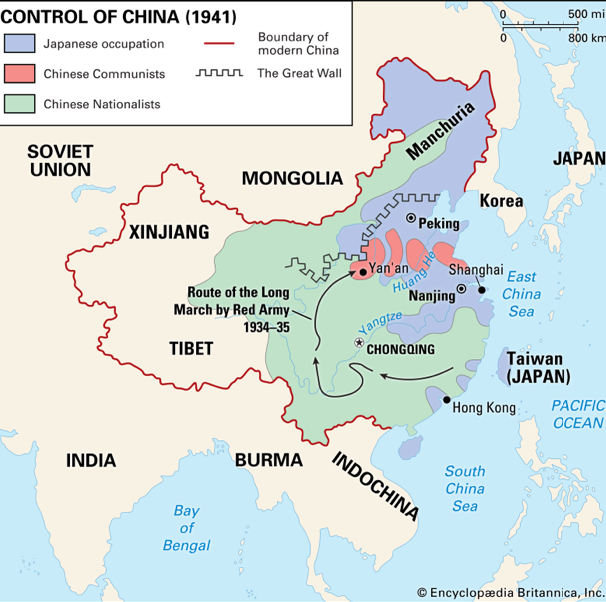
-
three parties, Though CCP and KMT are both fighting Japanese, they are still not “allies”
-
Japan’s New Order in Asia: Japan’s belief that they can rebuild Asia and replace the western colonizers: propaganda that other countries should provide resources to Japan
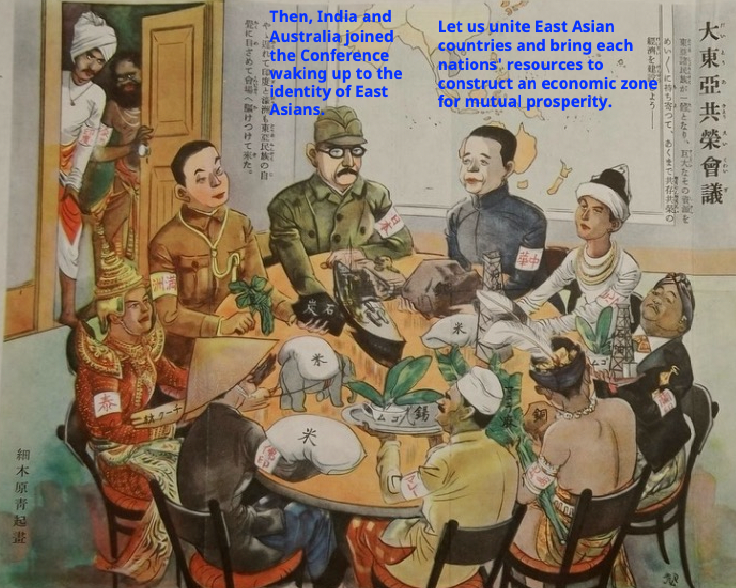
- puppet regime in Nanjing (1940-45), Wang Jingwei (top in KMT) collaborated with Japan during war time, seen as a national traitor
Third Phase: Global War
-
China alliance with United States and Britain = received military support and supplies
- e.g. US army transportation in China, with supplies and soldiers such as Flying Tigers
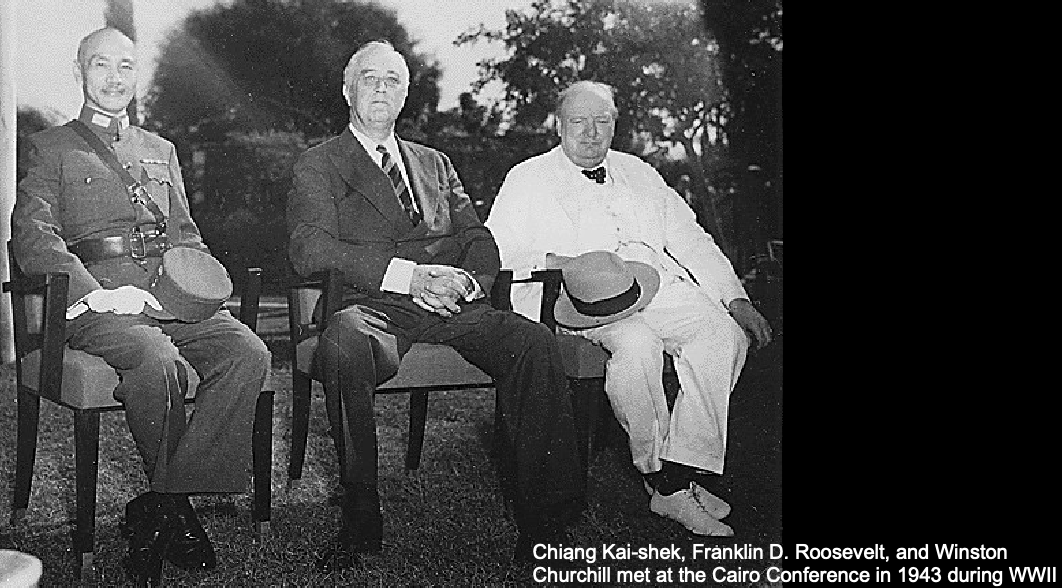
- some sense that US rescured Chinese, but China still had important contribution to the WWII. One is that it held huge numbers of Japanese troops on its territory. Second is that China it technically the first to engage in WWII in 1937 (or even 1931), while Europeans start in 1939
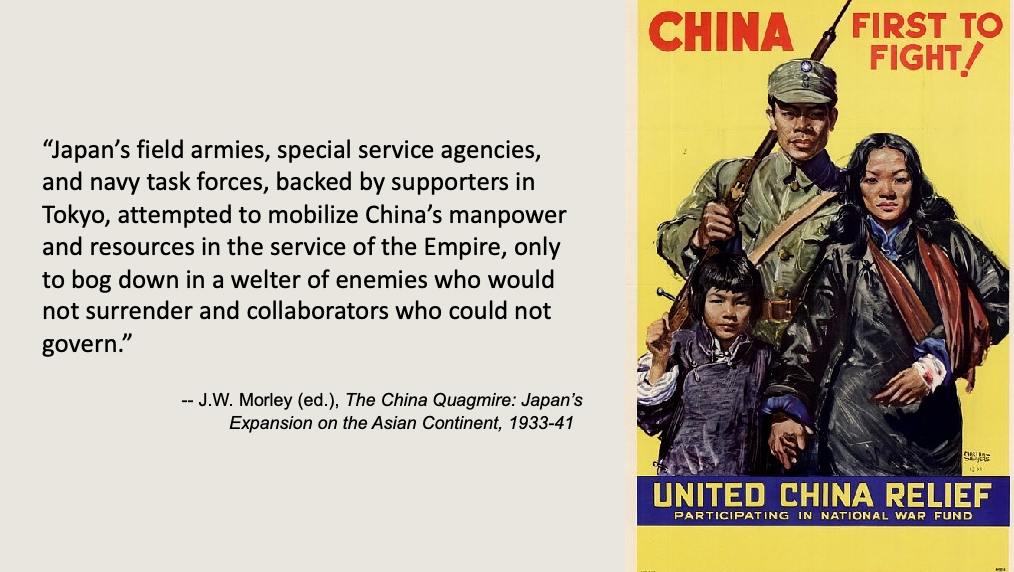
-
Japan retaliated with Attack on Pearl Harbor (1941)
-
in the end US dropped two atomic bomb and Japan surrendered
Impact of the War on China
-
devastation of many parts in China; heightened since of national identity; a weakened nationalist government, and CKS lost lots of his troops
- therefore, it set the stage for Communist success later.
- it can be seen that CKS fight against Japan diverted his troop and effort from eliminating CCP, and during those time CCP enjoyed more support in rural China = had more time to develop and became stronger
-
China-Japan relation today: a bit of awkward handshake between two presidents
|
 |
| 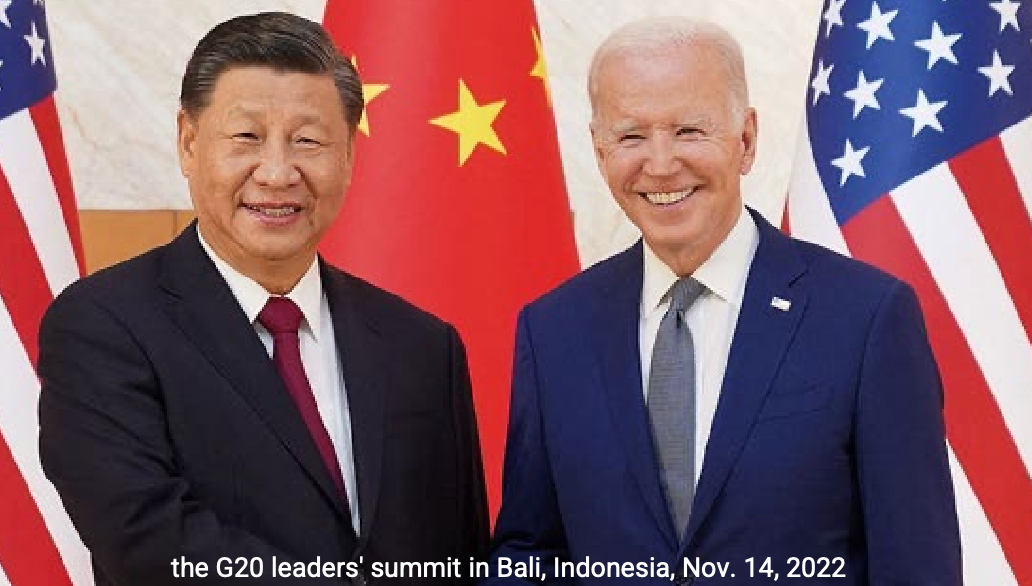 |
| :———————————————————-: | :———————————————————-: |
|
| :———————————————————-: | :———————————————————-: |
Chinese Civil War: CCP v.s. KMT final showdown after the WWII. 1945 - 1949
-
final showdown; US reduced their support in CKS’s government due to some corruption in government. Mao didn’t get full support from Stalin either
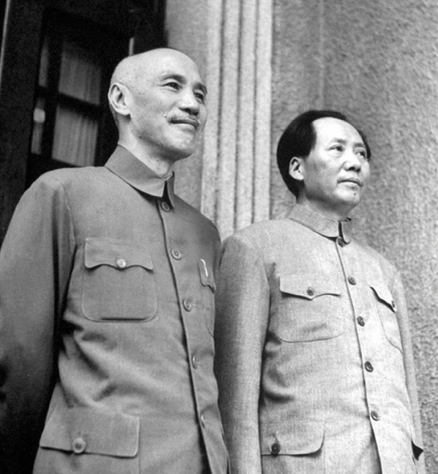
-
but we know the final result is that Mao won, established People's Republic of China
-
after the defeat, CKH fleet to Taiwan, with 1.2 million nationalist refugees there (and always wanted to retake the mainland)
- but in 1950, US sends the Seventh Fleet to the Taiwan Strait = existence of US power prevented each side from attacking
- but still tension and lots of propaganda on-going
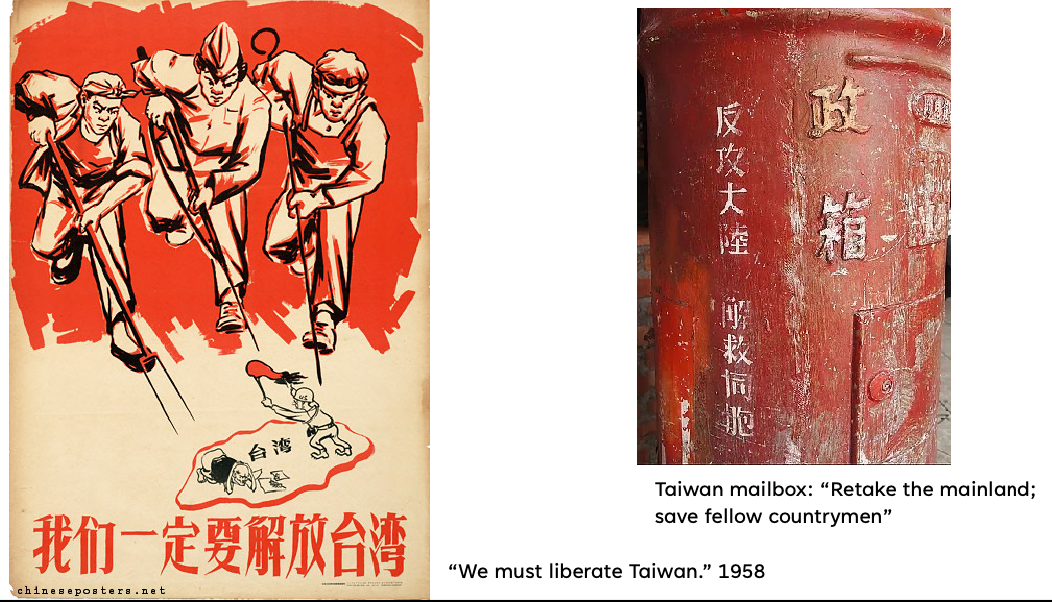
-
yet overall, both party recognize Sun Yat-sen as father of modern China (idea of a unified China during warlord era, and founder of Republic of China). However, while Mainland China supported Mao, Taiwan supports CKS
Mao’s China (1920s - 1976)
Previously on the war years
- 1931 Mukden Incident (many historians view this as the beginning of WWII for China) touches off a well-planned invasion of Manchuria; starts the 15 years’ China- Japan war (1931-45). Japan establishes a puppet state of Manchukuo in northeast China.
- 1937-1945 Second Sino-Japanese War (another view of beginning of WWII). Tentative second united frontier.
- Chinese forces suffer heavy losses, trade space for time.
- Japanese overrun E. China, GMD fights war of attrition, CCP preserves strength in rural areas
- CCP have time to win popular support, partly due to Japan’s invasion that KMT cannot focus on fighting CCP
- After Pearl Harbor, China formally allies with U.S. and Britain;
- Japanese war crimes (e.g., the Rape of Nanjing, Comfort Women, Unit 731) remain inadequately acknowledged by the Japanese govt and victims not compensated for.
- Wartime collaboration exists yet remains underexamined in scholarship.
- 1945-1949 Chinese Civil War
- KMD retreat to Taiwan, but both claim to be the legitimate government
Why did China become Communist?
-
Explanation 1: just because it was the alternative to KMT
-
how did nationalist fail? KMT had wide spread corruption, inflation, poverty, declining purchasing power (huge inflation), warlordism

-
CCP just happened to be there as an alternative: if KMT more successful, China might not have CCP winning = no communist
-
Japan is also a contributor, that holding KMT off so CCP can have time to develop
-
-
Explanation 2: CCP itself aimed to gain popularity, mobilizing peasantry, anti-Japan idea resonated well with the large peasant-based population at that time
Mao Zedong 1893-1976
-
in his early years
-
born to a rich peasant = wealthy farmer, education in Confucian classics; traveled to work in Peking University Library
-
attended CCP first meeting as the delegate of Hunan, working under Li Dazhao
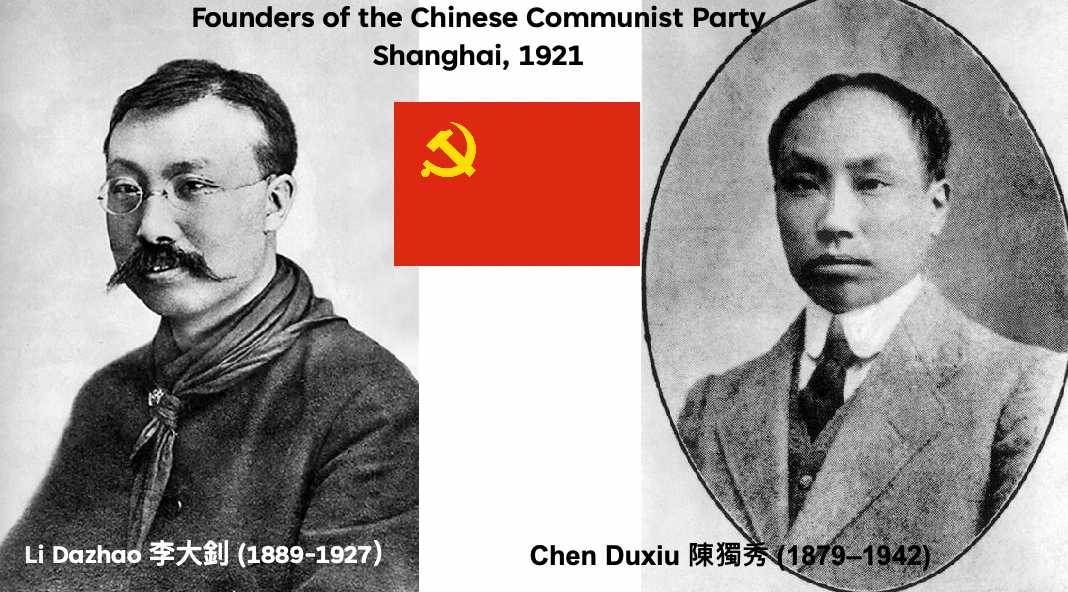
-
Mao concentrated on rural work and had this report on an Investigation of the Hunan Peasant Movement = before CCP believe in urban workers, but he advocated to mobilizing peasantry and violence as a necessary mean for revolt
-
-
Shanghai Massacre 1927, communist hiding and fleeing from KMT = Chen Duxiu blamed as the mistake. Then Mao lead them into Jiangxi Province
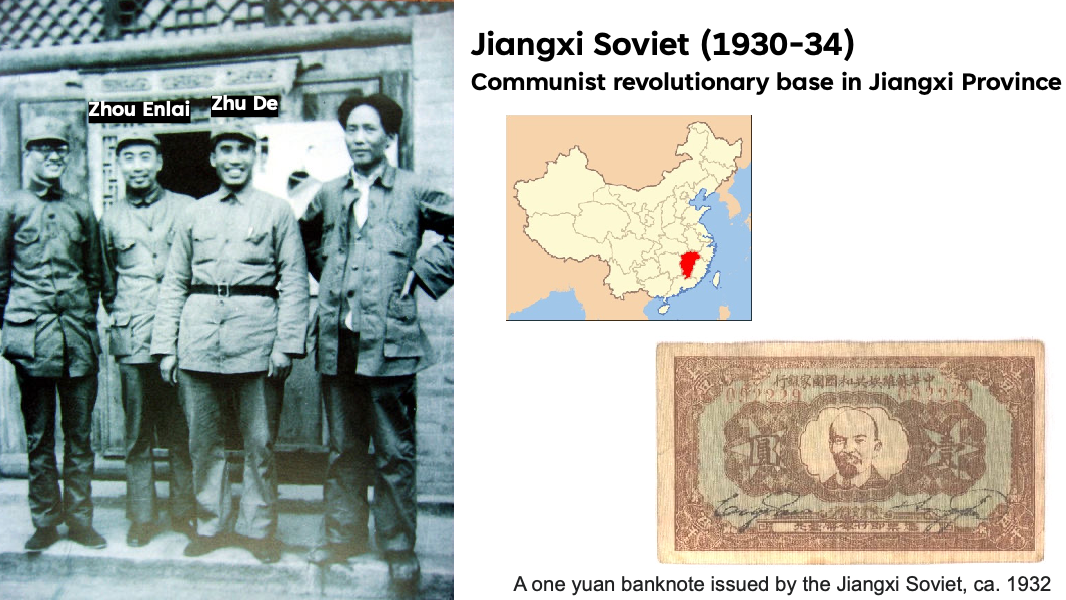
for the first time, CCP is governing some area: organized land reform (redistribute land) and other reforms = quite successful in Jiangxi
-
Long March in search of new base in Yan’an in Shaanxi province, after KMT attack again. Only 10% made it the whole way. Those people are seen as selected/destined for this mission = founding myths of PRC
- Yan’an is like Qin’s captial which is easy to defend, and easy to send troops
- but living condition was quite tough: Mao lives in a cave home. But CCP are very friendly to peasants
- important strategy of masses to the masses:
- “all correct leadership is necessarily “from the masses, to the masses”. This means: take the ideas of the masses (scattered and unsystematic ideas) and concentrate them (through study turn them into concentrated and systematic ideas), then go to the masses and propagate and explain these ideas until the masses embrace them as their own”
- Mao believes peasants are the vanguard = true masses for this revolution v.s. Marxist called peasants a sack of potatoes
|
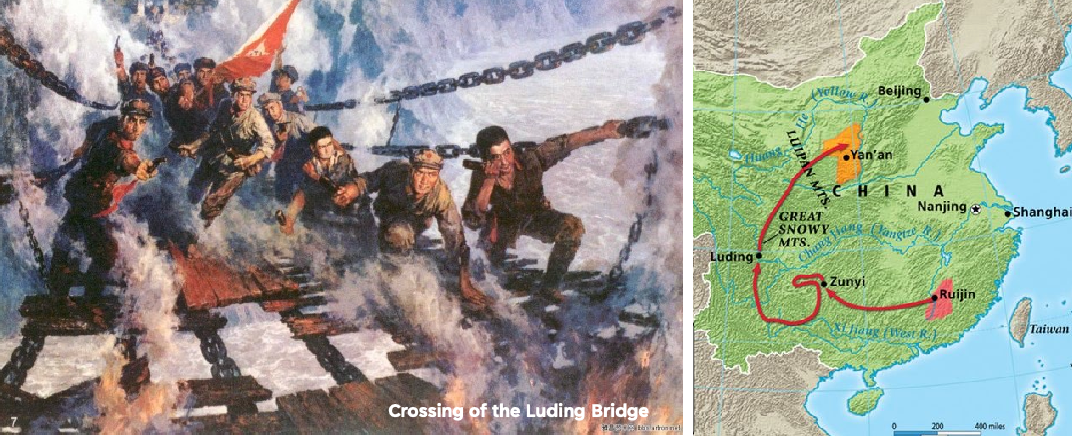 |
| 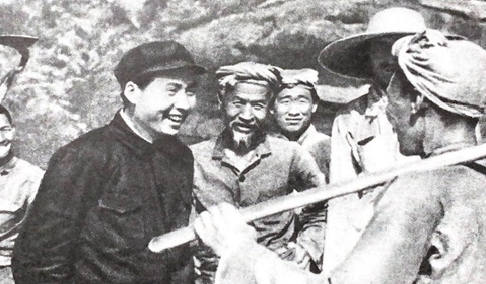 |
| :———————————————————-: | :———————————————————-: |
|
| :———————————————————-: | :———————————————————-: | -
Techniques in this mass movement
- study groups = small group meetings like “book club” = express and criticize opinions on socialists texts
- struggle sessions = performative displays of revolutions = 民众诉苦
- encourage the peasants to come out and speak publicly accusing landlord of this crimes = directly confronting
- this act of humiliation for landlord could be more important than the land transfer = symbolize transfer of power from rich to poor
- everyone in the group has to participate in the above activities
- really emphasize small groups + support from locals = decentralized idea instead of purely top-down structure to rely on center
- e.g. land reform = abolishment of landlords and returning lands to peasants aims to support locals
-
sees himself as the interpreter of Marxism-Leninism in Chinese context, and a master of guerrilla warfare
-
in 1949, Mao’s proclamation of PRC
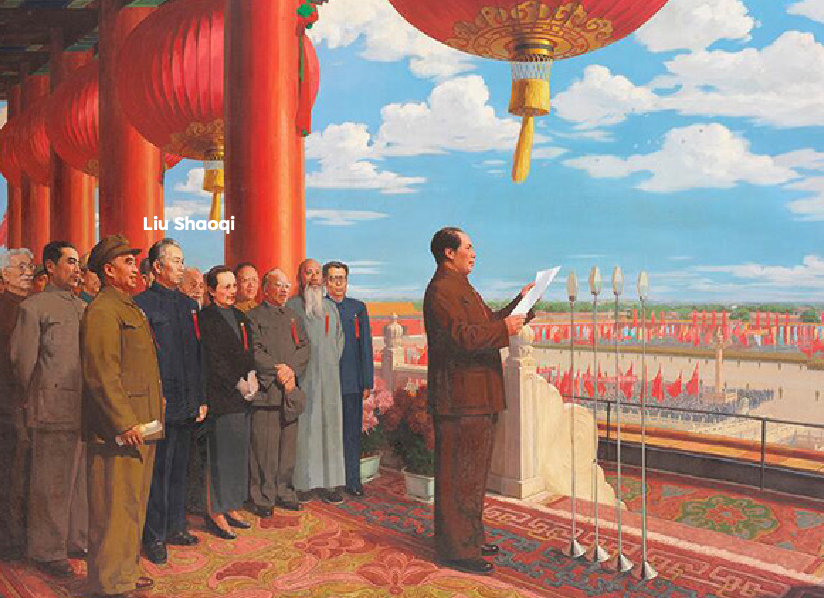
this painting used more as a political tool, later on Deng Xiaoping is added, even though he is not even there
-
PRC’s political organization: party supervising government = so really it is a one party country (a feeling of authocracy)
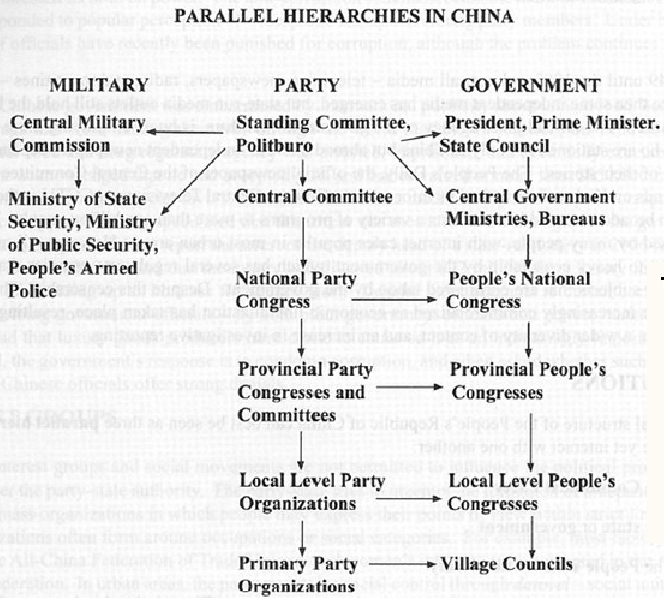
Land Reform Continued after PRC founded
-
First phase of land reform
- before it is mostly north in Mao’s region, now also includes south of China
-
continues struggle sessions etc; redistribution of land = broke up the older elites = CCP to introduce modern modes of agriculture
- also used as a reward for peasants for supporting CCP
- problem: small land holdings is not a productive way for high agriculture output
-
Second phase: farmers join together = collectivization of agriculture
- households to help each other and forced into cooperation = collectivization
- hope to further increase agricultural output = further support modern inditurialization
- but many felt discontent because again lost ownership of it = shared responsibility
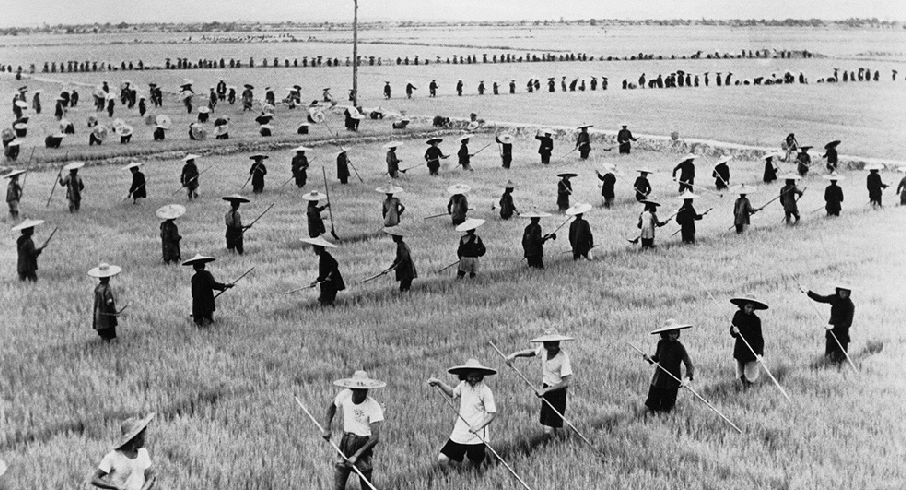
America and Korea: “War to Resist America and Aid Korea” (1950–53) 抗美援朝
- recall that US is against Soviet Union = communist. However, they know they cannot exterminate communists.
- in order to use Japan as a base to contain communism in Asia
- communist ideology is that every one should be communist = China joins then it is helpful = also for building alliance for Soviet
- Therefore, America now is against China/refuse to help Korea against America
- decided to help North Korea as if it is lost, America would attack China
- Consequences of the war include
- China more close to Soviet for econ assists
- confirming US imperialist ambition in East Asia, as US intervention in Korea
- suffered high death tool and called US is a paper tiger
- difficult to get Taiwan fully back in control = with US-China relationship on Taiwan a problem until today
- also emerges campaigns in China against foreigners
- Mao lost the elder of his two sons; and the other son has mental trouble = lost his successor
Five Year Plans
-
PRC’s First Five-year Plan: won the Korean War, and land reform aimed to help industrialization as a model from soviet = invest in heavy industry.
- indistural output went up by 25%, significant number
- quite successful, Mao very confident and listened to intellectuals outside CCP to speak up = Hundred Flowers Campaign = expecting only mild criticism
- turns out this campaign brought heavy criticism = accused of monopoly of power
- then Mao retaliate = anti-rightist campaign to force those labeled as rightest forced for re-education
-
second five year plan: the Great Leap Forward (1958-1960). Sense of urgency to catch up with other developed country in the west
- e.g. surpass the UK and catch up with the US in steelmaking
- a feature of this leap forward = people’s commune
- 5k households within a commune = so that if women have to go back and cook, takes time away
- aim is to scale it by cooking for all = saves time = more efficient and productive
- but this could give problem that peasants could eat 6 month of rice in 20 days = stock is shared in commune but not in own home = later famine disaster

-
everyone setup their backyard steel production = again scaling;
-
but overall this divert attention to agriculture = reduce in agricultural output = great famine later
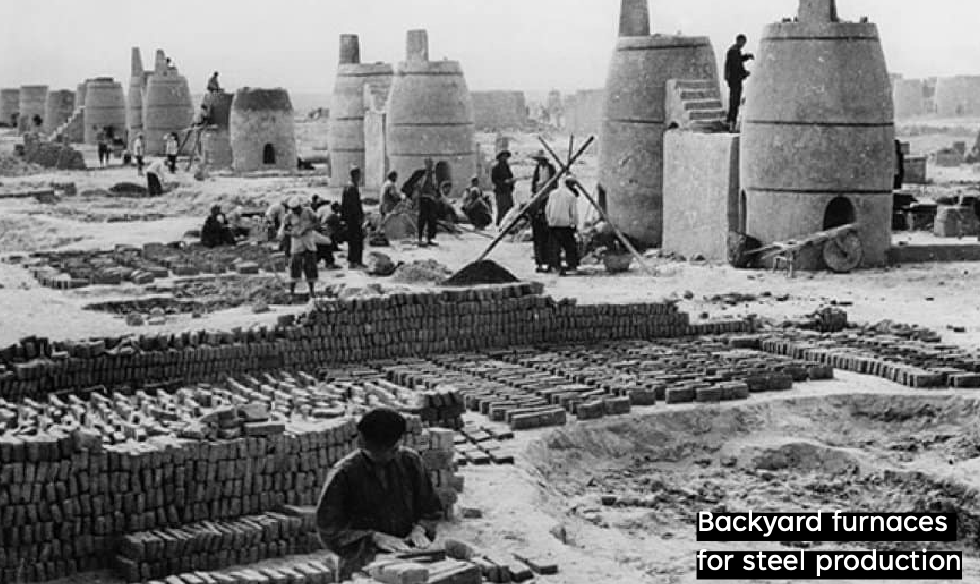
-
but peasants were very enthusiastic about it. Baby named after those concepts:
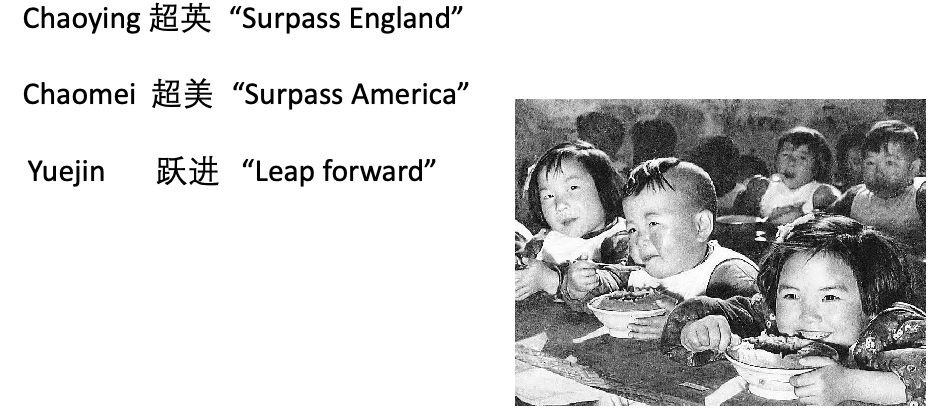
however, we know now it is a economic disaster contributing to the great famine
Great Famine 1959-61
-
caused by the weather and drought, but also the Great Leap Forward fiasco: 30 million starved to death
-
historians believe that the problem is not absolute lack of food but the systemic flaws or decisions that prevent food getting to the people
-
anyway criticism within the party of the Great Leap Forward = Mao took responsibility and resigned in 1959
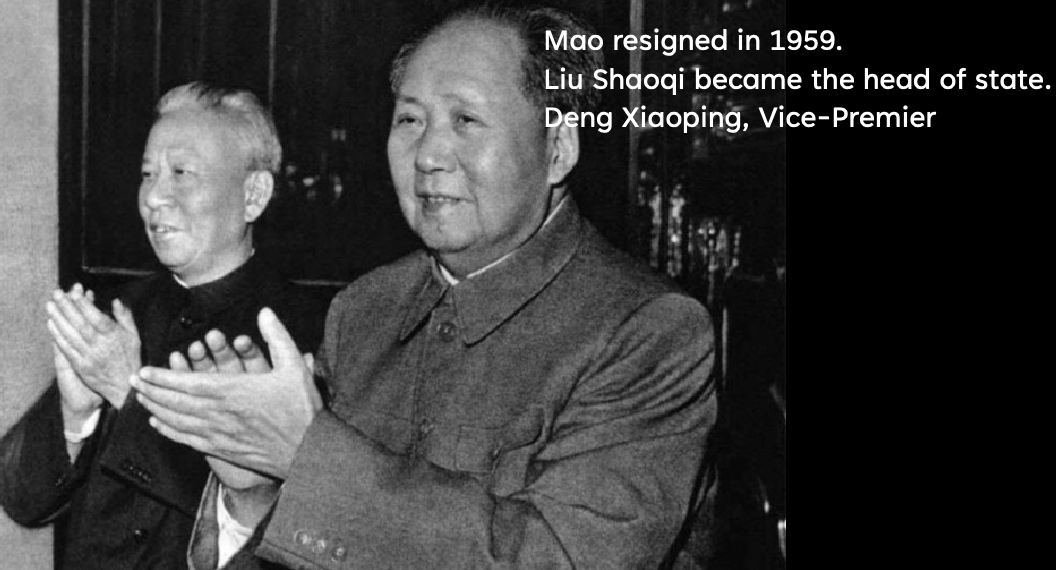
more pragmatic people Liu Shaoqi and Deng Xiaoping took power = more into Marxist materialistic base than the idealized vision
-
new leaders = economic recovery in 1966
Economic Reforms and Political Authoritatianism
Previously on Mao’s China
- People’s Republic founded 1949, CCP pursues Soviet-style socialist construction, emphasis on heavy industry, collectivization, reorganizing grassroots society to unlock labor power; Mao promotes rapid development $\to$ Great Leap Forward 1958
- Great Leap is an economic disaster; in CCP leadership reshuffle, pragmatists Liu Shaoqi and Deng Xiaoping rise; Mao’s desire to regain influence factors in launch of the Cultural Revolution 1966-69 factional warfare, civil unrest, paralyze nation
- his goal can be said partly to regain his power, but also as a socialist “ideologist”, he believes in social egalitarianism and sees Deng’s policy on economical and political reform astray from the correct path = cultural revolution
Some key terms:
- The term “bourgeois” has a specific meaning in Marxist theory. It refers to the middle class, which is seen as the class that controls the means of production in capitalist societies. In a Marxist framework, the bourgeoisie are seen as the enemy of the proletariat, or working class, because they exploit the labor of the proletariat for their own benefit.
The Great Proletariat Cultural Revolution 1966-1969/76
-
Mao believes that:
- the method to solve all problems is by continuous revolution. New contradictions/problems will always come up, and class struggles should be used as a tool to solve those new problems
- believes in social egalitarianism and no elitism, that policies should be made by the people for the people
- In Mao’s view, there are “bourgeois” elements within the Chinese Communist Party, i.e. those who had abandoned the party’s revolutionary ideology and had embraced more moderate, reformist policies. These individuals were seen as a threat to the party’s revolutionary principles
- Therefore, party needed to be purged of what he saw as “bourgeois” elements, and he launched the Cultural Revolution to achieve this goal.
- another perhaps popular view is in his attempt to regain power/influence in the party
-
1966 Mao wrote a poster “bombard the headquarters” = making a war on the party that he established
- this Cultural Revolution first lasted until 1969
- again, he utilize his famous strategy of mass movement = red guards (young women students)
- shows that even not in party, he still have wide-spread support in people
- combined with his earlier mistakes, it can be said he is a person better at moving the masses to, e.g. revolt, than to govern
- the goal is to remove those bourgeois elements from the party
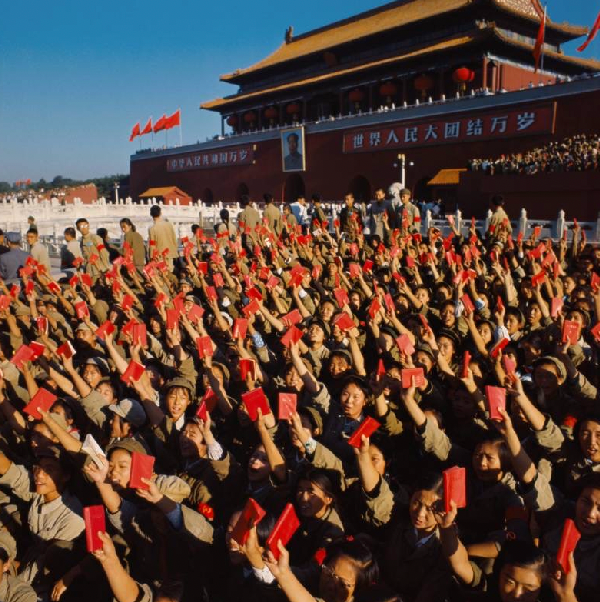
notice that they are holding “Mao's little red book” = Quotations from Chairman Mao. This book is seen as bible for cultural revolution.
Other forms of “struggle” within this revolution include:
-
“criticize and struggle” publicly criticize/beat teachers
- recall that during the anti-Rightest movement (after 100-flowers), many intellectuals were condemned = had a bad reputation
- A lot of victims committed suicide to avoid humiliation
- Deng went to exile, and President Xi’s father was also denounced in this period as well
- an perhaps “unexpected” chaos as Mao did not specify “who to criticize against”, thereby causing wide-spread chaos
-
rebels also followed Mao’s call to “Smash the Four Olds”: old thoughts; old culture; old customs; old habits. For exapmle Confucianism
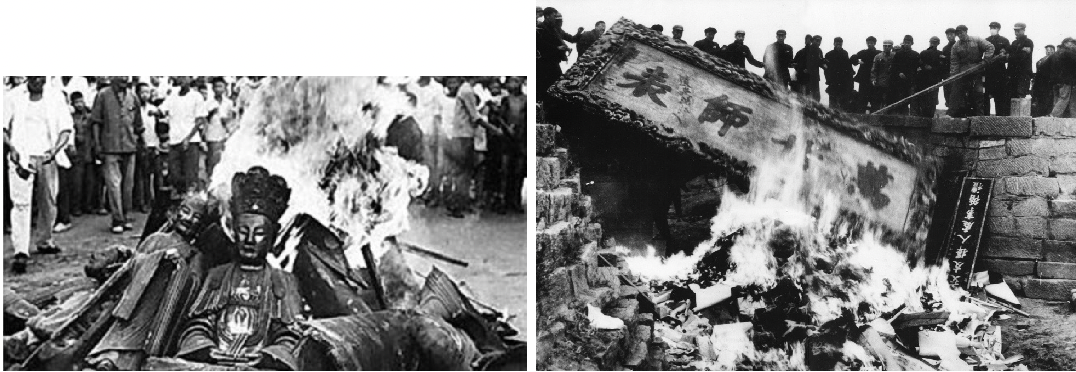
-
the idea of being permitted to defy superior, rising up again established authority is a theme in this period
-
Deng’s Solution: redirect Young people’s energy is to drive them to countryside = 20mil displaced to country side. Propaganda below seeming to convince them go there
Propaganda President Xi 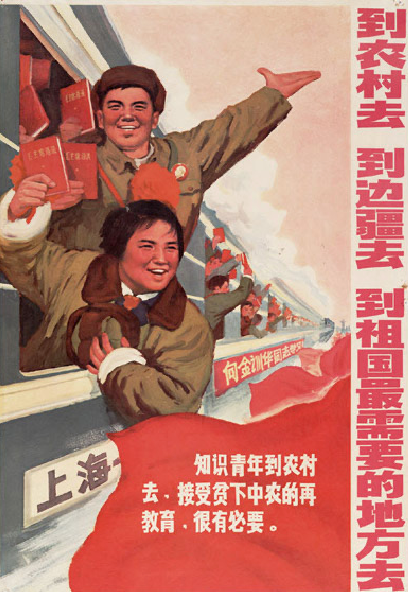

-
ended finally when Mao passed away
Deng Xiaoping’s Period. Whoever is the leader of the party = the man that exert most impact. However, the paths taken by post-Mao China were NOT solely dictated by CCP leaders such as Deng
-
at the end of Mao, already some significant changes: United States President Nixon’s China visit
- In 1972, President Richard Nixon made a historic visit to China, where he met with Chinese leader Mao Zedong.
- This visit marked the beginning of a thaw in relations between the two countries, and it paved the way for the normalization of diplomatic relations between them. Prior to his visit, the United States and China had been on opposite sides of the Cold War as China side with Soviet
- One of the main reasons for the deterioration of relations between China and the Soviet Union was ideological. The two countries were both communist states, but they had different interpretations of Marxism-Leninism, the ideology that guided their governments.
- The Soviet Union, under the leadership of Leonid Brezhnev, embraced a more moderate and pragmatic approach to communism
- while China, under the leadership of Mao Zedong, took a more radical and revolutionary stance. This led to tensions between the two countries, as they competed for leadership of the international communist movement.
- therefore, Mao begins to see Soviet as the biggest threat and now tactical cooperation with US might be worthwhile
-
after Mao’s death, three groups competing for power after Mao:
-
the Gang of Four, based in Shanghai and more like a clique controlled by Chairman Mao, lead by his wife Jiang Qing
- but after Mao died, they were purged
- Jiang escaped by viewing herself as Mao’s scapegoat: “I’m just a dog of Chairman Mao, and I bite whoever he wants me to bite!”
-
Hua Guofeng who is a young official gaining Mao’s trust
- “Two whatevers”: We will resolutely uphold whatever policy decisions Chairman Mao made, and unswervingly follow whatever instructions Chairman Mao gave
- but quickly forced out of power by Deng
-
Deng Xiaoping’s group, who eventually succeeded as he was a core member and had wide spread connections in the party
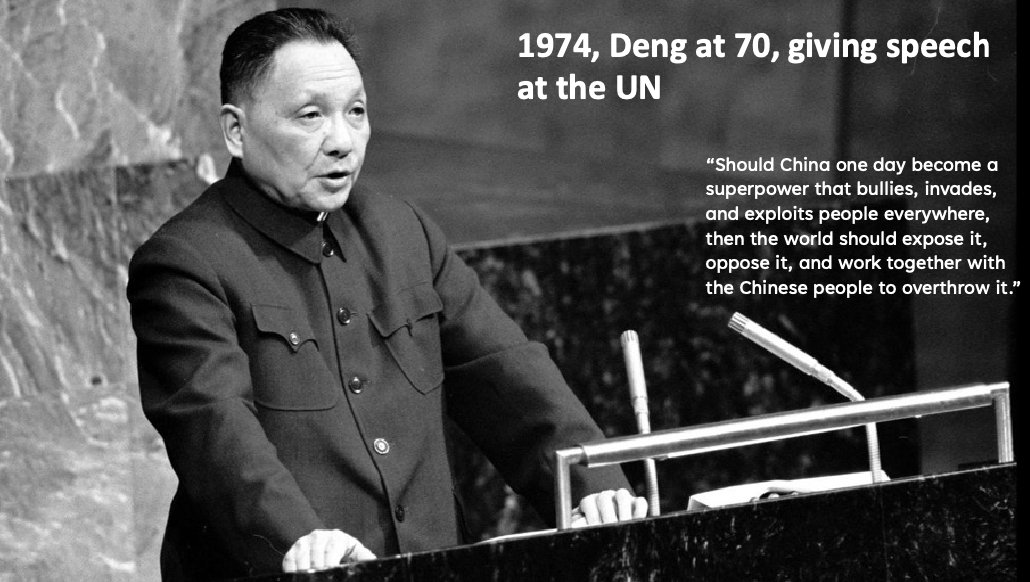
- once said: “Should China one day become a superpower that bullies, invades, and exploits people everywhere, then the world should expose it, oppose it, and work together with the Chinese people to overthrow it.” = was advocating peaceful existence between countries with different ideologies (unlike Soviet)
- connections within the party:
- Long March veteran
- he never turned on his colleagues despite being purged twice during the Cultural Revolution
- hence they felt grateful
- he then successfully drove out Mao’s chosen successor (Hua) to reform
- reform direction: Deng distanced the CCP from the Cultural Revolution, from Mao, and from the Soviet economic model
- Deng installed reformists in positions of power.
-
-
In 1981 “Resolution”: on failures of CCP and enabled the party to distant itself with Mao = start new goals
- some denunciation on Mao = cultural revolution was an error
- but still recognize Mao had vital contributions (especially early years), still respected and beloved
- after this little red book disappeared/decayed, etc.
- but still not really solving any fundemental change, e.g. structural change, that could prevent this from happening again
-
Deng’s goal for China was to
- modernize/reform the economy and improve living standards, while still maintaining Communist Party rule
- argues that poverty $\neq$ socialism, and poverty is problem = very different from previous
- hence a somewhat capitalist approach
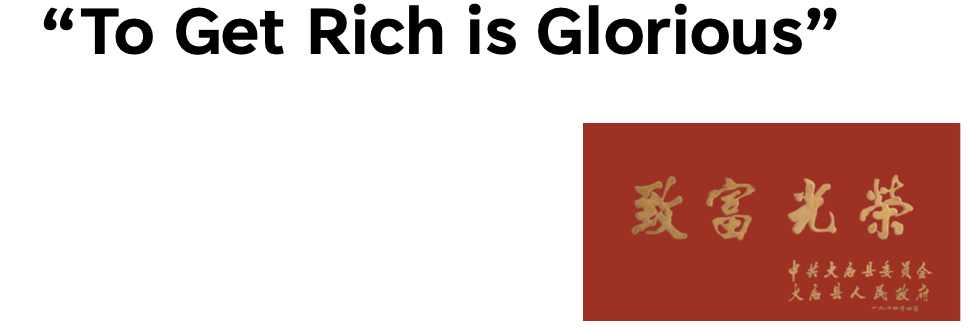
Rural Reform under Deng: Household responsibility System
-
recall that the Great Leap Forward was an attempt but a failed one
-
reform not a top-down decision, but 18 farmers came together to signed. The idea is that land is shared but you get to keep what you grew (in addition to what you should grow/submit to government)
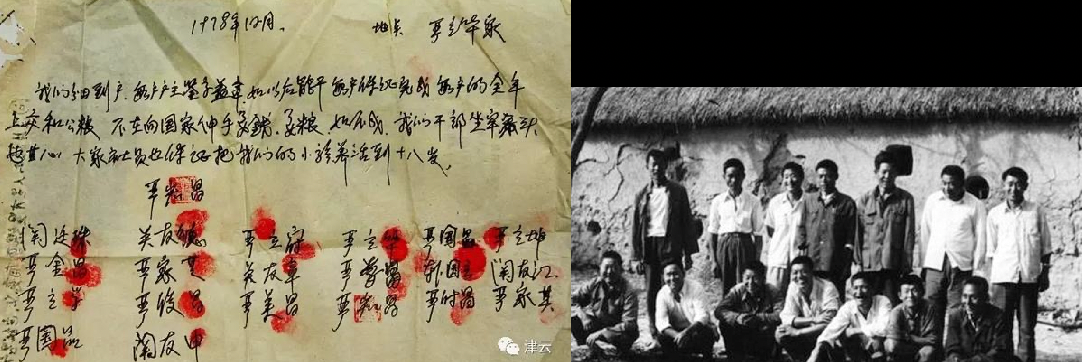
- After this treaty, every farmer in this village competed to produce more as compared to the Great Leap Forward
- called the first capitalist village
Urban Reform: “smash the iron rice bowl”
-
under Mao, there were no private enterprises, all are controlled under the state.
- Workers belonged to their “work unit” (after graduation) and had lifetime job security.
-
Deng’s reform: privatize many state-owned enterprises, so for workers in inefficient enterprises gets laid off
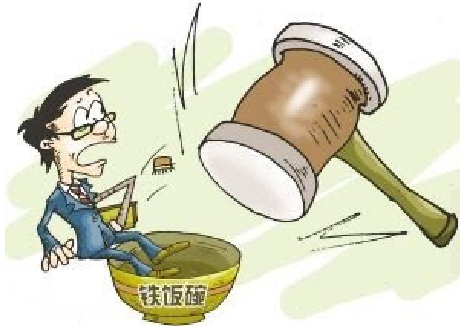
- though lead to economic development, but income inequality comes up as an inevitable problem
- Opening to the world: Special Economic Zones (SEZ)
- The SEZs were designed to be areas where foreign investment and economic development were encouraged, in order to stimulate economic growth and create jobs.
- also lead to China’s later entry into WTO
- Shenzhen would be an example of successful ecnomoic zone
- by introducing this reform, it moved away from socialism towards capitalism: “Socialism with Chinese characteristics”
One Child Policy (1980-2011): more people due to improvemened of public health
-
rationale: China had already been burdened to lift 1 billion people out from poverty, which was Deng’s goal. Hence in 1980s this comes up
- of course had propaganda
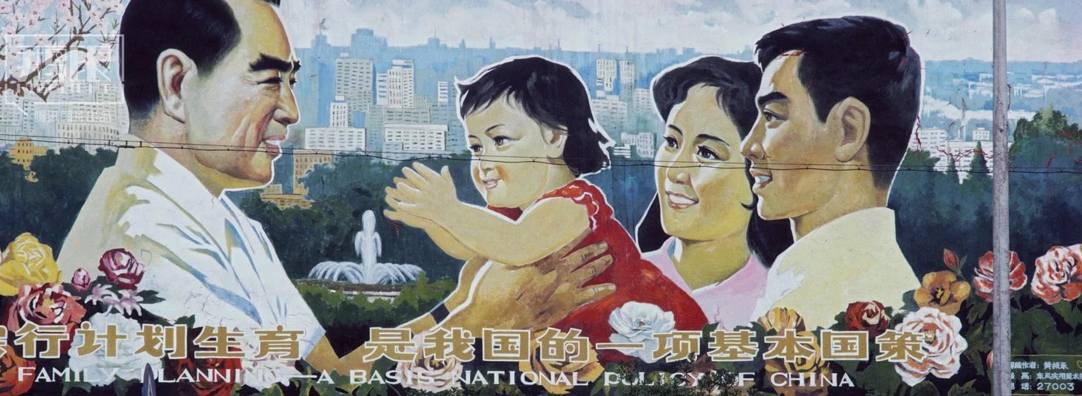
- but had a lot of problem/criticism e.g. female fetus the victum
- note that it is only targeted at Han, so not to exterminate ethnic minorities
Political Authoritarianism: Deng and leaders seem themselve as authoritarian
| 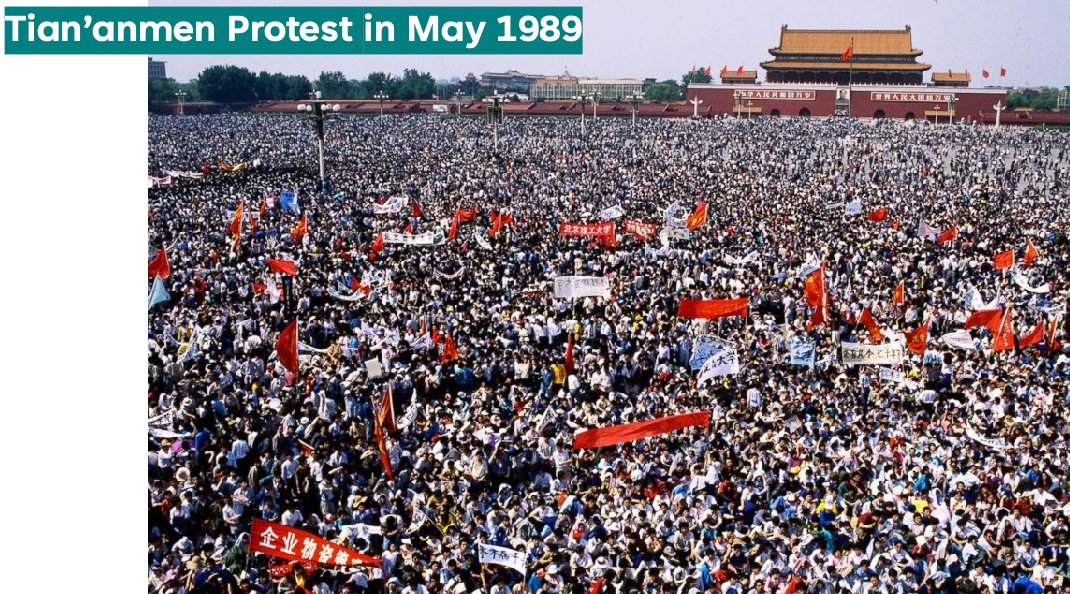 |
| 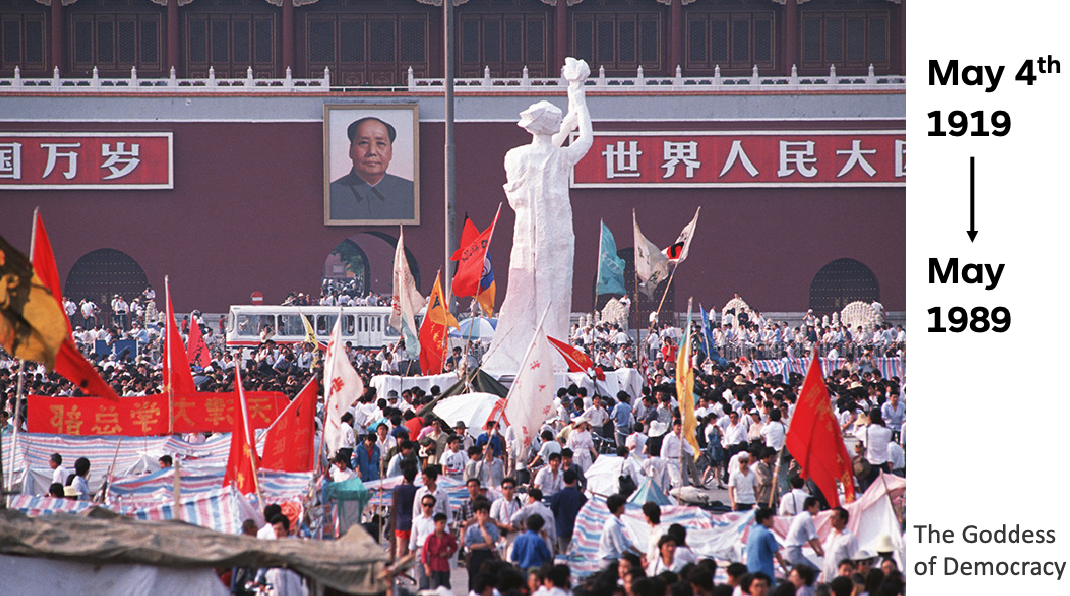 |
| :———————————————————-: | :———————————————————-: |
|
| :———————————————————-: | :———————————————————-: |
-
“Economic reform does not to imply political liberalization”
-
Tian’anmen Protest in May 1989, also refered to as May 4-th Movement. Tension/demends include
- Freedom of the press: The protesters called for greater freedom of the press, so that journalists could report on political and social issues without fear of censorship or reprisal.
- Freedom of speech: The protesters demanded the right to express their views and opinions without fear of retribution.
- An end to corruption: Many of the protesters were concerned about corruption in the Chinese government
- An example is that children of elites can get into Tsinghua and Peking University easily
- party official has the priviledge being more wealthy (result of captialism)
- Political reform: Some of the protesters called for greater political reform, including the introduction of democratic institutions and the expansion of civil liberties.
- fundementally it is caused by wide-spread discontent, result from factor such as
- more lay-off
- before controlled rice price, but now it shoots up (as market is opened) and gives resource tension and inflation
-
lasted for 2 month, the party become split between liberal and conservative factions
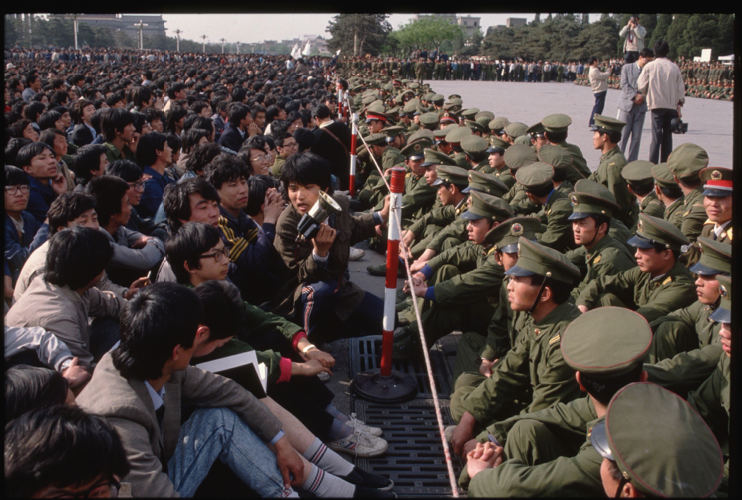
- liberal = more moderate, we should talk to students, listen to their complaints and reform
- reformist such as Zhao Ziyang argued that the economy should be opened up to market forces, and that political reforms, such as greater democracy and respect for human rights, were necessary in order to modernize China.
- conservative = repress those news to prevent revolution, very sensitive to revolution (hence also sent troops)
- Deng Xiaoping and his supporters believed that the economy should continue to be planned and controlled by the state
- but they also believed that market forces should play a greater role in the economy.
- in the end, believes that the party should have leading power in decision making
- Both believed in the importance of market forces in the economy, but differed on the extent to which market forces should be allowed to play a role
- liberal = more moderate, we should talk to students, listen to their complaints and reform
Final Exam
Structure
- 8 ID, pick 5
- 6 pick 2 primary sources: what is says, how does it say it, etc
- who, what, when, why, how = analytical
- significance
- contextualize what source I am talking about
- a decent essay
Overall idea:
- Significance of each event
- e.g. foot-binding significance = commercialization of women + the entire economy
Key terms
- Foot-binding:
- in Song, foot-binding started among low-class women who were performers/entertainers = so poor had to sell themselves; commercialization of women also during the great movement from north to south = security of women at most agile point = all people are unsure about their worth as now you are going south; women competing in courtesans desired foot-binding = mothers had to also get their daughter into the mold though it is a hard choice
- in Qing, tried to ban foot-binding but didn’t work = ethnic Hans couldn’t because foot-binding became a social status = being foot-bound you don’t need to work in the fields/households , and had servants whose feet were not bound = somewhat an elite status; with the fall of Qing that practice is now gone
- Canton system: Hongs; international trade;
- Qianlong Emperor: golden age in Qing; Qing really started to expand territory, e.g. Xinjiang under Qianlong; supported some aesthetic engagement; foreign trade
- Neo-Confucianism: HuangChao rebellion wiped aristocrats with power; Zhu Xi
- Yam System: serious of outposts so that horse can gallop = allows for speedy transfer of information = how quickly info can propagate
- The postal system, known as the Yam system, was a sort of medieval pony express with stations positioned at intervals of 20-30 miles. At each station, an “arrow messenger” would mount a fresh horse and ride to the next station at a full gallop.
- Kurultai group elect a new leader from a group; elder male chosen as “Kurultai” = next Khan; an election process
- a kuriltai (also spelled kurultai; “general assembly”) of Mongol nobles was convoked in order to elect the new great khan
- Chinngis Khan; Kublai Khan
- Temüjin (original name) crowned as the kurultai to become Chinngis Khan; unified his steppe tribe; made a lot of invasions = feared ; disable steppe system and created autocracy in the steppe empire
- Kublai: a switch of inward facing history of creation of empire; most people consider the founder of Yuan; invaded southern Song; sinification when ruling; differ with Chinngis as how you rule = cannot cut and paste nomadic strategy to thrive; start of governance = focused more on social and economic issues rather than military conquest
- influence of nomadic culture on China
- Columbian Exchange
- got plants, tomatoes, etc = nutritional = well suited for growth in China; social implications = growth of population
- also diseases
- deficit of silver; Zhang Juzhen = chief secretary; credited to transit from agrarian to; encourage people not to follow the Confucian; policy really benefited the main economy = increasing demand of silver ; as a side effect boosted power of merchants =
- 1679 Tokgawa shut down european and halted silver import but still came in = no tap silver inflow
- made paying taxes in this form impossible = people horde their silver = copper to silver went into decline
- Colombian exchange also had the inflow of silver to China=the increased supply of silver led to a devaluation of the metal, which had previously been a scarce and valuable resource.
- meaningful engagement with US
- 1911 revolution ended Qing; Xinhai Rebellion
- Sun Yat-sen needed some military backing and made agreement with Yuan
- warlord period after Yuan died in 1916-1927
- New Cultural Movement v.s. May 4th Movement
- May 4th 1919: treaty of Versailles with Shandong transferred to Japan angered students = shift focus in China towards soviet unions instead of western power = felt like westerns have abandoned them even though they are all ally in WWI
- but May 4th Movement $\neq$ this event only, but more the idea of shift away from traditional Confucian education to a more modern science and democracy + vernacular literature (e.g. Lu Xun)
- New Culture movement => New Youth periodical
- what does it has to do with 1911: 1911 being political changes, while these are more literary/and cultural changes to China
Long Essay
- a
- a
- opium war and boxer rebellion
- a
- a
- e.g. May 4-th; what they advocated for = departure from confucian edu values; how does society change but still persisted from the traditional path
Notes on The Open Empire Book
This section contains reading notes for the various related chapters of the book “The Open Empire: A History of China to 1800”
Ch.1 Beginnigns of the Written Record
Written records were mostly for written on tortoise-shell bottoms, or called plastrons (甲骨文), dating to the reign of King Wu Ding(武丁王) for the Shang Dynasty.
-
texts were transcribed onto either plastrons or sometimes scapula of cattles. Specically, this is done by 1) preparing the bones 2) heting it up 3) the bone cracks 4) interpret the message from cracks and write the questions/answers onto it
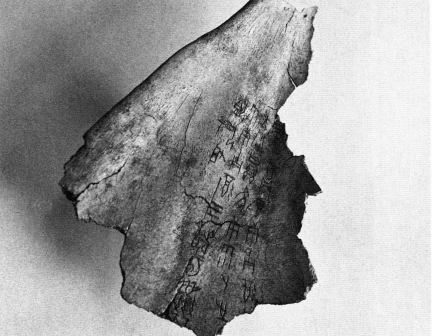
how was this discovered? This is first discovered during 1899 Beijing, during Malaria, when some people give out “dragon bones” (scapula of cattles and turtle shells dug up in large quantities from Anyang) to be grinded into powder for medicine. Then, some scholar found scripts on those dragon bones, and hence lead to realize those are actual texts.
-
For King Wu Ding, Anyang (安阳,河南)was the capital
-
finally, Shang is succeeded by Zhou by the concept of Mandata of Heaven (天意)
How Chinese Characters Work:
- most well-known examples of chinese characters resemble the concept they depict
- vast majority of cahracters contain a radial (偏旁) to convey the general topic of the word, and a phonetic element to indicate the sound. For instance, 象 means elephant or image, but if added a radical 像, it means image.
- some people also say that chineses are inefficient, indicated by lower literarcy rate in China v.s. US. However, in places such as Hong Kong, Singapore, and Taiwan, literarcy rates are higher.
- Finally, the advent of 拼音 is largely ue to systems to trasnscribe sounds of Chinese into alphabet to be studied by the Western.
The Advantages of Chinese Script
- Only few scribes can read or write at that time
- since written chinese characters are decoupled from pronounciation, you can keep your spoken language but just assign Chinese characters to preexisting words in your language. This gives rise to the diverse dialects but still a uniform written system.
The Content of Oracle Bones
-
Ritual related questions such as: What should be sacrifiesed? In what quantity?
-
Political questions such as: Sohuld the king send this troops to a certain kingdom?
-
the layout of a typical script on oracle bone consist of:


where the preface explains which priest presided and which date, charges states the topic, prognostication gives the interpretation of the cracks (i.e. predictions) and verification is the actual outcome
-
do not conclude from the above that Shang preferred sons to daughters, because there are cases when “good” births were of daughters.
-
Found a lot of oracle bones, indicating that divination occured daily
-
Finally, scripts on plastrons are also used for teaching, where we found teacher scripts with cracks along with student’s messy and error-containing scripts on plastrons without cracks. This indicate that plastrons are plentiful during the time and students do not need to write on other materials first (if they did practice, then their characters would be better formed!)
Discoveries at Anyang
- Lady Hao, one of sixty-four consorts of the Shang King Wu Ding, has a tomb contained 3 ivory carvings, close to 500 bone hairpins, over 500 jdaes and nearly 7000 cowry shells (used as money)
- this is one of the only complete tomb excavated, withot the disturbance of gold diggers/theives
Art of Making Bronzes
-
A large of amount of Bronze vessels found at Anyang and Erlitou, suggesting that it is a society with significant resource to produce those at such a large quantity.
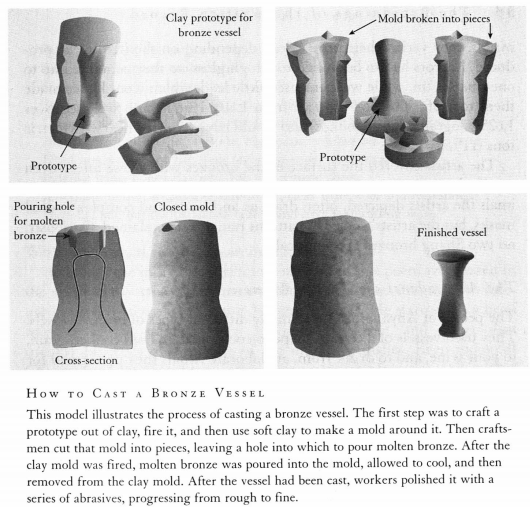
The Antecedens of Modern Chinese Cuisine at Anyang
- people at Anyang produced many different type of bronze veseels for cooking meat, holding cooked grain, etc.
- most cooked dishes were meat stew
- resistents of Anyang believed their ancestors retrained their desire for food, even when dead
The Pyramid of Shang Society
- This power pyramid can be found in the tomb: underneath the nature gods stood the ancestors of the royal family. The long-dead outranked the more recently dead, who in turn out ranked Shang king.
- Shang believed one could communicate more easily with those in nearby tires, and offerd a lot to recent dead.
- Member of the royal linage and women from the families who could marry with them constituted the aristocracy of the Shang.
- Shang believed the dead king would occupy this tomb after his death, and because he neded the service of all those who worked for him while alive, they had to perish when he died.
The Nature of the Shang Polity
-
His men rounded up livestock from the residents of places the royal entourage visited, but his officials did not collect taxes on a regular basis from a set territory
-
therefore, in what sense did Shang constitute a state? It is perhaps more like a soft state, whose stability hinged on the king’s frequent visits to his subordinates and their domains, whose bureaucracy remained divine rather than human.
The Illiterate Contemporaries of the Shang in Sichuan
- the discovery of the Sanxingdui 三星堆 in Sichuan illustrates the cultural variety of Bronze Age China during Shang
- artifacts in Sichuan different dramatically from anything at Anyang
Mandate of Heaven: from Shang to Zhou
-
According to Sima Qian (most critics argue this might not be accurate), the last Shang king liked the company of owman, drnak too much, enjoyed depraved songs, etc
-
Many officials left Shang to serve Zhou, and when Zhou’s advisor urged him to invade Shang, he says “You don’t know the Mandate of Heaven yet”
-
Then the last Shang king killed an offical who dared to criticize him, by cutting his chest open wile alive, Zhou king launched the invasion and won.
-
from then on, people start to believe that:
- if emperor could not govern and is soon revolted, the Heaven has retreated support and revolter would have the new Mandate of Heaven
- but if the revolution failed, then it is said the Mandate of Heaven is retained
as a result, Mandate of Heaven is practically a 马后炮
Zhou Conquest of the Shang:
- once Zhou had defeated the Shang, they established their capital along the Wei River (渭河).
- Until 771 B.C.E, when Zhou abandoned their capital in the Wei River valley (near 西安), historian then called the period before this Western Zhou, and the period after such a move Eastern Zhou
Divination in the Zhou: The Book of Changes
- Like the Shang, the Zhou also divined with help of bones and shells, but also used a leafy herb with white flower called yarrow, where diviners manipulated the stalks of yarrow in group of six and decided fate based on hexagrams.
- From 诗经, there are mentions that commoner men can also perform divination with both shells and yarrow stalks, such as for marriage
The Book of Songs 诗经
- contains the first songs from anceint China, and depicts vividly the elite and the lives of commoners
- these recorded songs are culled from 3,000 to 306 by Confucius (c.a. 551-479 B.C.E)
- the ealiest songs record ritual chants, but later ones include contents about battles and eventually love
The Agricultural Year
-
A late song details many economic exchanges between the lord of estate and his dependents
- the lord’s obligation is to provide people with clothing
- commoner women’s obligation is to provide silk and thread to the lord
- commoner men’s obligation is to provide animal skins
-
an example would be
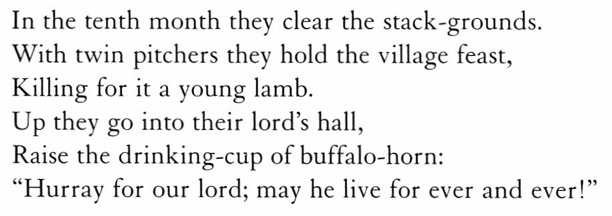
which gives a sense of life in Western Zhou:
- people provided their lord with a share of crop, hunt, and textile made
- the lord provide them with clothings and invite them to feasts
-
but there are also other songs when people are dissatisfied with their lord, in which case they may threaten to leave the lord
Bronzes of Western Zhou
- besides Book of Songs, inscriptions on bronzes also provided an outline of government and economy of Zhou
- contents include:
- how Zhou kings also worshiped their ancestors, like Shang
- many rituals are conducted by inscribing on a bronze bell, so that when struck, the living hoped messages would be conveyed to the dead and perhaps wishes granted
A Zhou Warrior and the Reward for his Service
- one text described a battle when Xianyun people raided Zhou garrison, who were defeated by the contribution of the Zohu warrior Duo You.
- king then award him lands, with people in that land obligated to serve the lord
- since men in the lower rank can rise, it can be seen as a form of early bureaucracy
- hence, Western Zhou can be seen as “the aggregation of thousands of pieces of land woemn together by the political power of the state”
Ancestor Worship
- the Book of Songs make it possible to reconstruct the ritual context (i.e. exactly what happened) of the Western Zhou bronzes
- basically in one song, what happened is:
- a young boy in the clan designated as the impersonator for the spirit to enter his body
- chief of the lineage conducts the ritual
- an officiating invoker serves as the go-between connecting the impersonator and the pious descendant.
- then, living family members requets good fortune and long life from the dead
- officiating invoker then consults an oracle
- and the “spirit” replies
The Zhuangbei Hoard: Ritual Revolution?
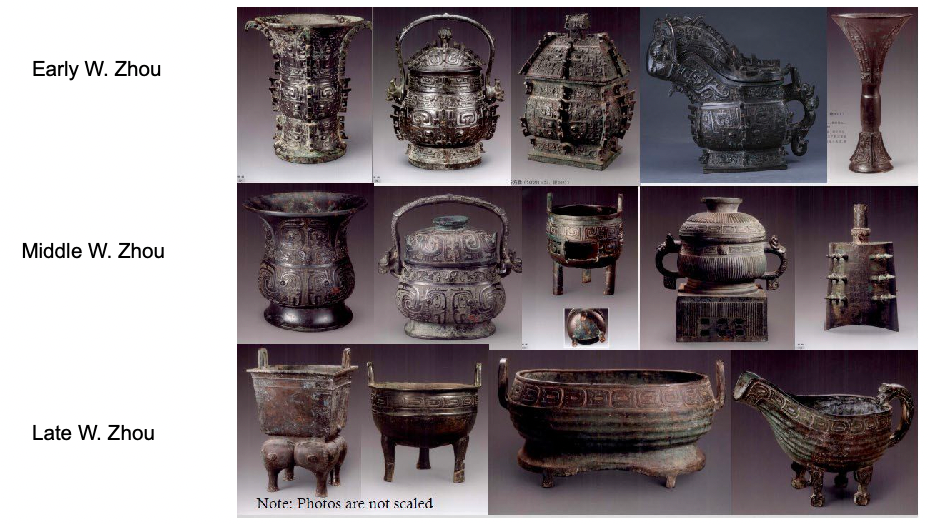
-
in 771 B.C.E, Zhou is invaded and abandoned their captial near Xi’an and fled east. Then the Wei family, fore fled, buried seventy-five vesssels and twenty-eigth bells in a bit (maybe hoping to recover it when they are back)
-
this pit is now found, and it is realized that objects can be categorized distinctly into two types, one ealier dating to 1050 B.C.E and one later to 880 B.C.E
- the ealier vessels were having exaggerated, delicate patterns, such as animals and tao-tie
- the later ones become flatter and stylized (simpler), and the tao-tie motif beame a little bit abstract
therefore, it is hypothesized (largely agreed) that a ritual revolution occured c.a. 850 B.C.E, and she explains by:
- ealier ones belived in shamnic travel to he world of spirits, and have no limits on how many vessels a certain person can have
- later ones perhaps have a decline in the belief inanimal spirits, and is only permitted to have a certain number of vessels
The continuity of Shang and Western Zhou
- both shared
- belief in oracle bones and divinations (Zhou additionally used yarrow stalks)
- both are soft states, with incipient初始的 form of tax and uncertain borders. Gifts from subjects to rulers are the major form of income
- they differ
- Zhou also have some written records of the commoners
- Zhou is beginning to have bureaucracy system
- Book of Songs described a gender split in Zhou: men could farm and hunt, but women needs to gather mulberry leaves, spun thread, dye textiles and making clothing. Also inscriptions on Zhou bells chime the prayers of the living for their sons and grandsons, not for daughters and granddaugthers.
Ch.2 The Age of the Warrior and The Thinker
Here we are featuring:
- Spring and Autumn Period 春秋, and The Warring State Period 战国, both of which is during the Eastern Zhou
- Chong’er (重耳=晋文公) from the Jin family.
- The period of Confucious 孔子 (died near the start of 战国), Zhuang Zi 庄子, Mencius 孟子, and Xun Zi 荀子
Start of Easter Zhou in. 771 B.C.E
-
in 771 B.C.E, two dependent states of Zhou made alliance with some tribal people to overthrow the Zhou King.
-
The defeated Zhou shifted their captial to the east near the modern city of Luoyang, and became more like a symbolic head as the competing regional leaders at far superior armies
-
There were some more than 100 polities at that time, and non had siginificant power to conquer all its neighbors. Besides them, there are also groups of “less-civilized” people who do not have their own written records
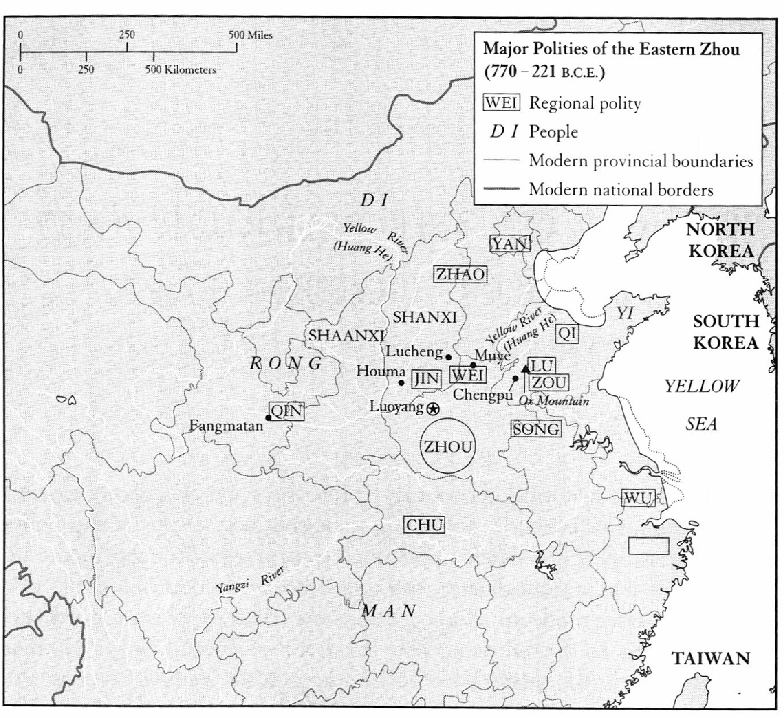
the four major “non-chinese” groups are therefore the Rong, Di, Man, and Yi, whom although is less civilized, but many chinese had contact with them to learn battling skills and cavalry (see later)
-
In the end, Easter Zhou is one with 6 centuries of warefare (770 to 221 B.C.E), and is usually considered into two halves:
- 春秋: named after the book The Spring and Autumn Annals, but actually the book that stores most of our knowledge from the period is The Commentary of Mr.Zuo (左传)
- 战国 (the Warring States Period): when the Zhou has became so weak that everybody is fighting between themselves to give birth to the next dynasty
The Commentary of Mr.Zuo and the Society it Describes
-
keep in mind that this is written 2 centuries after this period
- More than 100 polities, described over 500 battles, and more than 100 civil wars within polities as well.
- At the beginning of 春秋, a hierarchy of birth deciding which linage a man belonged=social status
- but even at this difficult time, there are several people who fought their own way to be recognized as the “lord protector”
- Duke Huan of Qi
- Duke Wen of Jin 晋文公, also called Double Ears (Chong’er)
The Struggle of Double Ears to Win His Realm (Jin)
- the Rong wife (of the current ruler) who bore Double Ears neber necame a favorite (e.g. because Rong is non-chinese)
- Wome at the time was also having low status:
- because marriage = building alliance, usually bride + female relatives are sent so that a son can be born
- therefore, all mother can do it so angle for the success of her son: 宫斗
- sent her son to the territory of the Di people
- Lady Li (mother of Double Ear) created the impression that the designated heir (for crown) sought to poison his father. But to accuse Lady Li means to offtend his father, the heir decided to kill himself.
- Awaited the time when their father died, and thought this is the time
- Duke’s ministers could also took over the throne by killing her sons
- So Double Ears were travelling (e.g. making friends with Chu) before returning to take over the Jin polity with help. To obtain the help, he made a promise to the Chu King that if they meet on battle, he will withdraw his force a distance of three day’s march
- 晋文公finally took over, and he:
- enlarged his army to three times the size
- met the Chu force, did the retreat as promised, but Chu still engaged. Double Ear won by tricking them tht they are retreating
- since he has shown to be a powerful ruler, he is finally appointed by the Zhou King to be a lord protector and awarded him the new rank.
Changes in the Art of War after Death of Double Ears
- Double Ears (636-628 B.C.E) marked the begining which military strength and innovative strategy become important
- people were trying to have many chariots, with about 10-30 carrying the chariot with 3 skilled warriors on it
- but since chariots are costly and ineffective unless on flat plains, they lost to infantry 步兵, which also marked an era of political shift since it means farmers could also revolt
- Di people took advantage of infantry by having a lot of them, and even erased the social distinction that divided those who can be ON the chariot and those who ran along. In warefare with infantry, anyone can rise up the ranks to become a general, and social flux is encouraged.
- the above is adopted by other rulers later as well
- Following a need for army is a rise in tax, literarcy rate (e.g. people can rise up to be the King’s advisor), and agricultural productivity
- started the use of iron tools instead of wooden ones, possibly introduced by the Europoid.
- the rise of infantry and army size means experts generals are needed to take lead instead of royal lineages. They believed that the art of war can be taught, and gives rises to books/teachings.
- The first book on strategems is The Art of War (孙子兵法)
- stressed that the entire amry had to be trained to follow the orders unquestionably
- “the highest skill is to bring the enermy’s army to submit without combat”
- students should seek to identify weakness in their army and find the right time to attack
- But another new change soon emerged is the introduction of calvary by Zhao King (learnt from their neighbor)
The Demand of Experts
-
rulers during the 战国 hire advisors on the basis of their skills. A famous example is Feng Xuan:
-
the intermediary introduced Feng Xuan to the lord Mengchang:

-
then, during a time when Mengchang wants to collect tax and Feng Xuan volunteered, he did not bring the taxes back but “forgive” all of them. The Lord is confused and asked why:

-
-
such sharp observation and fast decision is referred to as acumen, being hungered for during 战国
The World of Confucius
- born to the Kong family in Qufu 曲阜
- China’s first private thinker (i.e. not served as ministers or generals)
- The only source for understanding his teaching is The Analects (论语), which is a collection of conversations/teachings compiled by later students
- again this is compiled much later after he died
- conversations are first orally tranmitted, and then written down on bamboo (first source!)
- scripts on bamboo are written from right to left, top to bottom
- the received text of 论语 is compiled by having different disciples writting different sections, hence there are sharp differences among how they perceive Kongzi and his teachings
The Teaching of Confucius as in the Analects
-
he likes to converse with peoplesx
-
claims that he will 述而不作, but did innovate by
- how to behave virtuously and how to govern (ealier believed this skill is born with rulers)
- the concept of ritual 礼 is an important quality, and if men employ this, society could be reformed
- other essential qualities include humanness 仁
- during their parent’s lifetimes, children should obey their wishes and after their death, children should continue for three years to conduct family affairs just as their parents had.
- however, Confucious did not teach anything about spirit and supernatural.
-
Confucious seems to have only taught sons. Why?
- one possible explaination is that men’s interest was to have a larger family unit, and since only men can worship their ancestors, only sons cold carry on the family line. Whereas women are interested in a uterine family 同母异父 consisting themselves and their own children, there is a conflict.
-
Confucious believed that one can influence the wolrd by behaving as a gentleman at home, and that with benevolence (仁) all chaos will be checked

but later people did find it difficult to rule without force, and indeed Confucious was powerless when his city was attacked
-
In 479 B.C.E. he died
Ritual as shown on the Vessels of 战国
-
many vessels from Confucious time survived until today, but it is found that they are very different from the Western Zhou.
-
no more animals, but human figures engaging in activities
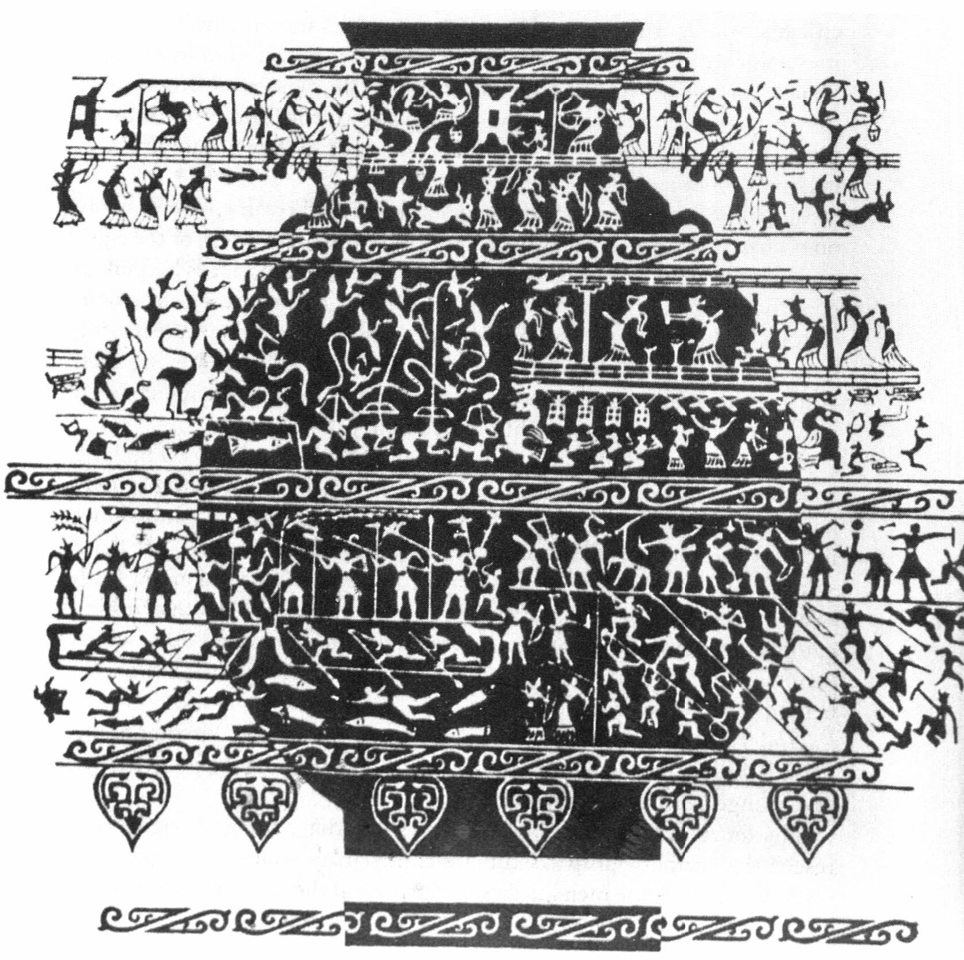
-
-
In Shang and Zhou, kings had retrained a monopoly over bronze vessels but by the time of Confucious, lower-ranking lords has taken over production and begin to record their own victories
- to them, ritual activities (a them in the Analects) is viewed differently as attesting the effectiveness of power and violence, while Confucious wanted the rituals as a forum of the individual’s development of benevolence.
After Confucious
- since the Analects is collectively edited by students, separate sections contain different views on the teachings, and hence there were a lot of disagreement = Confucians broke up into eight rival schools.
- the century after Confucious death then giave brith to some of China’s liveliest and most intersting thinkers
Mozi’s Criticism (50 years after Confucious)
- reformulated his teachings in response to Confucious
- At this period 5th century B.C.E, the fighting during the 战国 has dwindled to four major contenders - Qi, Jin, Chu, and Yue.
- Mozi accepted certain basic Confucian prescriptions, but felt that:
- bonds with acquaintances are overemphasized, e.g. thief steal from other families to benefit their own. Therefore, he proposes 兼爱, which is that each individual had an obligation towards all other people in the society
- ridiculed that Confucious advocate for elaborate funerals but gives no discussion of spirits and afterlife. Hence he proposes measures for controlling the cost of funerals.
- but he agrees with Confucious that gentleman had to remain engaged in the society for reformation
The Way and Integrity Classic 道德经
-
written by 老子, and disciples of this school are called Daoist
-
emphasizes the quality of Wuwei 无为, which should be interpreted as non-interfence:

Zhuangzi: The use of Paradox and Humor
-
while both 道德经 and 庄子’s teachings often addresses the ruler of the state, Zhuangzi focuses on the individual and presents a series of anecdotes
-
he believes that people should abandon preconceived notions
-
death should not be mourned
-
advantage of the disadvantaged

-
-
Zhuangzi also emphasizes on 无为, letting things run their natural course, but does not seem to condemn deforestation
Zhuangzi and Mencius 孟子
-
Mencius is a contemporary of Zhuangzi
-
Mencius believed that men were born good, but the environment transformed /corrupted them
-
an example would be deforestation, fked by the environment

-
-
Mendius, since believing in men, felt the people could be trusted to select a new rules, and the concept of Mandate of Heaven is to mean that a ruler could rule only with support of his subjects
Mencius and Xunzi: the Continuing Confucian Debate
- Xunzi 荀子 is in contrary with Mencius, believing that men were born evil but can improve via education.
- like Confuscious, they focused on question of how to govern, but they were hoping more of a unification rather than restoration (as the Zhou dynasty has became so weak)
- at the time of Xunzi, there were only three major power vieing: Qi, Chu, and Qin
- Xunzi visited Qin just before their conquest, and saw that “They employ them (the people) harshly, terrorize them with authority, embitter them with hardship, coax them with r4ewards, and cow them with punishments”
- hence predicted that Qin would not last long
Money Economy of the Warring States Period
-
In Shang and early Zhou, rulers used cowrie shells and cloth are currency, and their subjects exchanged goods
-
In 战国, the merchant class grew as trade across regions increased, and that the economy were well-developed for trading:

because of the increase in trading, it leads to an increase in specialization
The Chaotic Pace of Change
-
constant fighting throught the period = large resource consumed = rulers taxing individuals
-
a bunch of changes:
- regional rulers displacing Zhou kings
- chariot warriors displaced by infantry
a great degree of social flux also gave anciety for higher class, but also promoted literarcy
-
chaotic period also gave rise to all the different thinkers starting from Confuscious
-
the Legalist teachings 法家 in Qin was so repelled, by Xunzi, but they proposed a radically new way of organizing the state and its subject that allows its adherets to unite the realm for the first time
Ch.3 The Creation of Empire
From the Warring States to Qin
- Qin defeated the other riavals not because of any new technology, but because they found a new way to organize their state: Legalist ministers who advocated the abolition of all privilegeds of nobility
- Results in very efficient system in Qin (in contrast to the modern view of bureaucracy)
- After the unification of China, scholars in Qin and Han begin to face the question: how should they govern talented officials? What role should the state play in the economy?
- during the Warring state, it was mostly priviledged aristocracy and the laboring masses. But after 221 B.C.E. it became mostly scholars, peasants, artisans, and merchants (merchants last because pesants and artisans produced something)
- technically we still have slaves, doctors and religious specialists in addition
- Qin ended within 14 years of ruling, due to problems in the court and people unsatified=rebellion
Brief history of Han
- founded by a strong leader and succeeed by strong woman, Han enjoyed 200 years of competent ruling
- Interloper Wang Mang, tired of being regent (to young emperor), formed a new dynasty called Xin
- within 15 years, other families of Han regained power and weakened the dynasty
- destruction of their capital at Changan forced them to move to Luoyang
- beginning of increased tax, and emperesses wrest control from weak emperors
- rise of enunuchs and Confucian students began protests, as well as many following Daoism
- lots of protest and rebellion, a disaster ended the dynasty
The Legalist State
- 韩非子, who stuttered during an ear where eloquence is prized, had to record his idea on pen and paper
- believed that ruler should be detached from everyday business, and apply unbending standard to judge officals and people
- believed in a law that treated everyone equally, and that only the systematic application of law can control people, whose nature are evil (Xunzi)
The Architecture of Qin’s Success: Shan Yang’s Reforms
- Qin wasn’t strong enough to take over all rivals until 商鞅’s term in office
- Shangyang disdain the past, hence rejected Confucious values, especially ritual, and sees it as pointless
- Shangyang greatly improved the fiscal of the Qin:
- registration of households, and let people supervise each other
- if criminal activity is not reported, chop heads
- once a man reached 16-17, obliged to serve military and pay taxes
- establishing the concept of ownership of land
- achievements in army gives promotion in rank proportional to the achievement
- the entire population of Qin is divided into ranks = permitted clothing, land, slaves, households.
- people (pesants/artisans) who contributed much grain/cloth to the state is free from tax
- proposed rulers of small districts 县, who is in charge of organizing army, carry out public works, collect taxes…
- standardized units such as weight and length
China’s First Emperor
-
given a strong fiscal basis, King Zheng (later called 秦始皇帝) decided to attack all the other rivals at the time
-
after destorying the other six kingdoms, King Zheng:
- forced the royals from the six kingdoms to live near the capital (for monitoring)
- emphasized on farming as the mainstay of the economy
- standardized coins to be a circle with holes (so that they can be stringed together)
- divided territories into commanderies, which is further divided into counties.
- Commanderies are like little central government:
- they need to perform three tasks: civl matters, e.g. taxation, military affairs, and supervision of governmental officials
- the top officials in the central government include
- chancellor, who heade the bureaucracy
- imperial secratry, who drafted king’s orders
- grand commandant, in charge of military
-
Qin has also done some significant projects
- built networks of roads over 6,800 km long
- dug irrigation cannals, and some three hundred thousand men built extensive walls of pounded earch along northern borders
- fearful of death, he tried to obtain exilir for immortality but failed. Instead, he let seven hundered thousand men working for his tomb, which was intested to replicate the universe as his permanet resting home in the afterlife
- for fear that workers may disclose the position of the tomb, all artisans and laborers who had worked there were imprisoned in the tomb while alive
- gives rise to the Terra-Cotta army 秦陵兵马俑, who were thought to be troops that the emperor can fight with in the underworld
- however, his tomb today was never excavated/found
-
When Qin founder died in 210 B.C.E, he named his more popular first son to succeed, but with interloped by a powerful official named Zhao Gao
- took over as a chancellor
-
but the greatest opposition is the rebellion of the people. This happened because there were laborers who are delayed by the rain, and that:
- since they cannot complete their work, they “will die” (according to Han historians)
- if they revolt, they die as well (according to Han historians)
therefore, maybe they should risk for their own kingdom.
Reasons for Doubting the Historical Record
-
Win ordered a large-scale book burning in 213 B.C.E destroying all dissenting point of view
- except The Book of Song 诗经 and The Book of Documents 书经 were banned, and only agricultral and divination books permitted
- for books such as 诗经, most content are anyway transmitted from teacher to student, hence book burning had no effect
-
贾谊Jia Yi’s Confucian view point, which emphasized humanity and rightenousness, provided Han dynasty the perfect justification to overthrow Qin
-
but it was found later in a tomb in 睡虎地 Shuihudi, where a Qin clerk lived a life as a hearing for crimal suit and took several legal writings with him in the tomb
- described a detailed judification system where poeple would often be beaten as a punishment instead of killed
- women also had work outside the typical sewing: some were working in lacquer production with signed vessels
however, it is prescriptive of what sohuld happen rather than descriptive of what actually happened, so it should also be taken with a grain of salt
The Founding of Han
- peace during 秦始皇帝 but as soon as he died and much succession problem happened at palace, many of the former regional states broke away
- bona-fide peasants 刘邦 and low-ranking official rebelled and started a new dynasty
- Liu Bang is very social but crude, hence have a lot of drinking friends at inn
- when he won the battle against Qin, he pleged to abolish all other Qin’s law but only keep a) those who kills others shall die b) he who harms others or steals should be punished
- but in the end it is found that the Han dynasty took many Qin laws verbatim
- one major depature from Qin is Han’s policy on placing nobility all near captical. Instead, Han created new nobilities to his brothers and relatives and dispersed them:
- gave them titles of local Kings
- 2/3 of the territory reined by sons and relatives, 1/3 by Liu Bang himself
- but the core of Han is still 西安
- but the first years of Liu Bang’s reign was difficult, as it has to suppress rebellions within China and defned against the powerful 匈奴 in the north
- after Liu Bang’s death, a new ruler in 209 B.C.E. lost to Xiongnu and signed a humiliating peace treaty requiring China to present gifts of textiles, food, and wine, wile Xiongnu not to attack China
The Reign of Dowager Empress Lv
- Empress Lv 吕后 ruled for an extended period of time by placing infants on throne
- as an empress, suffered pressure even from Xiongnu (asking she to marry over)
The World of the Regional Rulers: 马王堆 finds
-
found Han's tomb in 马王堆汉墓, with three of the four tombs almost intact
-
most important find is Lday Dai's tomb
-
Lady Dai’s skin fully preserved
-
has a lot of cloths and wine vessels in the tomb
-
found much evidence of Han cuisine, e.g. meat stew and rice
-
her view of the afterlife characterized by the T-shaped banner which contained three sections:
- top: the immortal Lady Dai (spirit)
- middle: Lady Dai existence in the underworld
- bottom: Lady Dai in tomb (soul)
not a sequential event, but silmultanoues
-
migth not be literate due to no books in tomb
-
-
other tombs are his sons, where a vast majority of books is fonud = reassess the intellectual world of Han
The Han Dynasty Under Emperor Wu 汉武帝
- Emperor Wu elimited checks on his power, and then established a Confucian academy, which is deeply affected by his advisor 董仲舒
- Emperor Wu started the academy by
- first appointing five teachers who specialized in five books: 诗经, 尚书/书经, 周易/易经, 尚书 春秋
- enrolling thousands of students, who upon graduation can go into the government
- Therefore, the procedure of hiring new officials become a) be recommended and b) take the examinations
- Emperor Wu also tried to battle against Xiongnu due to the unfair treaty, but neither achieved a decisive victory
- during some of the battles, Li Ling founght hard but lost. He failed to suicide and became a slave
- 司马迁wanted to defend Li Ling, who he knows as a childhood friend, but got himself castrated instead of put to death because he thinks its even worse if his literary work 史记 cannot be left to posterity
- 史记, unlike later books written by historians funded by the government, is self-funded and hence a more trust-worthy source
The Creation of Autocracy
- Emperor Wu asserted control during his time by dismissed or sentenced to death some five chancellors, and became unchecked in power
- he also promoted 霍光 to serve as regent after his death, but unfortunately he never gave up power and just placed child emperor over another
- this cycle of regent people/empresses/enunuchs named themselves are regent and gained control is common for later era
Economic Problems in the Han
-
Since almost every measure Emperor Wu imposed, e.g. sending troops to Xiongnu and establishing academy required funds, some mechanism is needed
-
solution: government monopolies
- salt and iron, where the latter is immensely useful for making tools
- later also assumed monopoly of copper, bronze, and wines
-
but long years to fightings = lots of taxings = people suffering. Hence after 汉武帝 death investigation are sent out
- scholars were against tradings and monopolies, while the government officials successfully defended it
-
In an essay by Wang Bao, were a slave’s life for a widow is mentioned, the econ for that time can be inferred:
- there is a widespread network of small and wide markets
- slaves are expected to travel from places to places to buy stuff
- although a money economy existed, mostly they are used to trade for luxuries
additionally, it meant the society can also be split into two types:
- estate ownders: collected large amount of wealth and became increasinly powerful and influential
- slaves: e.g. lost from war or seriously in debt
Wang Mang 王莽 Regency:
-
Wang Mang wanted to suppress the power of large estate owners, and founded the Xin dynasty
-
Wang Mang’s approach included limiting the maximum land you can have, and cessing some land from owner to poors
-
However, his reign came to an end due to flooding, which caused
- unsatisfactory landowners due to his policy
- angry peasants
hence he is killed and taken over
The Restoration of the later Han
- The later Han with captial in Luoyang is sometimes called Eastern Han as it is east of Chang’an
- The captical has walls surrounded imperial palace, inns, canals, markest, and schools, and had a huge amount of residents, students, and officials
- since it is just restored, it still relies on large land owners and hence they have some power over the recommendation system and put sons into government
- the rise of eunuchs in the palance
Wang Chong’s Skeptism and 班’s Family
- argued that many early arguments are made without logic. For instance, people performing ceremonies to the spirit of earth is useless/unheard by the earth, just as people won’t head anything about the lice on their skin.
- Ban’s family is full of literate sons and daughters
- Ban Gu, son of Ban Biao, resolved to complete the history of China written by his father was thrown into jail accused of distorting history
- Ban Zhao 班昭, the daughter of 班彪, is one of the most famous women writers
- Lessons for Women: unequal treatment of women and how she thinks married women should behave
- later on sponsered by the court to finish writing the history
- Ban Zhao’s view of women:
- four qualities women should have: “womenly virtue, womenly words, womanly bearing, and womenly work”
- wife should not question her husband, but husband should not beat wife either
- plead for equal education, as usually sons are educated by daughters not
- also inferred difficulty of women: families abandon their daughter due to marriage costs
- but powerful families prefer having a daughter married to emperor so that they can seize power
- Ban Biao was also served as the advisor to Emperor Deng
Refusal to Serve in Government
- but as the successor Emperor Huan could not bear the power of in-laws, used eunuchs to launch a coup and unseated the Liang family, which is the family of his wife
- as Emperor Huan’s needed eunuchs to succeed, he became very unpopular and people are rejecting his invite to serve. For example, one person who rejected explained:
- holding office meant having to censure the emperor, and since critism will be punished, this is not good
- if not censuring, then his own “purity” as scholar is damaged
The Rise of the Organized Daoist Church
- Instead of the righteous scholars, Emperor Huang tried to tap from the new Daoist
- Daoist belief at that time went under a major transformation
- believe that 老子 is a deity and can come to give advices
- split into two fractions, 五斗米道 and 黄巾
- the 五斗米道 Five Peck of Daoist movement believed that
- instead of teaching selected adepts techniques to obtain immortality, teach a larger community
- the leader 张道陵 promised good health in exchange to peoples belief/rice offerings to Daoist deity
- the idea of linking illness with bad deeds initiates here, and that people believe confessions is the cure
- the yellow turban planned for a rebellion 黄巾之乱, but
- leaders quickly executed by military, under the lead of 曹操
- people quicly dissovled
- foreshadows the introduction of buddism and changes of the religious lanscape later
The Legacy of the Han
- much remains uncertain about the fall of Han, but popular theory suggests that the empire experienced a massive shortfall of funds
- However, both Qin and Han left an impression of unified China in peoples minds
- during the 400 years of reign of Qin and Han
- Chineses society assume the contours it would take today, and much market economy of the Han and government’s role in regulating also persisted until today
- women still has subordinate roles, but when opportunies arrive people such as Ban Zhao can break out of their traditional roles
- the only siginficant change, which comes later, is spiritual: introduction of Buddism
Ch.4 China’s Religious Landscape
Overview:
- Buddhism, started as a foreign religion, won more followers than Daoism for the year 200-600
- Buddhism included life of lay people who live at home with their faimlies or monk who joined monasteries
-
many reason underlay Buddihist’s success: most important is the ability to absorb elements of preexisting religions, e.g. recruited many local deities as guardian. Therefore, you can worship both Daoism and Buddhism at the same time
- long-lasting political instability marked the centuries of China’s conversion to Buddhism: for three centureies after the fall of Han, a period often called Six Dynasties (220 - 589), no regime successed in conquering more than half of China’s territory (until Sui dynasty that comes afterward)
The First Buddhist in China
- Buddhism is associated with trade, since the Buddha (ca 500 B.C.E) liked merchants show provided crucial financial support
- In 148 C.E. the famous missionary An Shigao from Parthia arrived in Luoyang, and began work on translating Sanskrit texts into Chinese (Sanskrit text is the text of Buddhist teaching)
The Successors to the Han Dynasty
- succeeded by the Three Kingdom period (220 - 280), in which Cao Cao’s nine grade system had a long lasting impact
- in principle, a local official, the impartial judge, was supposed ot assign each candidate a rank from one to nine in the office
- in reality, the pattern established during Han prevailed, recommendations were influential, hence sons of powerful families have advantage
-
when Cao Cao’s heirs lost power, the Sima family founded the Jin Dynasty, who ruled northen China for barely half a century util broken up in the War of Eight Princes (290 - 306), so northern part becomes separated again with Jin retrained its control at Luoyang
- In 311, the Xiongnu conquered the former capital Luoyang
Appeal of Buddhism to Northern Rulers
- Shi Le, the ruler who conquered Luoyang, was once introduced to the Buddhist missinoary Fotudeng, who performed some miracle tricks and impressed him
- he then granted the Buddhists the right to build monasteries
- whether if Fotudeng can do magic tricks is tangantial here, the important thing is:
- the news of this spreaded Buddhism
- Buddhism offered non-Chinese rulers an alternative to Confucianism, which is very Chinese
- also, for women, this offered a new alternative than family life: joining a nunnery. Justified by transfer of merit (e.g. to family)
The Difficulties of Translating Buddhist Concept
- Chinese belongs to Sino-Tibetan language, while Sanskrit which has an alphabet, belongs to Indo-European
- also many different cultural assumptions: Indians talked about sex much more freely than Chinese, hence cautious translators dropped any mentions of kissing and hugging
- difficult to translate new terms/concept not in Chinese:
- early translators decided to use Daoism concepts: Nirvana $\to$ wuwei, which is far from accurate
- also difficult to translate karma: one’s next life could be reborn into an animal or person depending on behaviors; Daoism viewed a constant afterlife
- then in 344 - 413, Kumarajiva, a monk from Central Asia or from India, is sponserd by private individuas to come to Chang’an to perform better translations
Buddhism in Central Asia
- Kumarajiva is trained by a monk in Kucha, which is now part of China’s Xinjiang, and many people there speak Turkic language Uighur instead of Chinese
- he studied Buddhist texts in Sanskirt, spoke Tokharian, and learned some Chinese from merchants who came to Kucha
- he was later kiddnapped to Gansu for 17 years, where he mastered Chinese, and he started to believe in the Greater Vehicle
- the Lesser Vehicle (Hinayana) held Nirvana possible only for the few who joined the Buddhist clergy
- the Greater Vehicle (Mahayana) offered salvation even to laity
- starting in 401, skilled translators and knowledgable monks also joined the translation project
- even though Buddhism has value for celibacy, there are many exceptions (e.g. Kumarajiva) where the practioner had family
- Bodhisattva named Avalokitesvara = nowadays 观音
Contact between India and China
- pilgrams going to India as early as 260 on the overland trade route linking India and China
- no single Silk Road strecthed all the way yfrom Rome to CHina, but most frequented routes led to India
- Chinese silk was very lucrative as only Chinese knew how to process silk worms
- much silk also went to European conutries such as Rome, but a lot might be made in Byzantium
- then silk is also used as gifts to monasteries
- Chinese imported a lot of glass, 琉璃 v.s. 玻璃
- In fact, the silk road did not have a single merchant travelling on a camel to Rome, but more often:
- only few were long distance merchants
- most stayed on circuit close to home
- other silk road travelelrs include missionaries, refugees, and envoys for Kings, etc.
- when a wave of conquests (Persian Empire) cut off the trade routes between China and Inda, the great age of SIlk Road came to an end, having lasted for over 1000 years
The Northern Wei Dynasty
- during early contact with India and Central Asiam the only government in north China to retrain power for over a century was establiedh by a non-Chinese people, the Tabgach 拓跋, or also reffered ot as 鲜卑 (name of the tribe)
- Xianbei people speaks both Turic and Mongolian laguages, but had no written langue of their own
- Xianbei people had:
- a system of tanistry: more powerful person in duel is the leader
- women knoew how to tend to hers and hunt because men left for war. Hence women enjoyed more power than most other societies
- no stable capital, as it is defined where the ruler set camp
- slowly shifted base from Yin Shan mountain in Inner Monolia to northern Shanxi, and staretd taxing the Chinese peasantry and adopted a Chinese law code
- by the middle of fifth century, Northern Wei has defated most of their rivals to take control of north China
Dowager Empress Feng and the Equal-Field System
- established a new captial in Pingcheng, and some of Tabgach are drawn to Chinese ways
- Dowager Empress Feng had a chance to enter the system and systematically appoint Chinese to office to lessen Tabgach influence
- Empress Feng seriouly wanted to transform Tabgach to Chinese:
- wanted to tie the Chinese farming population to the land, as otherwise it is mostly bureaucrats and atisans who did not grow their own food
- this is also useful as it could serve as a source of income by taxing
- the policy to realized the above is the Equal-Field system:
- apointed land to all those of tax paying age
- since this includes slaves, this means powerful landowning families could retain control over large areas of land
- gives two types of lands, farmland for growing crops, which is short term investment since lands are often quickly redistributed when farmer stopped working
- and mulberry tree for silkworms, which is a long term investment as it takes a long time for the tree to mature
- apointed land to all those of tax paying age
- all of which is to tie people to the land, but did not take effect immediately
- the system lasted into the eight century, as it helped tied people to land and increased revenue
Adoption of Chinese Ways
- in 493, Emperor Xiaowen 孝文 (北魏孝文帝) implemented a series of measures designed to make his empire Chinese
- his measures include:
- establish a new captial in Luoyang
- dropped their own family name of Tabgach and had surname of Yuan
- also appointed the nine-grade system
- advocated conversion to Daosim instead of Buddhism (may wanted to weaken Buddhist establishment for more power)
- but he died young in 499, and the dynasty entered three decades of discord, where Northern Wei came to a miserable end in 534
Growth of Buddhism under the Northern Wei
- even during those difficult times, Buddhism received wide support from different factions
- examples of its populance include:
- “there is no place that does not have a Buddhist sanctuary”, by a prince in 518
- had large buddhist monarsteries up to 300 meters high, and built over 839 royal monasteries, and about thirty thousand places of worship
- In 528, Erzhu tribes defeated Empress Ling, conquered Luoyang, named a new emperor, and Luoyang was laid waste in 534 from fire
Persistance of Tabgah Identity
-
even after the fall of Northern Wei Dynasty, Tabgach did not lose their identity since the warlords could not agree on a new emperor. Hence they went back to stay in north Shanxi
-
two generations after Emperor 孝文, Tabgach people still retained their language and identity
-
however, the impact of their steppe culture on north Chinese is long-lasting
-
Yan Zhitui recorde thah people in the north and south (of yellow river) behaved very differently:
- in the south husband can be extravagent even if wife and children suffer
- in the north, it is usually wife who runs the household, and sometimes husband has to put up with wife’s insult
where the latter seems related to Tabgach’s culture: women had more influence
-
The Move South
- before, the south is often viewed as uncivilized, and the wet climate (perfect for rice) is thought of as a home for illness
- however, the fall of Luoyang prompted migration, as well as the dangers of battles
- consequently, many northern Chinese aristocrats moved to Nanjing
- in south China, Daoist teachers were most active, but there were some buddhist influences as well. But there were somem dramatic changes:
- for buddhist, the teachings of the Greater Vehicle largely superseded those of Lesser Vehicle
- Daoist visionaries divided into Lingbao 灵宝 and Mao Shan 茅山
Religious Life in South China
- the Liang emperor was interested in Daoism, studied it in Mao Shan Montain茅山, hence new Daoist sect took the name Mao Shan
- the Maoshan adherents continued the practices of Five Peck Daoist, but distance themselves from practice that had given the Doaist a bad name, specifically certian sexual rites
- had a system of seven levels housing both divine immortals as well as the spirits of the dead
- slightly optimistic than Chinese view of afterlife were dead would go through a series of courts
- believed that you could lodge suits in the underground agasint people who had wronged them
- however, you can rise a level if you had revealations from certified teachers, which in reality is a “secretive service” and costs a lot
Religious Policies of Emperor Wu of the Liang
- he stued Daosit, but then in 504 urged his family and officails to give up Doaism for Buddhist teaching
Critics of the Buddhist Establishments
- by the middle of 6th century, there are approx two million monks
- those clery did not work or serve in military, hence seen as a drain on state resource
- this caused ire in the emperor of Zhou dynasty (557 - 581) who succeeded the Qi, and ordered all Buddhist monks to return to lay life and all Buddhist texts and statues destoryed
- even inside buddhism, there are criticism as they shelted criminals and engaged in loans
- however, those records are mostly about the wealthy clergy, so we don’t know the common clergy’s behavior
- however, a short supression in 574 cuold do little to shake the hold of either Buddhist or Daoist, both of which had history over 4 centuries